D Link IR655C1 Xtreme N Gigabit Router User Manual
D Link Corporation Xtreme N Gigabit Router
D Link >
user manual
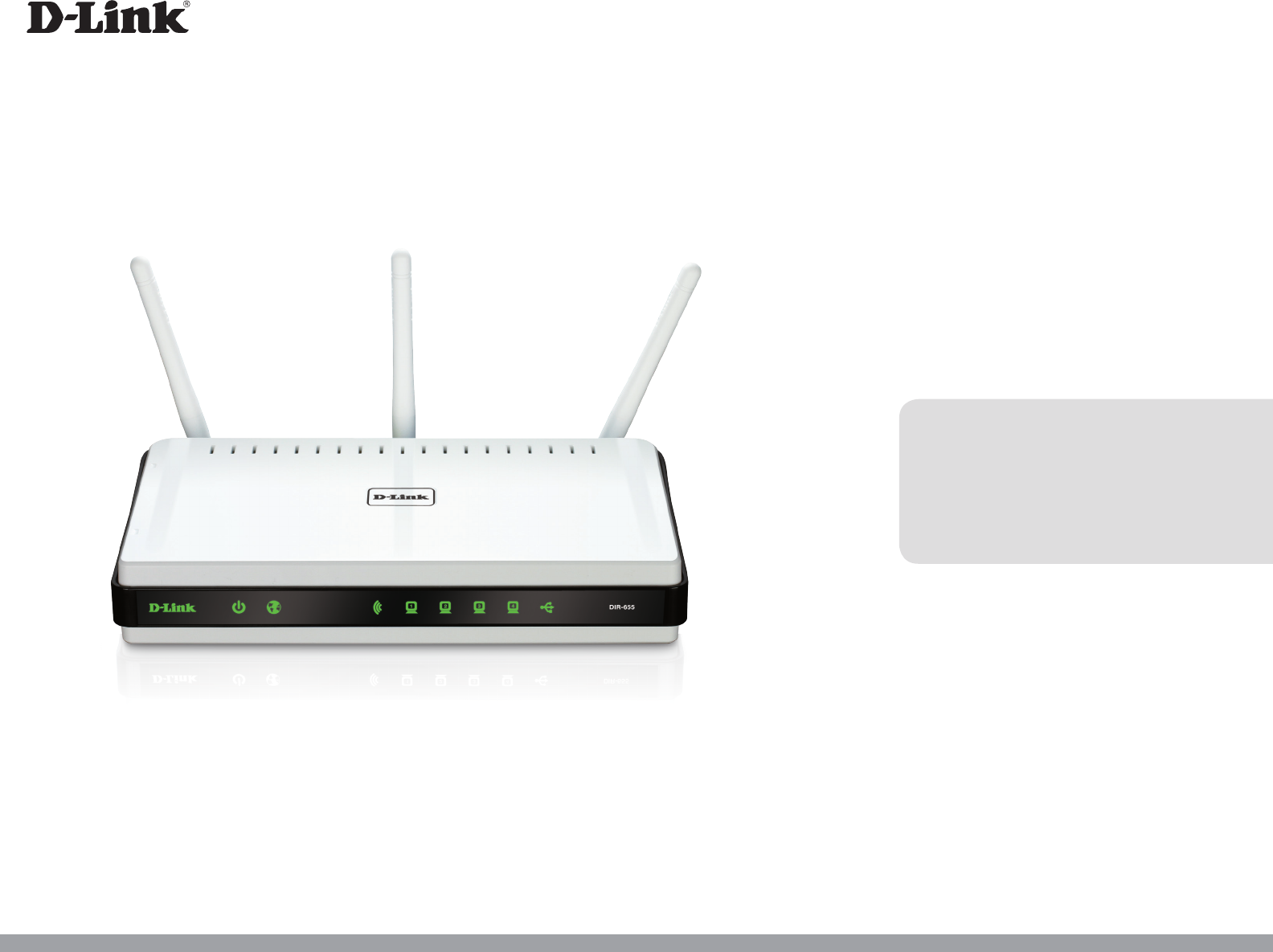
Version 3.0 | 05/09/2013
DIR-655
User Manual
Wireless N Gigabit Router

iD-Link DIR-655 User Manual
D-Link reserves the right to revise this publication and to make changes in the content hereof without obligation to notify any person or organization
of such revisions or changes.
Manual Revisions
Trademarks
D-Link and the D-Link logo are trademarks or registered trademarks of D-Link Corporation or its subsidiaries in the United States or other countries.
All other company or product names mentioned herein are trademarks or registered trademarks of their respective companies.
Copyright © 2008-2013 by D-Link Corporation.
All rights reserved. This publication may not be reproduced, in whole or in part, without prior expressed written permission from D-Link Corporation.
Revision Date Description
2.0 May 25, 2010 • New Revision
2.1 July 6, 2012
• Added IPv6 Routing and Firewall
• Added QRS Mobile app
• Added Quick Setup Wizard
3.0 May 9, 2013 • Removed WISH
• Removed QRS Mobile app
Preface

iiD-Link DIR-655 User Manual
Table of Contents
Preface ................................................................................................. i
Manual Revisions ...............................................................................................i
Trademarks ..........................................................................................................i
Product Overview ..............................................................................1
Package Contents ........................................................................................... 1
System Requirements .................................................................................... 2
Introduction ...................................................................................................... 3
Features ..................................................................................................... 4
Hardware Overview ........................................................................................ 5
Connections ............................................................................................. 5
LEDs ............................................................................................................6
Installation ......................................................................................... 7
Before you Begin ............................................................................................. 7
Wireless Installation Considerations ........................................................8
Getting Started ..................................................................................9
Quick Setup Wizard ......................................................................................10
Conguration ...................................................................................16
Internet Connection Setup ........................................................................17
Manual Conguration ........................................................................18
Static IP ...............................................................................................18
Dynamic IP (DHCP) ........................................................................19
PPPoE (DSL) ......................................................................................20
PPTP ....................................................................................................22
L2TP .....................................................................................................24
DS-Lite ................................................................................................26
Wireless Settings ...........................................................................................27
Manual Wireless Connection Setup...............................................28
Wireless Security ..................................................................................29
What is WPA? ....................................................................................29
Wireless Security Setup Wizard .................................................30
WPA-Personal (PSK) .......................................................................32
WPA-Enterprise (RADIUS) ............................................................33
Network Settings ...........................................................................................35
Router Settings .....................................................................................35
DHCP Server Settings .........................................................................36
DHCP Reservation ................................................................................37
Media Server ...................................................................................................38
IPv6 .....................................................................................................................39
IPv6 Internet Connection Setup Wizard .......................................40
IPv6 over PPPoE ..............................................................................42
Static IPv6 Address Connection ................................................43
Tunneling Connection (6rd) .......................................................44
IPv6 Manual Setup ...............................................................................45
Auto Detection ................................................................................45
Static IPv6 ..........................................................................................46
Autoconguration..........................................................................47
PPPoE ..................................................................................................48
IPv6 in IPv4 Tunneling...................................................................50
6to4 Tunneling ................................................................................51
6rd ........................................................................................................52
Local Connectivity Only ...............................................................53
Advanced Settings ........................................................................................54
Virtual Server .........................................................................................54
Port Forwarding ....................................................................................55
Table of Contents

iiiD-Link DIR-655 User Manual
Table of Contents
Application Rules .................................................................................56
QoS Engine .............................................................................................57
Network Filter ........................................................................................59
Access Control .......................................................................................60
Access Control Wizard...................................................................60
Website Filter .........................................................................................63
Inbound Filter ........................................................................................64
Firewall Settings ...................................................................................65
Routing ....................................................................................................67
Advanced Wireless ...............................................................................68
Wi-Fi Protected Setup (WPS) ............................................................69
Advanced Network Settings ............................................................71
Guest Zone .............................................................................................72
IPv6 Firewall ...........................................................................................73
IPv6 Routing ...........................................................................................74
Tools ...................................................................................................................75
Admin .......................................................................................................75
Time ..........................................................................................................76
SysLog ......................................................................................................77
E-mail Settings ......................................................................................78
System ......................................................................................................79
Firmware..................................................................................................80
Dynamic DNS .........................................................................................81
System Check ........................................................................................82
Schedules ................................................................................................83
Status .................................................................................................................84
Device Info ..............................................................................................84
Logs ...........................................................................................................85
Statistics ...................................................................................................86
Internet Sessions ..................................................................................87
Routing ....................................................................................................88
Wireless ....................................................................................................89
IPv6 ............................................................................................................90
IPv6 Routing ...........................................................................................91
Support .............................................................................................................92
Connect a Wireless Client to your Router ......................................93
WPS Button ......................................................................................................93
Windows® 8 .....................................................................................................94
WPA/WPA2 ..............................................................................................94
Windows® 7 .....................................................................................................96
WPA/WPA2 ..............................................................................................96
WPS ...........................................................................................................99
Windows Vista® ........................................................................................... 103
WPA/WPA2 ........................................................................................... 104
WPS/WCN 2.0...................................................................................... 106
Windows® XP ............................................................................................... 107
WPA/WPA2 ........................................................................................... 108
Troubleshooting ............................................................................110
Wireless Basics ...............................................................................114
Tips .................................................................................................................. 116
Wireless Modes ........................................................................................... 117
Networking Basics .........................................................................118
Check your IP address ............................................................................... 118
Technical Specications ................................................................120
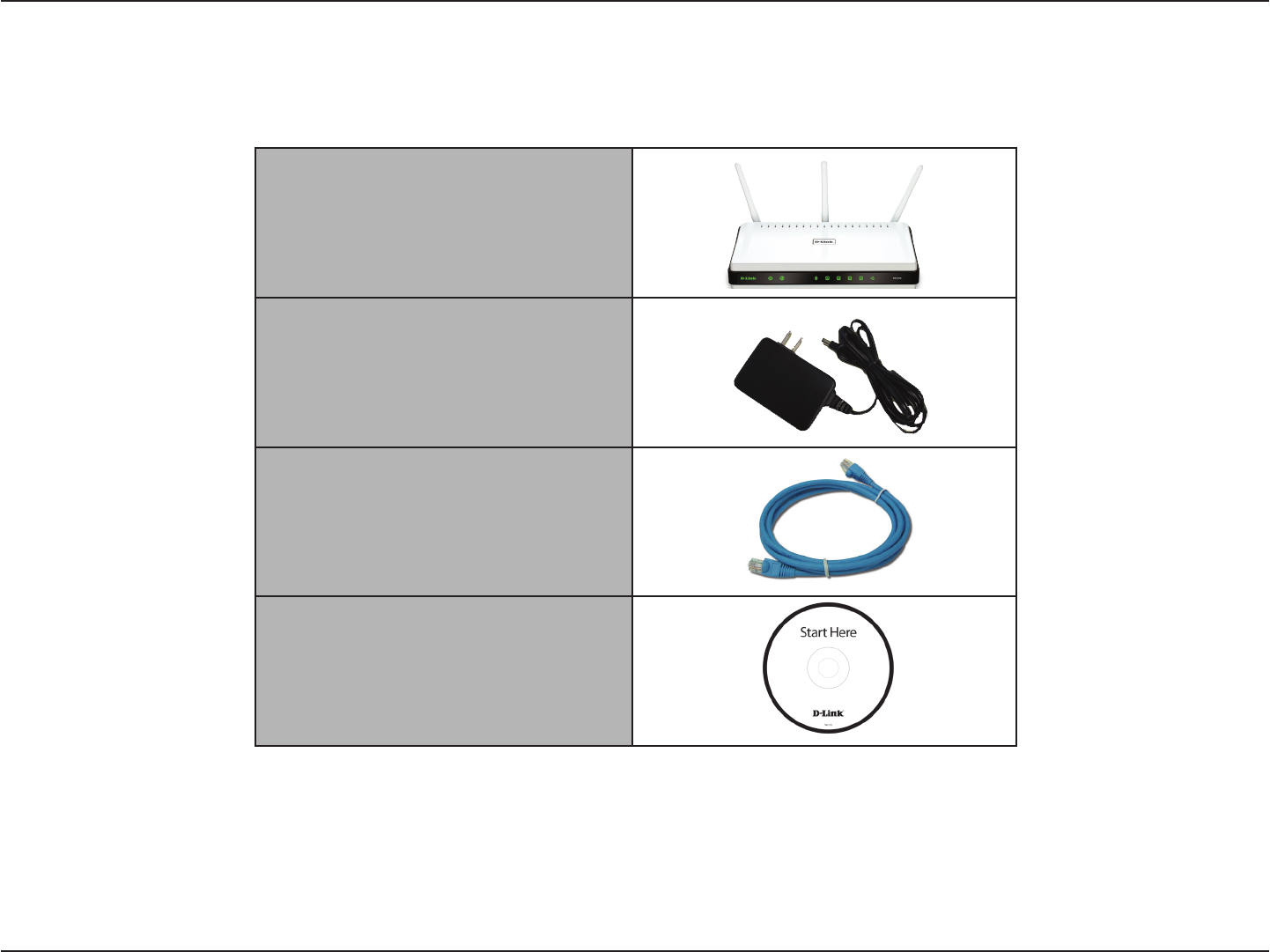
1D-Link DIR-655 User Manual
Section 1 - Product Overview
Product Overview
Package Contents
Note: Using a power supply with a dierent voltage rating than the one included with the DIR-655 will cause damage and void the warranty.
D-Link DIR-655 Wireless N Gigabit
Router with 3 Detachable Antennas
Power Adapter
CAT 5 Ethernet Cable
CD-ROM

2D-Link DIR-655 User Manual
Section 1 - Product Overview
System Requirements
Network Requirements
• An Ethernet-based Cable or DSL modem
• IEEE 802.11n or 802.11g wireless clients
• 10/100/1000 Ethernet
Web-based Conguration
Utility Requirements
Computer with the following:
• Windows®, Macintosh, or Linux-based operating system
• An installed Ethernet adapter
Browser Requirements:
• Internet Explorer 6.0 or higher
• Mozilla 1.7.12 or higher
• Firefox 1.5 or higher
• Safari 1.0 or higher (with Java 1.3.1 or higher)
Windows® Users: Make sure you have the latest version of Java
installed. Visit www.java.com to download the latest version.
CD Installation Wizard
Requirements
Computer with the following:
• Windows 7, Vista®, or XP with Service Pack 2
• An installed Ethernet adapter
• CD-ROM drive

3D-Link DIR-655 User Manual
Section 1 - Product Overview
Introduction
TOTAL PERFORMANCE
Combines award winning router features and 802.11n wireless technology to provide the best wireless performance.
TOTAL SECURITY
The most complete set of security features including Active Firewall and WPA2™ to protect your network against outside intruders.
TOTAL COVERAGE
Provides greater wireless signal rates even at farther distances for excellent coverage throughout the whole home.
ULTIMATE PERFORMANCE
The D-Link Wireless N Gigabit Router (DIR-655) is a 802.11n compliant device that delivers real world performance of up to 650% faster than an
802.11g wireless connection (also faster than a 100Mbps wired Ethernet connection). Create a secure wireless network to share photos, les, music,
video, printers, and network storage throughout your home. Connect the Wireless N Gigabit Router to a cable or DSL modem and share your high-
speed Internet access with everyone on the network. In addition, this router includes a Quality of Service (QoS) engine that keeps digital phone
calls (VoIP) and online gaming smooth and responsive, providing a better Internet experience.
EXTENDED WHOLE HOME COVERAGE
Powered by Wireless N technology, this high performance router provides superior home coverage while reducing dead spots. The Wireless N Gigabit
Router is designed for use in bigger homes and for users who demand higher performance networking. Add a Wireless N notebook or desktop
adapter and stay connected to your network from virtually anywhere in your home.
TOTAL NETWORK SECURITY
The Wireless N Gigabit Router supports all of the latest wireless security features to prevent unauthorized access, be it from over the wireless network
or from the Internet. Support for WPA standards ensure that you’ll be able to use the best possible encryption method, regardless of your client
devices. In addition, this Wireless N Gigabit Router utilizes dual active rewalls (SPI and NAT) to prevent potential attacks from across the Internet.
* Maximum wireless signal rate derived from IEEE Standard 802.11g and 802.11n specications. Actual data throughput will vary. Network conditions and environmental factors,
including volume of network trac, building materials and construction, and network overhead, lower actual data throughput rate. Environmental conditions will adversely
aect wireless signal range.

4D-Link DIR-655 User Manual
Section 1 - Product Overview
• Faster Wireless Networking - The DIR-655 provides up to 300 Mbps* wireless connection with other 802.11n wireless clients. This
capability allows users to participate in real-time activities online, such as video streaming, online gaming, and real-time audio. The
performance of this 802.11n wireless router gives you the freedom of wireless networking at speeds 650% faster than 802.11g.
• Compatible with 802.11g Devices - The DIR-655 is still fully compatible with the IEEE 802.11g standard, so it can connect with
existing 802.11g PCI, USB and CardBus adapters.
• Advanced Firewall Features - The web-based user interface displays a number of advanced network management features
including:
• Content Filtering - Easily applied content ltering based on MAC address, URL, and/or domain name.
• Filter Scheduling - These lters can be scheduled to be active on certain days or for a duration of hours or minutes.
• Secure Multiple/Concurrent Sessions - The DIR-655 can pass through VPN sessions. It supports multiple and
concurrent IPSec and PPTP sessions, so users behind the DIR-655 can securely access corporate networks.
• User-friendly Setup Wizard - Through its easy-to-use web-based user interface, the DIR-655 lets you control what information is
accessible to those on the wireless network, whether from the Internet or from your company’s server. Congure your router to
your specic settings within minutes.
* Maximum wireless signal rate derived from IEEE Standard 802.11g and 802.11n specications. Actual data throughput will vary. Network conditions and environmental factors,
including volume of network trac, building materials and construction, and network overhead, lower actual data throughput rate. Environmental conditions will adversely
aect wireless signal range.
Features
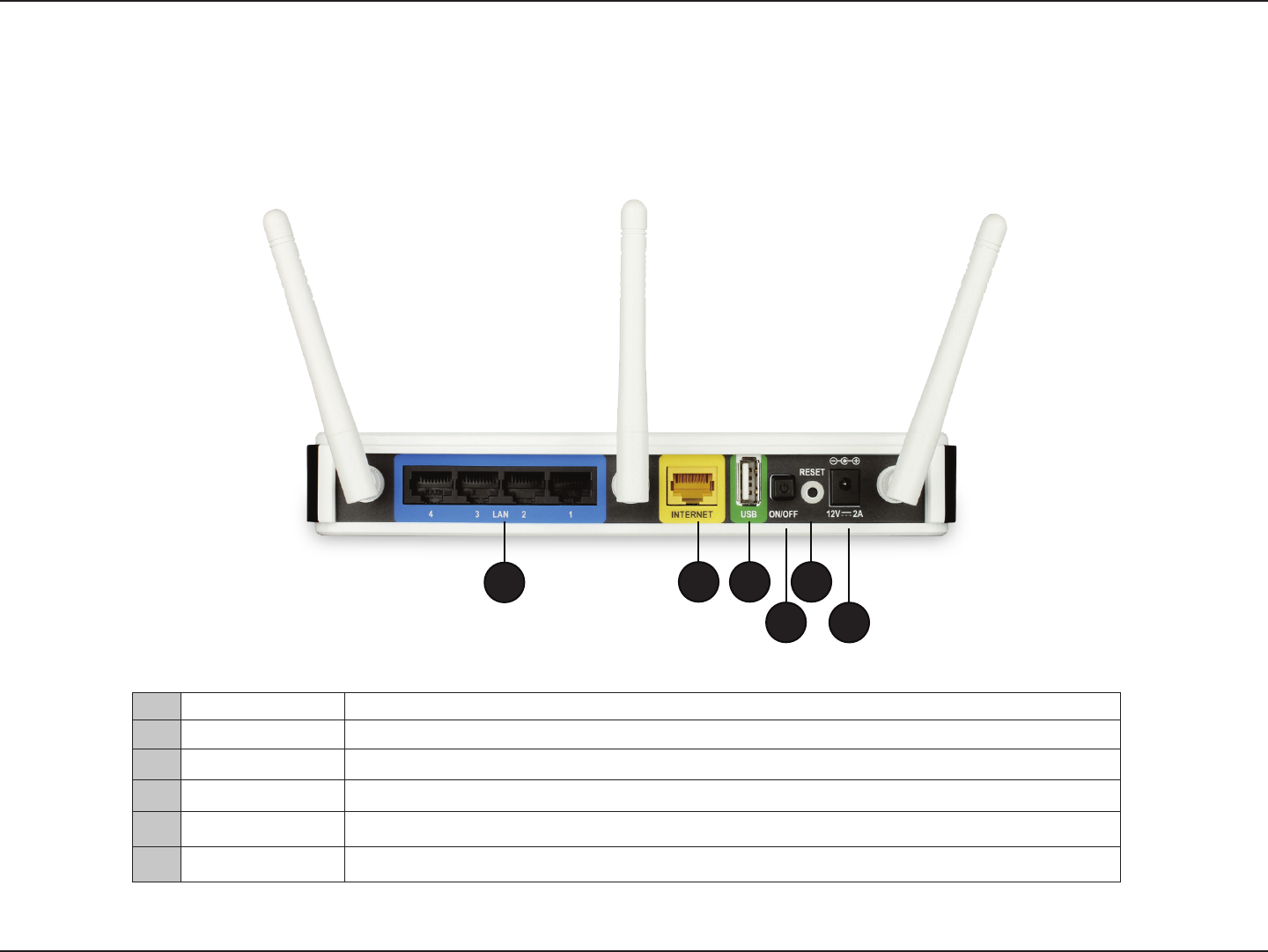
5D-Link DIR-655 User Manual
Section 1 - Product Overview
Hardware Overview
Connections
1LAN Ports (1-4) Connect Ethernet devices such as computers, switches, and hubs.
2Internet Port The auto MDI/MDIX Internet port is the connection for the Ethernet cable to the cable or DSL modem.
3USB Connect a USB ash drive or printer.
4On/O Button Pressing the on/o button toggles power to the router.
5Reset Pressing the Reset button restores the router to its original factory default settings.
6Power Receptor Receptor for the supplied power adapter.
12 3
6
5
4
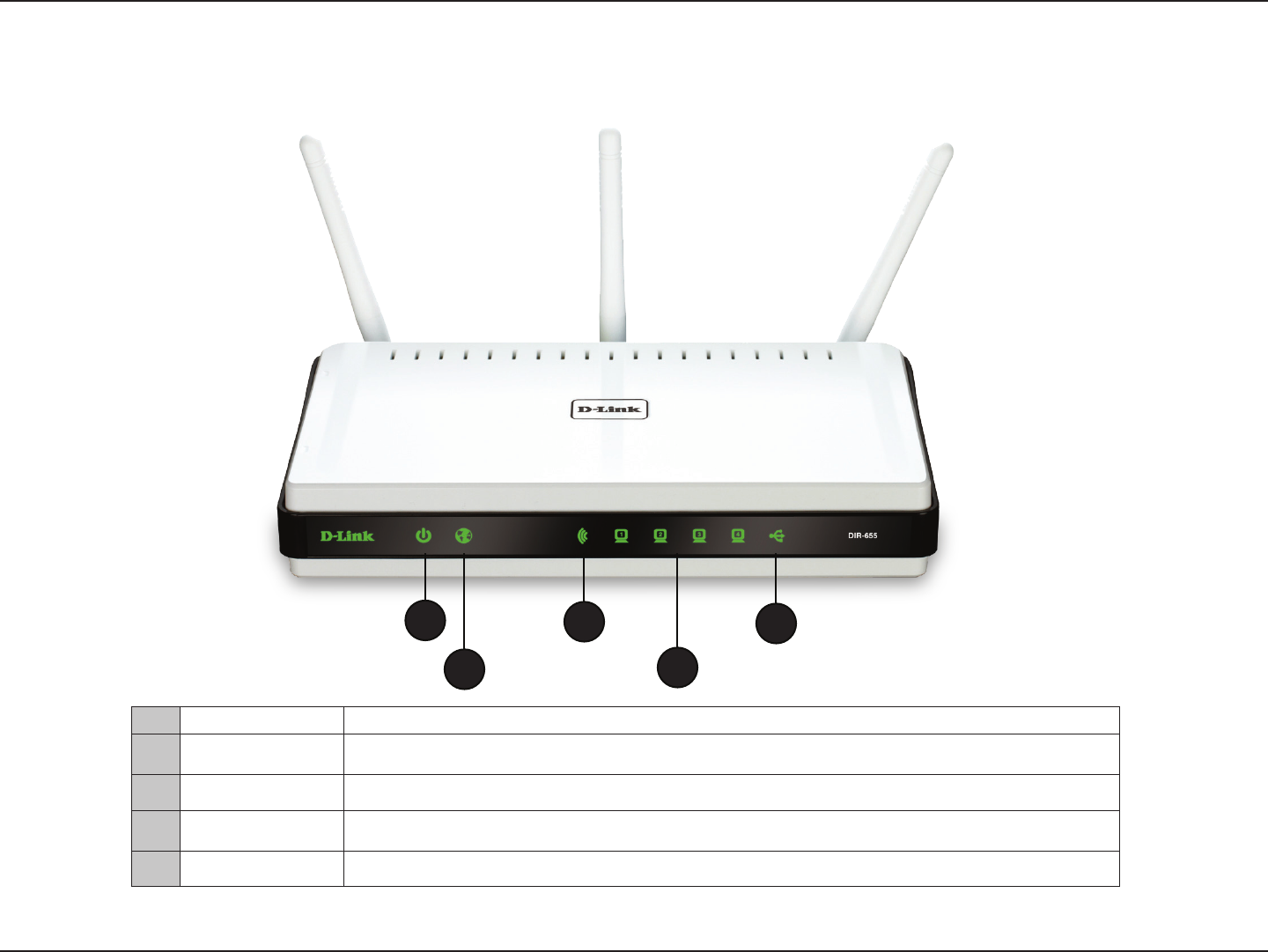
6D-Link DIR-655 User Manual
Section 1 - Product Overview
LEDs
1
2
3
4
5
1Power LED A solid light indicates a proper connection to the power supply.
2Internet LED A solid light indicates connection on the Internet port. This LED blinks during data transmission. A solid
blue light indicates that there is an Internet connection, an orange light indicates that there is none.
3WLAN LED A solid light indicates that the wireless segment is ready. This LED blinks during wireless data transmission.
4Local Network’s LED A solid light indicates a connection to an Ethernet-enabled computer on ports 1-4. This LED blinks during
data transmission.
5USB LED A solid light indicates a USB drive or a printer is plugged in.

7D-Link DIR-655 User Manual
Section 2 - Installation
Before you Begin
Installation
This section will walk you through the installation process. Placement of the router is very important. Do not place the router in an enclosed area
such as a closet, cabinet, or in the attic or garage.
Please congure the router with the computer that was last connected directly to your modem. Also, you can only use the Ethernet port on your
modem. If you were using the USB connection before using the router, then you must turn o your modem, disconnect the USB cable and connect
an Ethernet cable to the Internet port on the router, and then turn the modem back on. In some cases, you may need to call your ISP to change
connection types (USB to Ethernet).
If you have DSL and are connecting via PPPoE, make sure you disable or uninstall any PPPoE software such as WinPoET, BroadJump, or
EnterNet 300 from your computer or you will not be able to connect to the Internet.

8D-Link DIR-655 User Manual
Section 2 - Installation
Wireless Installation Considerations
The D-Link wireless router lets you access your network using a wireless connection from virtually anywhere within the operating range of your
wireless network. Keep in mind that the number, thickness and location of walls, ceilings, or other objects that the wireless signals must pass
through, may limit the range. Typical ranges vary depending on the types of materials and background RF (radio frequency) noise in your home or
business. The key to maximizing wireless range is to follow these basic guidelines:
1. Keep the number of walls and ceilings between the D-Link router and other network devices to a minimum - each wall or ceiling
can reduce your adapter’s range from 3-90 feet (1-30 meters.) Position your devices so that the number of walls or ceilings is
minimized.
2. Be aware of the direct line between network devices. A wall that is 1.5 feet thick (.5 meters), at a 45-degree angle appears to be
almost 3 feet (1 meter) thick. At a 2 degree angle it looks over 42 feet (14 meters) thick! Position devices so that the signal will
travel straight through a wall or ceiling (instead of at an angle) for better reception.
3. Building materials make a dierence. A solid metal door or aluminum studs may have a negative eect on range. Try to position
access points, wireless routers, and computers so that the signal passes through drywall or open doorways. Materials and objects
such as glass, steel, metal, walls with insulation, water (sh tanks), mirrors, le cabinets, brick, and concrete will degrade your
wireless signal.
4. Keep your product away (at least 3-6 feet or 1-2 meters) from electrical devices or appliances that generate RF noise.
5. If you are using 2.4 GHz cordless phones or X-10 (wireless products such as ceiling fans, lights, and home security systems), your
wireless connection may degrade dramatically or drop completely. Make sure your 2.4 GHz phone base is as far away from your
wireless devices as possible. The base transmits a signal even if the phone in not in use.
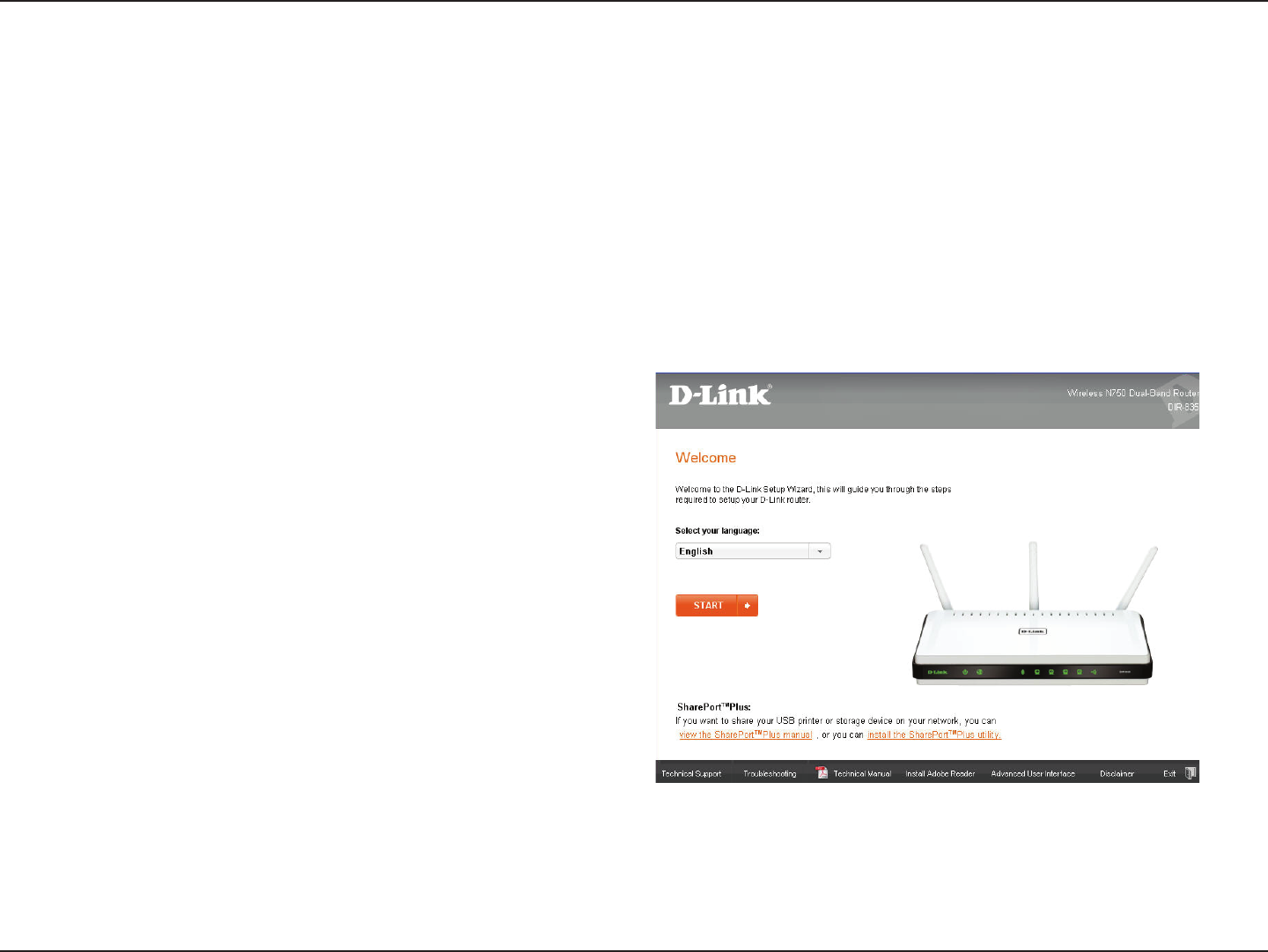
9D-Link DIR-655 User Manual
Section 3 - Conguration
The DIR-655 includes a Quick Router Setup Wizard CD. Follow the simple steps below to run the wizard to guide you quickly through the installation
process.
Insert the Wizard CD in the CD-ROM drive.
If the CD autorun function does not automatically start on your computer, go to Start > Run. In the run box type “D:\WIZARD.exe” (where D:
represents the drive letter of your CD-ROM drive).
When the autorun screen appears, click Start.
Getting Started
Note: It is recommended to write down the SSID and security key, followed by the login password on the provided CD holder.
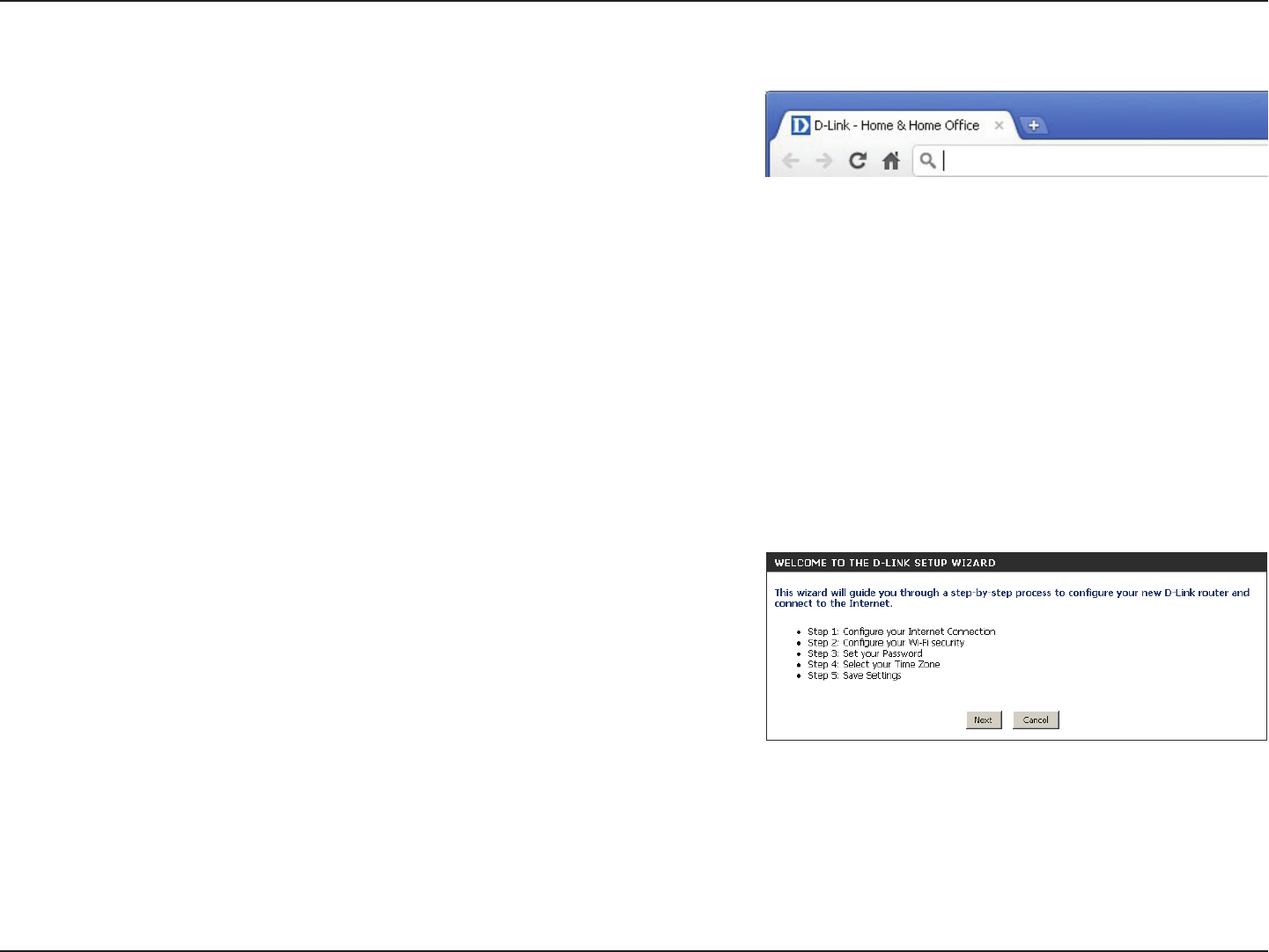
10D-Link DIR-655 User Manual
Section 3 - Conguration
If you did not run the setup wizard from the CD and this is the rst time logging
into the router, this wizard will start automatically.
This wizard is designed to guide you through a step-by-step process to
congure your new D-Link router and connect to the Internet.
Click Next to continue.
Quick Setup Wizard
If this is your rst time installing the router, open your web browser. You will
automatically be directed to the Wizard Setup Screen.
If you have already congured your settings and you would like to access the
conguration utility, please refer to page 16.
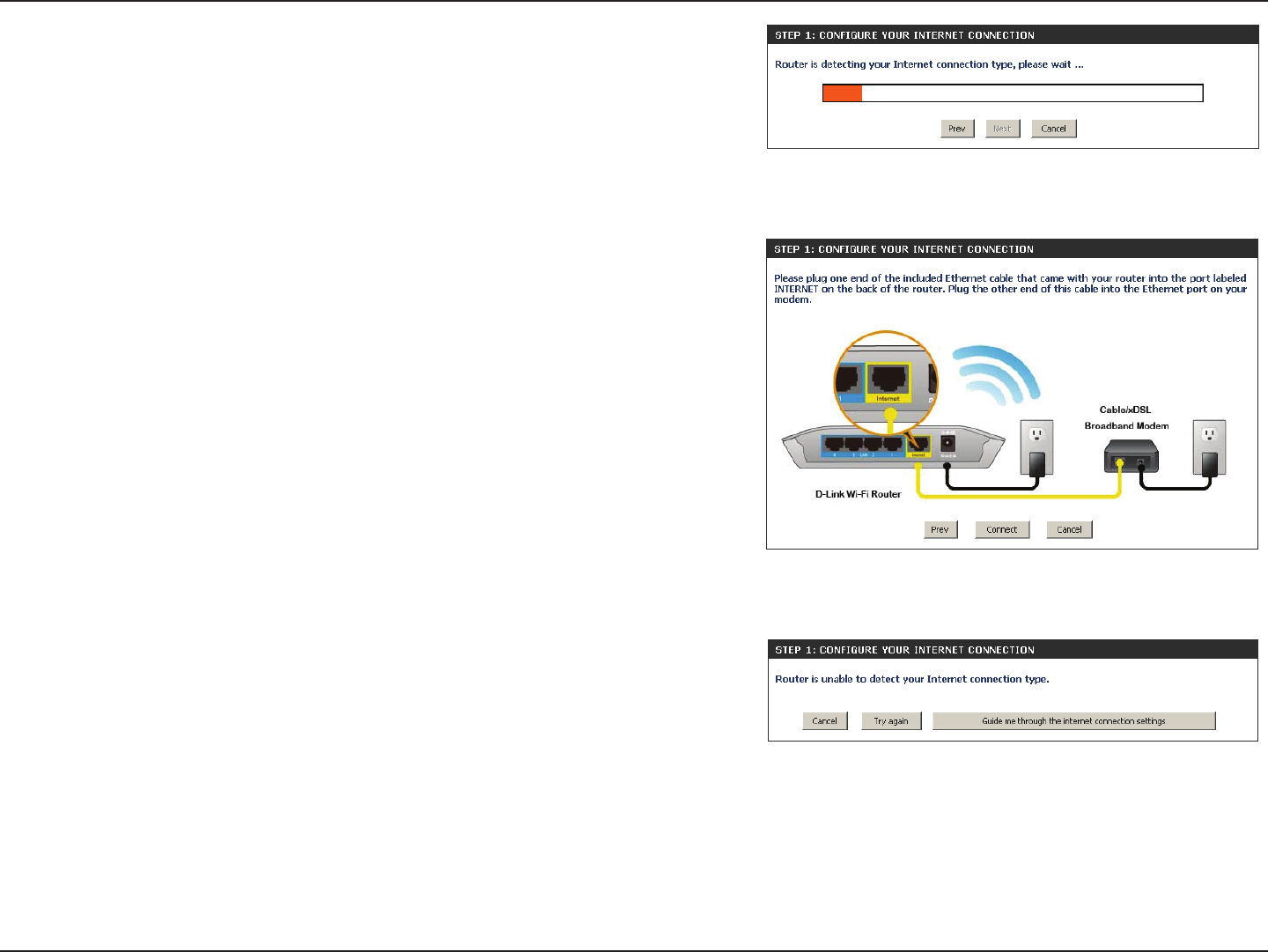
11D-Link DIR-655 User Manual
Section 3 - Conguration
Please wait while your router detects your internet connection type. If the router
detects your Internet connection, you may need to enter your ISP information
such as username and password.
If the router does not detect a valid Ethernet connection from the Internet
port, this screen will appear. Connect your broadband modem to the Internet
port and then click Try Again.
If the router detects an Ethernet connection but does not detect the type of
Internet connection you have, this screen will appear. Click Guide me through
the Internet Connection Settings to display a list of connection types to choose
from.
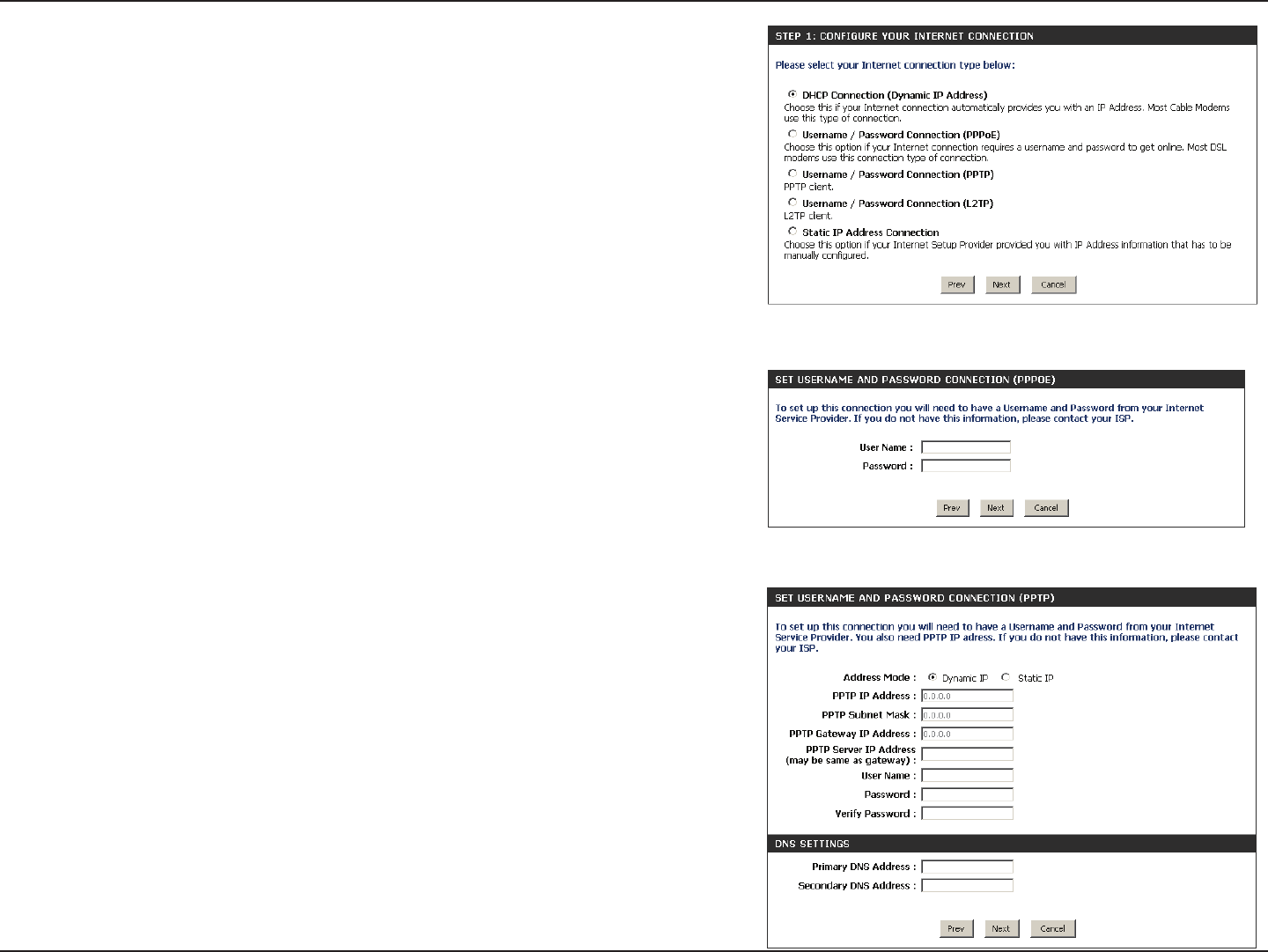
12D-Link DIR-655 User Manual
Section 3 - Conguration
Select your Internet connection type and click Next to continue.
If the router detected or you selected PPPoE, enter your PPPoE username and
password and click Next to continue.
Note: Make sure to remove your PPPoE software from your computer. The software
is no longer needed and will not work through a router.
If the router detected or you selected PPTP, enter your PPTP username,
password, and other information supplied by your ISP. Click Next to continue.
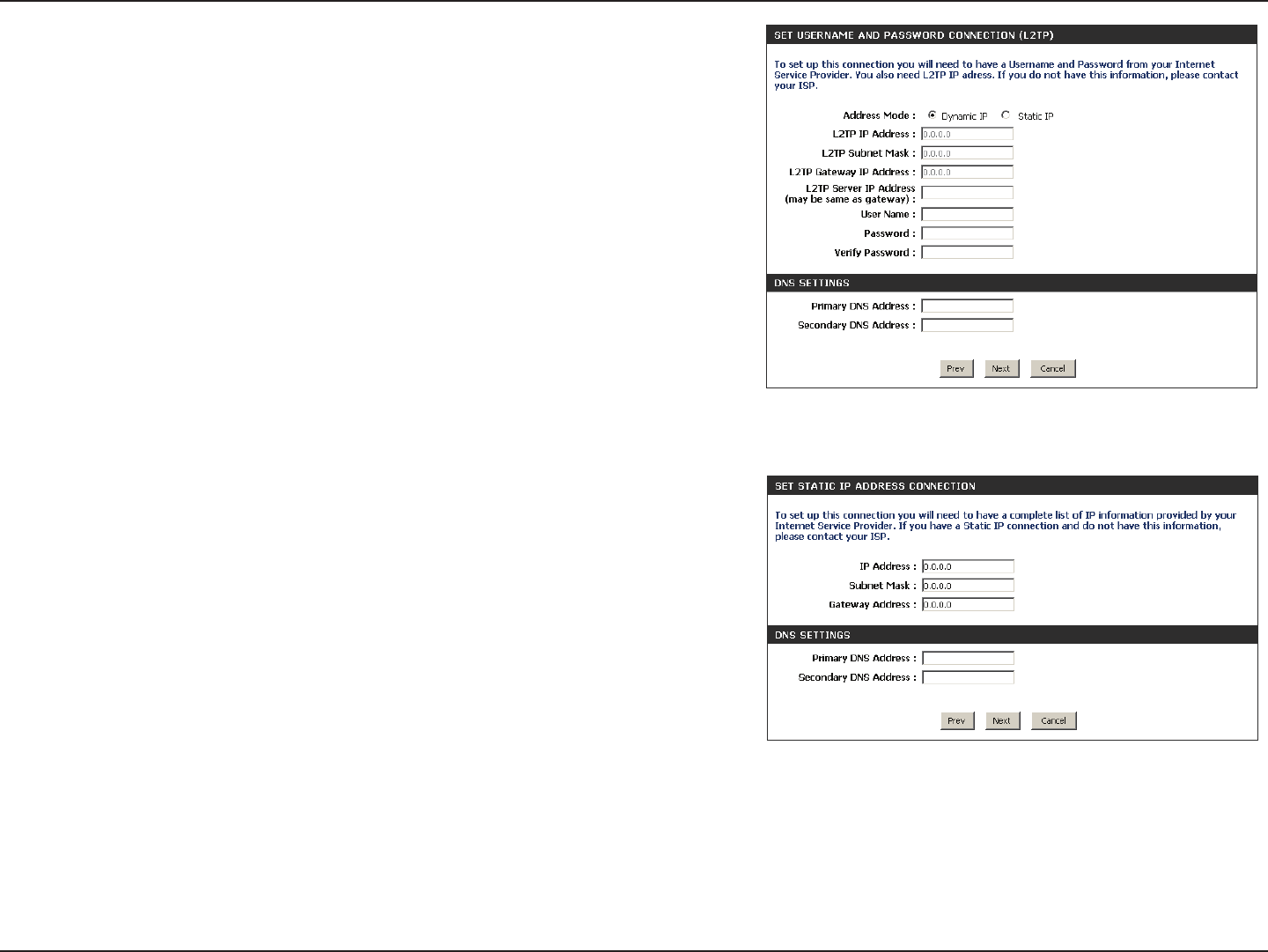
13D-Link DIR-655 User Manual
Section 3 - Conguration
If the router detected or you selected L2TP, enter your L2TP username,
password, and other information supplied by your ISP. Click Next to continue.
If the router detected or you selected Static, enter the IP and DNS settings
supplied by your ISP. Click Next to continue.
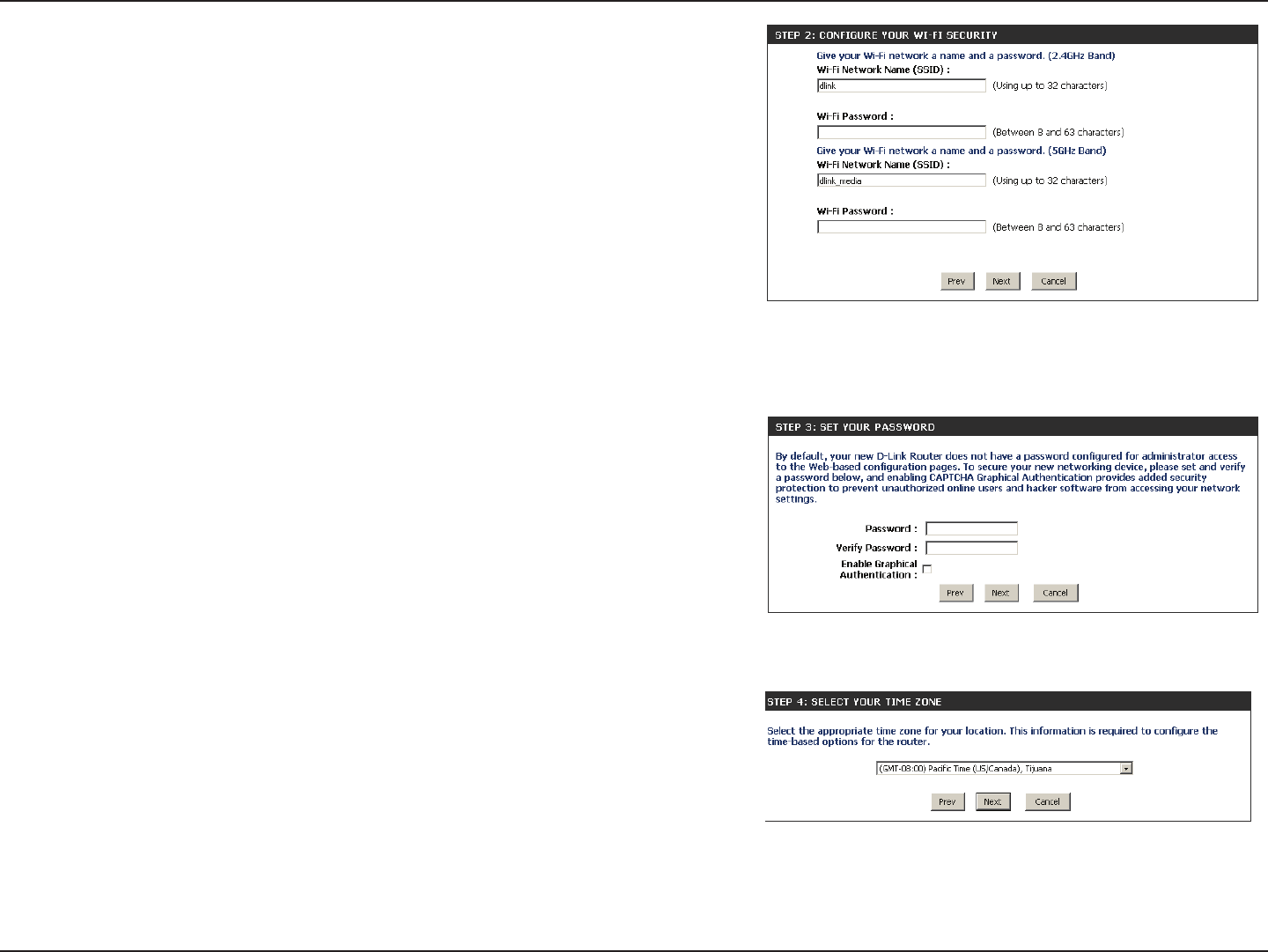
14D-Link DIR-655 User Manual
Section 3 - Conguration
For both the 2.4 GHz and 5 GHz segments, create a wireless network a name
(SSID) using up to 32 characters.
Create a wireless security passphrase or key (between 8-63 characters). Your
wireless clients will need to have this passphrase or key entered to be able to
connect to your wireless network.
Click Next to continue.
In order to secure your router, please enter a new password. Check the Enable
Graphical Authentication box to enable CAPTCHA authentication for added
security. Click Next to continue.
Select your time zone from the drop-down menu and click Next to continue.
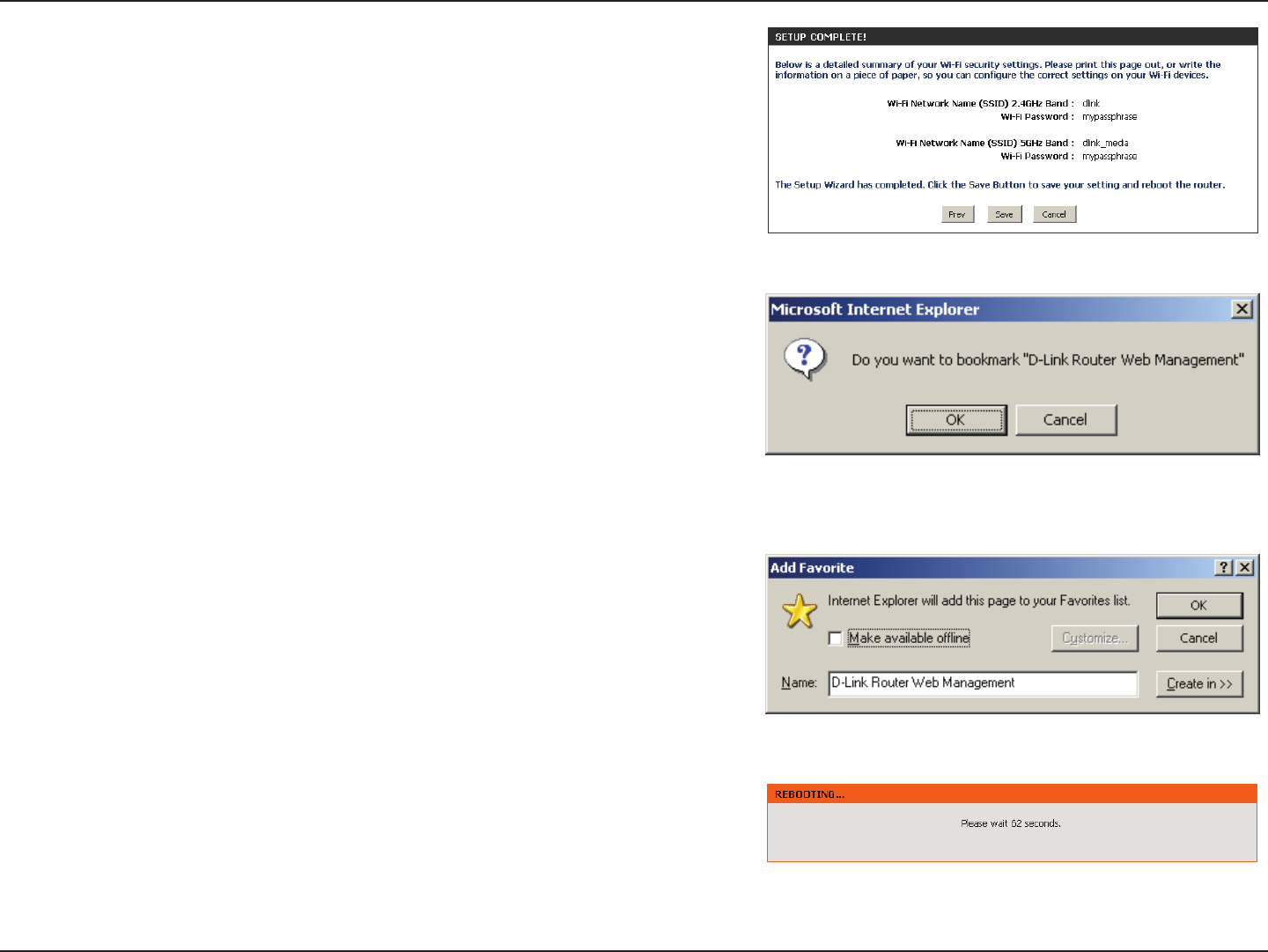
15D-Link DIR-655 User Manual
Section 3 - Conguration
The Setup Complete window will display your wireless settings. Click Save
and Connect to continue.
If you want to create a bookmark to the router, click OK. Click Cancel if you do
not want to create a bookmark.
If you clicked Yes, a window may appear (depending on what web browser
you are using) to create a bookmark.
The router will now reboot. Please allow a minute or two. Click the Continue
button once it is active.
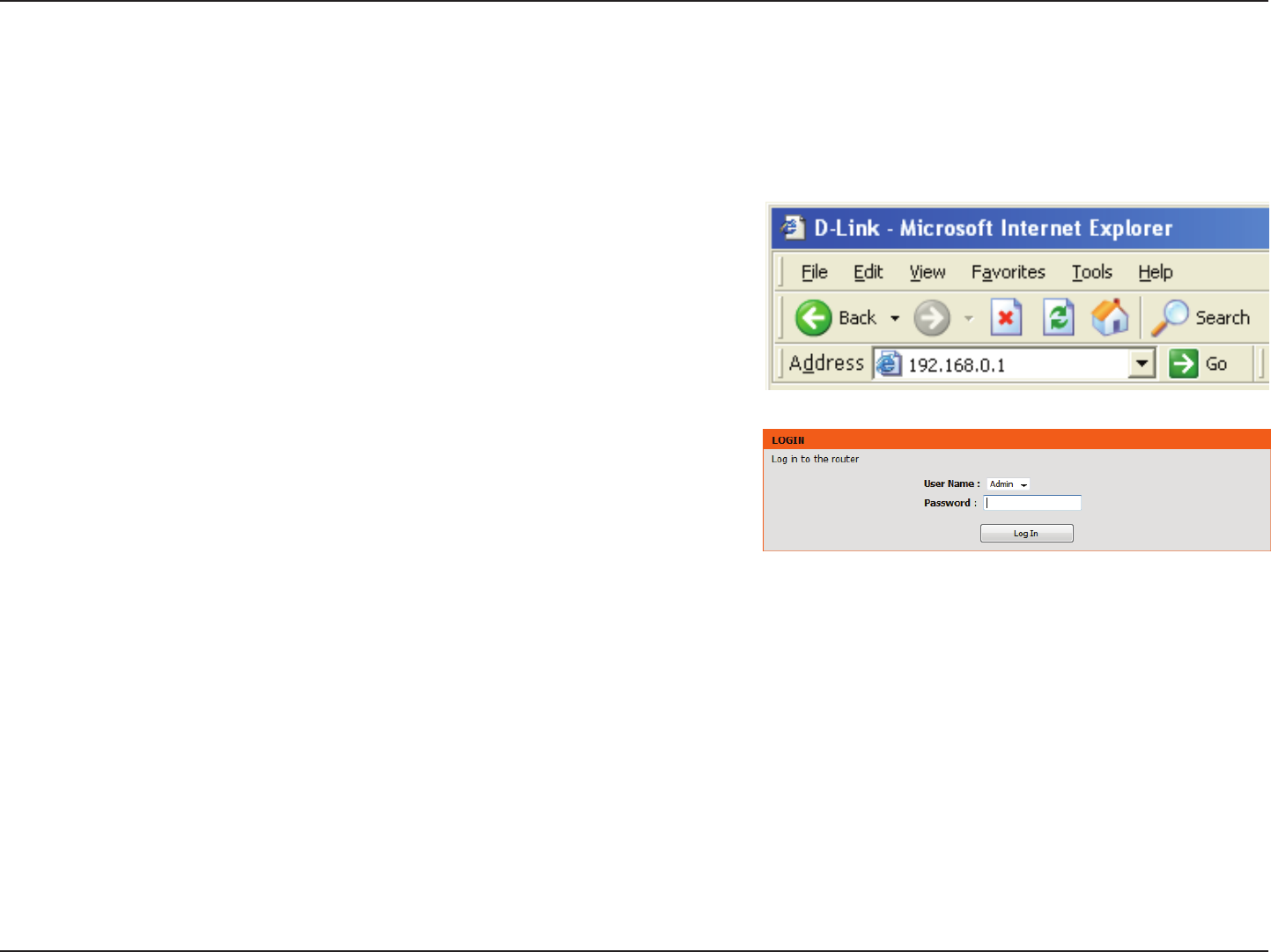
16D-Link DIR-655 User Manual
Section 3 - Conguration
To access the conguration utility, open a web-browser such as Internet
Explorer and enter the IP address of the router (192.168.0.1).
You can also enter http://dlinkrouter to connect.
Select Admin from the drop-down menu and then enter your password. The
password is left blank by default.
If you get a Page Cannot be Displayed error, please refer to the Troubleshooting
section for assistance.
Conguration
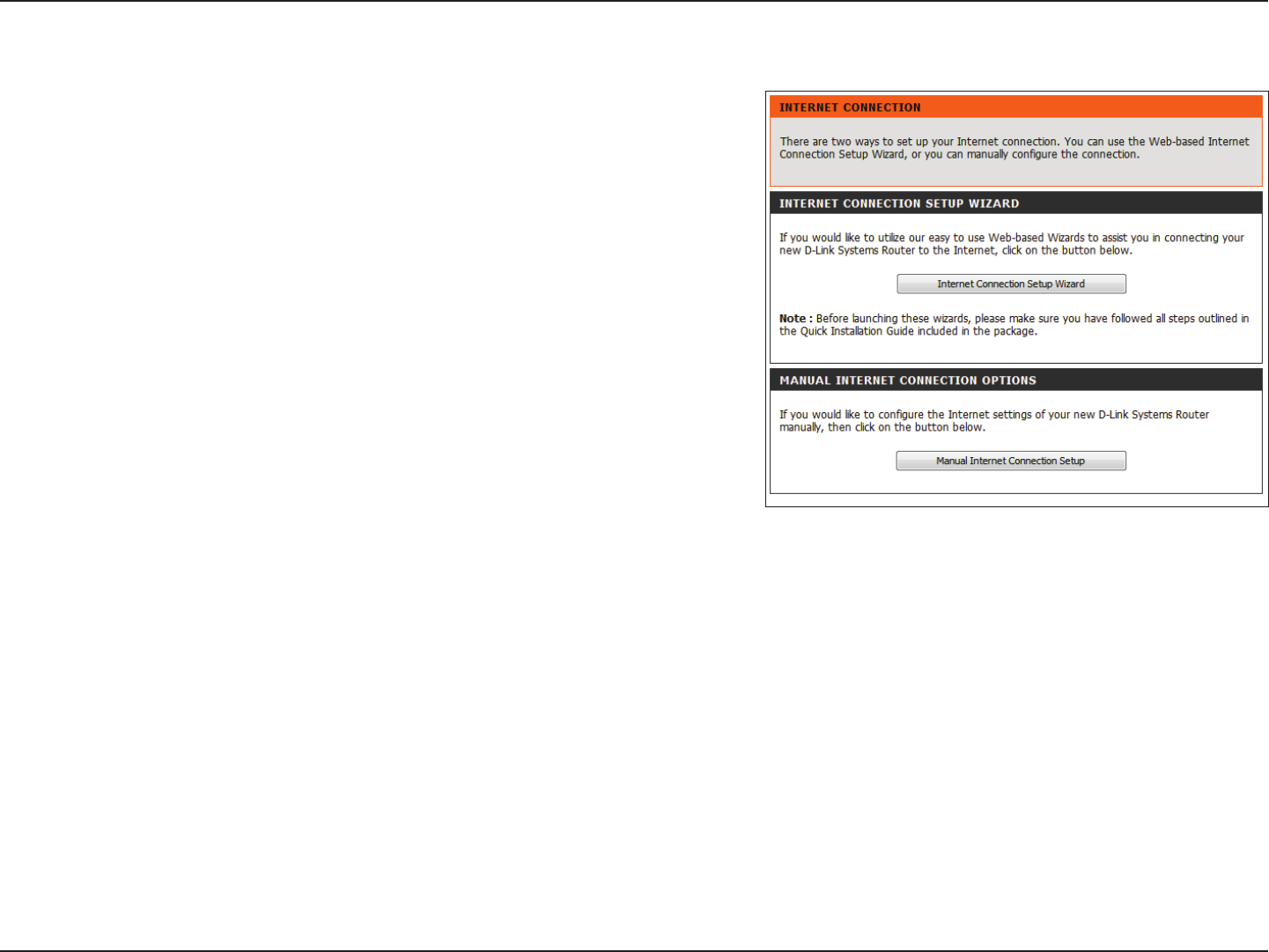
17D-Link DIR-655 User Manual
Section 3 - Conguration
Internet Connection Setup
You may click Internet Connection Setup Wizard to quickly congure your
router. Refer to page 10 for details.
If you want to enter your settings without running the wizard, click Manual
Internet Conguration Setup and skip to the next page.
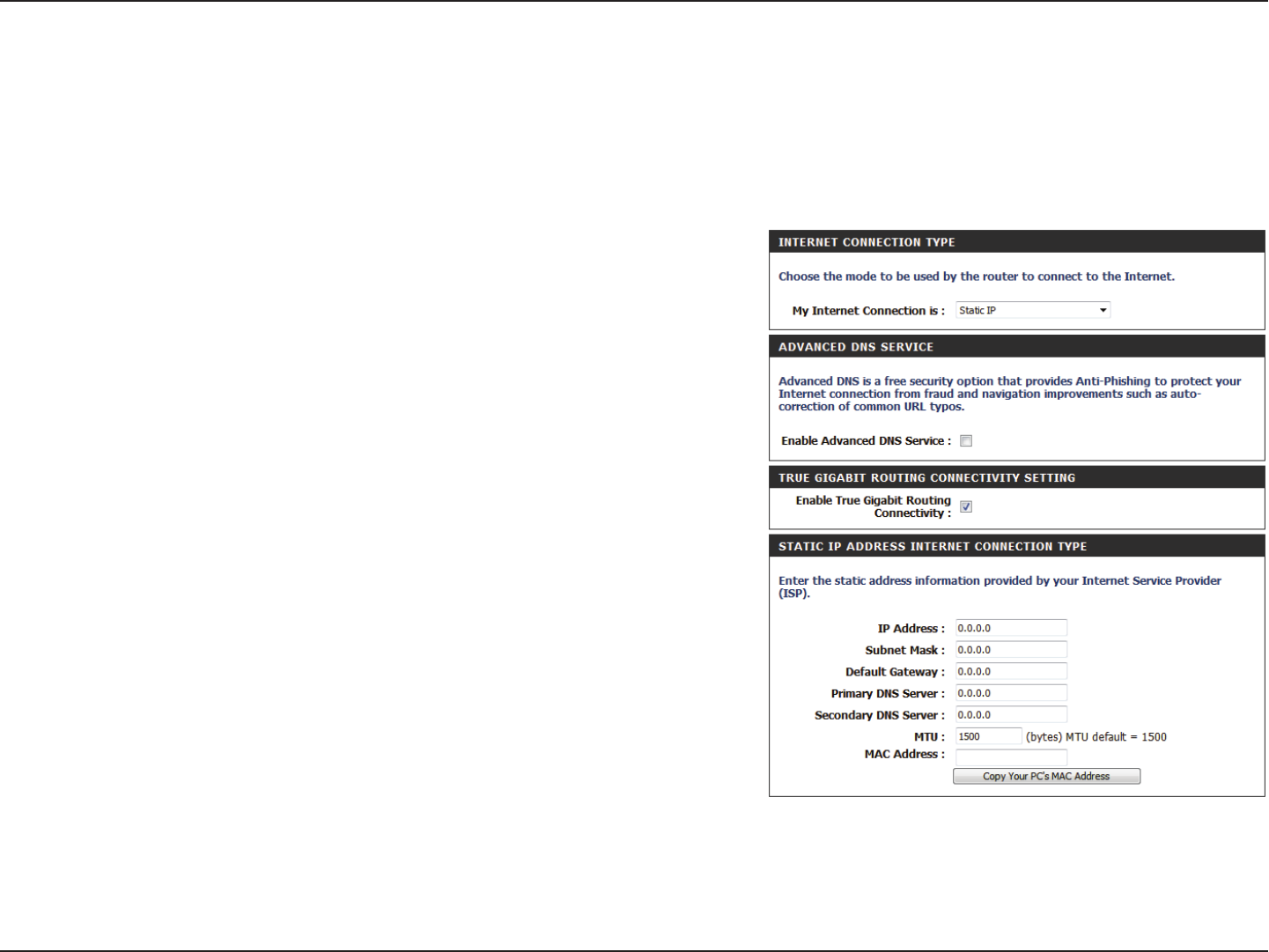
18D-Link DIR-655 User Manual
Section 3 - Conguration
Advanced Domain Name System (DNS) services enhances your Internet
performance by getting you the information and web pages you are looking
for faster and more reliably. In addition, it improves your overall Internet
experience by correcting many common typo mistakes automatically, taking
you where you intended to go and saving you valuable time.
Disclaimer: D-Link makes no warranty as to the availability, reliability,
functionality and operation of the Advanced DNS service or its features.
Check to enable true Gigabit routing. This will increase the throughput of
the WAN-LAN connectivity of the router.
Enter the IP address assigned by your ISP.
Enter the subnet mask assigned by your ISP.
Enter the gateway assigned by your ISP.
The DNS server information will be supplied by your ISP (Internet Service
Provider.)
Maximum Transmission Unit - you may need to change the MTU for optimal
performance with your specic ISP. 1500 is the default MTU.
The default MAC address is set to the Internet port’s physical interface MAC
address on the broadband router. It is not recommended that you change
the default MAC address unless required by your ISP. You can use the Clone
Your PC’s MAC Address button to replace the Internet port’s MAC address
with the MAC address of your Ethernet card.
Enable Advanced
DNS Service:
True Gigabit Routing
Connectivity Setting:
IP Address:
Subnet Mask:
Default Gateway:
DNS Servers:
MTU:
MAC Address:
Manual Conguration
Static IP
Select Static IP if your IP information is provided to you by your ISP. You will need to enter in the IP address, subnet mask, gateway address, and DNS
address(es) provided to you by your ISP. Each IP address entered in the elds must be in the appropriate IP form, which are four octets separated
by a dot (x.x.x.x). The router will not accept the IP address if it is not in this format.
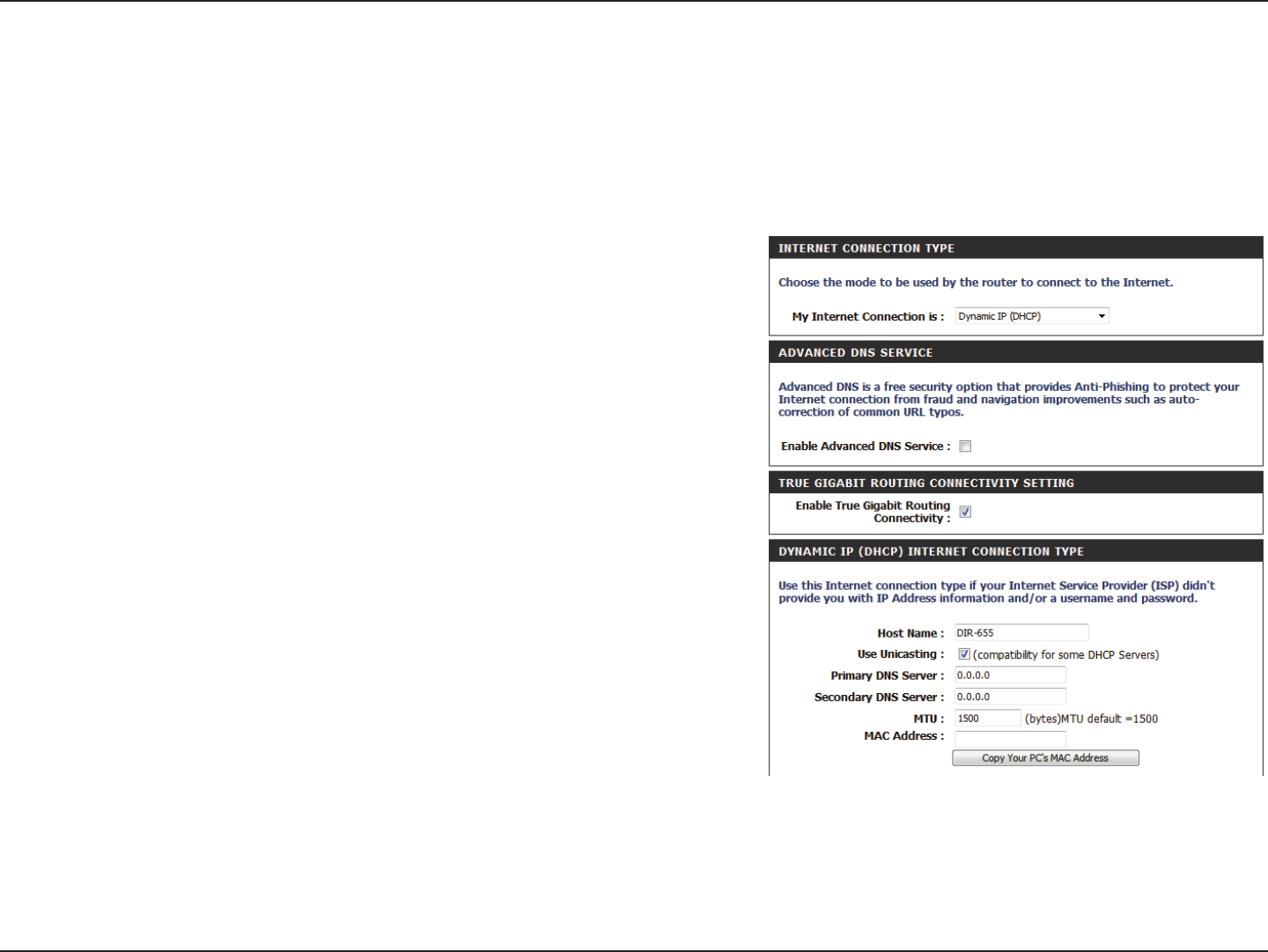
19D-Link DIR-655 User Manual
Section 3 - Conguration
Dynamic IP (DHCP)
Advanced Domain Name System (DNS) services enhances your Internet
performance by getting you the information and web pages you are looking
for faster and more reliably. In addition, it improves your overall Internet
experience by correcting many common typo mistakes automatically, taking
you where you intended to go and saving you valuable time.
Disclaimer: D-Link makes no warranty as to the availability, reliability, functionality
and operation of the Advanced DNS service or its features.
Check to enable true Gigabit routing. This will increase the throughput of
the WAN-LAN connectivity of the router.
The host name is optional but may be required by some ISPs. Leave blank
if you are not sure.
Check the box if you are having problems obtaining an IP address from your
ISP.
Enter the primary and secondary DNS server IP addresses assigned by your
ISP. These addresses are usually obtained automatically from your ISP. Leave
at 0.0.0.0 if you did not specically receive these from your ISP.
Maximum Transmission Unit - you may need to change the MTU for optimal
performance with your specic ISP. 1500 is the default MTU.
The default MAC address is set to the Internet port’s physical interface MAC
address on the broadband router. It is not recommended that you change
the default MAC address unless required by your ISP. You can use the Clone
Your PC’s MAC Address button to replace the Internet port’s MAC address
with the MAC address of your Ethernet card.
Enable
Advanced DNS
Service:
Host Name:
MAC Address:
Primary/Secondary
DNS Server:
MTU:
Use Unicasting:
True Gigabit Routing
Connectivity Setting:
Select Dynamic IP (DHCP) to obtain IP address information automatically from your ISP. Select this option if your ISP does not give you any IP
numbers to use. This option is commonly used for cable modem services such as Comcast and Cox.
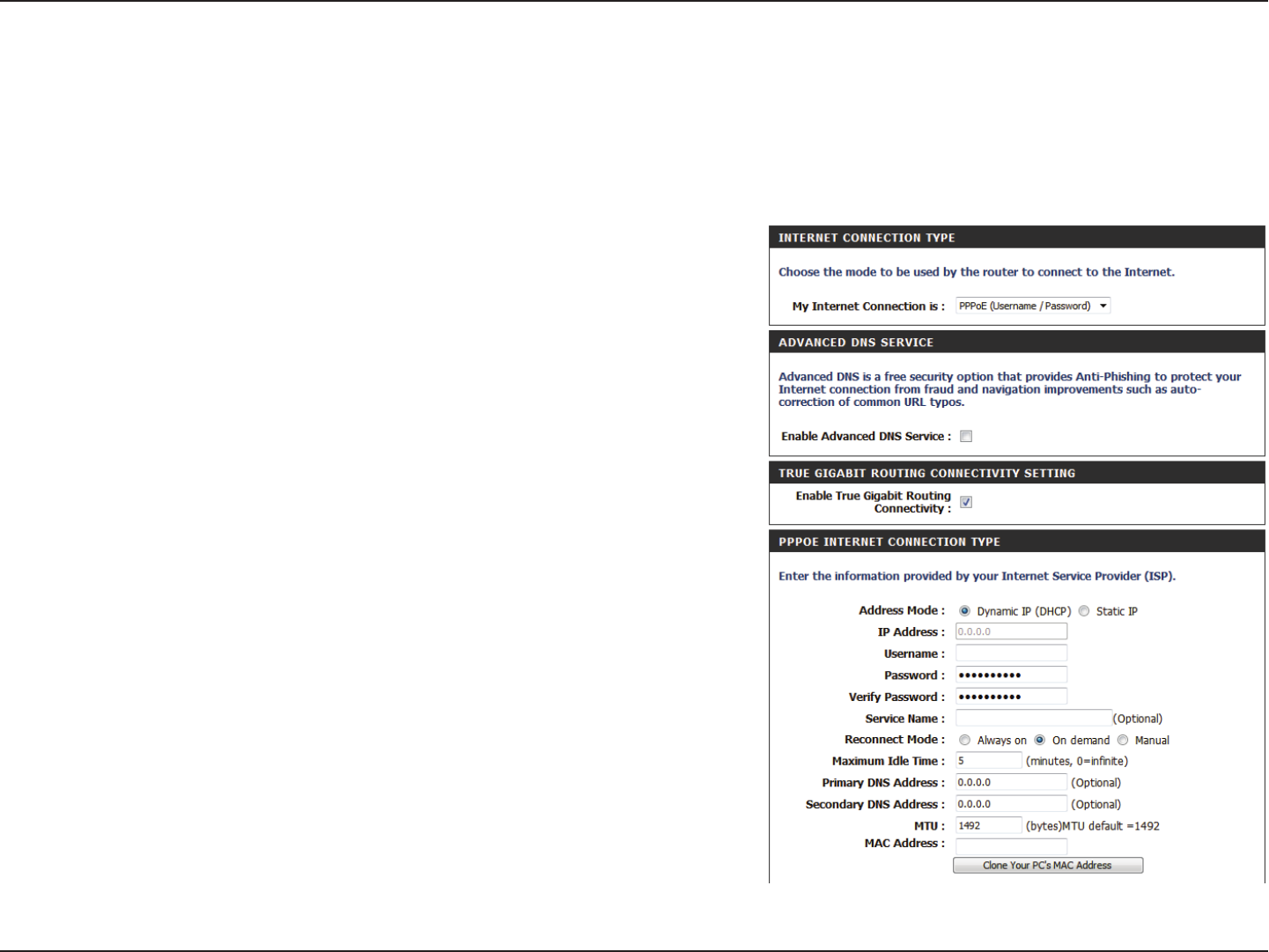
20D-Link DIR-655 User Manual
Section 3 - Conguration
Advanced Domain Name System (DNS) services enhances your Internet
performance by getting you the information and web pages you are looking
for faster and more reliably. In addition, it improves your overall Internet
experience by correcting many common typo mistakes automatically, taking
you where you intended to go and saving you valuable time.
Disclaimer: D-Link makes no warranty as to the availability, reliability,
functionality and operation of the Advanced DNS service or its features.
Check to enable true Gigabit routing. This will increase the throughput of
the WAN-LAN connectivity of the router.
Select Static if your ISP assigned you the IP address, subnet mask, gateway,
and DNS server addresses. In most cases, select Dynamic.
Enter the IP address (Static PPPoE only).
Enter your PPPoE user name.
Enter your PPPoE password and then retype the password in the next box.
Enter the ISP Service Name (optional).
Select either Always-on, On-Demand, or Manual.
Enter a maximum idle time during which the Internet connection
is maintained during inactivity. To disable this feature, enable Auto-
reconnect.
Enable Advanced
DNS Service:
True Gigabit Routing
Connectivity Setting:
Address Mode:
IP Address:
User Name:
Password:
Service Name:
Reconnection Mode:
Maximum Idle Time:
PPPoE (DSL)
Choose PPPoE (Point to Point Protocol over Ethernet) if your ISP uses a PPPoE connection. Your ISP will provide you with a username and password.
This option is typically used for DSL services. Make sure to remove your PPPoE software from your computer. The software is no longer needed and
will not work through a router.

21D-Link DIR-655 User Manual
Section 3 - Conguration
Enter the primary and secondary DNS server addresses (Static PPPoE only).
Maximum Transmission Unit - you may need to change the MTU for optimal
performance with your specic ISP. 1492 is the default MTU.
The default MAC address is set to the Internet port’s physical interface
MAC address on the broadband router. It is not recommended that you
change the default MAC address unless required by your ISP. You can use
the Clone Your PC’s MAC Address button to replace the Internet port’s
MAC address with the MAC address of your Ethernet card.
DNS Addresses:
MTU:
MAC Address:
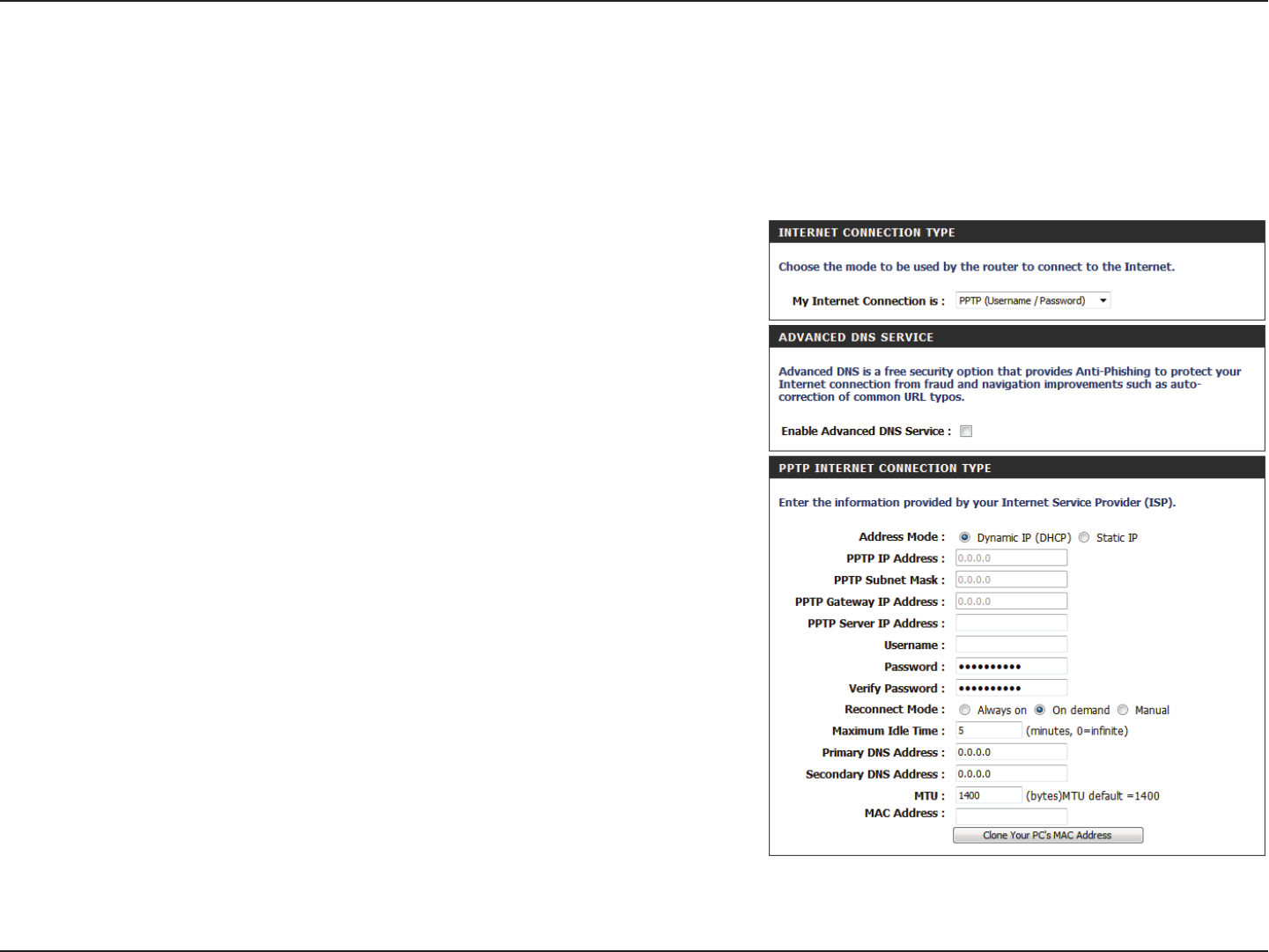
22D-Link DIR-655 User Manual
Section 3 - Conguration
Advanced Domain Name System (DNS) services enhances your Internet
performance by getting you the information and web pages you are looking
for faster and more reliably. In addition, it improves your overall Internet
experience by correcting many common typo mistakes automatically, taking
you where you intended to go and saving you valuable time.
Disclaimer: D-Link makes no warranty as to the availability, reliability, functionality
and operation of the Advanced DNS service or its features.
Select Static if your ISP assigned you the IP address, subnet mask, gateway,
and DNS server addresses. In most cases, select Dynamic.
Enter the IP address (Static PPTP only).
Enter the primary and secondary DNS server addresses (Static PPTP only).
Enter the gateway IP address provided by your ISP.
Enter the server IP provided by your ISP (optional).
Enter your PPTP username.
Enter your PPTP password and then retype the password in the next box.
Select either Always-on, On-Demand, or Manual.
Enter a maximum idle time during which the Internet connection is maintained
during inactivity. To disable this feature, enable Auto-reconnect.
The DNS server information will be supplied by your ISP (Internet Service
Provider.)
Enable Advanced
DNS Service:
Address Mode:
PPTP
Choose PPTP (Point-to-Point-Tunneling Protocol ) if your ISP uses a PPTP connection. Your ISP will provide you with a username and password. This
option is typically used for DSL services.
PPTP IP Address:
PPTP Subnet Mask:
PPTP Gateway:
PPTP Server IP:
Username:
Password:
Reconnect Mode:
Maximum Idle Time:
DNS Addresses:

23D-Link DIR-655 User Manual
Section 3 - Conguration
Maximum Transmission Unit - you may need to change the MTU for optimal
performance with your specic ISP. 1400 is the default MTU.
The default MAC address is set to the Internet port’s physical interface MAC
address on the broadband router. It is not recommended that you change
the default MAC address unless required by your ISP. You can use the Clone
Your PC’s MAC Address button to replace the Internet port’s MAC address
with the MAC address of your Ethernet card.
MTU:
MAC Address:
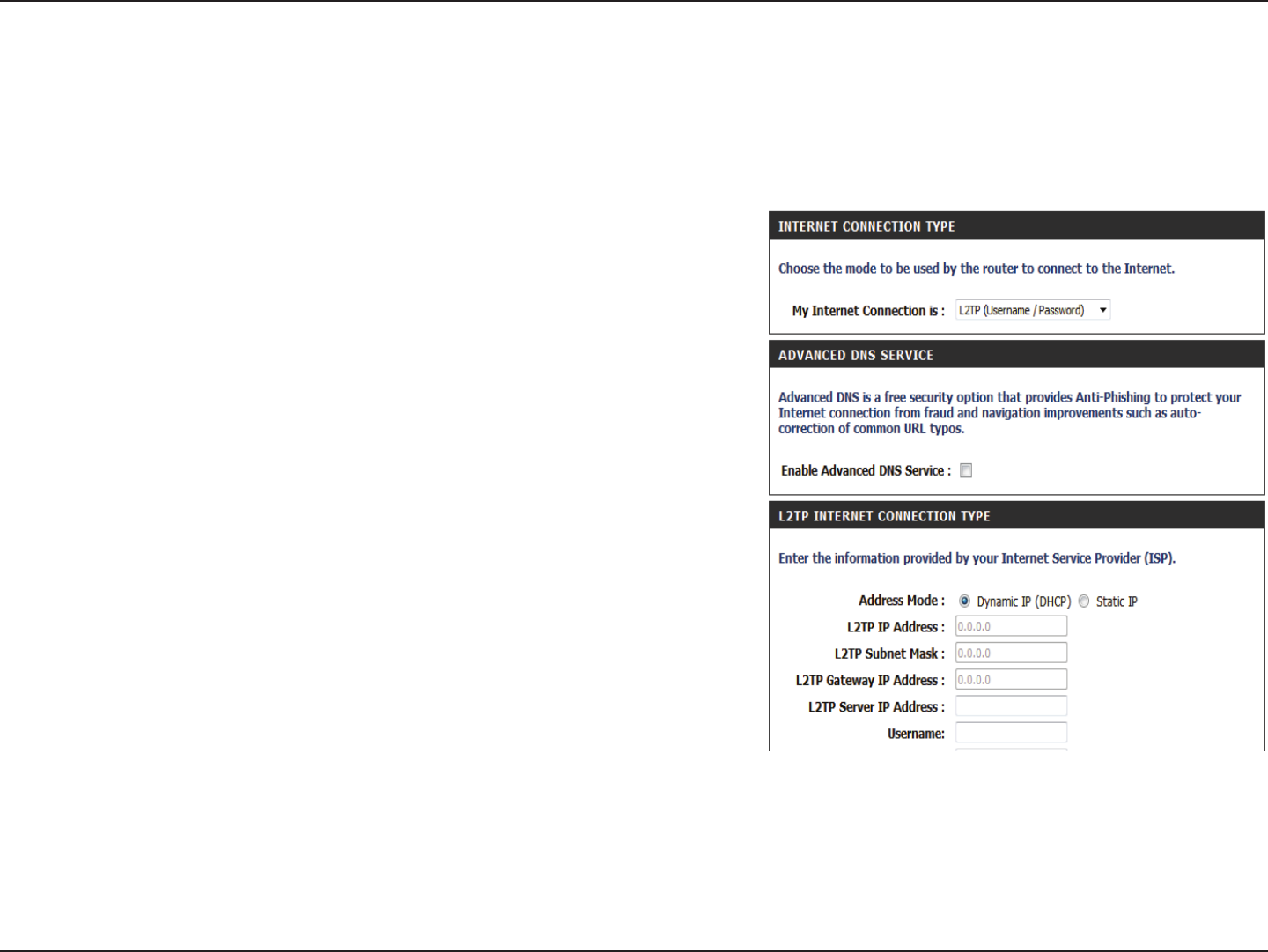
24D-Link DIR-655 User Manual
Section 3 - Conguration
Advanced Domain Name System (DNS) services enhances your Internet
performance by getting you the information and web pages you are looking
for faster and more reliably. In addition, it improves your overall Internet
experience by correcting many common typo mistakes automatically, taking
you where you intended to go and saving you valuable time.
Disclaimer: D-Link makes no warranty as to the availability, reliability, functionality
and operation of the Advanced DNS service or its features.
Select Static if your ISP assigned you the IP address, subnet mask, gateway,
and DNS server addresses. In most cases, select Dynamic.
Enter the L2TP IP address supplied by your ISP (Static only).
Enter the subnet mask supplied by your ISP (Static only).
Enter the gateway IP address provided by your ISP.
Enter the server IP provided by your ISP (optional).
Enter your L2TP username.
Enter your L2TP password and then retype the password in the next box.
Select either Always-on, On-Demand, or Manual.
Enter a maximum idle time during which the Internet connection is maintained
during inactivity. To disable this feature, enable Auto-reconnect.
Enter the primary and secondary DNS server addresses (Static L2TP only).
Enable Advanced
DNS Service:
Address Mode:
L2TP IP Address:
L2TP Subnet Mask:
L2TP Gateway:
L2TP Server IP:
Username:
Password:
Reconnect Mode:
Maximum Idle Time:
DNS Servers:
L2TP
Choose L2TP (Layer 2 Tunneling Protocol) if your ISP uses a L2TP connection. Your ISP will provide you with a username and password. This option
is typically used for DSL services.

25D-Link DIR-655 User Manual
Section 3 - Conguration
Maximum Transmission Unit - you may need to change the MTU for optimal
performance with your specic ISP. 1400 is the default MTU.
The default MAC address is set to the Internet port’s physical interface MAC
address on the broadband router. It is not recommended that you change
the default MAC address unless required by your ISP. You can use the Clone
Your PC’s MAC Address button to replace the Internet port’s MAC address
with the MAC address of your Ethernet card.
MTU:
Clone MAC Address:
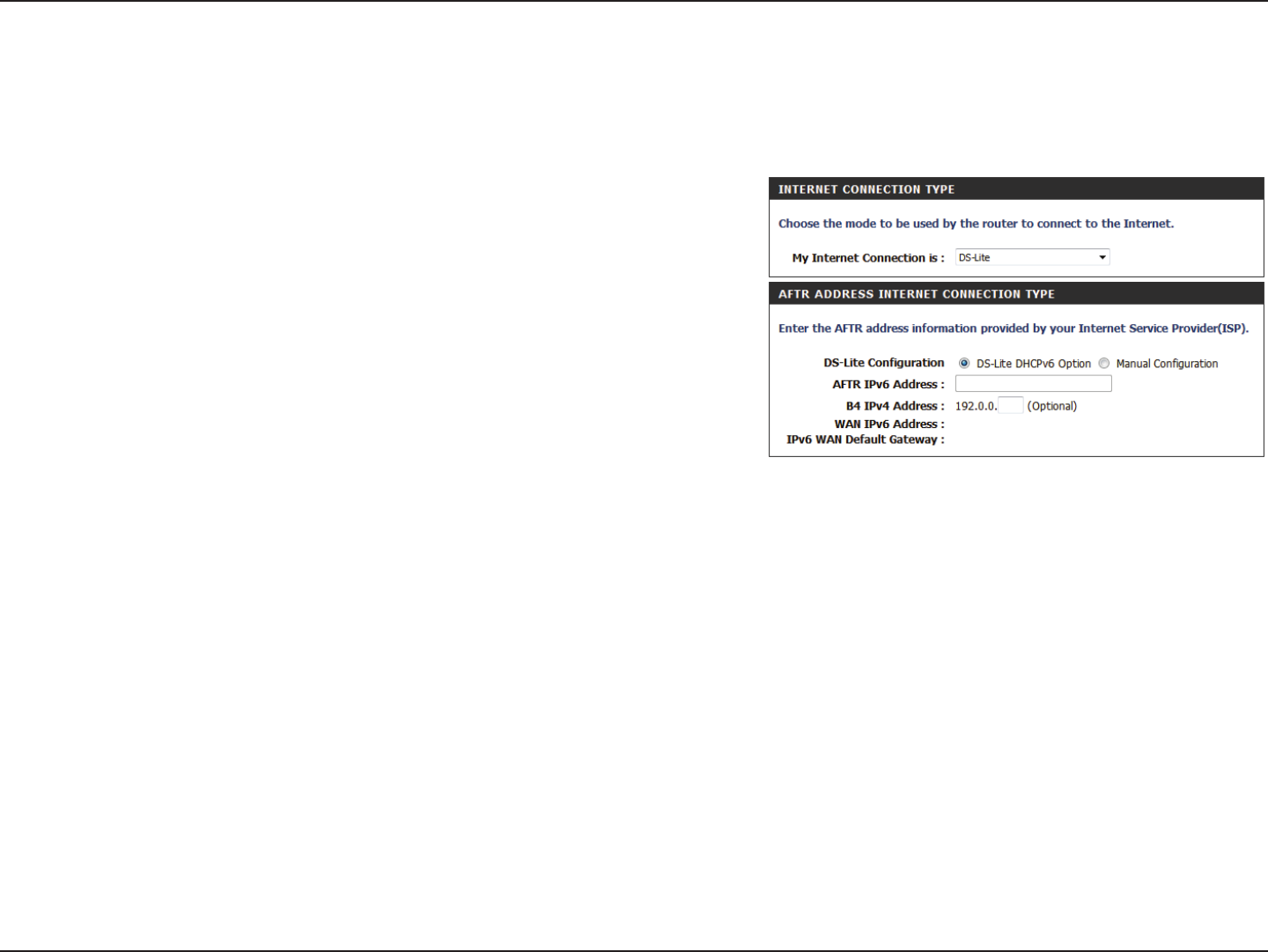
26D-Link DIR-655 User Manual
Section 3 - Conguration
DS-Lite
DS-Lite is an IPv6 connection type. After selecting DS-Lite, the following parameters will be available for conguration:
DS-Lite Conguration:
AFTR IPv6 Address:
B4 IPv6 Address:
WAN IPv6 Address:
IPv6 WAN Default
Gateway:
Select DS-Lite DHCPv6 Option to let the router allocate the AFTR IPv6
address automatically. Select Manual Conguration to enter the AFTR IPv6
address in manually.
After selecting the Manual Conguration option above, enter the AFTR IPv6
address used here.
Enter the B4 IPv4 address value used here.
Once connected, the WAN IPv6 address will be displayed here.
Once connected, the IPv6 WAN default gateway address will be displayed
here.
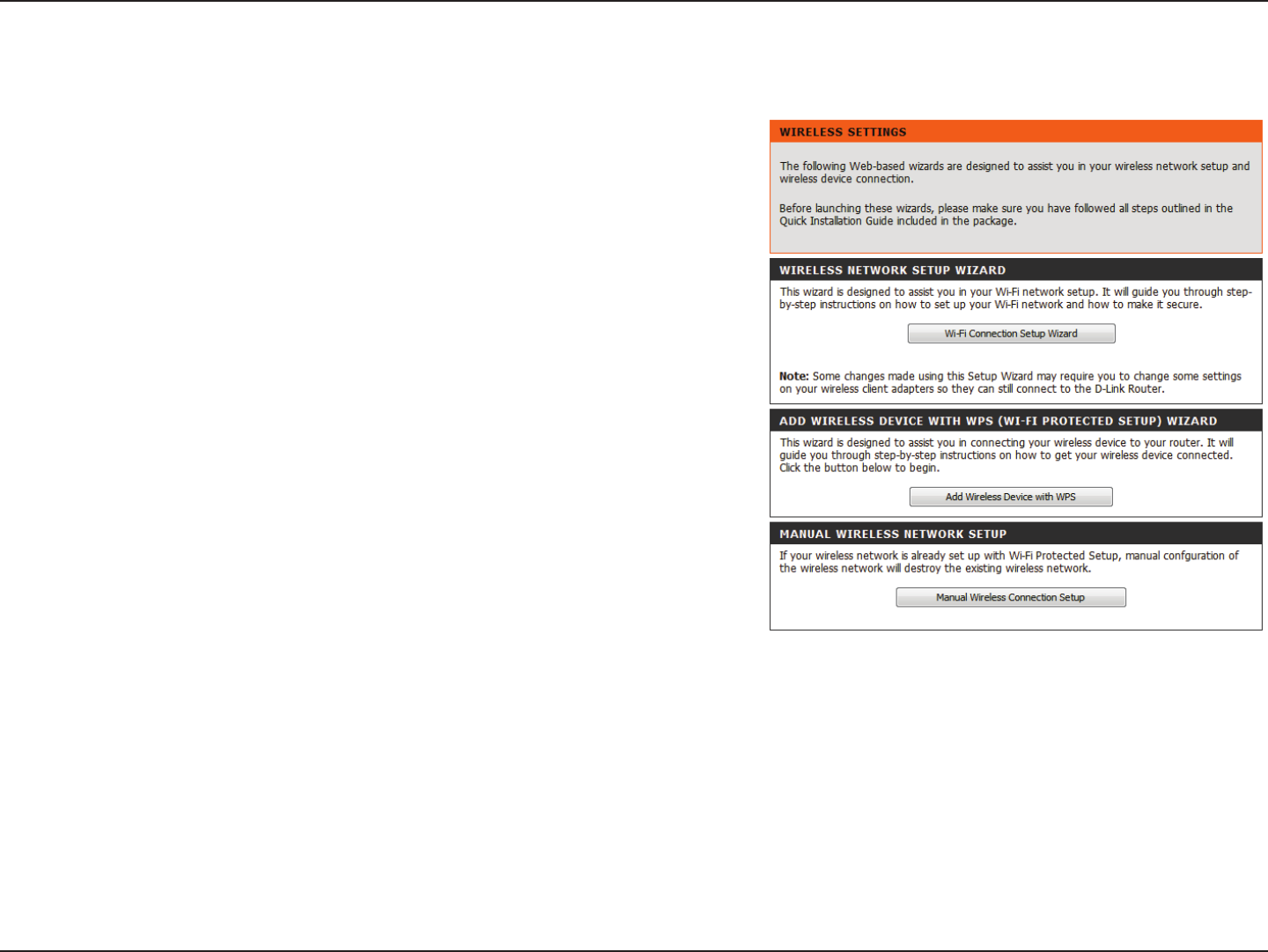
27D-Link DIR-655 User Manual
Section 3 - Conguration
Wireless Settings
If you want to congure the wireless settings on your router using the wizard,
click Wireless Security Setup Wizard and refer to page 37.
Click Add Wireless Device with WPS if you want to add a wireless device using
Wi-Fi Protected Setup (WPS) and refer to page 93.
If you want to manually congure the wireless settings on your router click
Manual Wireless Network Setup and refer to the next page.
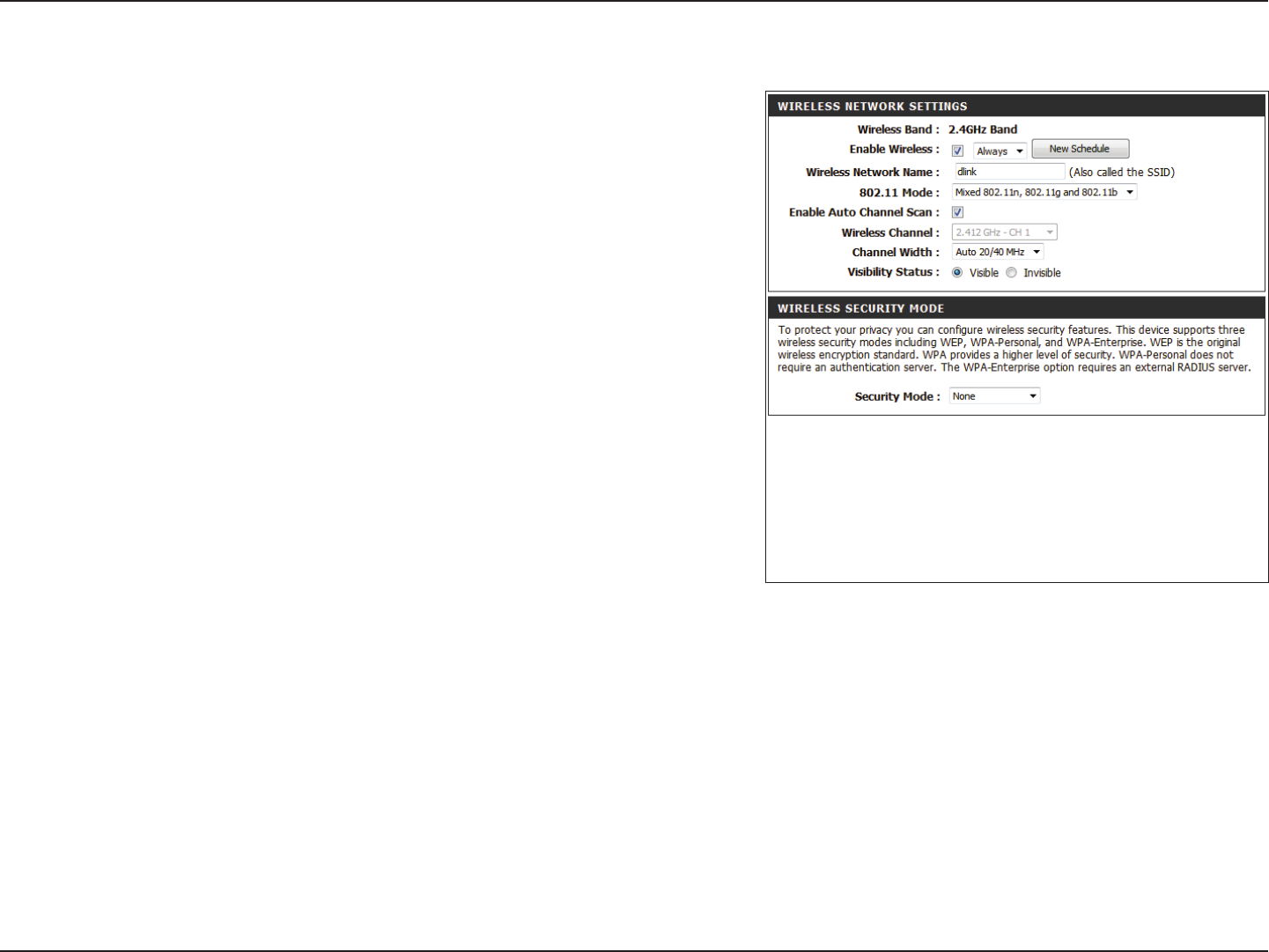
28D-Link DIR-655 User Manual
Section 3 - Conguration
Check the box to enable the wireless function. If you do not want to use
wireless, uncheck the box to disable all the wireless functions.
The schedule of time when the wireless settings rules will be enabled. The
schedule may be set to Always, which will allow the particular service to
always be enabled. You can create your own times in the Tools > Schedules
section.
Service Set Identifier (SSID) is the name of your wireless network. Create
a name using up to 32 characters. The SSID is case-sensitive.
The Auto Channel Scan setting can be selected to allow the DIR-655 to choose
the channel with the least amount of interference.
Indicates the channel setting for the DIR-655. By default the channel is set
to 6. The channel can be changed to t the channel setting for an existing
wireless network or to customize the wireless network. If you enable Auto
Channel Scan, this option will be greyed out.
Select one of the following:
802.11g Only - Select if all of your wireless clients are 802.11g.
802.11n Only - Select only if all of your wireless clients are 802.11n.
Mixed 802.11n and 802.11g - Select if you are using a mix of 802.11n and
11g wireless clients.
Select the channel width:
Auto 20/40 - This is the default setting. Select if you are
using both 802.11n and non-802.11n wireless devices.
20MHz - Select if you are not using any 802.11n wireless clients.
40MHz - Select if using only 802.11n wireless clients.
Select the transmit rate. It is strongly suggested to select Best (Auto) for
best performance.
Select Invisible if you do not want the SSID of your wireless network to be
broadcasted by the DIR-655. If Invisible is selected, the SSID of the DIR-655
will not be seen by Site Survey utilities so your wireless clients will have to
know the SSID of your DIR-655
Enable Wireless:
Enable Auto Channel
Scan:
Manual Wireless Connection Setup
Wireless Network
Name:
Wireless Channel:
802.11 Mode:
Channel Width:
Transmission Rate:
Visibility Status:
Schedule:

29D-Link DIR-655 User Manual
Section 3 - Conguration
Wireless Security
This section will show you the dierent levels of security you can use to protect your data from intruders. The
DIR-655 oers the following types of security:
• WPA2™ (Wi-Fi Protected Access 2) • WPA2-PSK (Pre-Shared Key)
• WPA™ (Wi-Fi Protected Access) • WPA-PSK (Pre-Shared Key)
What is WPA?
WPA, or Wi-Fi Protected Access, is a Wi-Fi standard that was designed to improve the security features of WEP (Wired Equivalent Privacy).
The 2 major improvements over WEP:
• Improved data encryption through the Temporal Key Integrity Protocol (TKIP). TKIP scrambles the keys using a hashing algorithm
and, by adding an integrity-checking feature, ensures that the keys haven’t been tampered with. WPA2 is based on 802.11i and
uses Advanced Encryption Standard (AES) instead of TKIP.
• User authentication, which is generally missing in WEP, through the extensible authentication protocol (EAP). WEP regulates access
to a wireless network based on a computer’s hardware-specic MAC address, which is relatively simple to be snied out and stolen.
EAP is built on a more secure public-key encryption system to ensure that only authorized network users can access the network.
WPA-PSK/WPA2-PSK uses a passphrase or key to authenticate your wireless connection. The key is an alpha-numeric password between 8 and 63
characters long. The password can include symbols (!?*&_) and spaces. This key must be the exact same key entered on your wireless router or
access point.
WPA/WPA2 incorporates user authentication through the Extensible Authentication Protocol (EAP). EAP is built on a more secure public key encryption
system to ensure that only authorized network users can access the network.
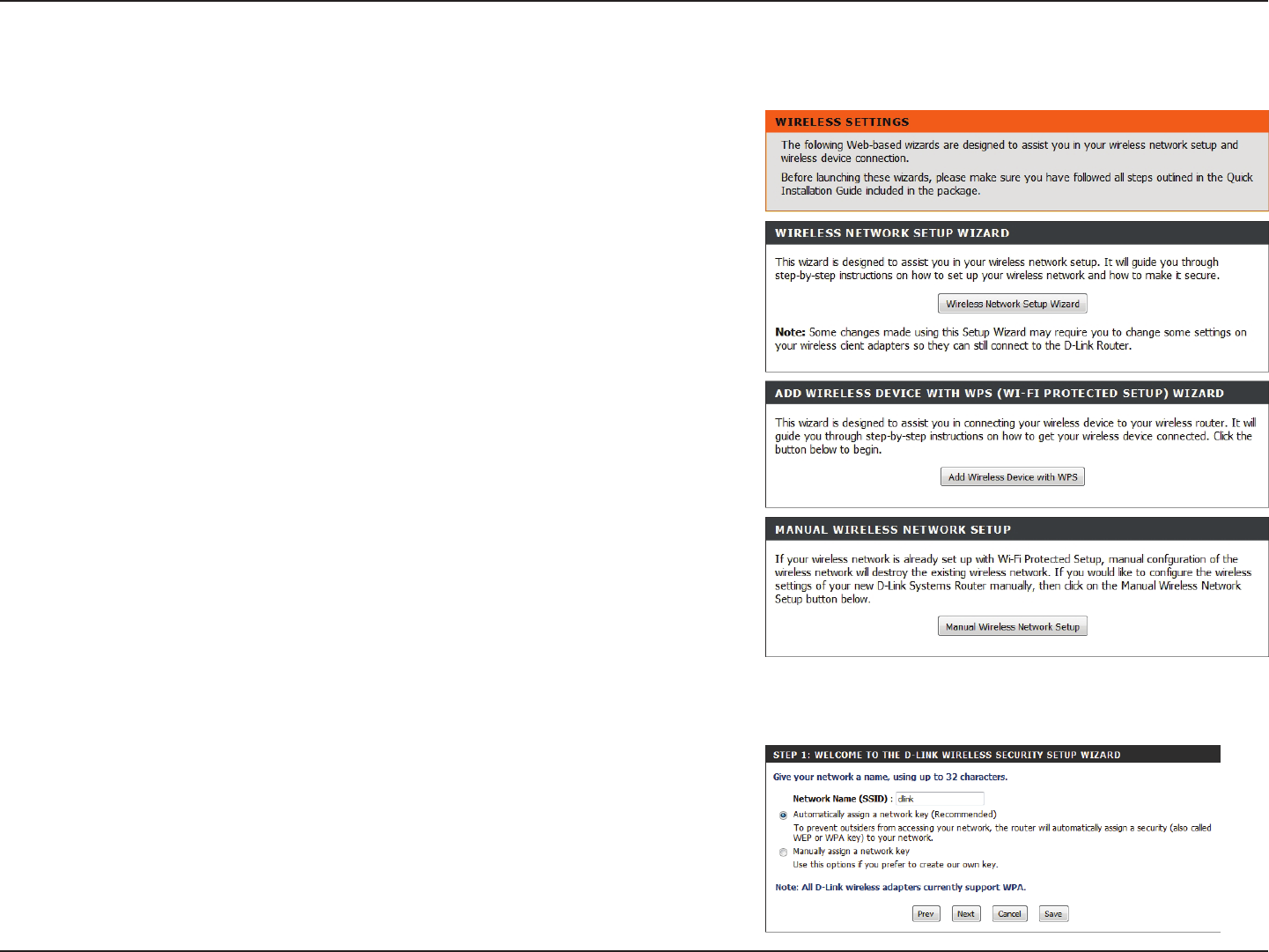
30D-Link DIR-655 User Manual
Section 3 - Conguration
Wireless Security Setup Wizard
To run the security wizard, click on Setup at the top and then click Launch
Wireless Security Setup Wizard.
Click Next to continue.
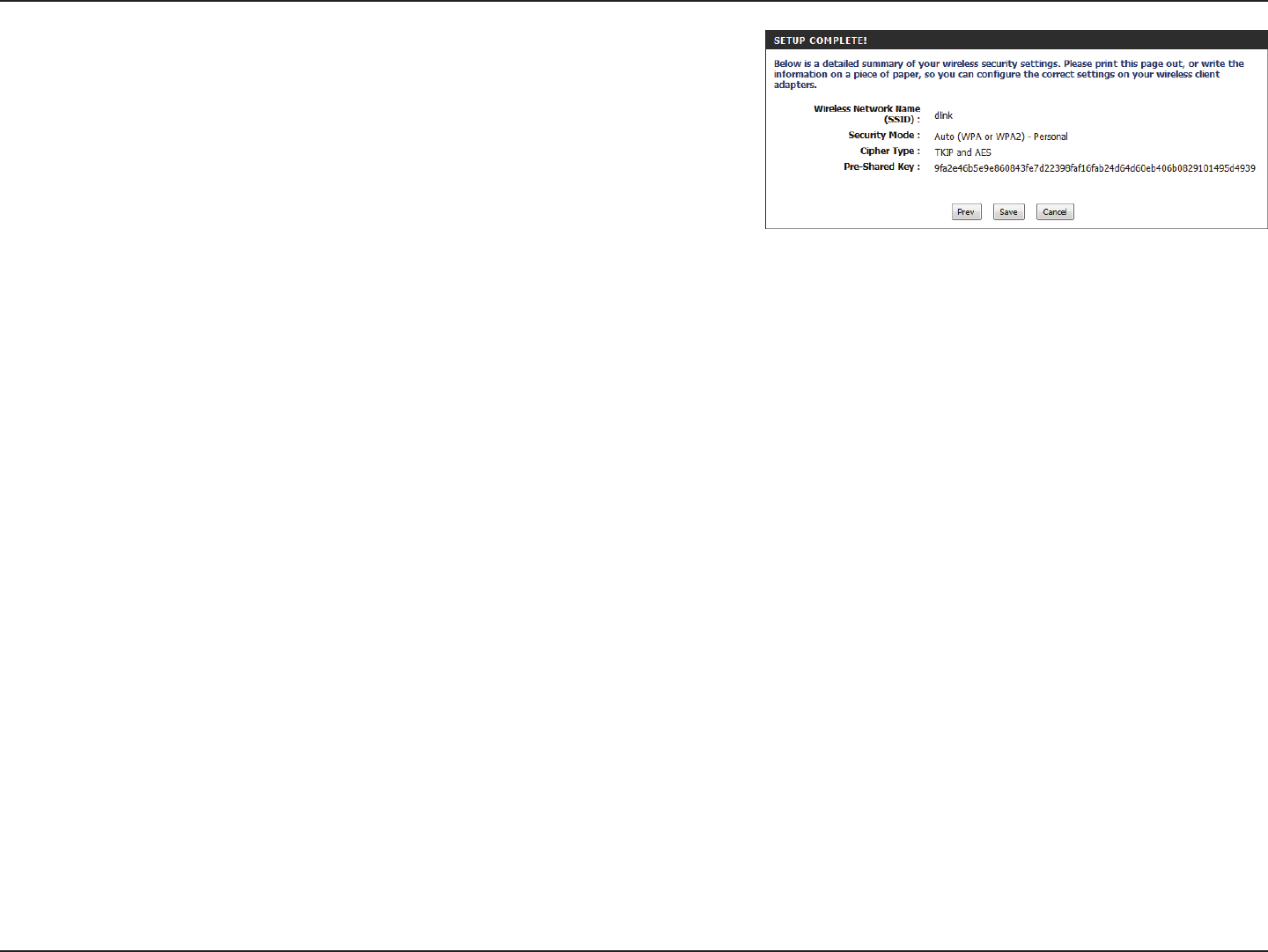
31D-Link DIR-655 User Manual
Section 3 - Conguration
The following screen will show you your pre-shared key to enter on your
wireless clients.
Click Save to nish the security wizard.
If you selected WPA-Enterprise, the RADIUS information will be displayed. Click
Save to nish the security wizard.
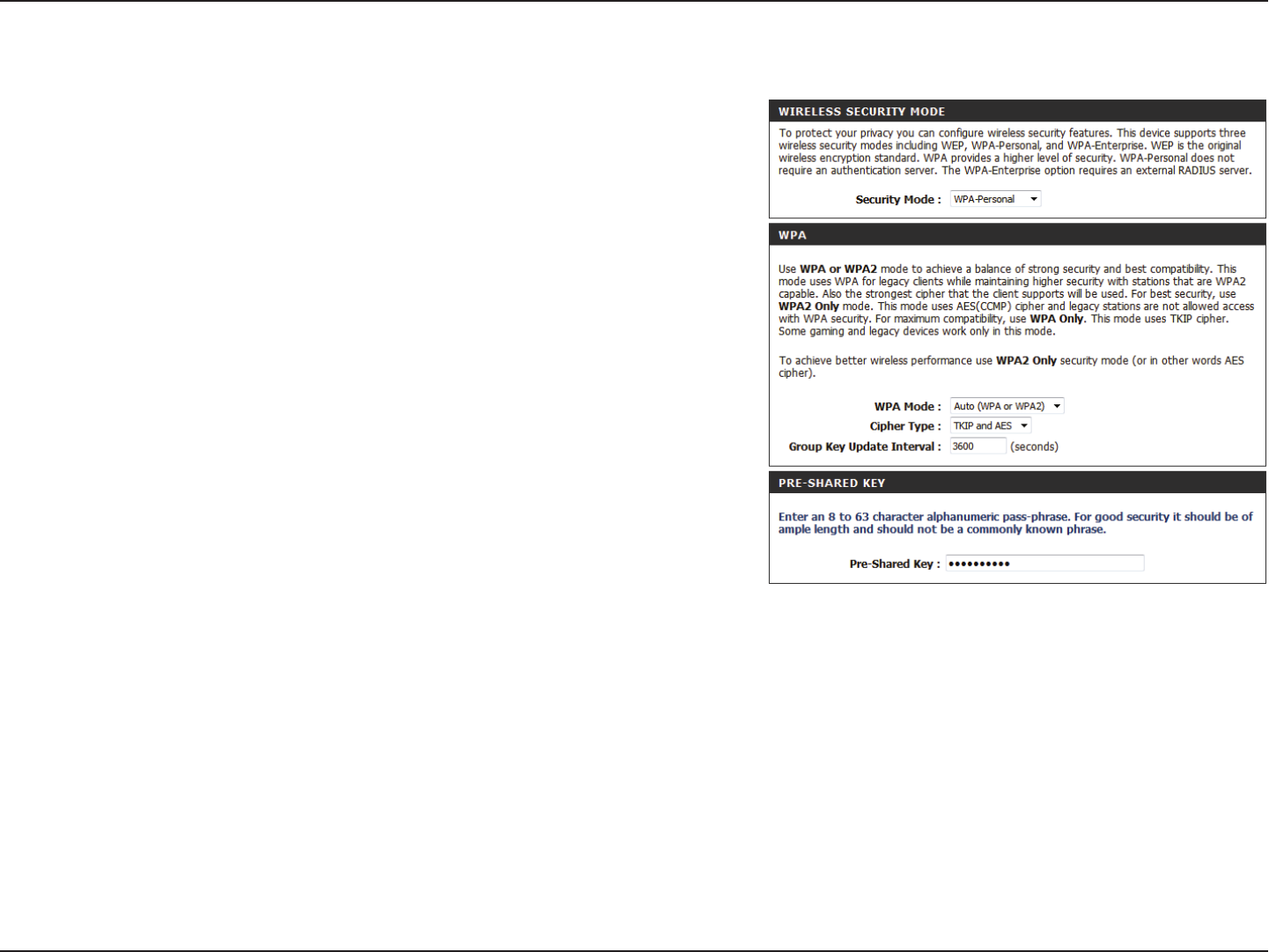
32D-Link DIR-655 User Manual
Section 3 - Conguration
It is recommended to enable encryption on your wireless router before your
wireless network adapters. Please establish wireless connectivity before
enabling encryption. Your wireless signal may degrade when enabling
encryption due to the added overhead.
1. Log into the web-based conguration by opening a web browser and
entering the IP address of the router (192.168.0.1). Click on Setup and
then click Wireless Settings on the left side.
2. Next to Security Mode, select WPA-Personal.
3. Next to WPA Mode, select Auto, WPA2 Only, or WPA Only. Use Auto if
you have wireless clients using both WPA and WPA2.
4. Next to Group Key Update Interval, enter the amount of time before the
group key used for broadcast and multicast data is changed (3600 is
default).
5. Next to Pre-Shared Key, enter a key (passphrase). The key is entered as a
pass-phrase in ASCII format at both ends of the wireless connection. The
pass-phrase must be between 8-63 characters.
6. Click Save Settings to save your settings. If you are conguring the router
with a wireless adapter, you will lose connectivity until you enable WPA-PSK
on your adapter and enter the same passphrase as you did on the router.
WPA-Personal (PSK)
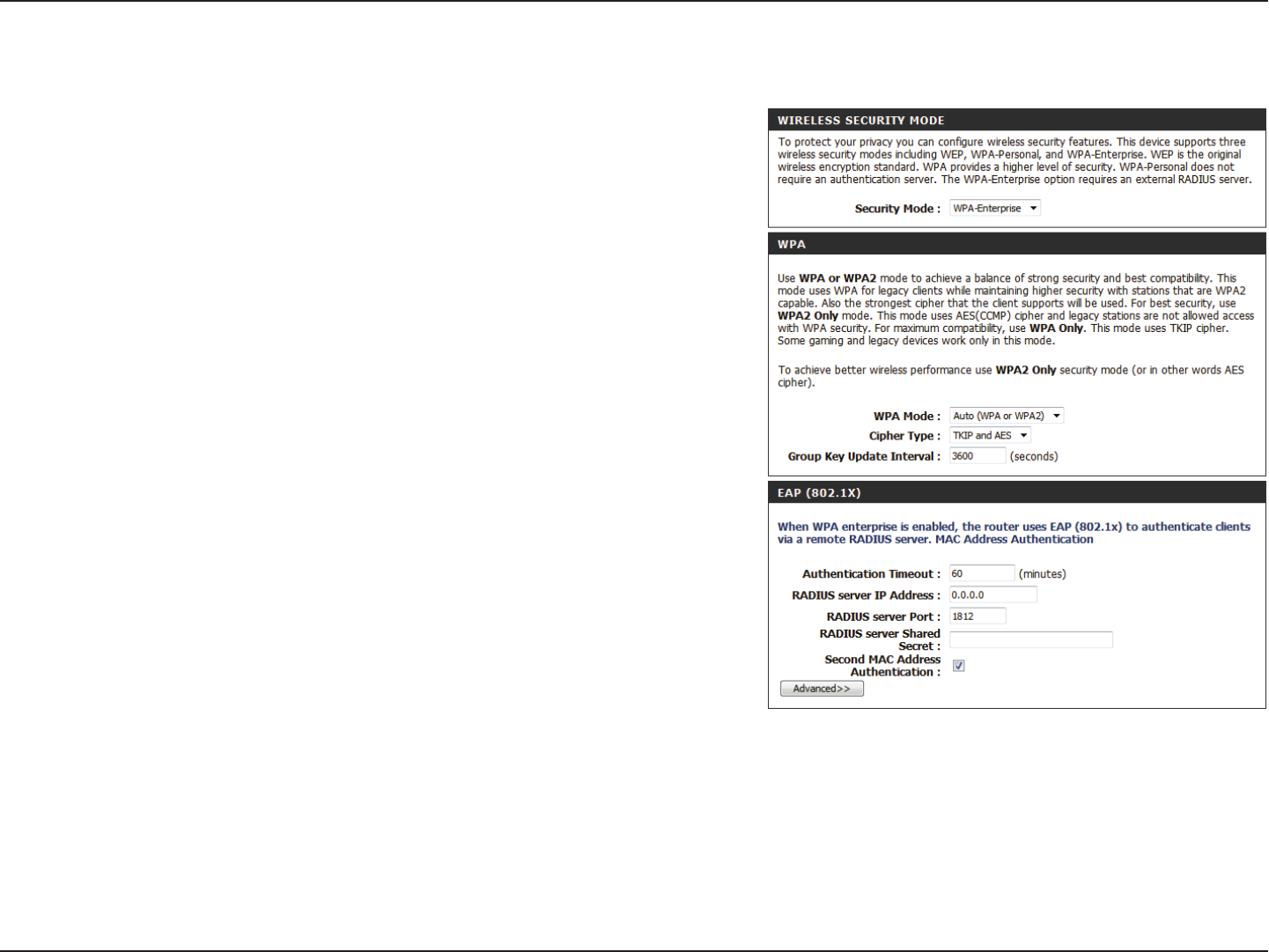
33D-Link DIR-655 User Manual
Section 3 - Conguration
It is recommended to enable encryption on your wireless router before your
wireless network adapters. Please establish wireless connectivity before
enabling encryption. Your wireless signal may degrade when enabling
encryption due to the added overhead.
1. Log into the web-based conguration by opening a web browser and
entering the IP address of the router (192.168.0.1). Click on Setup and
then click Wireless Settings on the left side.
2. Next to Security Mode, select WPA-Enterprise.
3. Next to WPA Mode, select Auto, WPA2 Only, or WPA Only. Use Auto if
you have wireless clients using both WPA and WPA2.
4. Next to Group Key Update Interval, enter the amount of time before the
group key used for broadcast and multicast data is changed (3600 is
default).
5. Next to Authentication Timeout, enter the amount of time before a client
is required to re-authenticate (60 minutes is default).
6. Next to RADIUS Server IP Address enter the IP Address of your RADIUS server.
7. Next to RADIUS Server Port, enter the port you are using with your RADIUS
server. 1812 is the default port.
8. Next to RADIUS Server Shared Secret, enter the security key.
WPA-Enterprise (RADIUS)
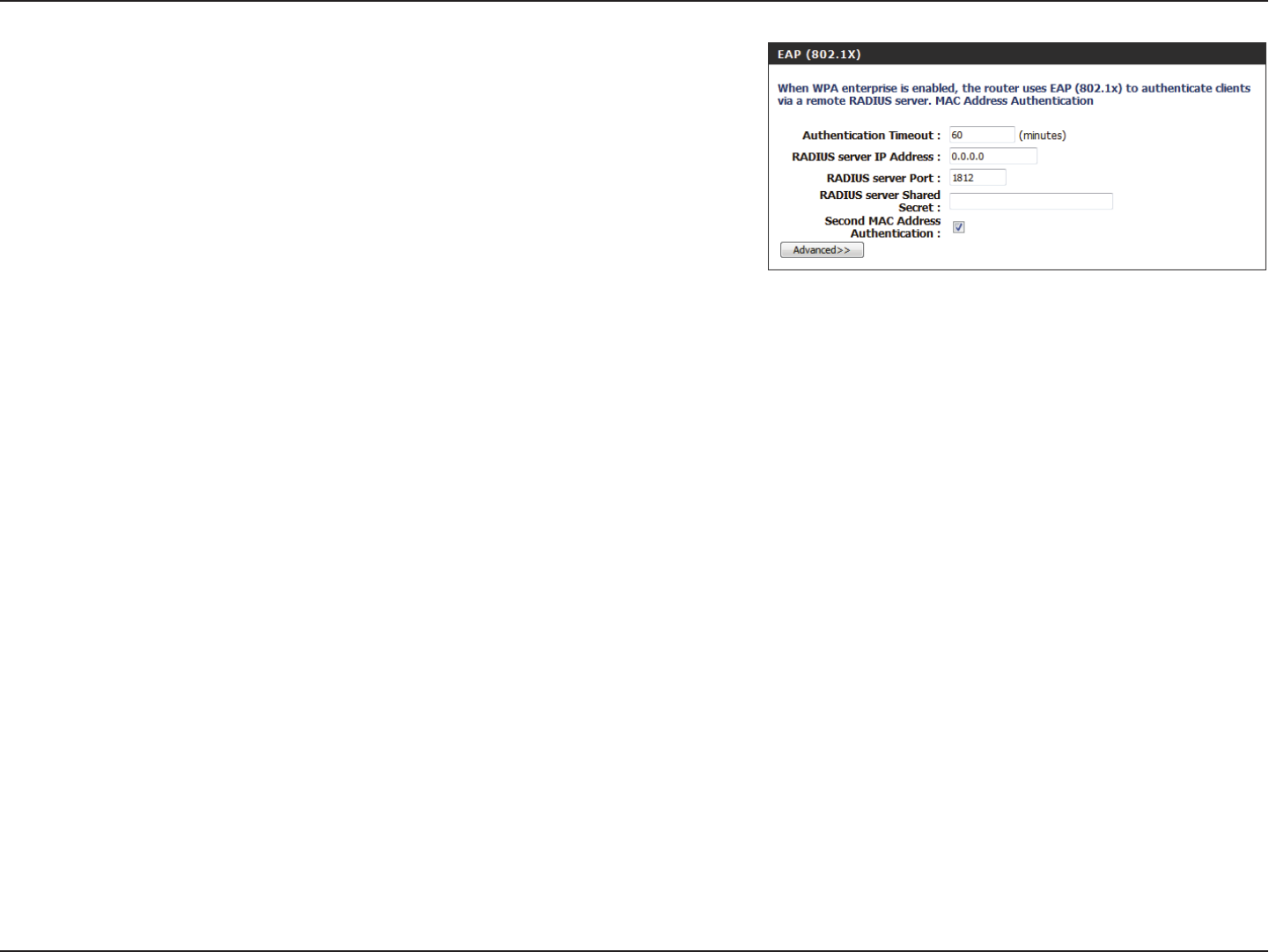
34D-Link DIR-655 User Manual
Section 3 - Conguration
9. If the MAC Address Authentication box is selected then the user will need
to connect from the same computer whenever logging into the wireless
network.
10. Click Advanced to enter settings for a secondary RADIUS server.
11. Click Save Settings to save your settings.
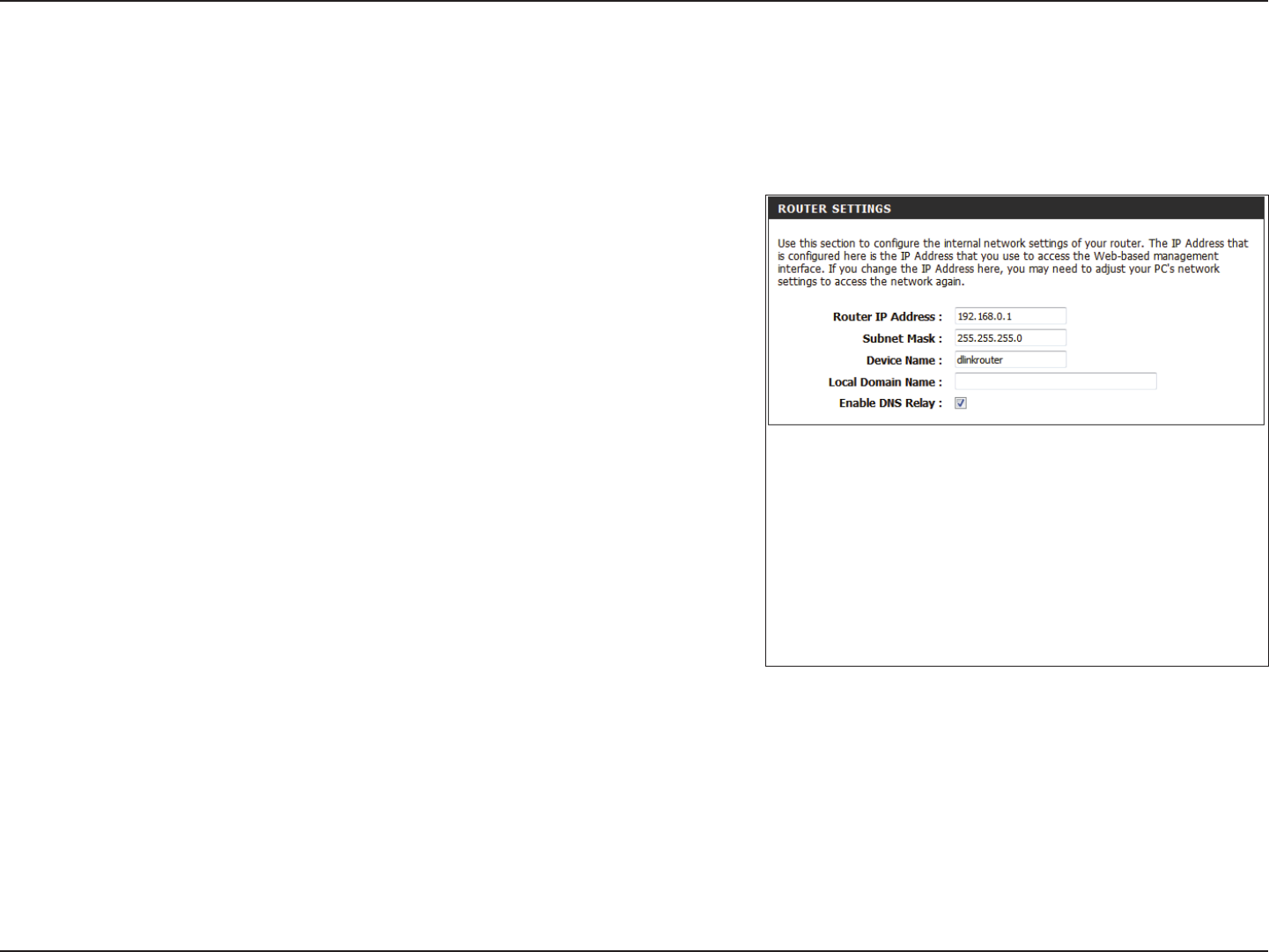
35D-Link DIR-655 User Manual
Section 3 - Conguration
This section will allow you to change the local network settings of the router.
Network Settings
Router Settings
Enter the IP address of the router. The default IP address is 192.168.0.1.
If you change the IP address, once you click Apply, you will need to enter
the new IP address in your browser to get back into the conguration
utility.
Enter the subnet mask. The default subnet mask is 255.255.255.0.
Enter the domain name (optional).
Uncheck the box to transfer the DNS server information from your ISP
to your computers. If checked, your computers will use the router for a
DNS server.
IP Address:
Subnet Mask:
Local Domain:
Enable DNS Relay:
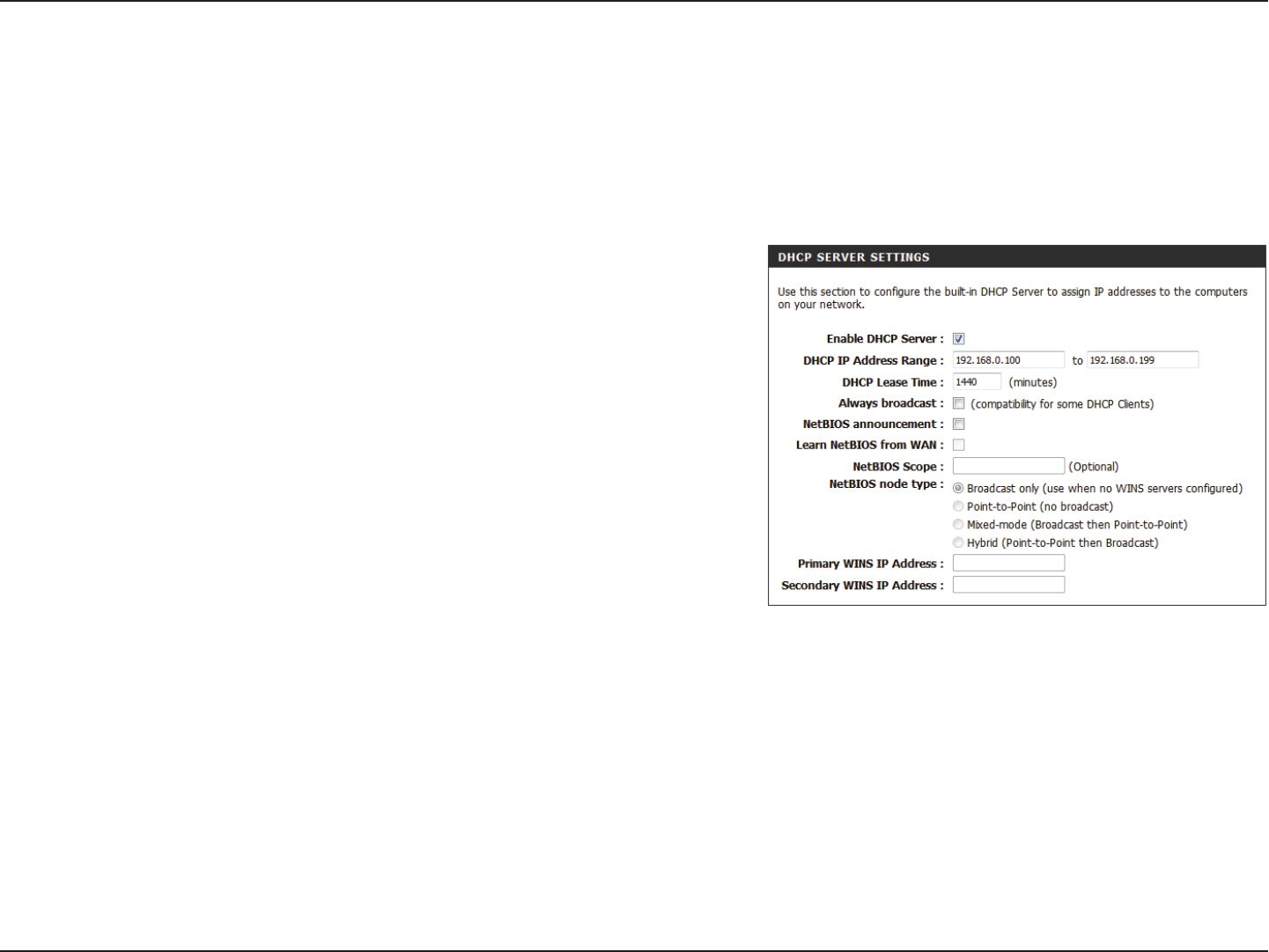
36D-Link DIR-655 User Manual
Section 3 - Conguration
DHCP Server Settings
DHCP stands for Dynamic Host Control Protocol. The DIR-655 has a built-in DHCP server. The DHCP Server will automatically assign an IP address
to the computers on the LAN/private network. Be sure to set your computers to be DHCP clients by setting their TCP/IP settings to “Obtain an IP
Address Automatically.” When you turn your computers on, they will automatically load the proper TCP/IP settings provided by the DIR-655. The
DHCP Server will automatically allocate an unused IP address from the IP address pool to the requesting computer. You must specify the starting
and ending address of the IP address pool.
Check this box to enable the DHCP server on your router. Uncheck to disable
this function.
Enter the starting and ending IP addresses for the DHCP server’s IP assignment.
Note: If you statically (manually) assign IP addresses to your computers or devices,
make sure the IP addresses are outside of this range or you may have an IP conict.
The length of time for the IP address lease. Enter the lease time in minutes.
Enable this feature to broadcast your networks DHCP server to LAN/WLAN
clients.
NetBIOS allows LAN hosts to discover all other computers within the network,
enable this feature to allow the DHCP Server to oer NetBIOS conguration
settings.
Enable this feature to allow WINS information to be learned from the WAN
side, disable to allow manual conguration.
This feature allows the conguration of a NetBIOS domain name under
which network hosts operate. This setting has no eect if the ‘Learn NetBIOS
information from WAN’ is activated.
Select the dierent type of NetBIOS node: Broadcast only, Point-to-Point,
Mixed-mode, and Hybrid.
Enter your primary (and secondary) WINS IP address(es).
Enable DHCP Server:
DHCP IP Address
Range:
DHCP Lease Time:
Always Broadcast:
NetBIOS
Announcement:
Learn NetBIOS from
WAN:
NetBIOS Scope:
NetBIOS Mode Type:
Primary/Secondary
WINS IP Address:
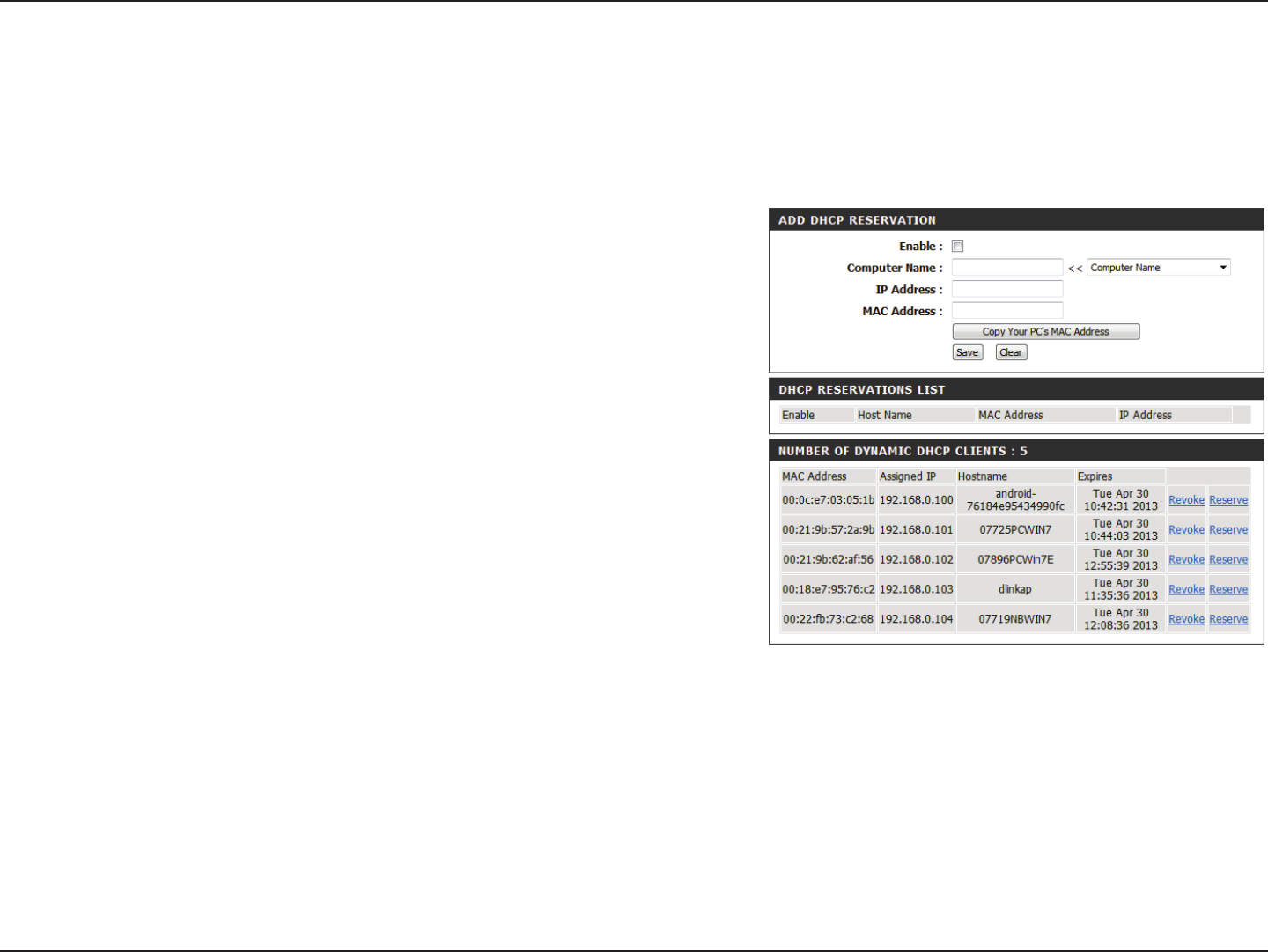
37D-Link DIR-655 User Manual
Section 3 - Conguration
DHCP Reservation
If you want a computer or device to always have the same IP address assigned, you can create a DHCP reservation. The router will assign the IP
address only to that computer or device.
Note: This IP address must be within the DHCP IP Address Range.
Check this box to enable the reservation.
Enter the computer name or select from the drop-down menu and click <<.
Enter the IP address you want to assign to the computer or device. This IP address
must be within the DHCP IP address range.
Enter the MAC address of the computer or device.
If you want to assign an IP address to the computer you are currently on, click this
button to populate the elds.
Click Save to save your entry. You must click Save Settings at the top to activate
your reservations.
In this section you can see what LAN devices are currently leasing IP addresses.
Click Revoke to cancel the lease for a specic LAN device and free an entry in
the lease table. Do this only if the device no longer needs the leased IP address,
because, for example, it has been removed from the network.
Note: The Revoke option will not disconnect a PC with a current network session from
the network; you would need to use MAC Address Filter to do that. Revoke will only free
up a DHCP Address for the very next requester. If the previous owner is still available,
those two devices may both receive an IP Address Conict error, or the second device
may still not receive an IP Address; in that case, you may still need to extend the “DHCP
IP Address Range” to address the issue, it is located in the DHCP Server section.
The Reserve option converts this dynamic IP allocation into a DHCP Reservation
and adds the corresponding entry to the DHCP Reservations List.
Enable:
Computer Name:
IP Address:
MAC Address:
Copy Your PC’s
MAC Address:
Save:
Number of
Dynamic DHCP
Clients:
Revoke:
Reserve:

38D-Link DIR-655 User Manual
Section 3 - Conguration
Media Server
This feature allows you to share music, pictures and videos from a USB external drive/thumb drive and/or SD card with any device connected to
your network.
Enable Media
Server:
Media Server
Name:
Check this box to enable the media server feature.
Enter the media server’s name.
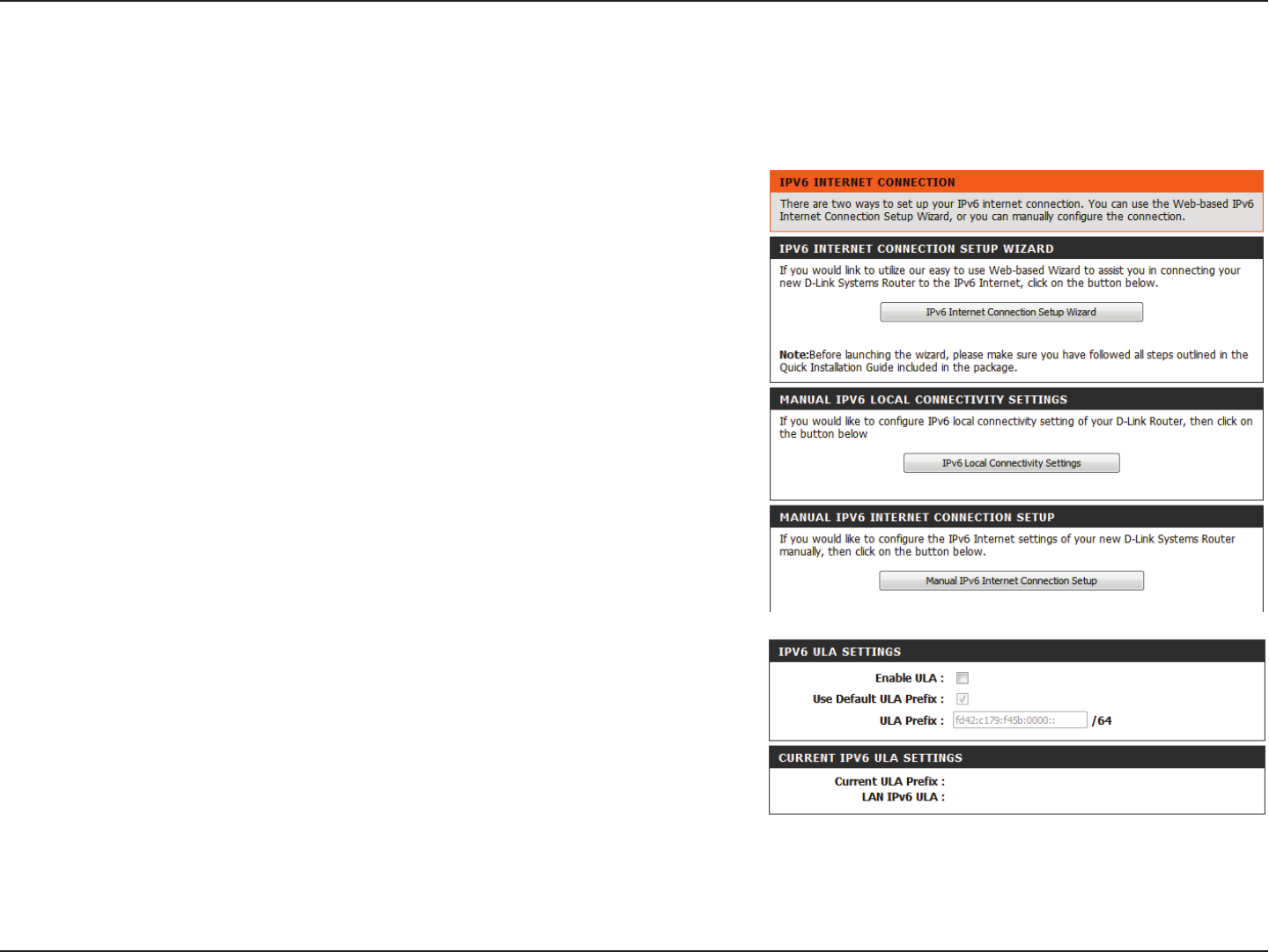
39D-Link DIR-655 User Manual
Section 3 - Conguration
IPv6
On this page, the user can congure the IPv6 connection type. There are two ways to set up the IPv6 Internet connection. You can use the web-
based IPv6 Internet Connection Setup Wizard or you can manually congure the connection.
For the beginner user that has not congured a router before, click on the
IPv6 Internet Connection Setup Wizard button and the router will guide
you through a few simple steps to get your network up and running. Skip to
the next page for details.
For the advanced user that has congured a router before, click on the Manual
IPv6 Internet Connection Setup button to input all the settings manually.
Refer to page 45 for details.
To congure the IPv6 local settings, click on the IPv6 Local Connectivity
Setup button.
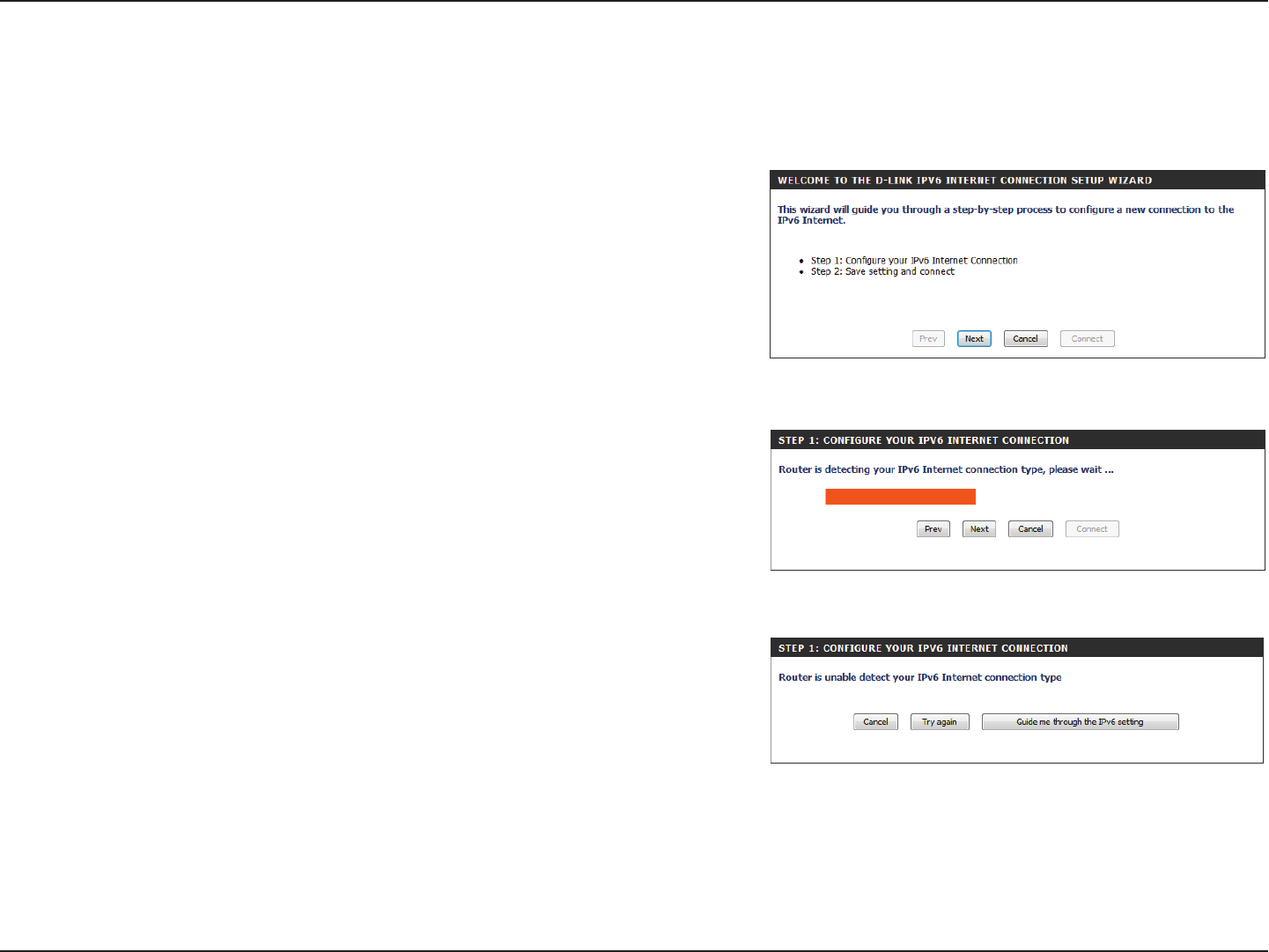
40D-Link DIR-655 User Manual
Section 3 - Conguration
IPv6 Internet Connection Setup Wizard
On this page, the user can congure the IPv6 connection type using the IPv6 Internet Connection Setup Wizard.
Click the IPv6 Internet Connection Setup Wizard button and the router will
guide you through a few simple steps to get your network up and running.
Click Next to continue to the next page. Click Cancel to discard the changes
made and return to the main page.
The router will try to detect whether its possible to obtain the IPv6 Internet
connection type automatically. If this succeeds then the user will be guided
through the input of the appropriate parameters for the connection type
found.
However, if the automatic detection fails, the user will be prompted to either
Try again or to click on the Guide me through the IPv6 settings button to
set up IPv6 manually, with the wizard’s guidance.
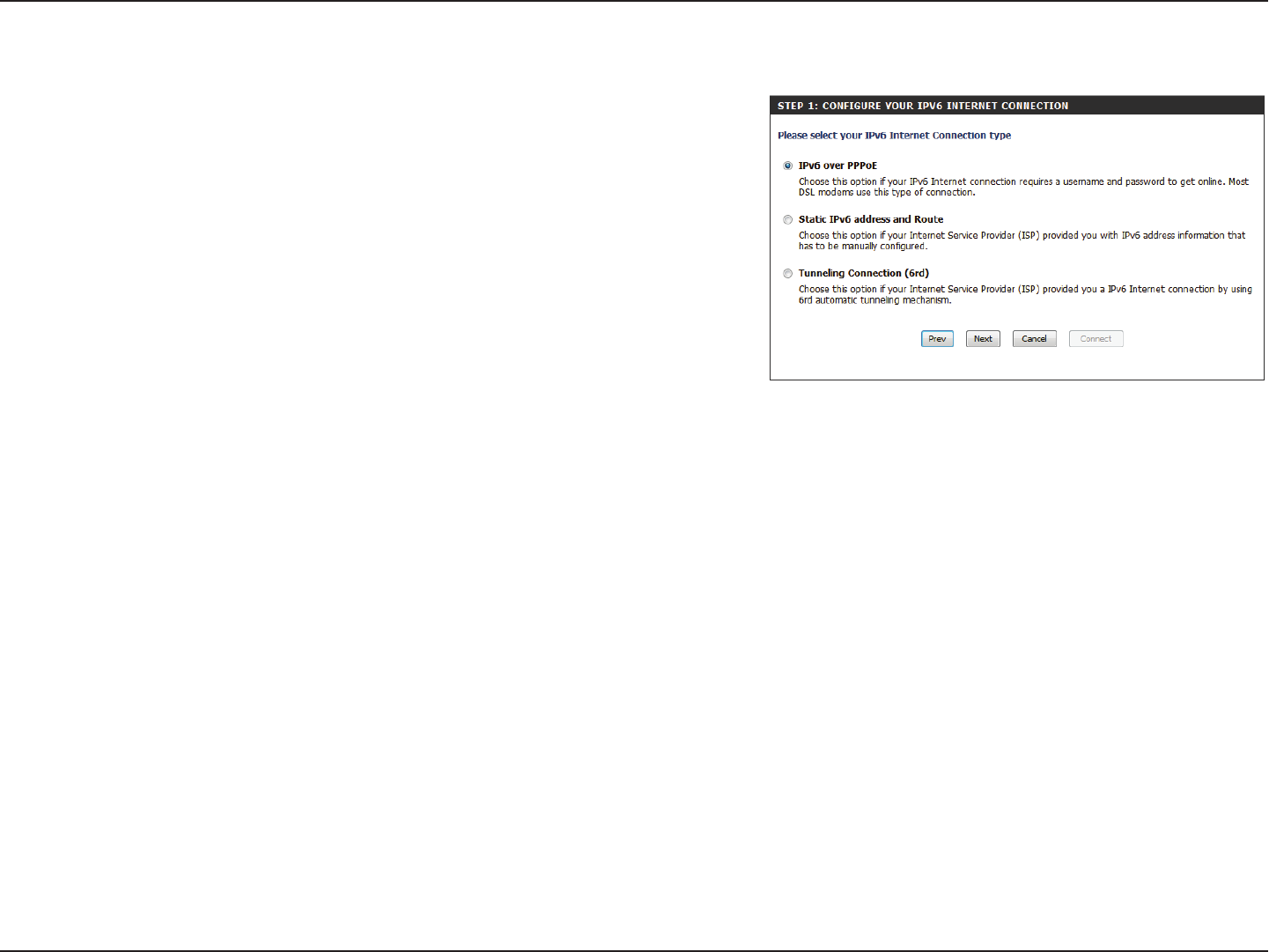
41D-Link DIR-655 User Manual
Section 3 - Conguration
There are several connection types to choose from. If you are unsure of your
connection method, please contact your IPv6 Internet service provider.
Note: If using the PPPoE option, you will need to ensure that any PPPoE client
software on your computers has been removed or disabled. The three options
available on this page are IPv6 over PPPoE, Static IPv6 address and Route and
Tunneling Connection.
Choose the required IPv6 Internet Connection type and click on the Next
button to continue.
Click on the Prev button to return to the previous page.
Click on the Cancel button to discard all the changes made and return to the
main page.
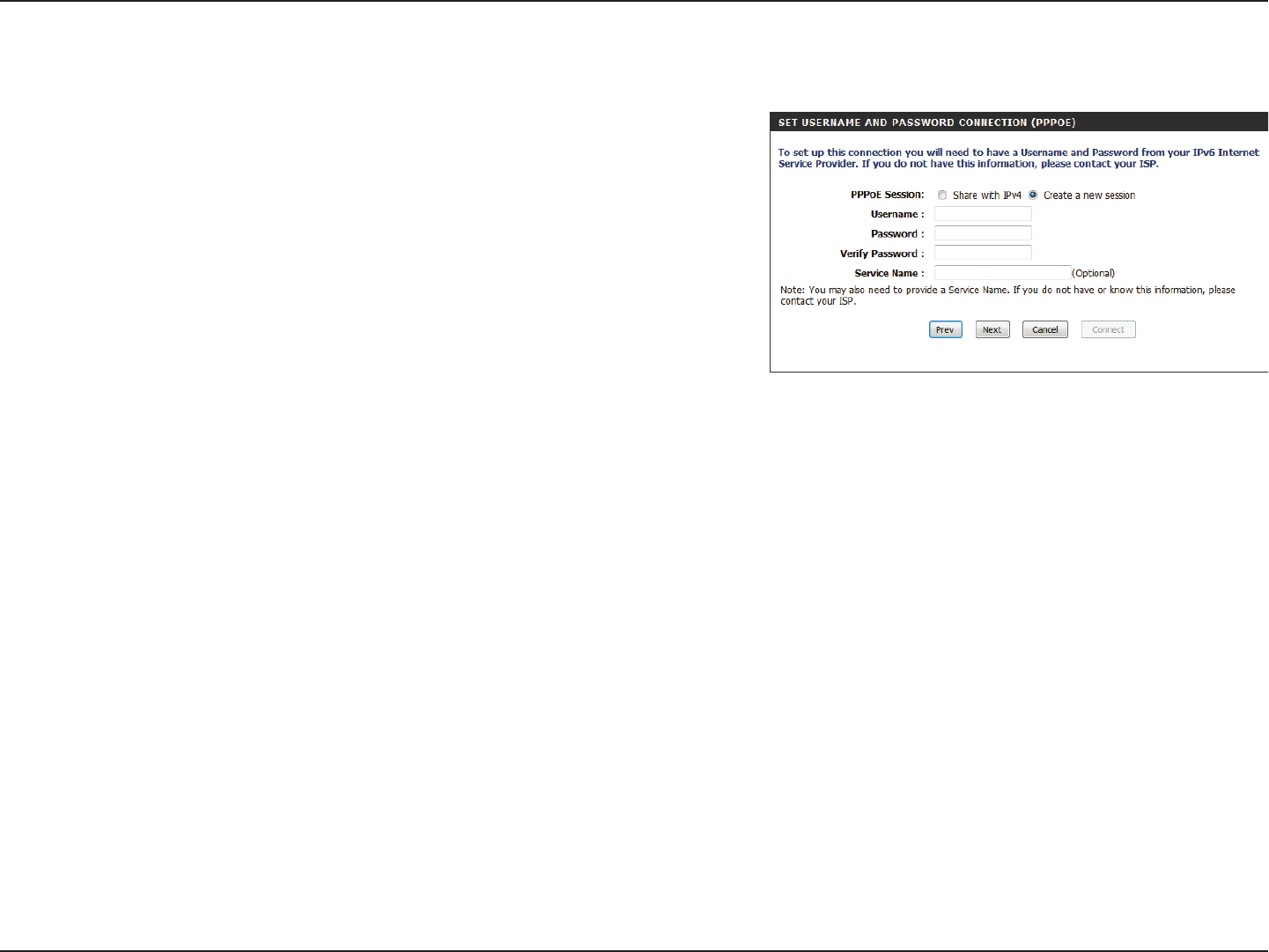
42D-Link DIR-655 User Manual
Section 3 - Conguration
After selecting the IPv6 over PPPoE option, the user will be able to congure
the IPv6 Internet connection, which requires a username and password to get
online. Most DSL modems use this type of connection.
The following parameters will be available for conguration:
PPPoE Session: Select the PPPoE Session type. This option will state
that this connection shares its information with
the already congured IPv6 PPPoE connection, or
the user can create a new PPPoE connection here.
Username: Enter the PPPoE username. If you do not know
your username, please contact your ISP.
Password: Enter the PPPoE password. If you do not know your
password, please contact your ISP.
Verify Password: Re-enter the PPPoE password.
Service Name: Enter the service name for this connection. (This is
optional.)
IPv6 over PPPoE
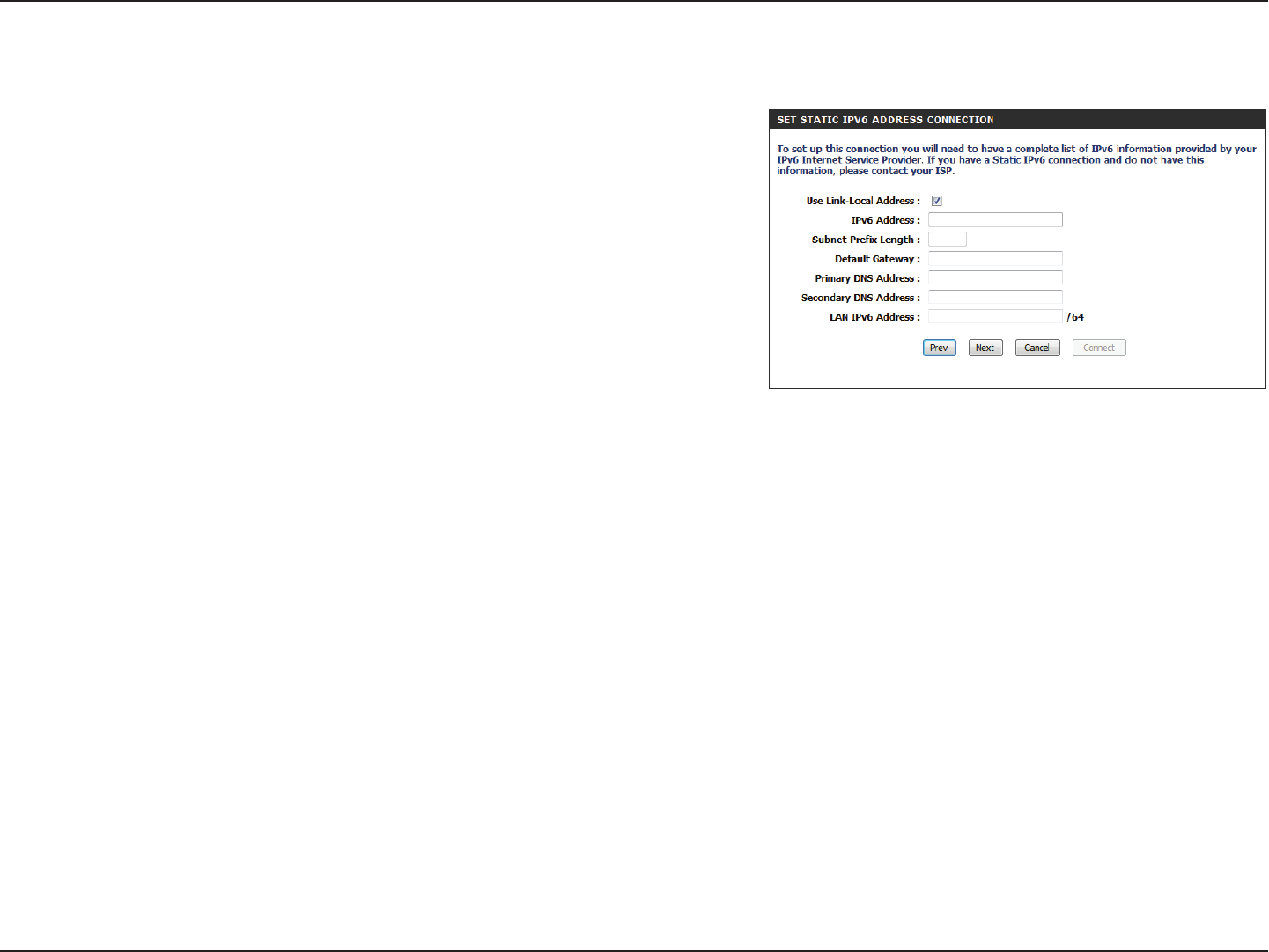
43D-Link DIR-655 User Manual
Section 3 - Conguration
Choose Static IPv6 Address Connection when your ISP provides you with
a set IPv6 addresses that does not change. The IPv6 information is manually
entered in your IPv6 conguration settings. You must enter the IPv6 address,
Subnet Prex Length, Default Gateway, Primary DNS Server and Secondary
DNS Server. Your ISP provides you with all of this information.
Use Link-Local
Address:
IPv6 Address:
Subnet Prex Length:
Default Gateway:
Primary DNS Address:
Secondary DNS
Address:
LAN IPv6 Address:
The Link-local address is used by nodes and routers
when communicating with neighboring nodes on the
same link. This mode enables IPv6-capable devices to
communicate with each other on the LAN side.
Enter the WAN IPv6 address for the router here.
Enter the WAN subnet prex length value used here.
Enter the WAN default gateway IPv6 address used here.
Enter the WAN primary DNS Server address used here.
Enter the WAN secondary DNS Server address used
here.
These are the settings of the LAN (Local Area Network)
IPv6 interface for the router. The router’s LAN IPv6
Address conguration is based on the IPv6 address and
subnet assigned by your ISP. (A subnet with prex /64 is
supported in LAN.)
Static IPv6 Address Connection
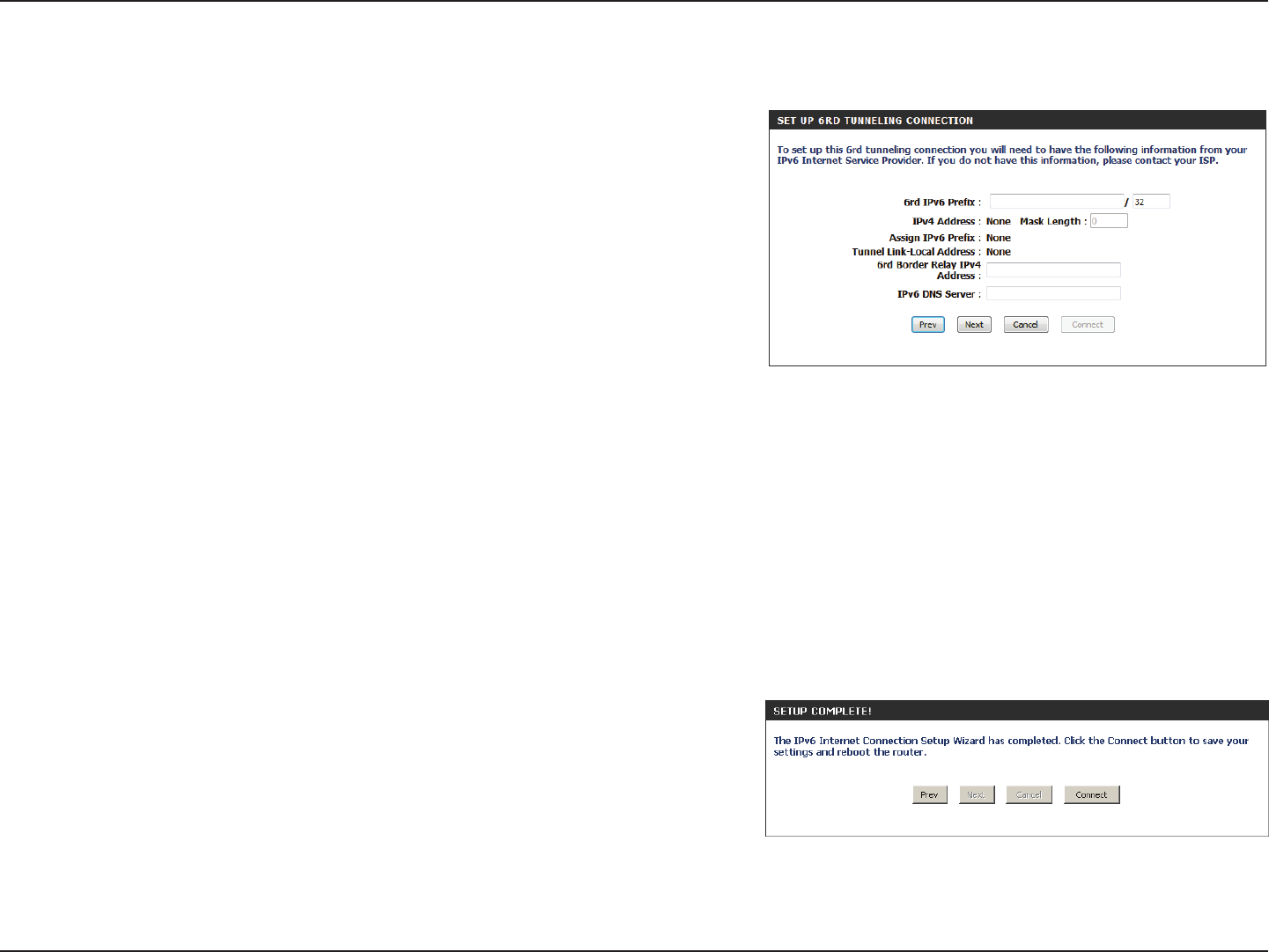
44D-Link DIR-655 User Manual
Section 3 - Conguration
The following parameters will be available for conguration:
6rd IPv6 Prex: Enter the 6rd IPv6 address and prex value used here.
IPv4 Address: Enter the IPv4 address used here.
Mask Length: Enter the IPv4 mask length used here.
Assigned IPv6 Prex: Displays the IPv6 assigned prex value here.
6rd Border Relay IPv4
Address:
Enter the 6rd border relay IPv4 address used here.
IPv6 DNS Server: Enter the primary DNS Server address used here.
When the setup wizard is complete, click on the Connect button to continue.
Click on the Prev button to return to the previous page. Click on the Cancel
button to discard all the changes made and return to the main page.
After selecting the Tunneling Connection (6rd) option, the user can
congure the IPv6 6rd connection settings.
Tunneling Connection (6rd)
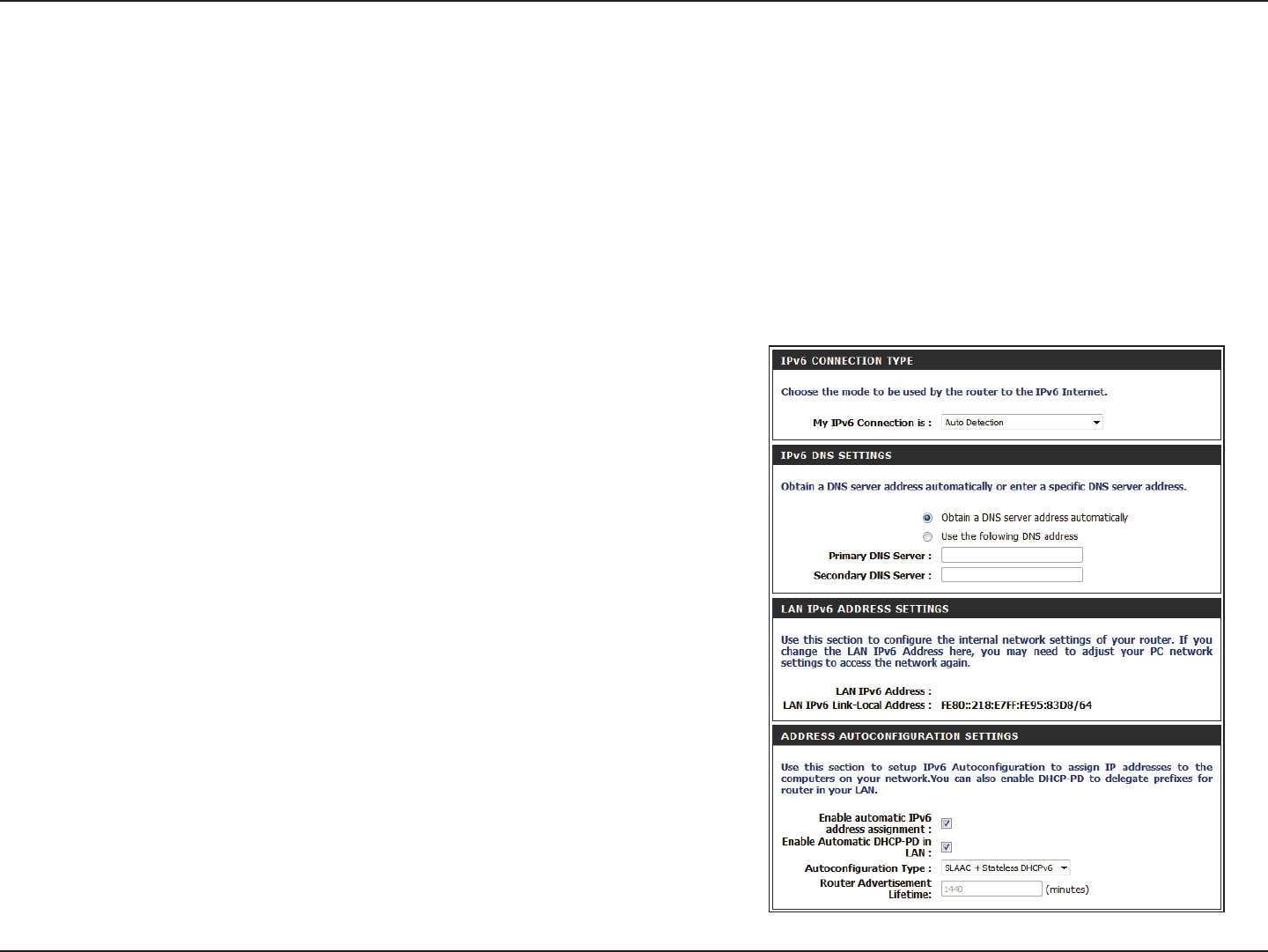
45D-Link DIR-655 User Manual
Section 3 - Conguration
IPv6 Manual Setup
There are several connection types to choose from: Auto Detection, Static IPv6, Autoconguration (SLAAC/DHCPv6), PPPoE, IPv6 in IPv4 Tunnel,
6to4, 6rd and Link-local. If you are unsure of your connection method, please contact your IPv6 Internet service provider.
If using the PPPoE option, you will need to ensure that any PPPoE client software on your computers has been removed or disabled.
Auto Detection
Select Auto Detection to have the router detect and automatically congure
your IPv6 setting from your ISP.
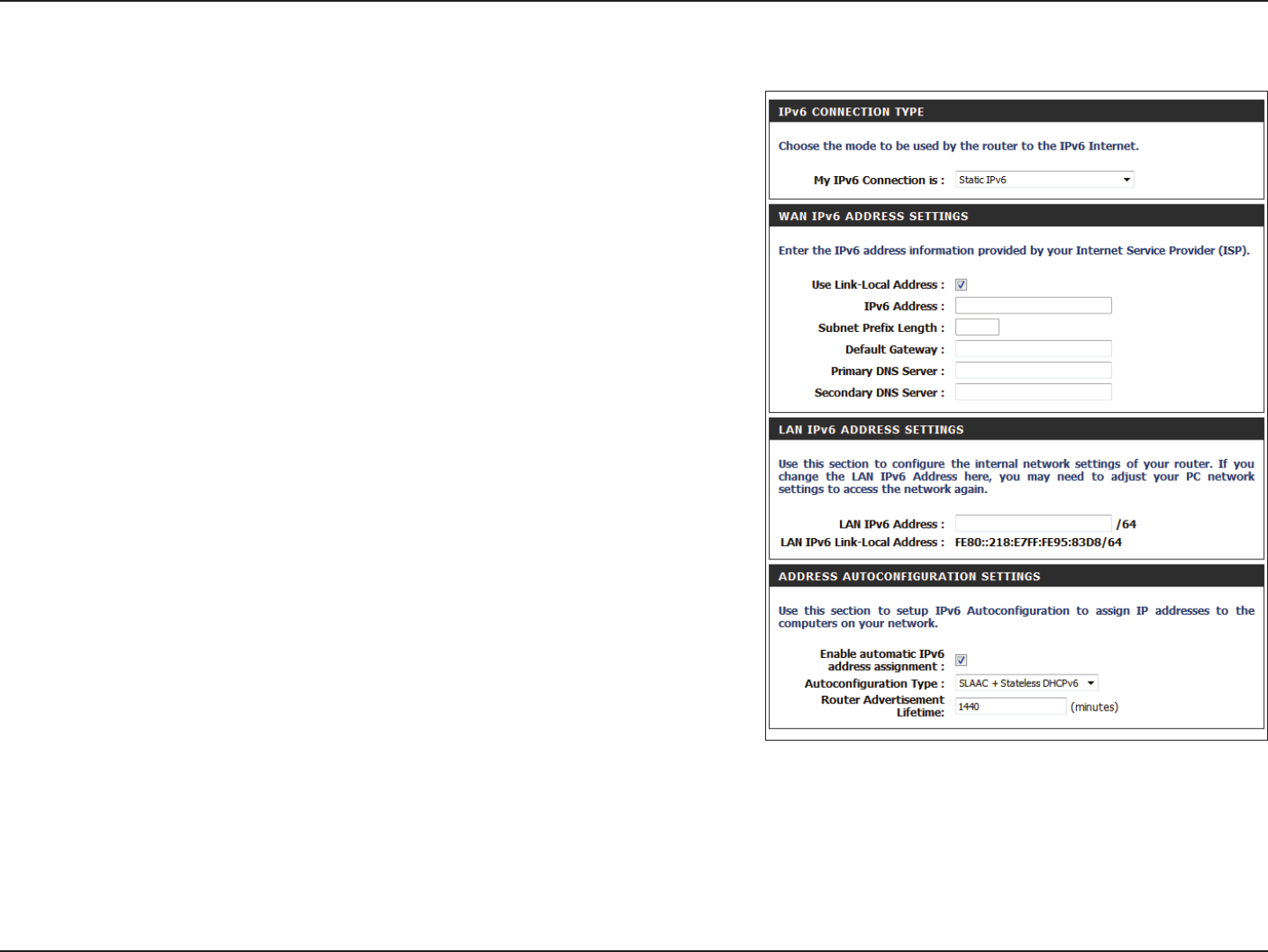
46D-Link DIR-655 User Manual
Section 3 - Conguration
Static IPv6
Select Static IPv6 from the drop-down menu.
Enter the address settings supplied by your Internet provider (ISP).
Enter the LAN (local) IPv6 address for the router.
Displays the router’s LAN link-local address.
Check to enable the autoconguration feature.
Select Stateful (DHCPv6), SLAAC + RDNSS, or SLAAC + Stateless
DHCPv6.
Enter the start IPv6 address for the DHCPv6 range for your local
computers.
Enter the end IPv6 address for the DHCPv6 range for your local
computers.
Enter the IPv6 address lifetime (in minutes).
My IPv6 Connection:
WAN IPv6 Address Settings:
LAN IPv6 Address:
LAN Link-Local Address:
Enable Automatic IPv6
Address Assignment:
Autoconguration Type:
IPv6 Address Range Start:
IPv6 Address Range End:
IPv6 Address Lifetime:
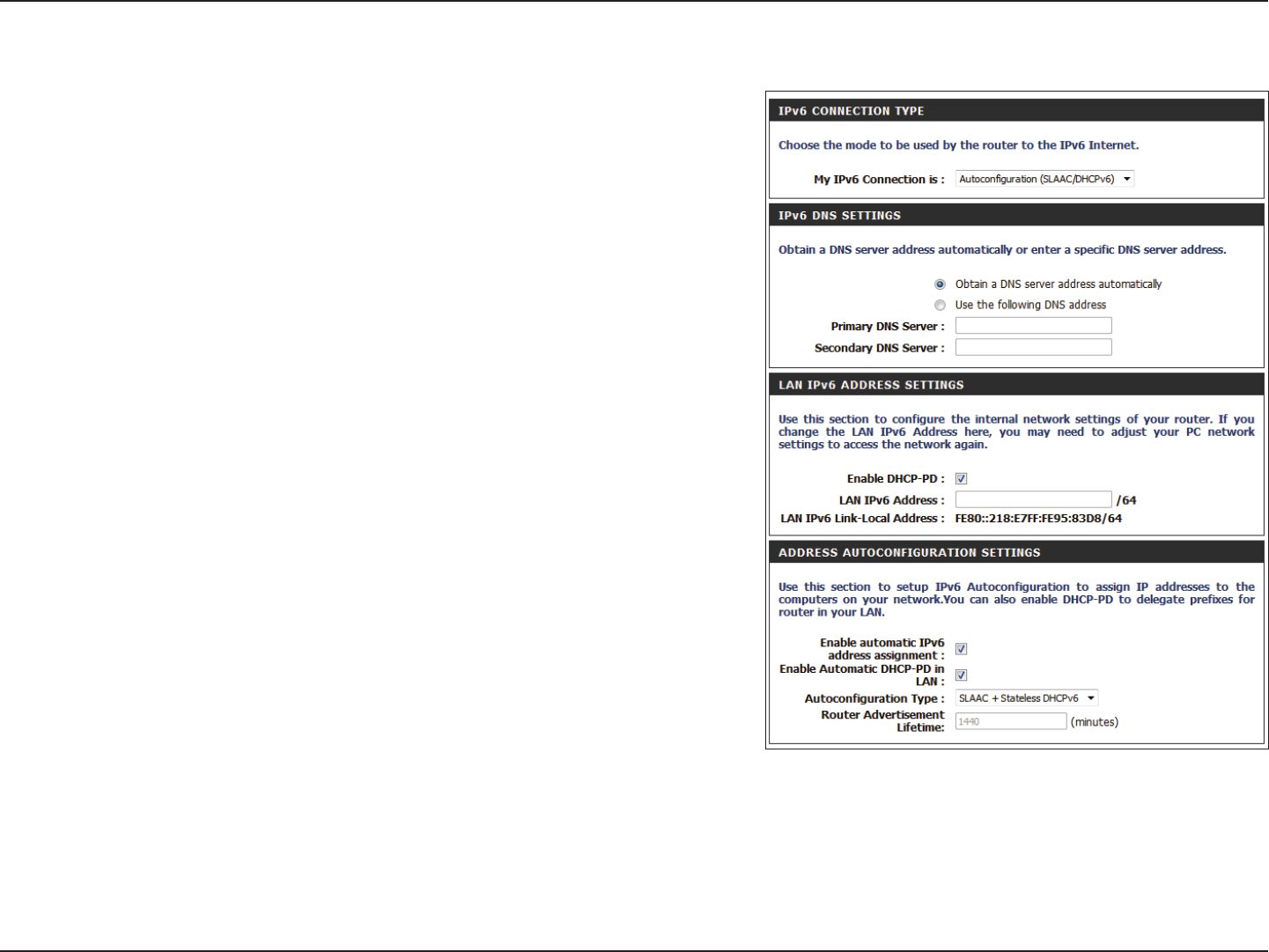
47D-Link DIR-655 User Manual
Section 3 - Conguration
Autoconguration
Select Autoconguration (Stateless/DHCPv6) from the drop-
down menu.
Select either Obtain DNS server address automatically or Use
the following DNS Address.
Enter the primary and secondary DNS server addresses.
Check to enable the DHCP-PD feature.
Enter the LAN (local) IPv6 address for the router.
Displays the router’s LAN link-local address.
Check to enable the autoconguration feature.
Check to enable automatic DHCP-PD in LAN.
Select Stateful (DHCPv6), SLAAC + RDNSS, or SLAAC + Stateless
DHCPv6.
Enter the start IPv6 address for the DHCPv6 range for your local
computers.
Enter the end IPv6 address for the DHCPv6 range for your local
computers.
Enter the IPv6 address lifetime (in minutes).
My IPv6 Connection:
IPv6 DNS Settings:
Primary/Secondary DNS
Address:
Enable DHCP-PD:
LAN IPv6 Address:
LAN Link-Local Address:
Enable Automatic IPv6
Address Assignment:
Enable Automatic
DHCP-PD in LAN:
Autoconguration Type:
IPv6 Address Range Start:
IPv6 Address Range End:
IPv6 Address Lifetime:
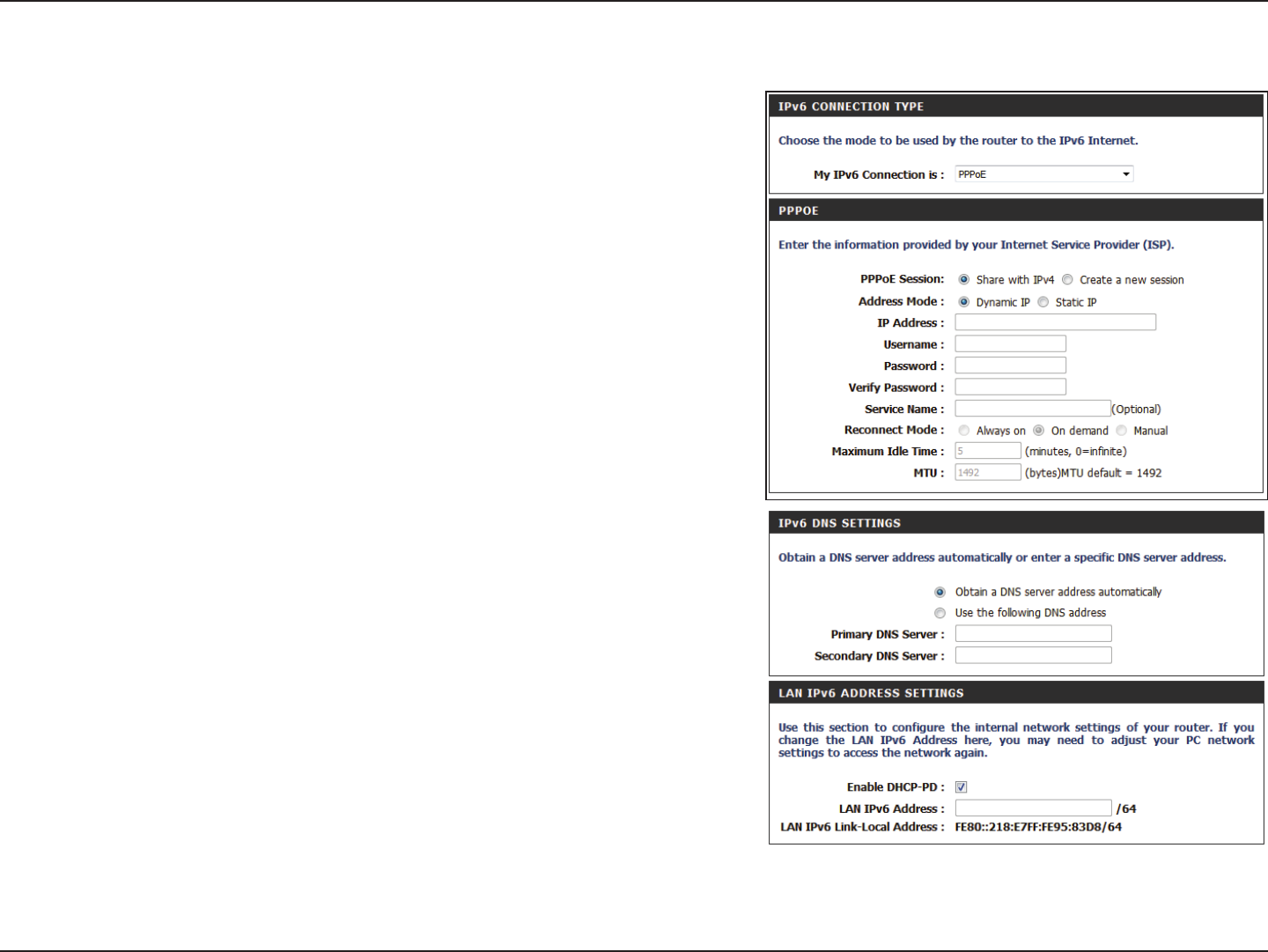
48D-Link DIR-655 User Manual
Section 3 - Conguration
PPPoE
Select PPPoE from the drop-down menu.
Enter the PPPoE account settings supplied by your Internet
provider (ISP).
Select Static if your ISP assigned you the IP address, subnet
mask, gateway, and DNS server addresses. In most cases, select
Dynamic.
Enter the IP address (Static PPPoE only).
Enter your PPPoE user name.
Enter your PPPoE password and then retype the password in
the next box.
Enter the ISP Service Name (optional).
Select either Always-on, On-Demand, or Manual.
Enter a maximum idle time during which the Internet connection
is maintained during inactivity. To disable this feature, enable
Auto-reconnect.
Maximum Transmission Unit - you may need to change the
MTU for optimal performance with your specic ISP. 1492 is the
default MTU.
Select either Obtain DNS server address automatically or Use
the following DNS Address.
Enter the primary and secondary DNS server addresses.
Check to enable the DHCP-PD feature.
Enter the LAN (local) IPv6 address for the router.
Displays the router’s LAN Link-Local Address.
My IPv6 Connection:
PPPoE:
Address Mode:
IP Address:
User Name:
Password:
Service Name:
Reconnection Mode:
Maximum Idle Time:
MTU:
IPv6 DNS Settings:
Primary/Secondary DNS
Address:
Enable DHCP-PD:
LAN IPv6 Address:
LAN Link-Local Address:
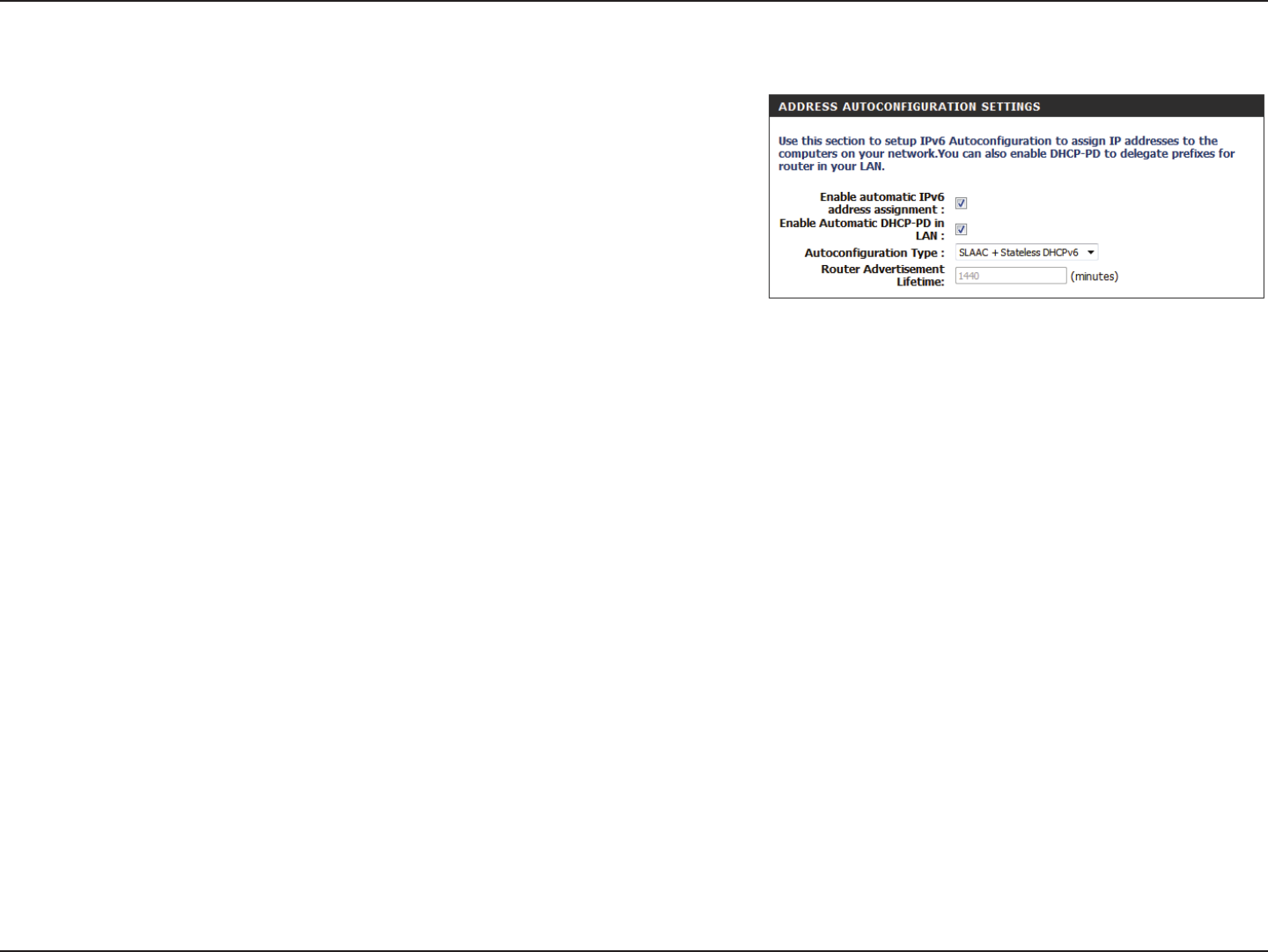
49D-Link DIR-655 User Manual
Section 3 - Conguration
Enable Automatic IPv6
Address Assignment:
Enable Automatic
DHCP-PD in LAN:
Autoconguration Type:
IPv6 Address Range Start:
IPv6 Address Range End:
IPv6 Address Lifetime:
Check to enable the autoconguration feature.
Check to enable automatic DHCP-PD in LAN.
Select Stateful (DHCPv6), SLAAC + RDNSS or SLAAC +
Stateless DHCPv6.
Enter the start IPv6 address for the DHCPv6 range for your
local computers.
Enter the end IPv6 address for the DHCPv6 range for your
local computers.
Enter the IPv6 address lifetime (in minutes).
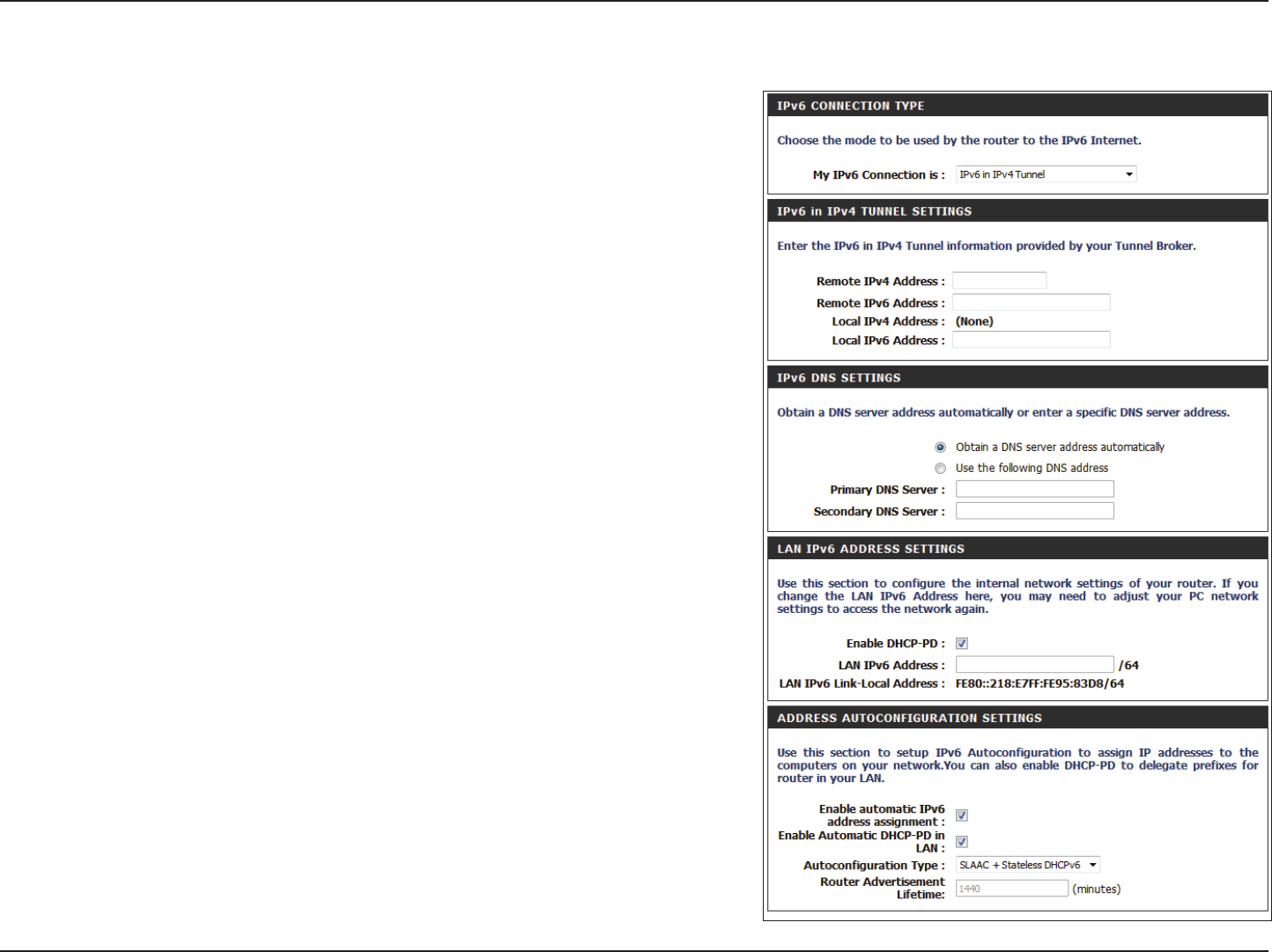
50D-Link DIR-655 User Manual
Section 3 - Conguration
IPv6 in IPv4 Tunneling
Select IPv6 in IPv4 Tunnel from the drop-down menu.
Enter the settings supplied by your Internet provider (ISP).
Automatically obtain a DNS server address or enter a specic DNS
address.
Check to enable the DHCP-PD feature.
Enter the LAN (local) IPv6 address for the router.
Displays the router’s LAN link-local address.
Check to enable automatic IPv6 address assignment.
Check to enable automatic DHCP-PD in LAN.
Select Stateful (DHCPv6), SLAAC + RDNSS, or SLAAC + Stateless
DHCPv6.
Enter the start IPv6 address for the DHCPv6 range for your local
computers.
Enter the end IPv6 address for the DHCPv6 range for your local
computers.
Enter the router advertisement lifetime (in minutes).
My IPv6 Connection:
IPv6 in IPv4 Tunnel
Settings:
IPv6 DNS Settings:
Enable DHCP-PD:
LAN IPv6 Address:
LAN IPv6 Link-Local
Address:
Enable Automatic IPv6
Address Assignment:
Enable Automatic
DHCP-PD in LAN:
Autoconguration
Type:
IPv6 Address Range
Start:
IPv6 Address Range
End:
Router Advertisement
Lifetime:
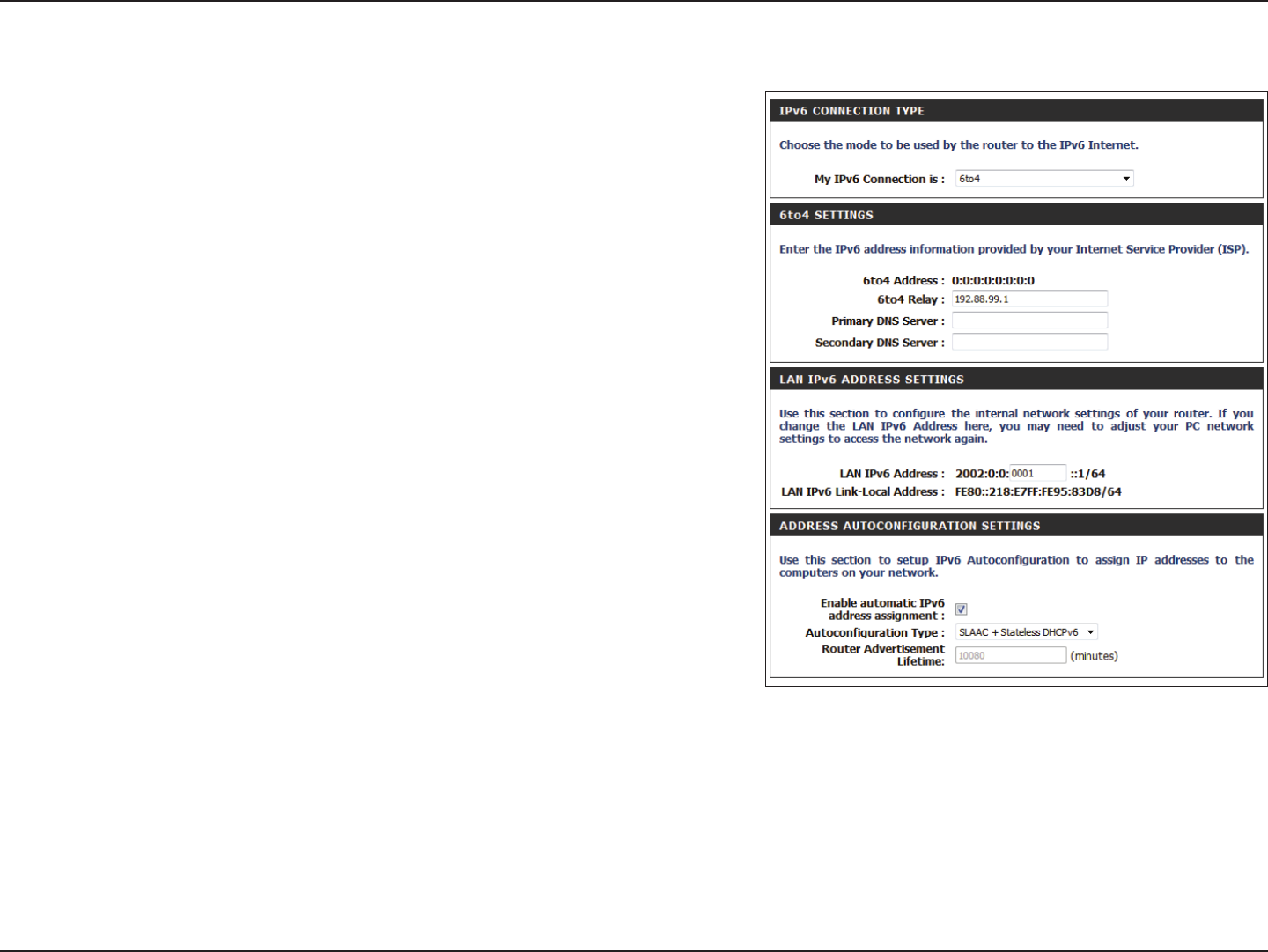
51D-Link DIR-655 User Manual
Section 3 - Conguration
6to4 Tunneling
Select 6to4 from the drop-down menu.
Enter the IPv6 settings supplied by your Internet provider (ISP).
Enter the primary and secondary DNS server addresses.
Enter the LAN (local) IPv6 address for the router.
Displays the router’s LAN link-local address.
Check to enable the autoconguration feature.
Select Stateful (DHCPv6), SLAAC + RDNSS, or SLAAC + Stateless
DHCPv6.
Enter the start IPv6 address for the DHCPv6 range for your local
computers.
Enter the end IPv6 address for the DHCPv6 range for your local
computers.
Enter the IPv6 address lifetime (in minutes).
My IPv6 Connection:
6to4 Settings:
Primary/Secondary
DNS Address:
LAN IPv6 Address:
LAN Link-Local
Address:
Enable Automatic
DHCP-PD in LAN:
Autoconguration
Type:
IPv6 Address Range
Start:
IPv6 Address Range
End:
IPv6 Address
Lifetime:
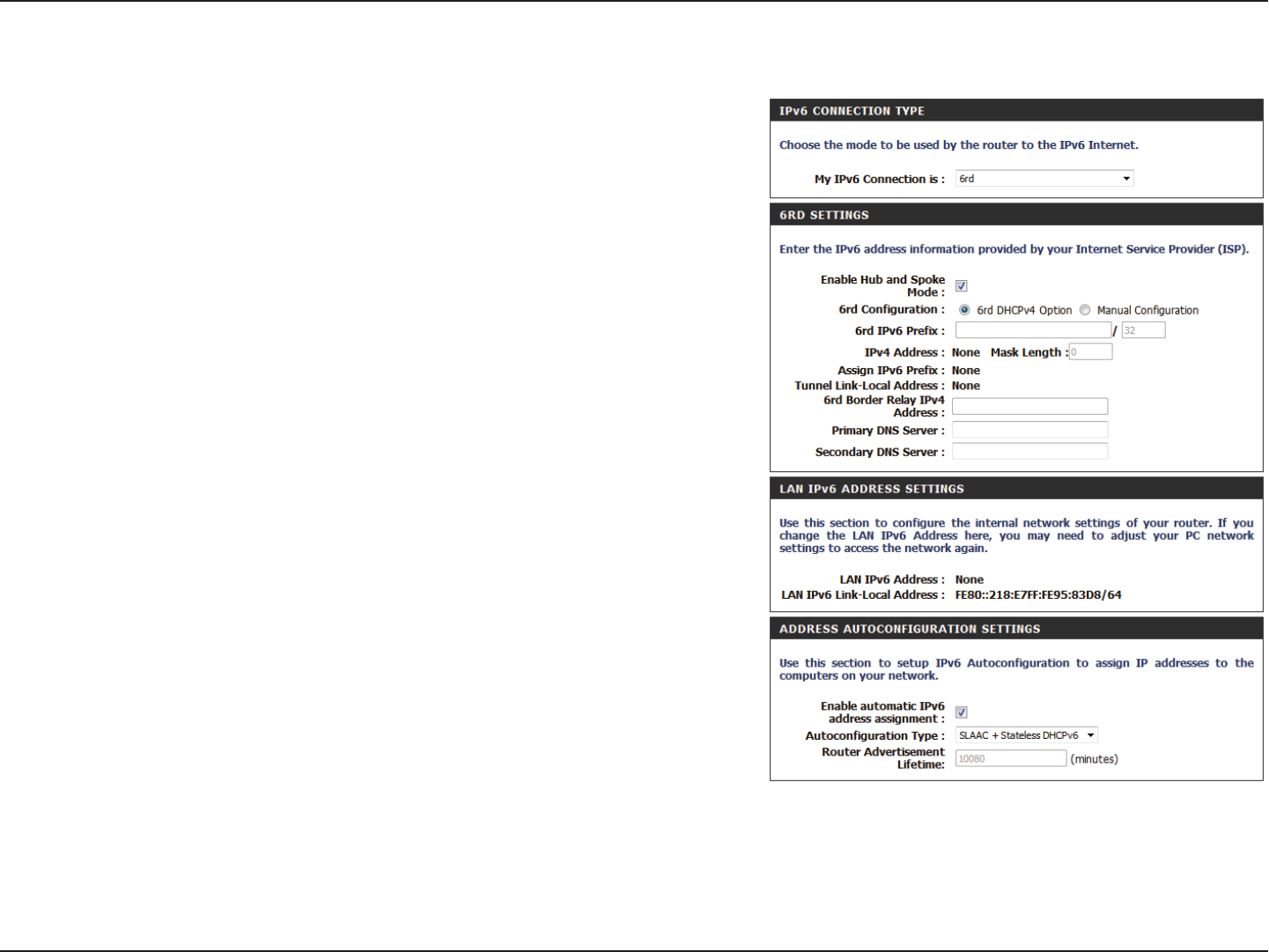
52D-Link DIR-655 User Manual
Section 3 - Conguration
6rd
Select 6rd from the drop-down menu.
Enter the address settings supplied by your Internet provider (ISP).
Enter the LAN (local) IPv6 address for the router.
Displays the router’s LAN link-local address.
Check to enable the autoconguration feature.
Select Stateful (DHCPv6), SLAAC+RDNSS, or SLAAC + Stateless
DHCPv6.
Enter the start IPv6 address for the DHCPv6 range for your local
computers.
Enter the end IPv6 address for the DHCPv6 range for your local
computers.
Enter the router advertisement lifetime (in minutes).
My IPv6 Connection:
6rd Settings:
LAN IPv6 Address:
LAN Link-Local Address:
Enable Automatic DHCP-
PD in LAN:
Autoconguration Type:
IPv6 Address Range Start:
IPv6 Address Range End:
Router Advertisement
Lifetime:
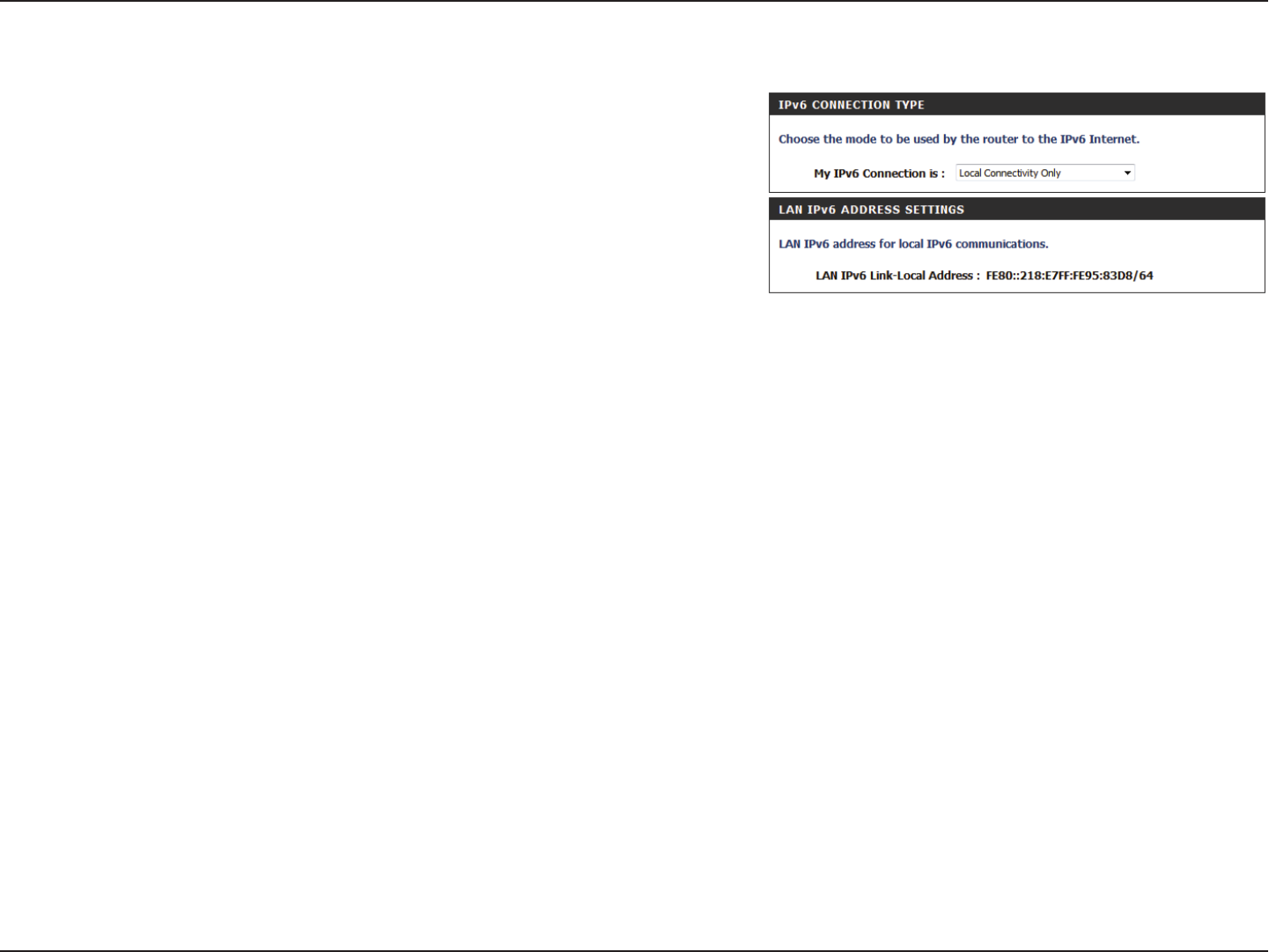
53D-Link DIR-655 User Manual
Section 3 - Conguration
Select Local Connectivity Only from the drop-down menu.
Displays the IPv6 address of the router.
My IPv6 Connection:
LAN IPv6 Address
Settings:
Local Connectivity Only
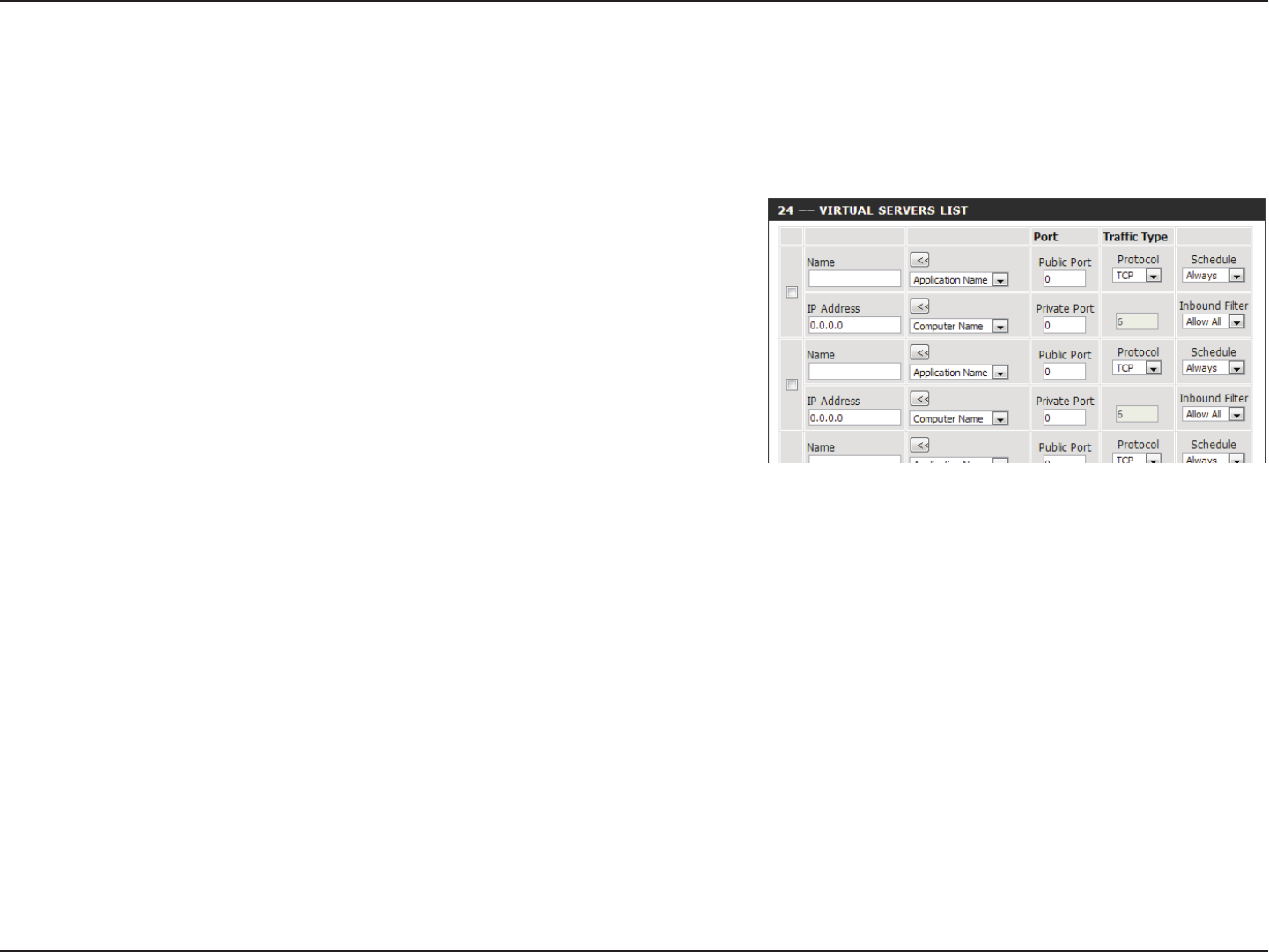
54D-Link DIR-655 User Manual
Section 3 - Conguration
This will allow you to open a single port. If you would like to open a range of ports, refer to the next page.
Enter a name for the rule or select an application from the drop-down menu.
Select an application and click << to populate the elds.
Enter the IP address of the computer on your local network that you want
to allow the incoming service to. If your computer is receiving an IP address
automatically from the router (DHCP), you computer will be listed in the
Computer Name drop-down menu. Select your computer and click <<.
Enter the port that you want to open. The private and public ports are
usually the same. The public port is the port seen from the Internet side, and
the private port is the port being used by the application on the computer
within your local network.
Select TCP, UDP or Both from the drop-down menu.
The schedule of time when the Virtual Server Rule will be enabled. The
schedule may be set to Always, which will allow the particular service to
always be enabled. You can create your own times in the Tools > Schedules
section.
Select Allow All (most common) or a created Inbound lter. You may create
your own inbound lters in the Advanced > Inbound Filter page.
Name:
IP Address:
Private Port/
Public Port:
Protocol Type:
Schedule:
Inbound Filter:
Virtual Server
Advanced Settings
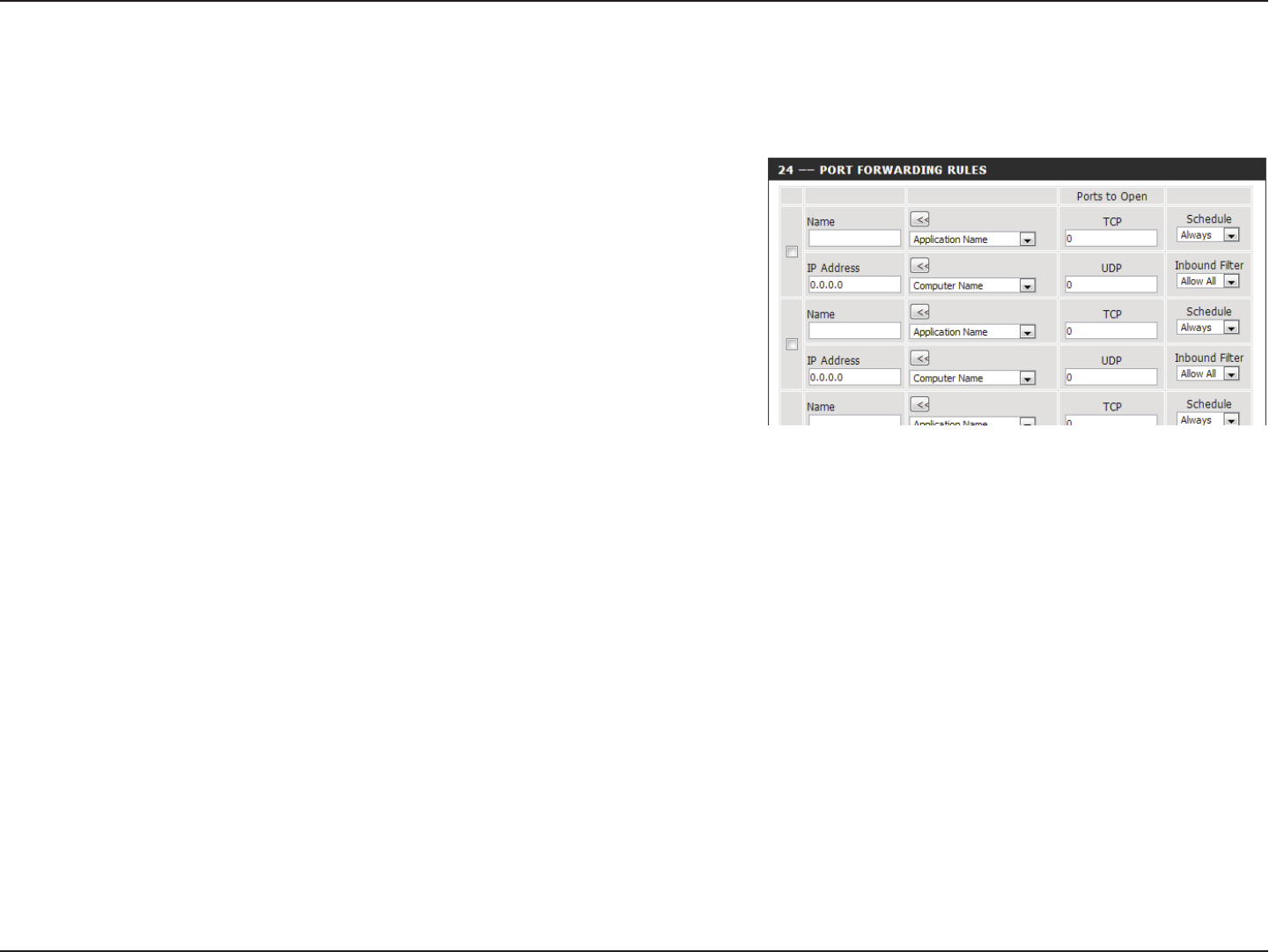
55D-Link DIR-655 User Manual
Section 3 - Conguration
This will allow you to open a single port or a range of ports.
Port Forwarding
Enter a name for the rule or select an application from the drop-down menu.
Select an application and click << to populate the elds.
Enter the IP address of the computer on your local network that you want
to allow the incoming service to. If your computer is receiving an IP address
automatically from the router (DHCP), you computer will be listed in the
Computer Name drop-down menu. Select your computer and click <<.
Enter the TCP and/or UDP port or ports that you want to open. You can enter
a single port or a range of ports. Separate ports with a comma.
Example: 24,1009,3000-4000
The schedule of time when the Virtual Server Rule will be enabled. The
schedule may be set to Always, which will allow the particular service to
always be enabled. You can create your own times in the Tools > Schedules
section.
Select Allow All (most common) or a created Inbound lter. You may create
your own inbound lters in the Advanced > Inbound Filter page.
Name:
IP Address:
TCP/UDP:
Schedule:
Inbound Filter:
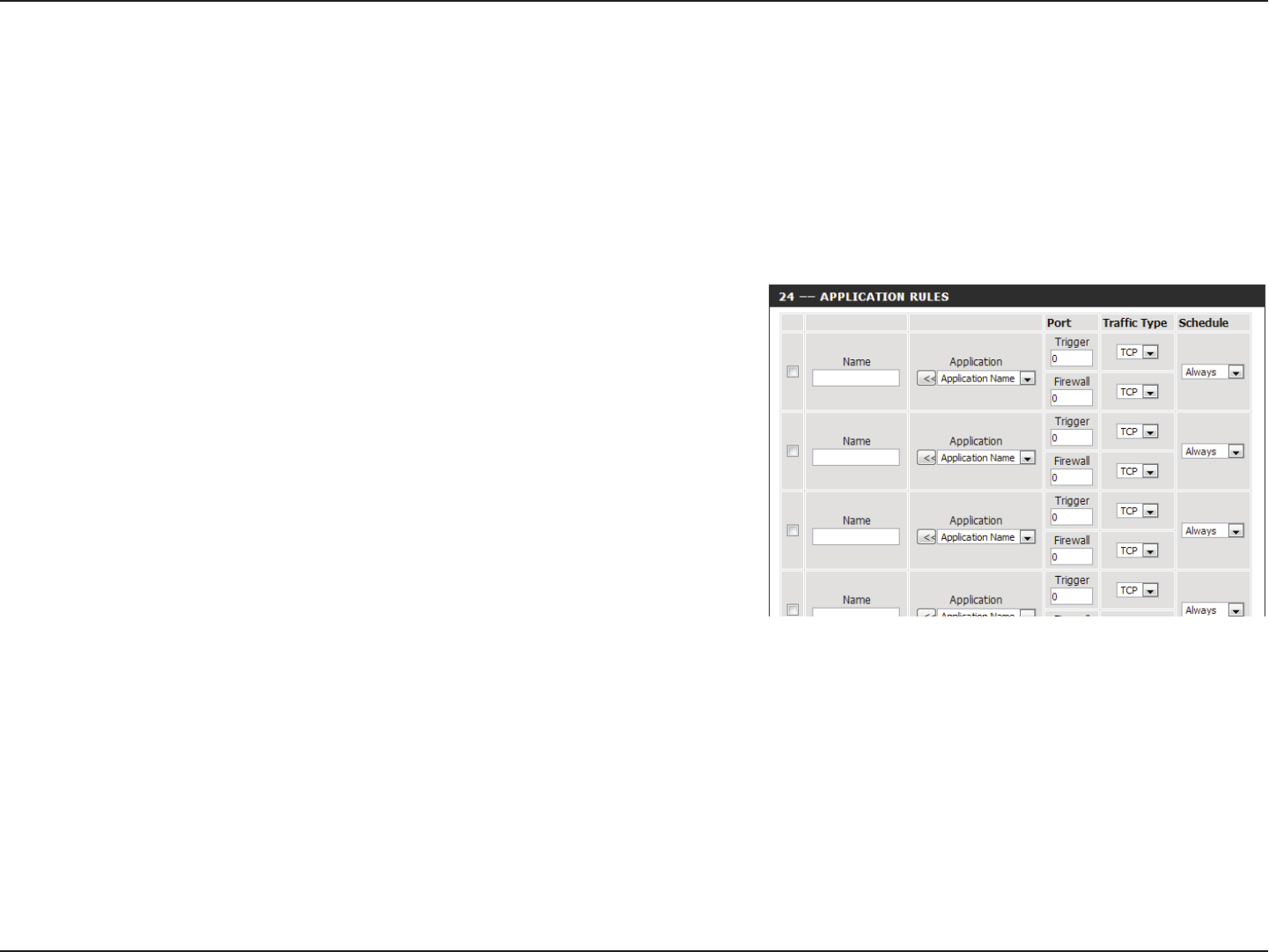
56D-Link DIR-655 User Manual
Section 3 - Conguration
Enter a name for the rule. You may select a pre-dened application from
the drop-down menu and click <<.
This is the port used to trigger the application. It can be either a single port
or a range of ports.
Select the protocol of the trigger port (TCP, UDP or Both).
This is the port number on the Internet side that will be used to access the
application. You may dene a single port or a range of ports. You can use
a comma to add multiple ports or port ranges.
Select the protocol of the rewall port (TCP, UDP, or Both).
The schedule of time when the Application Rule will be enabled. The
schedule may be set to Always, which will allow the particular service to
always be enabled. You can create your own times in the Tools > Schedules
section.
Name:
Trigger:
Trac Type:
Firewall:
Trac Type:
Schedule:
Application Rules
Some applications require multiple connections, such as Internet gaming, video conferencing, Internet telephony and others. These applications
have diculties working through NAT (Network Address Translation). Application Rules makes some of these applications work with the DIR-655.
If you need to run applications that require multiple connections, specify the port normally associated with an application in the Trigger Port eld,
select the protocol type as TCP or UDP, then enter the rewall (public) ports associated with the trigger port to open them for inbound trac.
The DIR-655 provides some predened applications in the table on the bottom of the web page. Select the application you want to use and enable it.
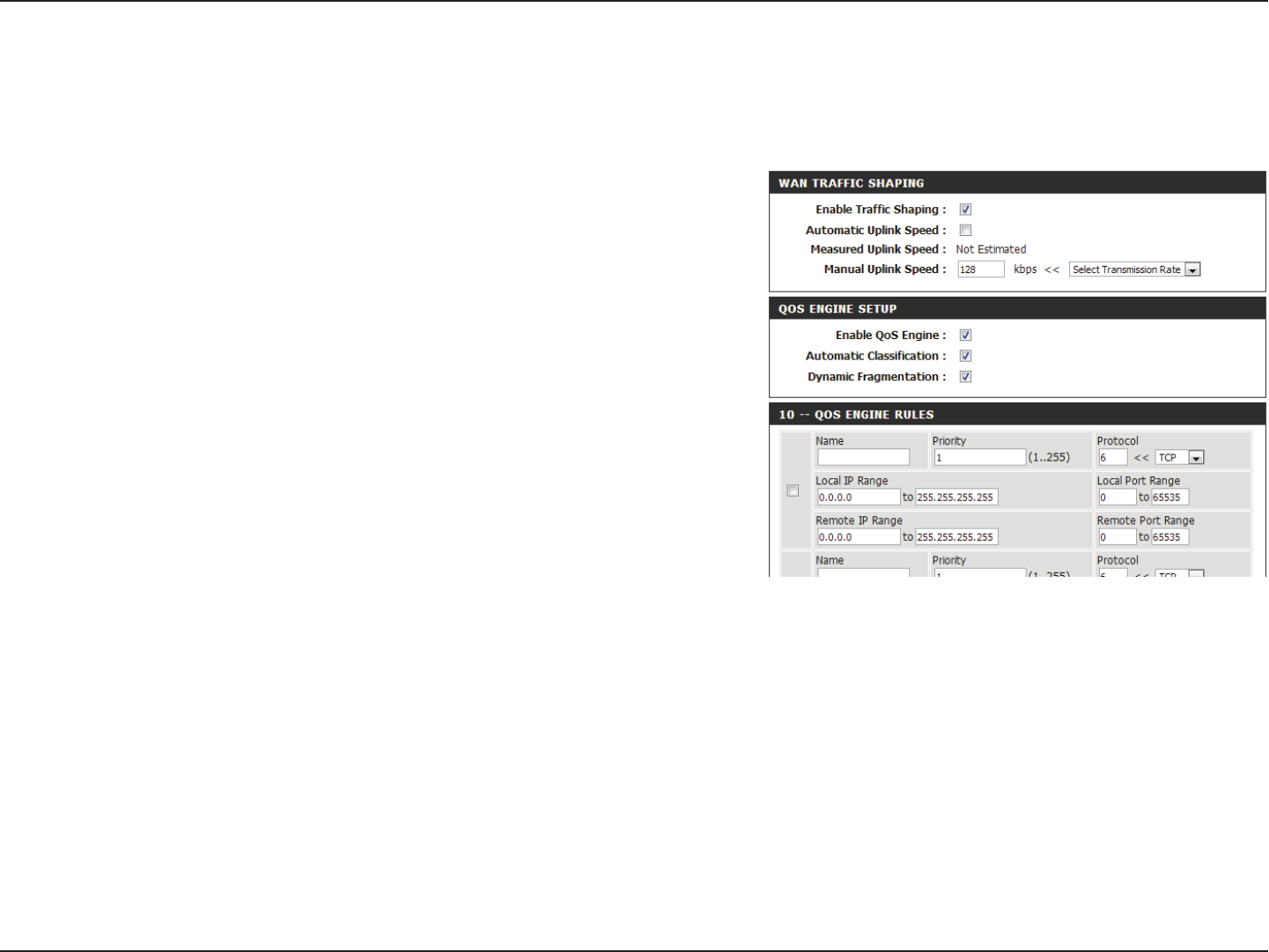
57D-Link DIR-655 User Manual
Section 3 - Conguration
QoS Engine
This option is disabled by default. Enable this option for better performance
and experience with online games and other interactive applications, such
as VoIP.
This option is enabled by default when the QoS Engine option is enabled.
This option will allow your router to automatically determine the uplink
speed of your Internet connection.
This displays the detected uplink speed.
The speed at which data can be transferred from the router to your ISP. This
is determined by your ISP. ISP’s often note speed as a download/upload
pair. For example, 1.5Mbits/284Kbits. Using this example, you would enter
284. Alternatively you can test your uplink speed with a service such as
speedtest.net.
This option is disabled by default. Enable this option for better performance
and experience with online games and other interactive applications, such
as VoIP.
This option is enabled by default so that your router will automatically
determine which programs should have network priority. For best
performance, use the Automatic Classication
option to automatically set the priority for your applications.
This option should be enabled when you have a slow Internet uplink. It
helps to reduce the impact that large low priority network packets can
have on more urgent ones.
A QoS Engine rule identies a specic message ow and assigns a priority
to that ow. For most applications, automatic classication will be adequate
and specic QoS Engine rules will not be required.
The QoS Engine supports overlaps between rules, where more than one
rule can match for a specic message ow. If more than one rule is found
to match, the rule with the highest priority will be used.
Enable Trac Shaping:
Automatic Uplink
Speed:
Measured Uplink
Speed:
Manual Uplink Speed:
Enable QoS Engine:
Automatic
Classication:
Dynamic
Fragmentation:
QoS Engine Rules:
The QoS Engine helps improve your network gaming performance by prioritizing applications. By default, the QoS Engine settings are disabled and
application priority is not classied automatically.
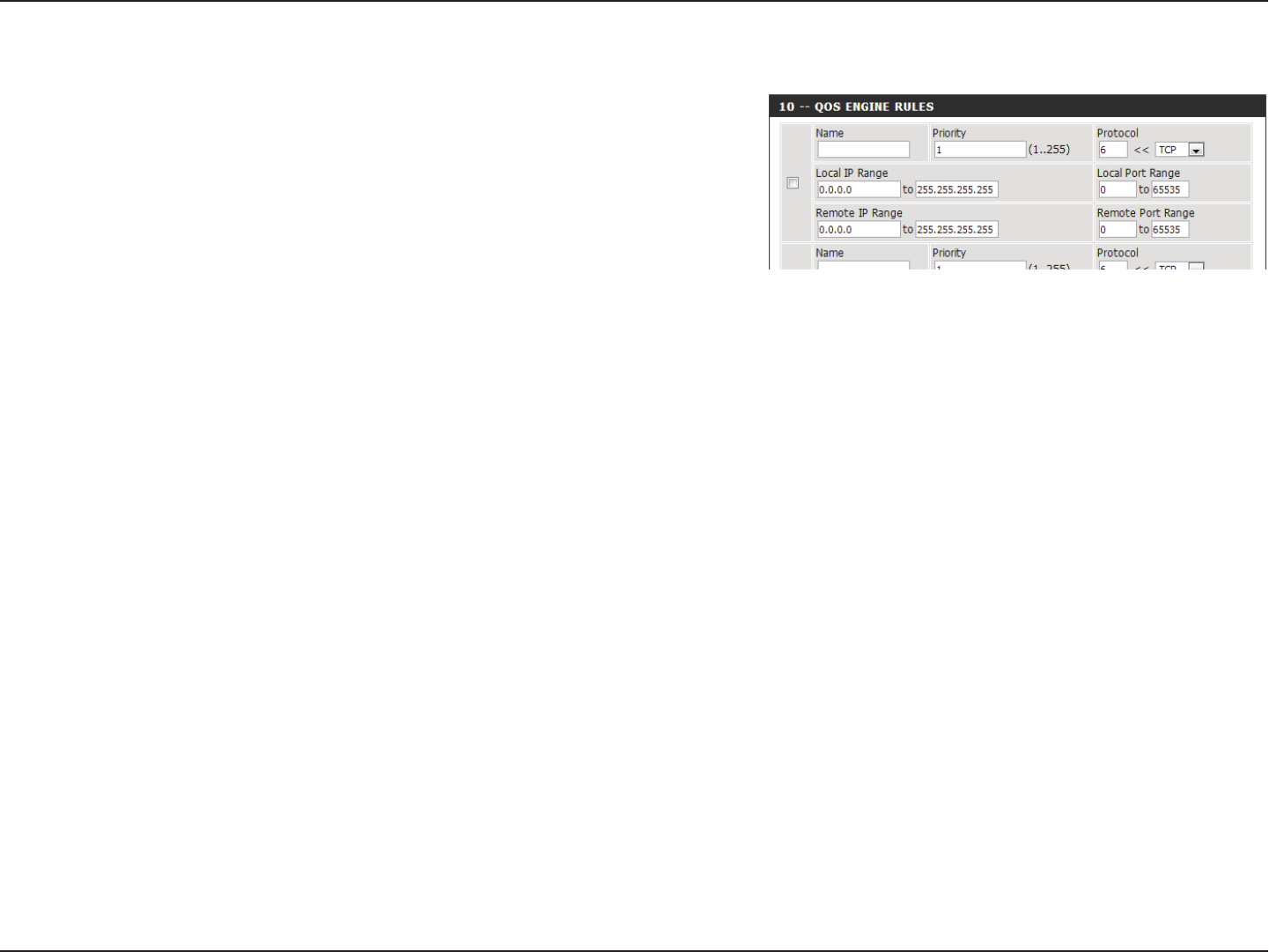
58D-Link DIR-655 User Manual
Section 3 - Conguration
Name:
Priority:
Protocol:
Local IP Range:
Local Port Range:
Remote IP Range:
Remote Port
Range:
Create a name for the rule that is meaningful to you.
The priority of the message ow is entered here -- 1 receives the highest
priority (most urgent) and 255 receives the lowest priority (least urgent).
The protocol used by the messages.
The rule applies to a ow of messages whose LAN-side IP address falls
within the range set here.
The rule applies to a ow of messages whose LAN-side port number is
within the range set here.
The rule applies to a ow of messages whose WAN-side IP address falls
within the range set here.
The rule applies to a ow of messages whose WAN-side port number is
within the range set here.
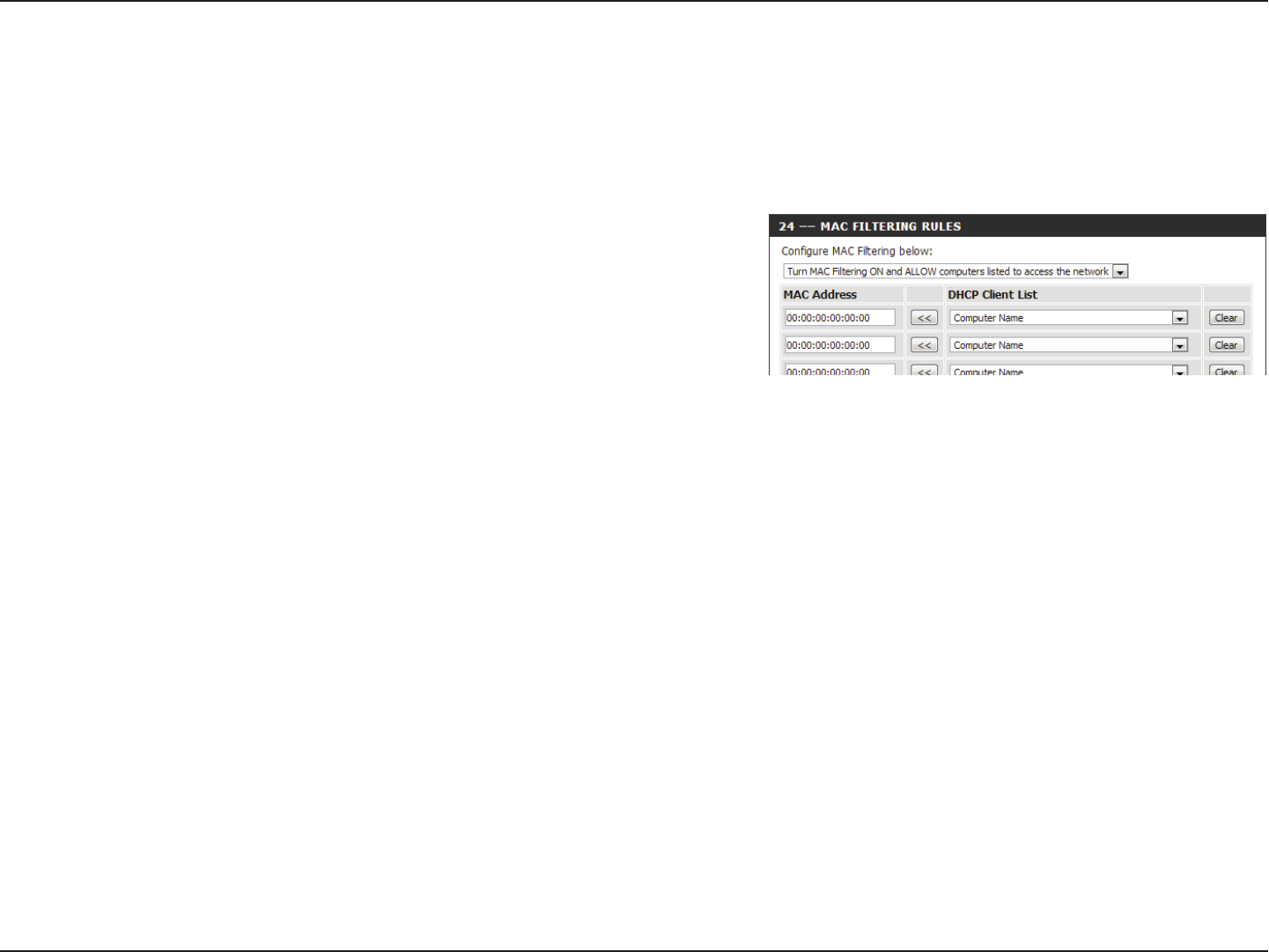
59D-Link DIR-655 User Manual
Section 3 - Conguration
Network Filter
Select Turn MAC Filtering O, Allow MAC addresses listed below, or Deny
MAC addresses listed below from the drop-down menu.
Enter the MAC address you would like to lter.
To nd the MAC address on a computer, please refer to the Networking Basics
section in this manual.
Select a DHCP client from the drop-down menu and click << to copy that MAC
address.
Click to remove the MAC address.
Congure MAC
Filtering:
MAC Address:
DHCP Client:
Clear:
Use MAC (Media Access Control) Filters to allow or deny LAN (Local Area Network) computers, by their MAC addresses, from accessing the network.
You can either manually add a MAC address or select the MAC address from the list of clients that are currently connected to the router.
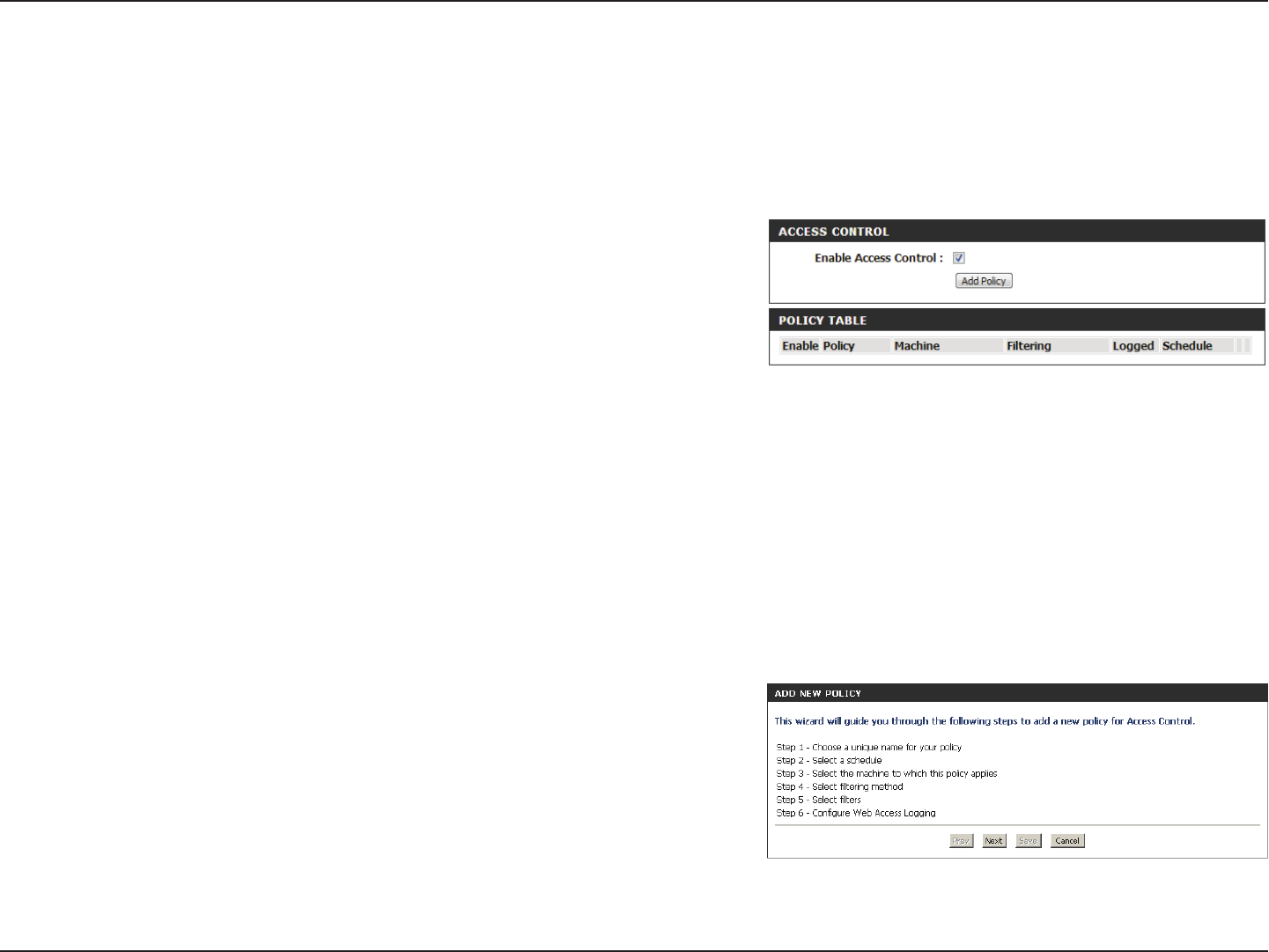
60D-Link DIR-655 User Manual
Section 3 - Conguration
Access Control
First, click the Enable Access Control box. Next, click the Add Policy button
to start the Access Control Wizard.
Add Policy:
The Access Control section allows you to control access in and out of your network. Use this feature as “Parental Controls” to only grant access to
approved sites, limit web access based on time or dates, and/or block access from applications like P2P utilities or games.
Click Next to continue with the wizard.
Access Control Wizard
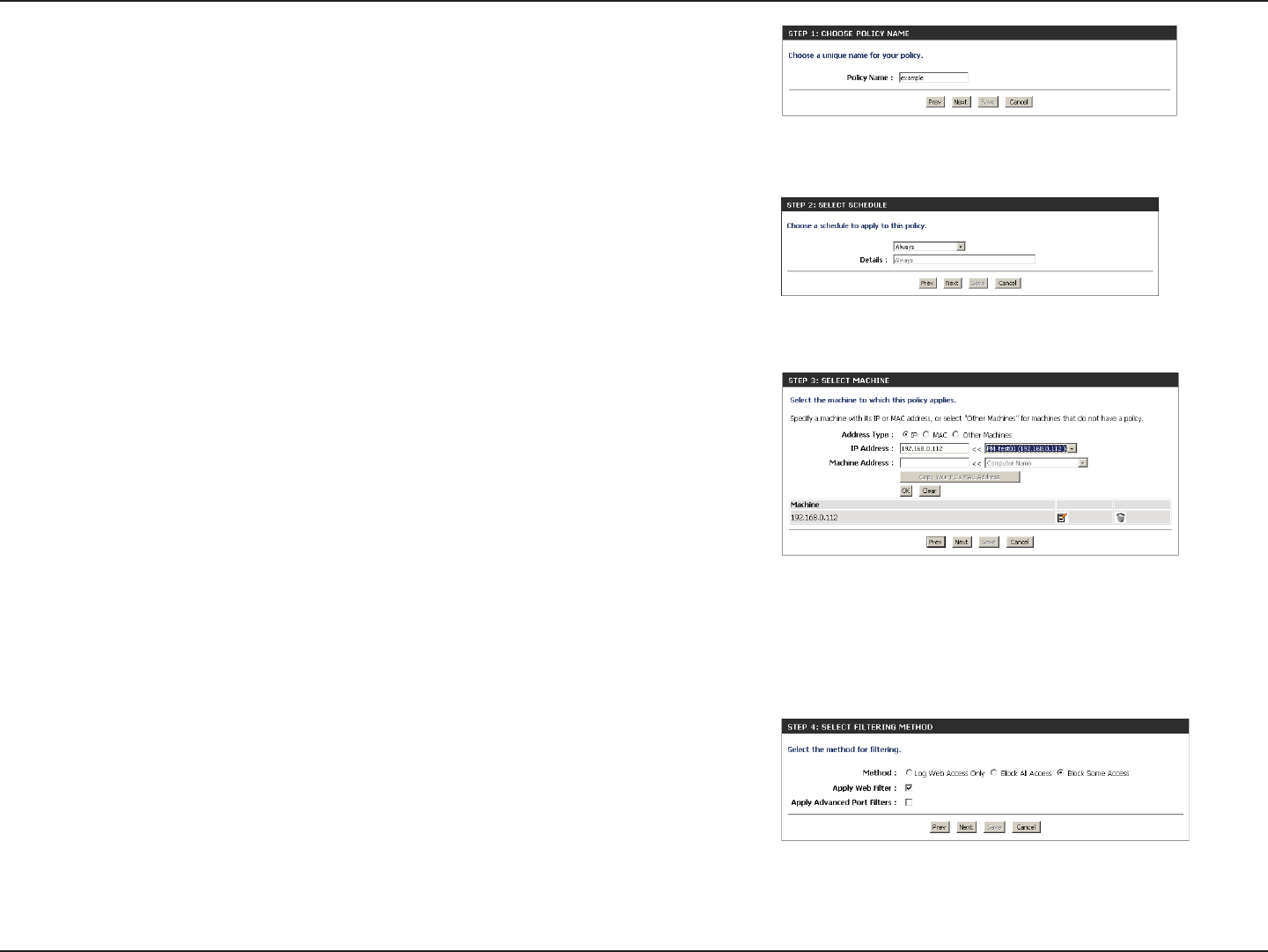
61D-Link DIR-655 User Manual
Section 3 - Conguration
Enter a name for the policy and then click Next to continue.
Select a schedule (i.e., Always) from the drop-down menu and
then click Next to continue.
Enter the following information and then click Next to continue:
• Address Type - Select IP address, MAC address, or
Other Machines.
• IP Address - Enter the IP address of the computer you
want to apply the rule to.
• Machine Address - Enter the PC MAC address (i.e.,
00:00.00.00.00).
Select the ltering method and then click Next to continue.
Note: If you select the Apply Advanced Port Filters option you will be
forwarded to the Add Port Filters Rules window. Otherwise, you will be
advanced to the Congure Web Access Logging window (see next page).
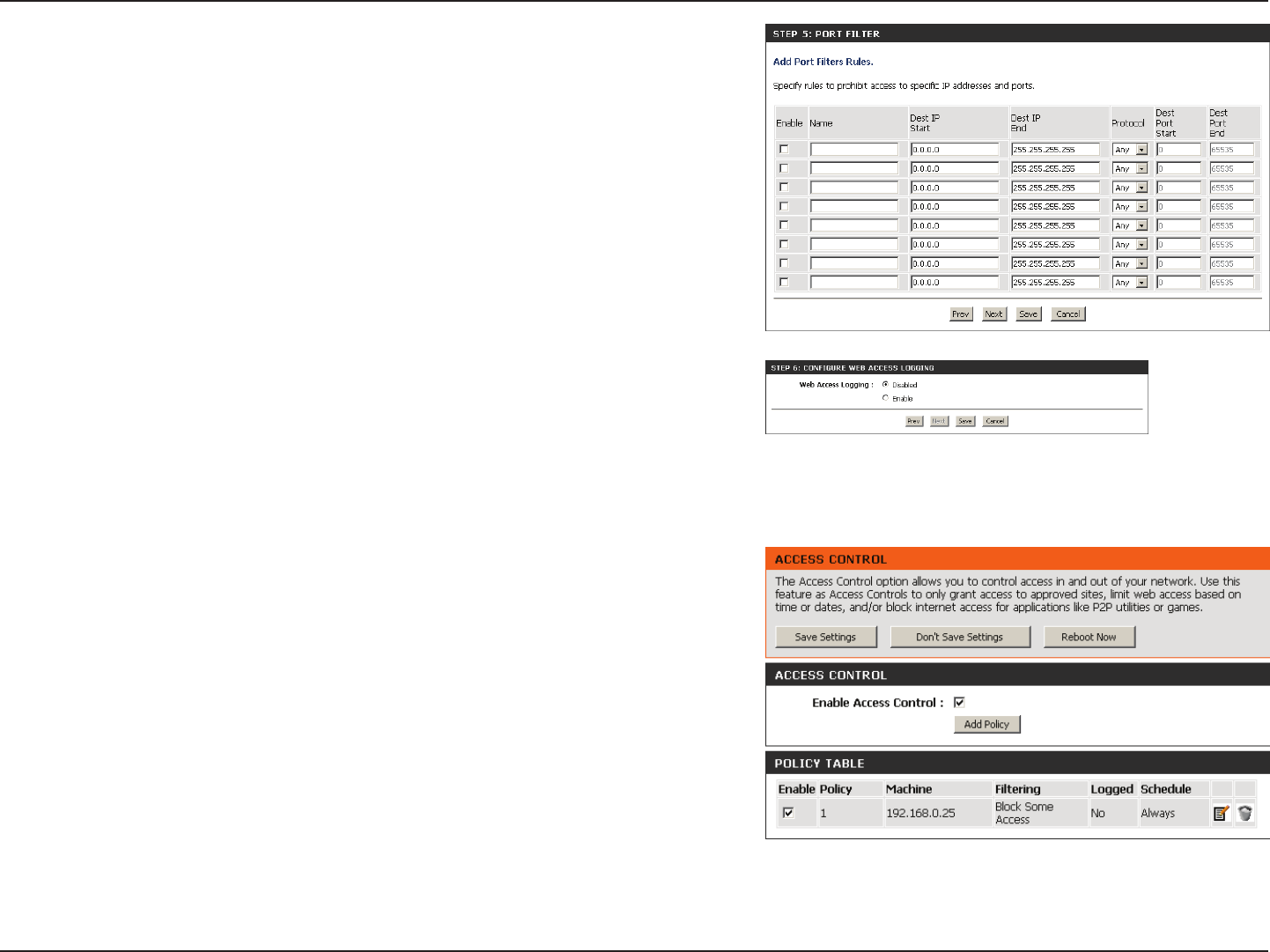
62D-Link DIR-655 User Manual
Section 3 - Conguration
Enter the rule:
Enable - Check to enable the rule.
Name - Enter a name for your rule.
Dest IP Start - Enter the starting IP address.
Dest IP End - Enter the ending IP address.
Protocol - Select the protocol.
Dest Port Start - Enter the starting port number.
Dest Port End - Enter the ending port number.
To enable web logging, click Enable.
Click Save to save the access control rule.
Your newly created policy will now show up under Policy Table.
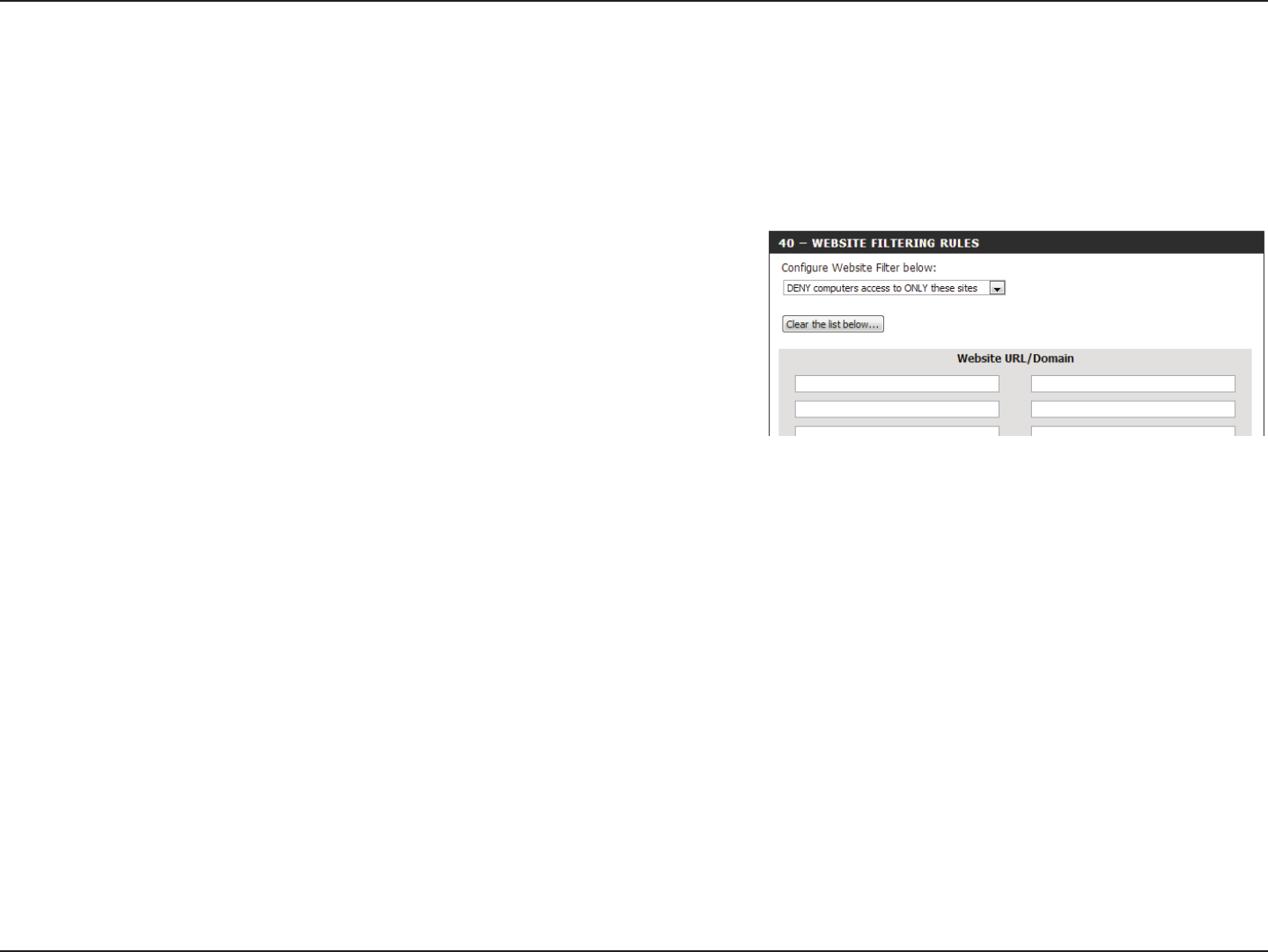
63D-Link DIR-655 User Manual
Section 3 - Conguration
Add Website
Filtering Rule:
Website URL/
Domain:
Website Filter
Select either DENY computers access to ONLY these sites or ALLOW
computers access to ONLY these sites.
Enter the keywords or URLs that you want to allow or block. Click Save
Settings.
Website Filters are used to allow you to set up a list of websites that can be viewed by multiple users through the network. To use this feature, select
to Allow or Deny, enter the domain or website and click Save Settings. You must also select Apply Web Filter under the Access Control section
(page 60).
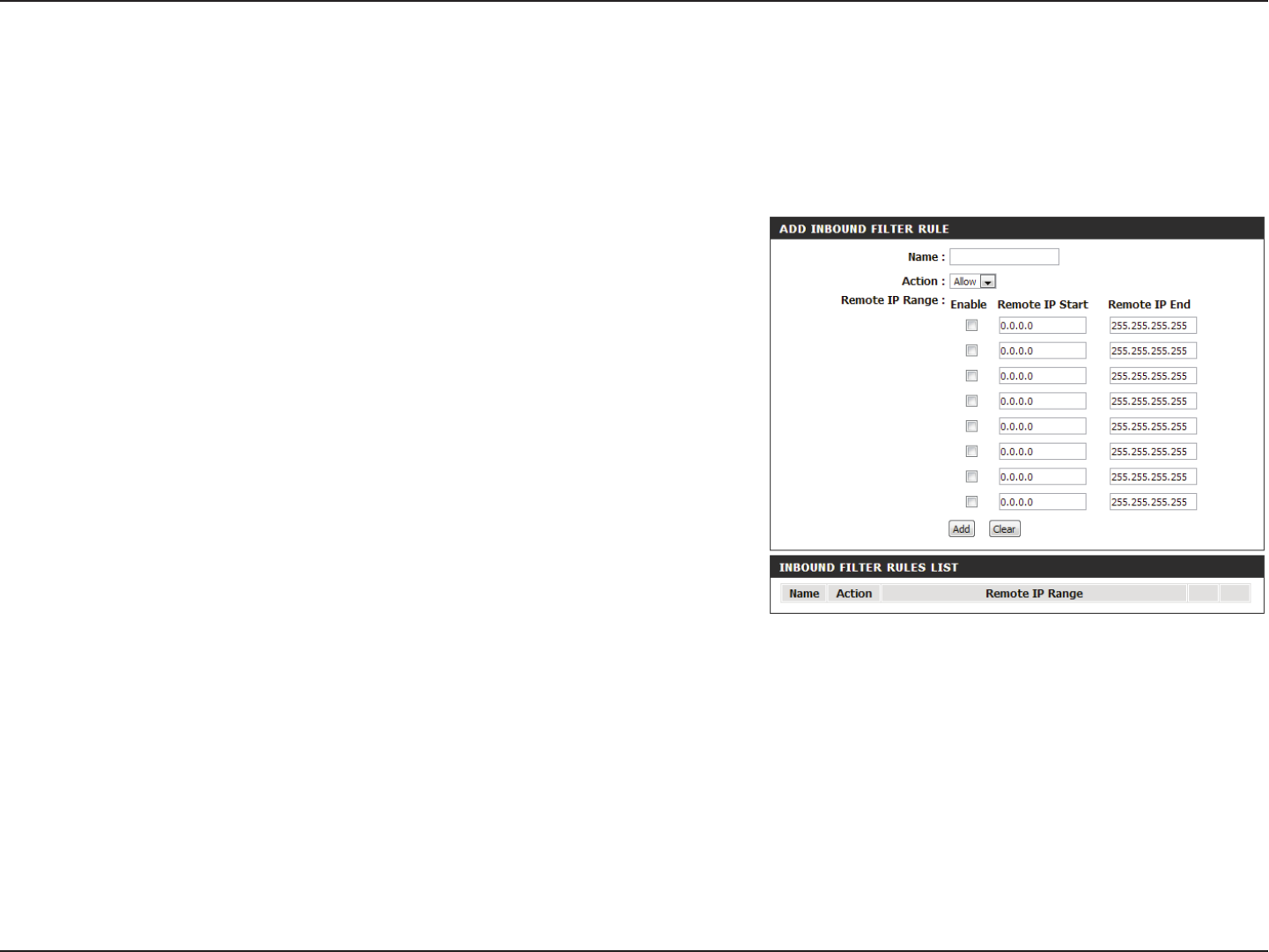
64D-Link DIR-655 User Manual
Section 3 - Conguration
Enter a name for the inbound lter rule.
Select Allow or Deny.
Check to enable the rule.
Enter the starting IP address. Enter 0.0.0.0 if you do not want to specify
an IP range.
Enter the ending IP address. Enter 255.255.255.255 if you do not want to
specify and IP range.
Click the Add button to apply your settings. You must click Save Settings
at the top to save the settings.
This section will list any rules that are created. You may click the Edit icon
to change the settings or enable/disable the rule, or click the Delete icon
to remove the rule.
Name:
Action:
Enable:
Remote IP Start:
Remote IP End:
Add:
Inbound Filter Rules
List:
The Inbound Filter feature provides an advanced method of controlling data received from the Internet. With this feature, you can congure inbound
data ltering rules that control data based on an IP address range. Inbound Filters can be used with Virtual Server, Port Forwarding, or Remote
Administration features.
Inbound Filter
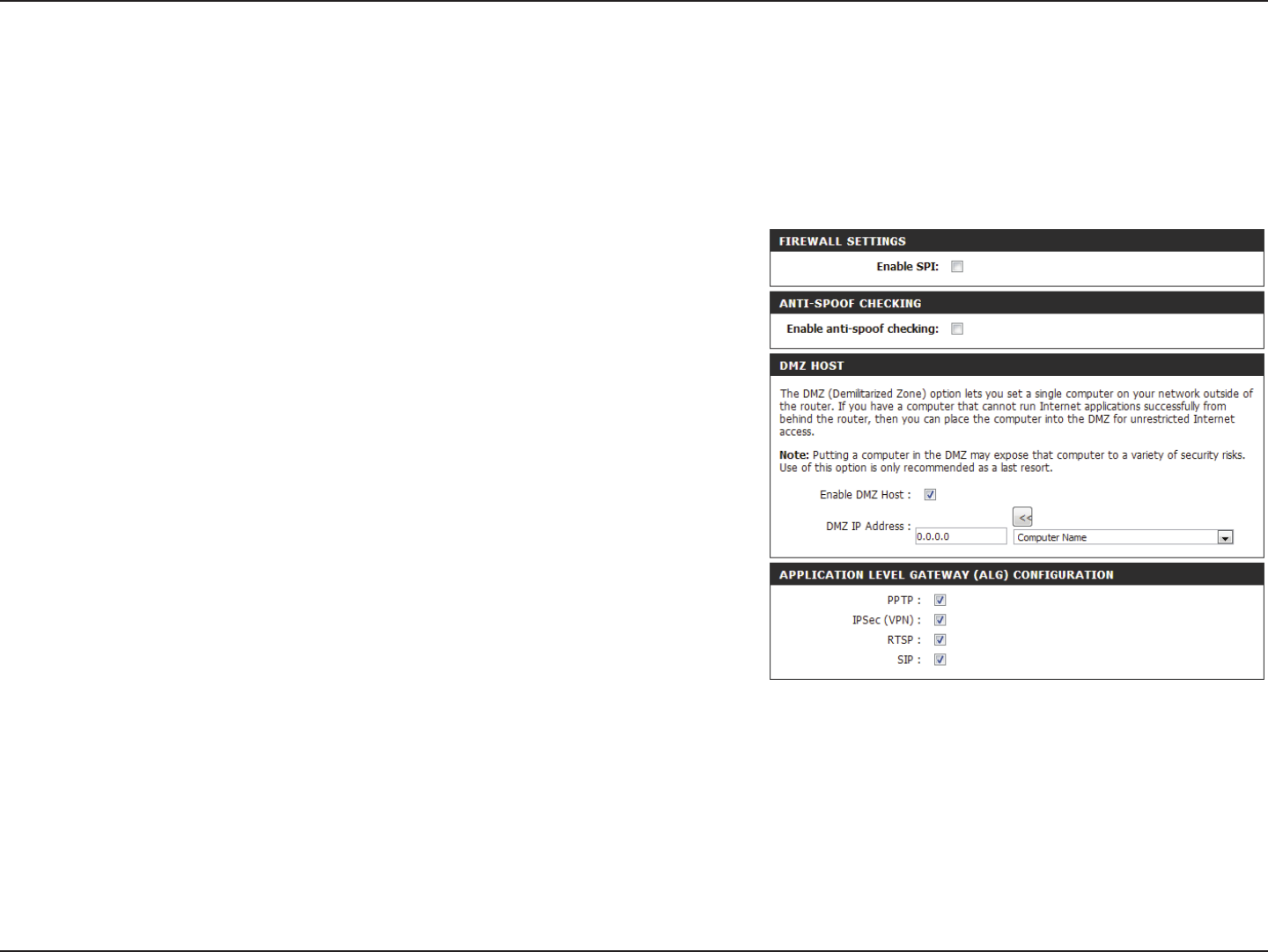
65D-Link DIR-655 User Manual
Section 3 - Conguration
SPI (Stateful Packet Inspection), also known as dynamic packet ltering, helps
to prevent cyber attacks by tracking more state per session. It validates that
the trac passing through the session conforms to the protocol.
Enable this feature to protect your network from certain kinds of “spoong”
attacks.
If an application has trouble working from behind the router, you can expose
one computer to the Internet and run the application on that computer.
Note: Placing a computer in the DMZ may expose that computer to a variety
of security risks. Use of this option is only recommended as a last resort.
Specify the IP address of the computer on the LAN that you want to have
unrestricted Internet communication. If this computer obtains its IP address
automatically using DHCP, be sure to make a static reservation on the Setup
> Network Settings page so that the IP address of the DMZ machine does
not change.
Allows multiple machines on the LAN to connect to their corporate network
using PPTP protocol.
Allows multiple VPN clients to connect to their corporate network using
IPSec. Some VPN clients support traversal of IPSec through
NAT. This ALG may interfere with the operation of such VPN clients. If you
are having trouble connecting with your corporate network, try turning
this ALG o. Please check with the system administrator of your corporate
network whether your VPN client supports
NAT traversal.
Enable SPI:
Anti-Spoof Check:
Enable DMZ:
DMZ IP Address:
PPTP:
IPSEC (VPN):
Firewall Settings
A rewall protects your network from the outside world. The DIR-655 oers a rewall type functionality. The Stateful Packet Inpection (SPI) feature
helps prevent cyber attacks. Sometimes you may want a computer exposed to the outside world for certain types of applications. If you choose
to expose a computer, you can enable DMZ. DMZ is short for Demilitarized Zone. This option will expose the chosen computer completely to the
outside world.
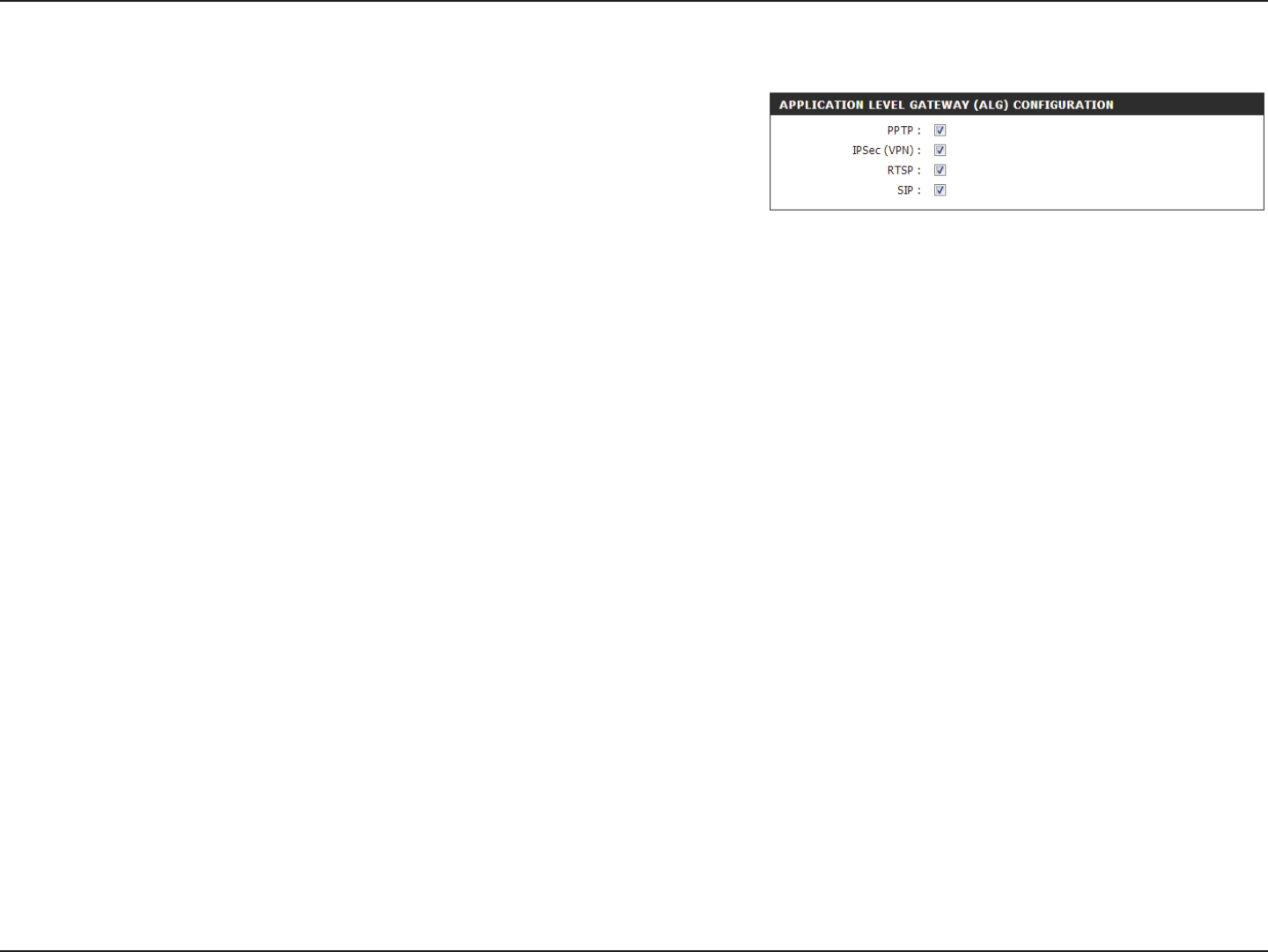
66D-Link DIR-655 User Manual
Section 3 - Conguration
RTSP:
SIP:
Allows applications that use Real Time Streaming Protocol to receive
streaming media from the Internet. QuickTime and Real Player are some
of the common applications using this protocol.
Allows devices and applications using VoIP (Voice over IP) to communicate
across NAT. Some VoIP applications and devices have the ability to discover
NAT devices and work around them. This ALG may interfere with the
operation of such devices. If you are having trouble making VoIP calls, try
turning this ALG o.
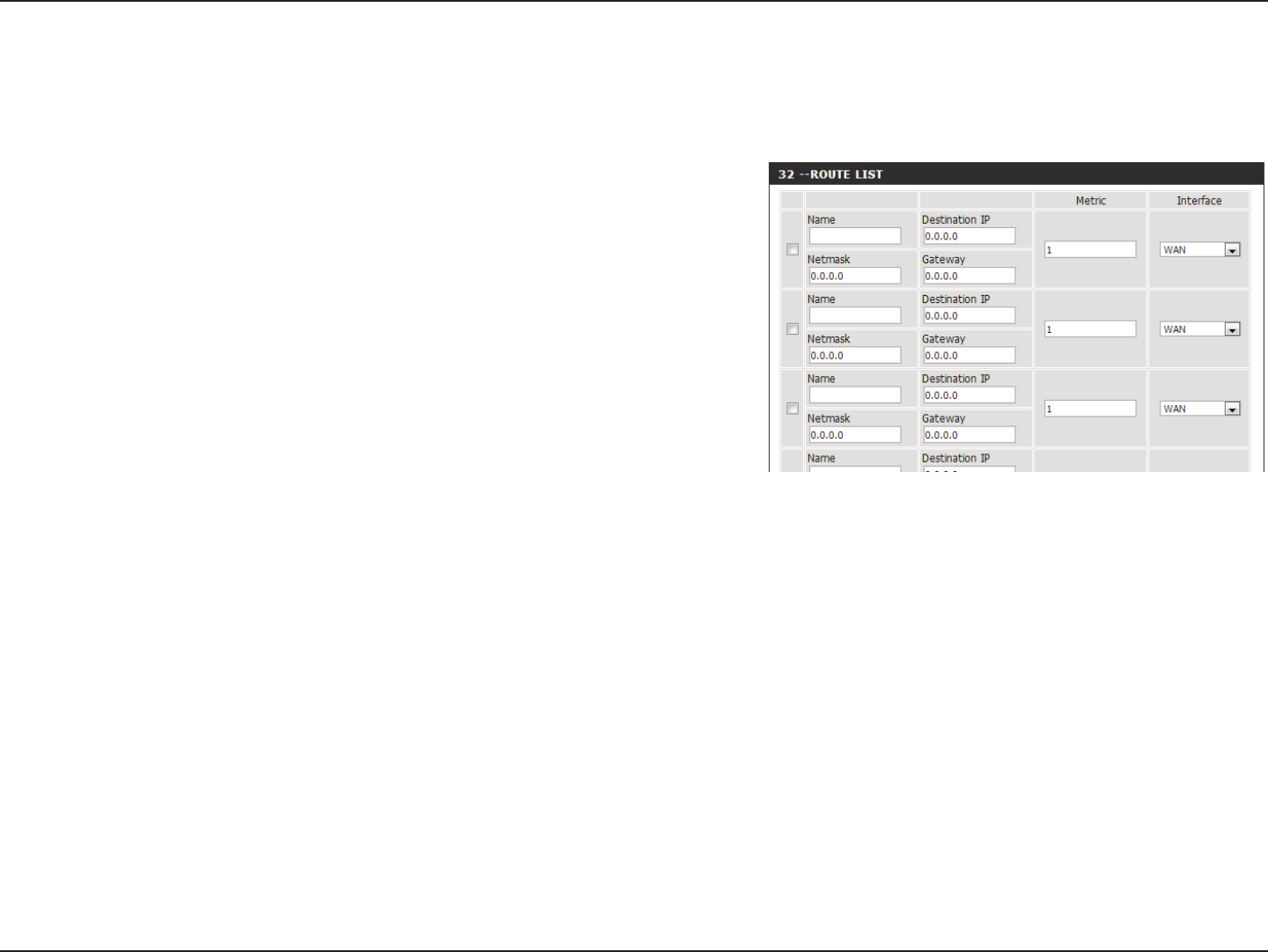
67D-Link DIR-655 User Manual
Section 3 - Conguration
Enter a name for your route.
Enter the IP address of packets that will take this route.
Enter the netmask of the route. Please note that the octets must match
your destination IP address.
Enter your next hop gateway to be taken if this route is used.
The route metric is a value from 1 to 16 that indicates the cost of using this
route. A value 1 is the lowest cost and 15 is the highest cost.
Select the interface that the IP packet must use to transit out of the router
when this route is used.
Name:
Destination IP:
Netmask:
Gateway:
Metric:
Interface:
Routing
The Routing option is an advanced method of customizing specic routes of data through your network.
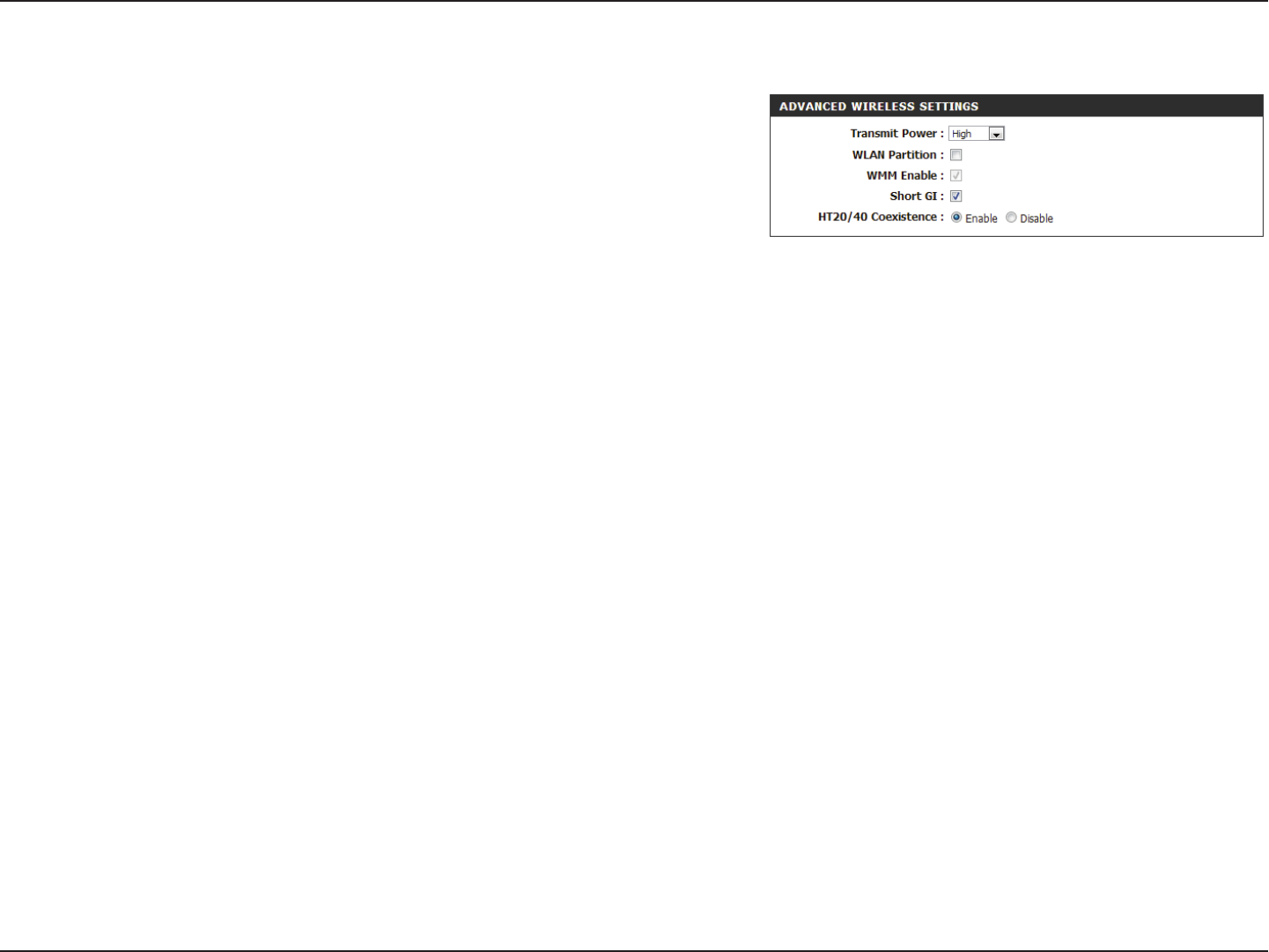
68D-Link DIR-655 User Manual
Section 3 - Conguration
Advanced Wireless
Set the transmit power of the antennas.
This enables 802.11d operation. 802.11d is a wireless specication
developed to allow implementation of wireless networks in countries
that cannot use the 802.11 standard. This feature should only be
enabled if you are in a country that requires it.
WMM is QoS for your wireless network. This will improve the quality
of video and voice applications for your wireless clients.
Check this box to reduce the guard interval time therefore increasing
the data capacity. However, it’s less reliable and may create higher
data loss.
Enable this option to reduce interference from other wireless networks
in your area. If the channel width is operating at 40MHz and there
is another wireless network’s channel over-lapping and causing
interference, the router will automatically change to 20MHz.
Transmit Power:
WLAN Partition:
WMM Enable:
Short GI:
HT20/40 Coexistence:
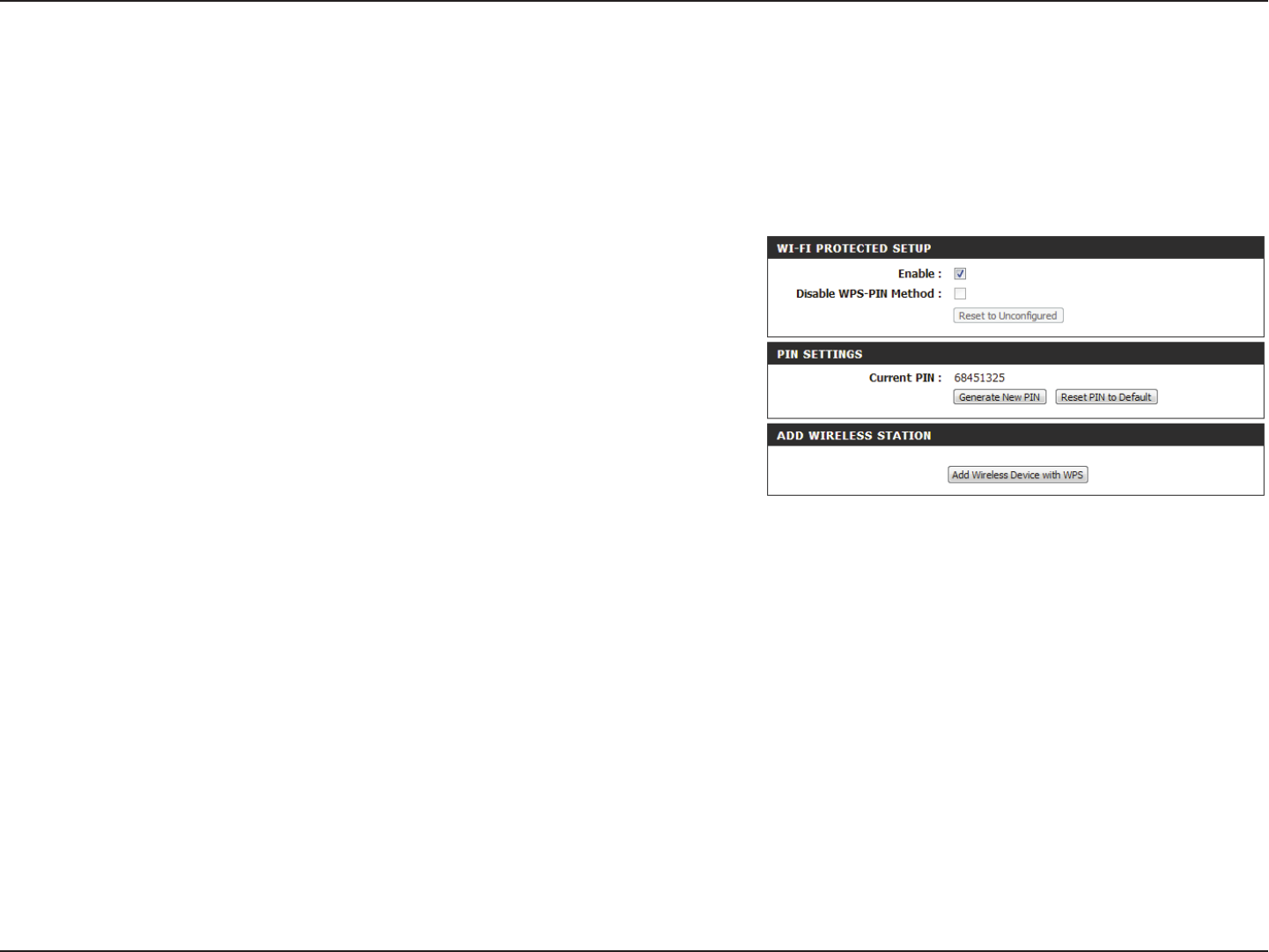
69D-Link DIR-655 User Manual
Section 3 - Conguration
Wi-Fi Protected Setup (WPS)
Enable the Wi-Fi Protected Setup feature.
Note: If this option is unchecked, the WPS button on the side of the router will
be disabled.
Disabling the wireless security settings prevents the settings from being
changed by the Wi-Fi Protected Setup feature of the router. Devices can still
be added to the network using Wi-Fi Protected Setup, however, the settings
of the network will not change once this option is checked.
A PIN is a unique number that can be used to add the router to an existing
network or to create a new network. The default PIN may be printed on the
bottom of the router. For extra security, a new PIN can be generated. You can
restore the default PIN at any time. Only the Administrator (“admin” account)
can change or reset the PIN.
Shows the current PIN.
Create a random number that is a valid PIN. This becomes the router’s PIN.
You can then copy this PIN to the user interface of the registrar.
This wizard helps you add wireless devices to the wireless network.
Restore the default PIN of the router.
Enable:
Disable WPS-PIN
Method:
PIN Settings:
Current PIN:
Generate New PIN:
Reset PIN to
Default:
Wi-Fi Protected Setup (WPS) System is a simplied method for securing your wireless network during initial setup as well as the “Add New Device”
processes. The Wi-Fi Alliance (WFA) has certied it across dierent products as well as manufactures. The process is just as easy as pressing a button
for the Push-Button Method, or correctly entering the 8-digit code for the Pin Code Method. The time reduction in setup and ease of use are quite
benecial, while the highest wireless security setting of WPA2 is automatically used.

70D-Link DIR-655 User Manual
Section 3 - Conguration
The wizard will either display the wireless network settings to guide you
through manual conguration, prompt you to enter the PIN for the device,
or ask you to press the conguration button on the device. If the device
supports Wi-Fi Protected Setup and has a conguration button, you can add
it to the network by pressing the conguration button on the device and
then the on the router within 60 seconds. The status LED on the router will
ash three times if the device has been successfully added to the network.
There are several ways to add a wireless device to your network. A “registrar”
controls access to the wireless network. A registrar only allows devices onto
the wireless network if you have entered the PIN, or pressed a special Wi-Fi
Protected Setup button on the device. The router acts as a registrar for the
network, although other devices may act as a registrar as well.
Click to start the Add Wireless Device wizard.
Add Wireless
Station:
Add Wireless Device
with WPS:
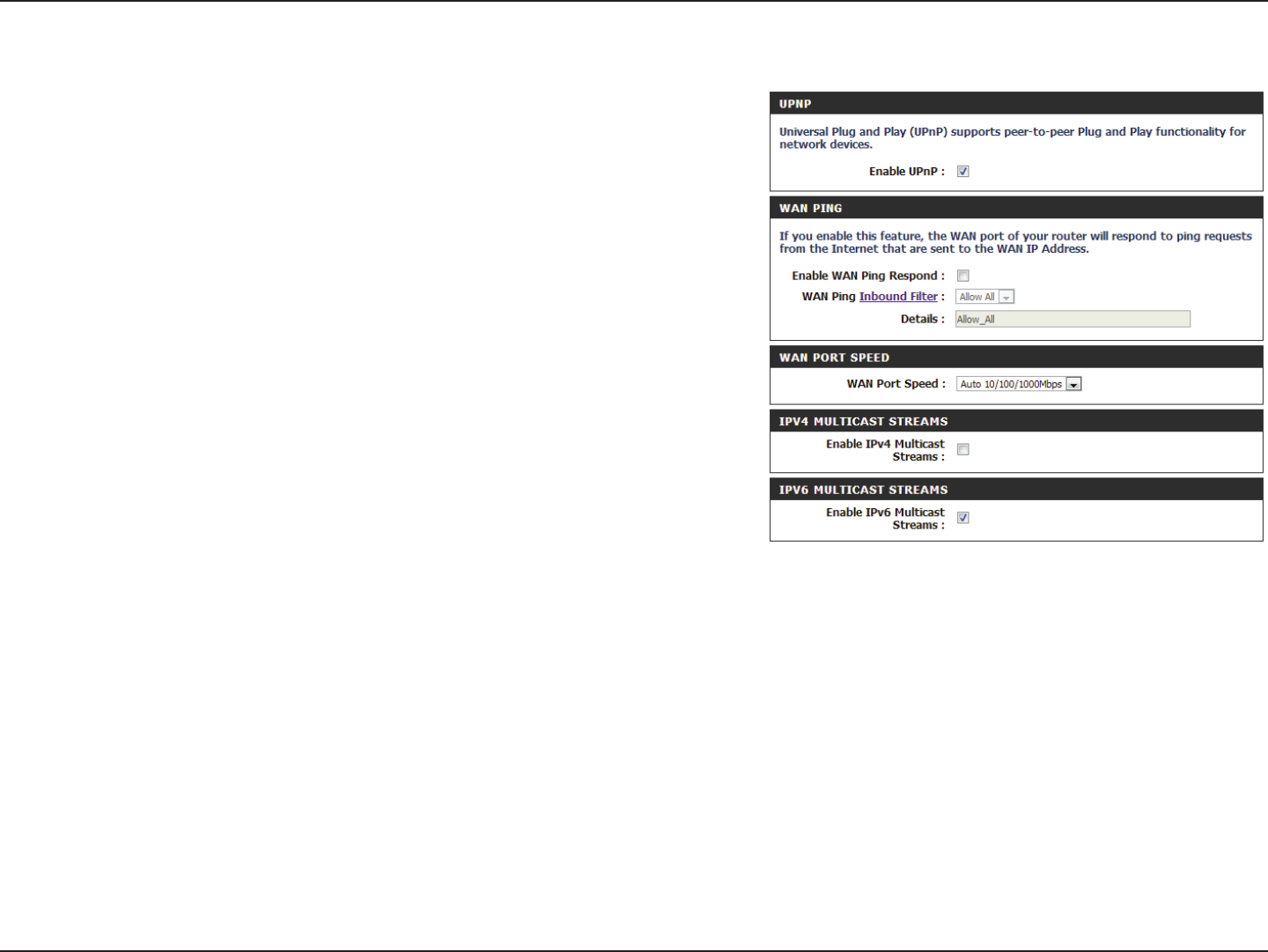
71D-Link DIR-655 User Manual
Section 3 - Conguration
To use the Universal Plug and Play (UPnP) feature click on Enabled.
UPnP provides compatibility with networking equipment, software and
peripherals.
Checking the box will allow the DIR-655 to respond to pings. Unchecking
the box may provide some extra security from hackers.
Select from the drop-down menu if you would like to apply the Inbound
Filter to the WAN ping. Refer to the Inbound Filters section for more
information.
You may set the port speed of the Internet port to 10Mbps, 100Mbps,
1000Mbps or Auto (recommended).
Check the box to allow multicast trac to pass through the router from
the Internet (IPv4).
Check the box to allow multicast trac to pass through the router from
the Internet (IPv6).
Enable UPnP:
WAN Ping:
WAN Ping Inbound Filter:
WAN Port Speed:
Enable IPV4 Multicast
Streams:
Enable IPV6 Multicast
Streams:
Advanced Network Settings
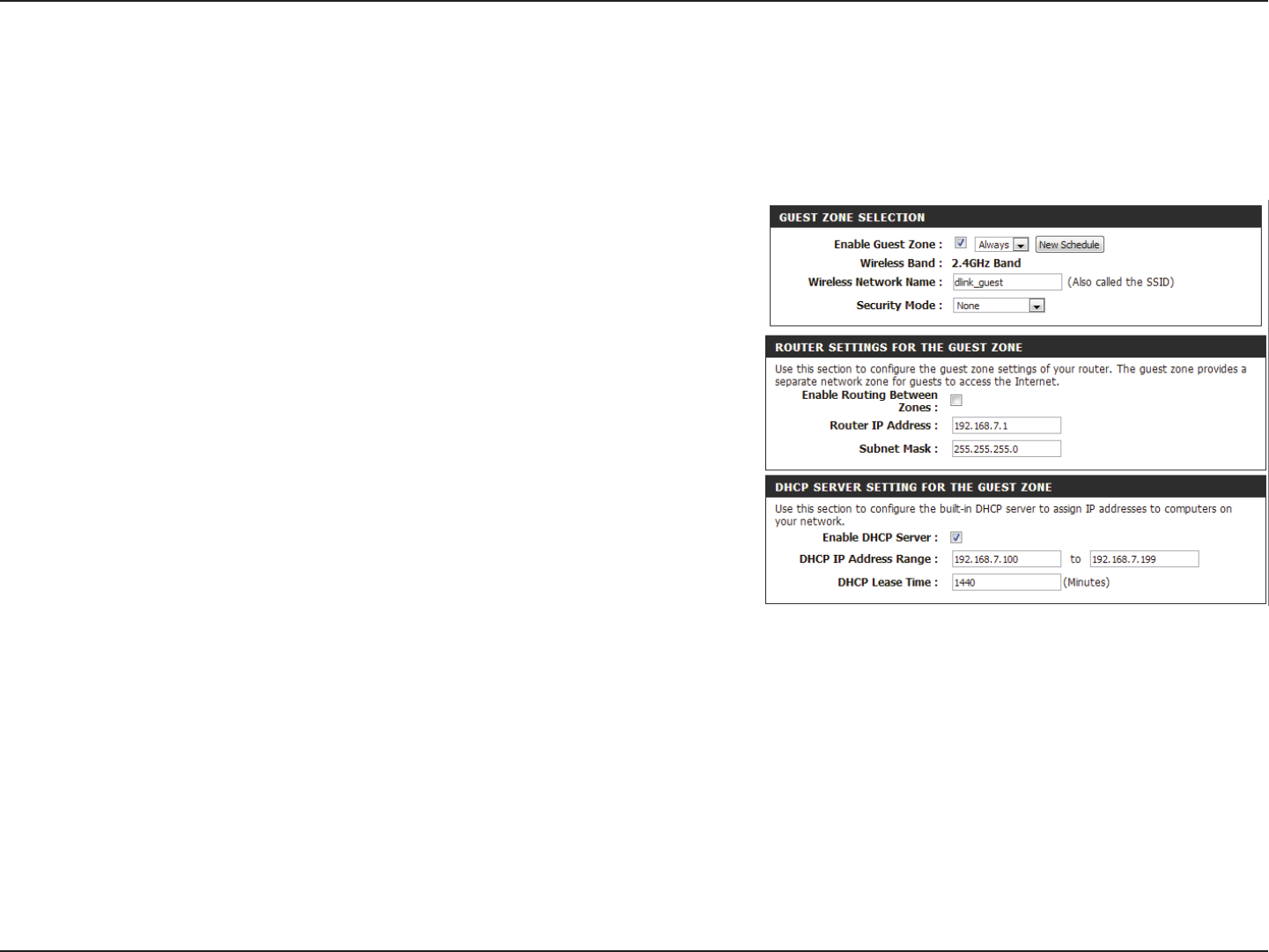
72D-Link DIR-655 User Manual
Section 3 - Conguration
Guest Zone
Check to enable the Guest Zone feature.
The schedule of time when the Guest Zone will be active. The schedule
may be set to Always, which will allow the particular service to always be
enabled. You can create your own times in the Tools > Schedules section
or click Add New.
Enter a wireless network name (SSID) that is dierent from your main
wireless network.
Check to allow network connectivity between the dierent zones created.
Select the type of security or encryption you would like to enable for the
Guest Zone.
Enable Guest Zone:
Schedule:
Wireless Network
Name:
Enable Routing
Between Zones:
Security Mode:
The Guest Zone feature will allow you to create temporary zones that can be used by guests to access the Internet. These zones will be separate
from your main wireless network.
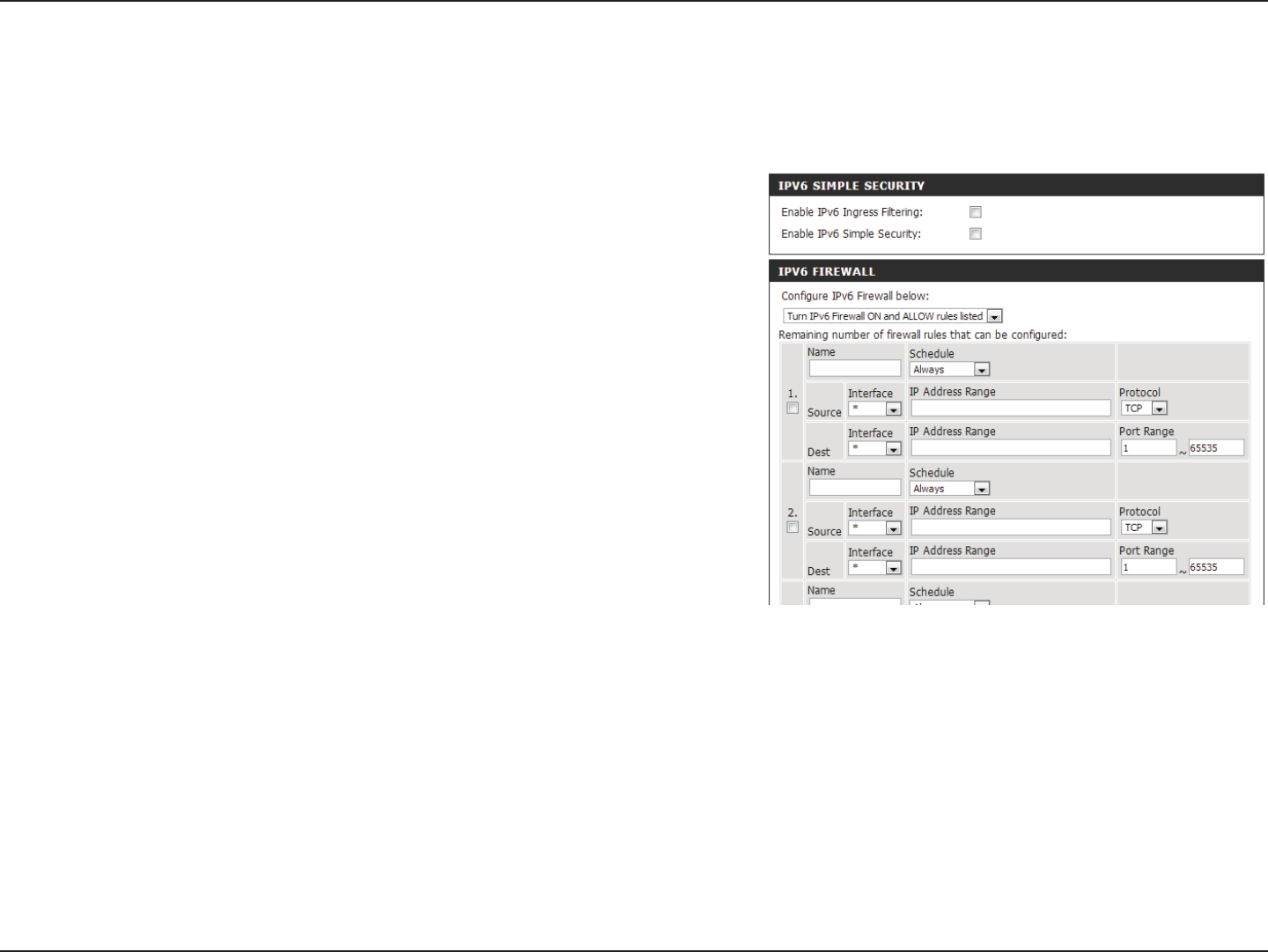
73D-Link DIR-655 User Manual
Section 3 - Conguration
IPv6 Firewall
The DIR-655’s IPv6 Firewall feature allows you to congure which kind of IPv6 trac is allowed to pass through the device. The DIR-655’s IPv6 Firewall
functions in a similar way to the Inbound Filters feature.
Check to enable the IPv6 rewall simple security.
Check to enable IPv6 ingress lter.
Select an action from the drop-down menu.
Enter a name to identify the IPv6 Firewall Rule.
Use the drop-down menu to select the time schedule that the IPv6 Firewall
Rule will be enabled on. The schedule may be set to Always, which will allow
the particular service to always be enabled. You can create your own times
in the Tools > Schedules section.
Use the Source drop-down menu to specify the interface that connects to
the source IPv6 addresses of the rewall rule.
Enter the source IPv6 address range in the adjacent IP Address Range eld.
Use the Dest drop-down menu to specify the interface that connects to the
destination IP addresses of the rewall rule.
Select the protocol of the rewall port (All, TCP, UDP or ICMP).
Enter the rst port of the range that will be used for the rewall rule in the
rst box and enter the last port in the eld in the second box.
Enable IPv6 Simple
Security:
Enable IPv6 Ingress
Filtering:
Congure IPv6
Firewall:
Name:
Schedule:
Source:
IP Address Range:
Dest:
Protocol:
Port Range:
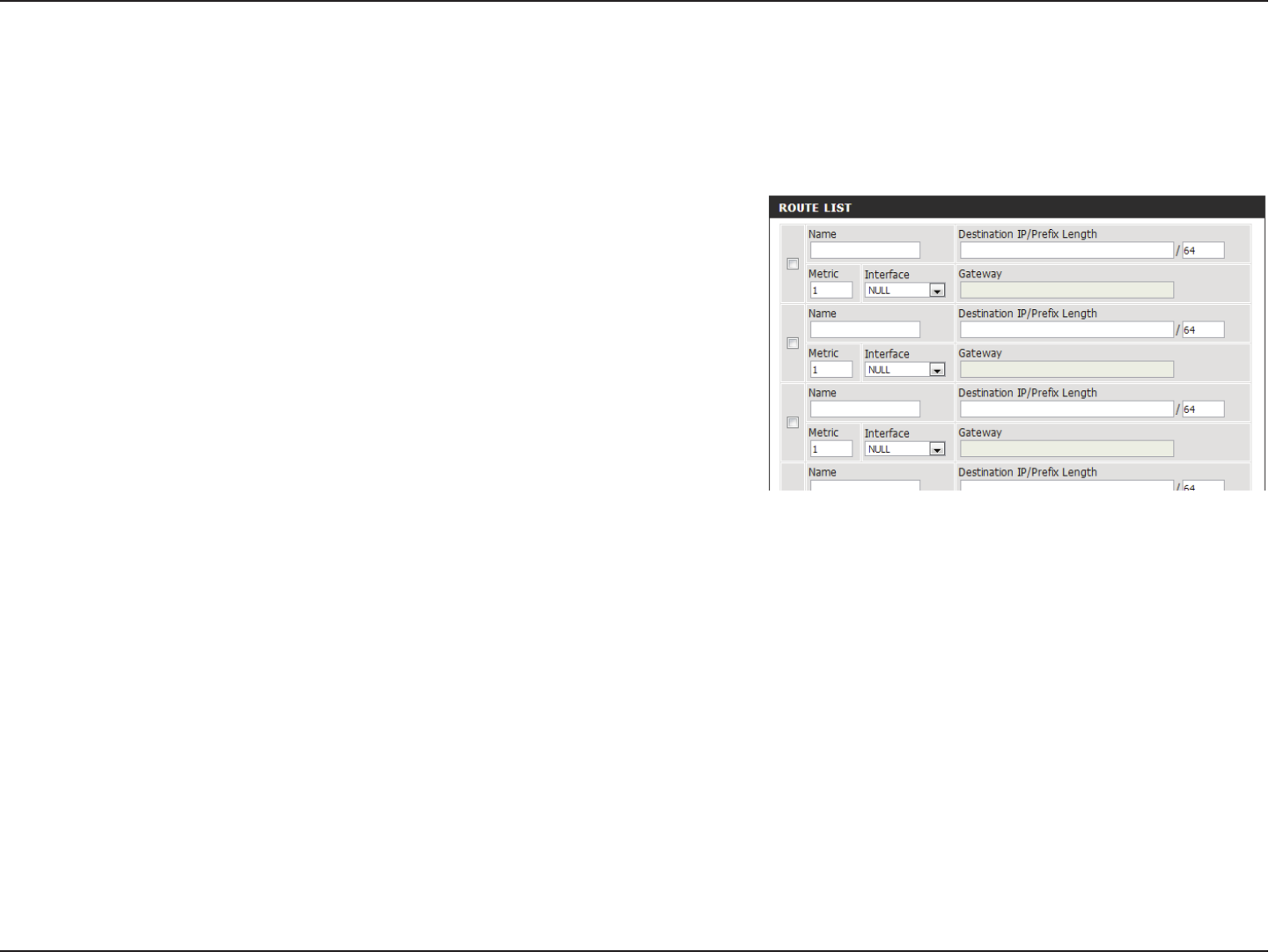
74D-Link DIR-655 User Manual
Section 3 - Conguration
IPv6 Routing
Check the box next to the route you wish to enable.
Enter a specic name to identify this route.
Enter the IP address of the router that will be used to reach the specied
destination or enter the IPv6 address prex length of the packets that will
take this route.
Enter the metric value for this rule here.
Use the drop-down menu to specify if the IP packet must use the WAN or
LAN interface to transit out of the router.
Enter the next hop that will be taken if this route is used.
Route List:
Name:
Destination IP/Prex
Length:
Metric:
Interface:
Gateway:
The IPv6 Routing section allows you to specify custom routes that determine how data is moved around your network.
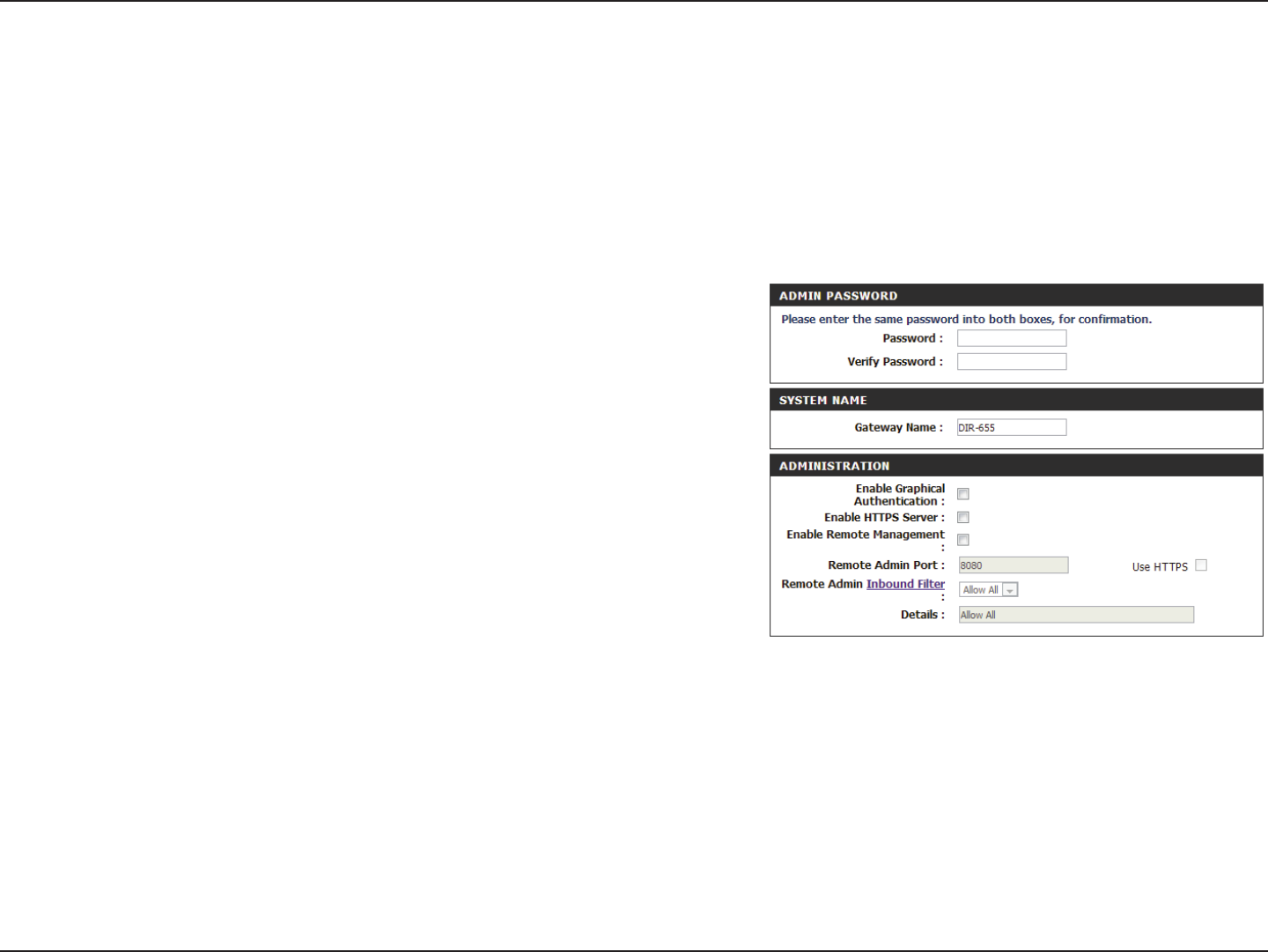
75D-Link DIR-655 User Manual
Section 3 - Conguration
Admin
Tools will allow you to change the Administrator and User passwords. You can also enable Remote Management. There are two accounts that can
access the management interface through the web browser: admin and user. Admin has read/write access, while user has read-only access. User can
only view the settings but cannot make any changes. Only the admin account has the ability to change both admin and user account passwords.
Tools
Enter a new password for the Administrator Login Name. The Administrator
can make changes to the settings.
Enter the new password for the User Login. If you login as the User, you cannot
change the settings (you can only view them).
Enter a name for your router.
Enables a challenge-response test to require users to type letters or numbers
from a distorted image displayed on the screen to prevent online hackers and
unauthorized users from gaining access to your router’s network settings.
Check to enable HTTPS to connect to the router securely. This means to connect
to the router you must enter https://192.168.0.1 (for example) instead of
http://192.168.0.1.
Remote Management allows the DIR-655 to be congured from the Internet
by a web browser. A username/password is still required to access the Web
Management interface.
The port number used to access the DIR-655 is used in the URL. Example:
http://x.x.x.x:8080 whereas x.x.x.x is the Internet IP address of the DIR-655
and 8080 is the port used for the Web Management interface.
If you have enabled HTTPS Server, you must enter https:// as part of the URL
to access the router remotely.
This section will list any rules that are created. You may click the Edit icon to
change the settings or enable/disable the rule, or click the Delete icon to
remove the rule. Details will display the current status.
Admin Password:
User Password:
System Name:
Enable Graphical
Authentication:
Enable HTTPS
Server:
Enable Remote
Management:
Remote Admin Port:
Remote Admin
Inbound Filter:
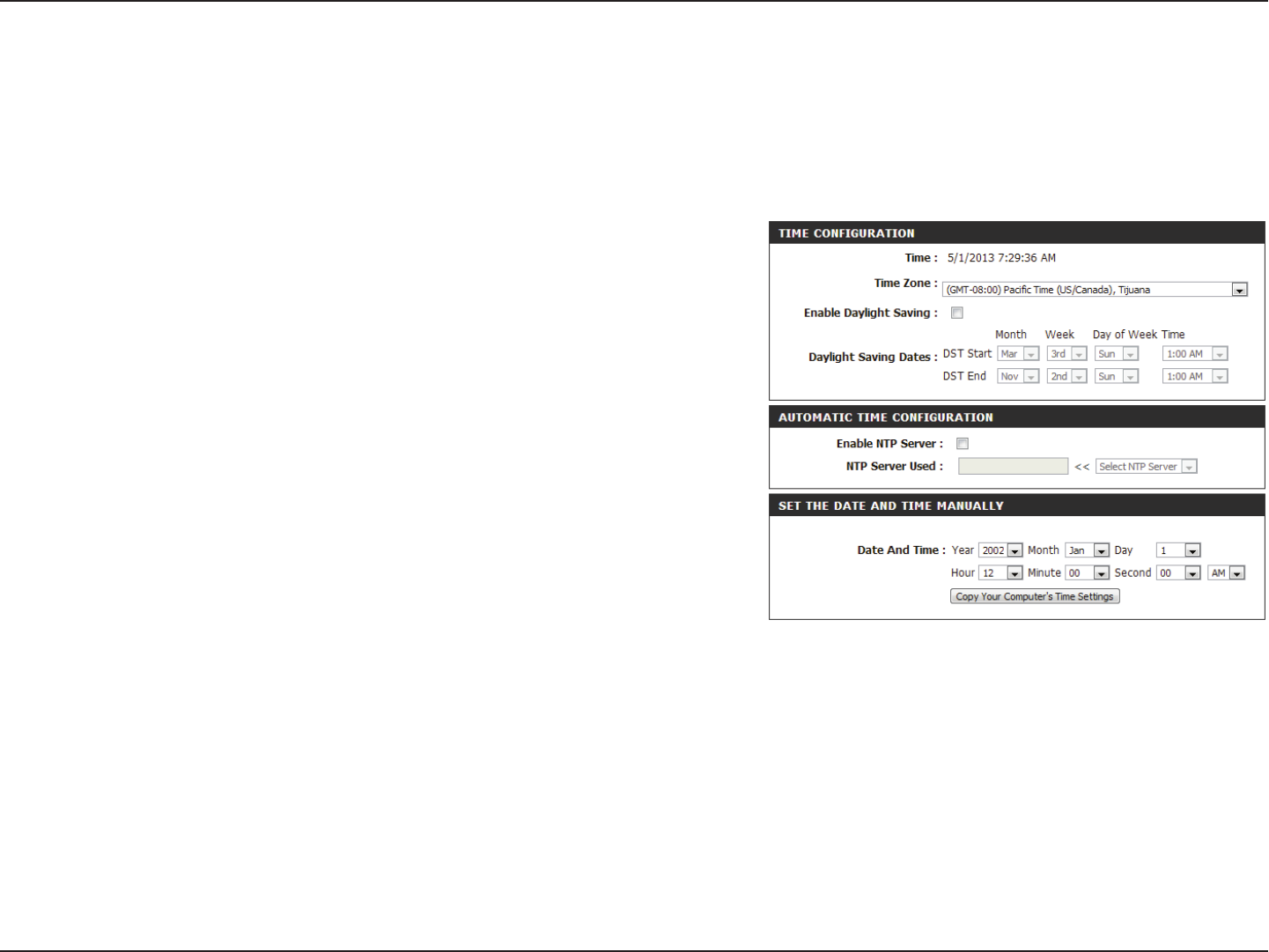
76D-Link DIR-655 User Manual
Section 3 - Conguration
Time
Displays the current date and time of the router.
Select your Time Zone from the drop-down menu.
To enable Daylight Saving time manually, check the box
and enter a start date and an end date for daylight saving
time.
NTP is short for Network Time Protocol. A NTP server will
sync the time and date with your router. This will only
connect to a server on the Internet, not a local server. Check
the box to enable this feature.
Enter the IP address of a NTP server or select one from the
drop-down menu.
To manually input the time, enter the values in these elds
for the Year, Month, Day, Hour, Minute and Second and
then click Set Time.
You can also click Copy Your Computer’s Time Settings
to synch the date and time with the computer you are
currently on.
Time:
Time Zone:
Enable Daylight
Saving:
Enable NTP Server:
NTP Server Used:
Manual:
The Time Conguration section allows you to congure, update and maintain the correct time on the internal system clock. From this section you
can set the time zone that you are in and set the Time Server. Daylight Saving can also be congured to automatically adjust the time when needed.
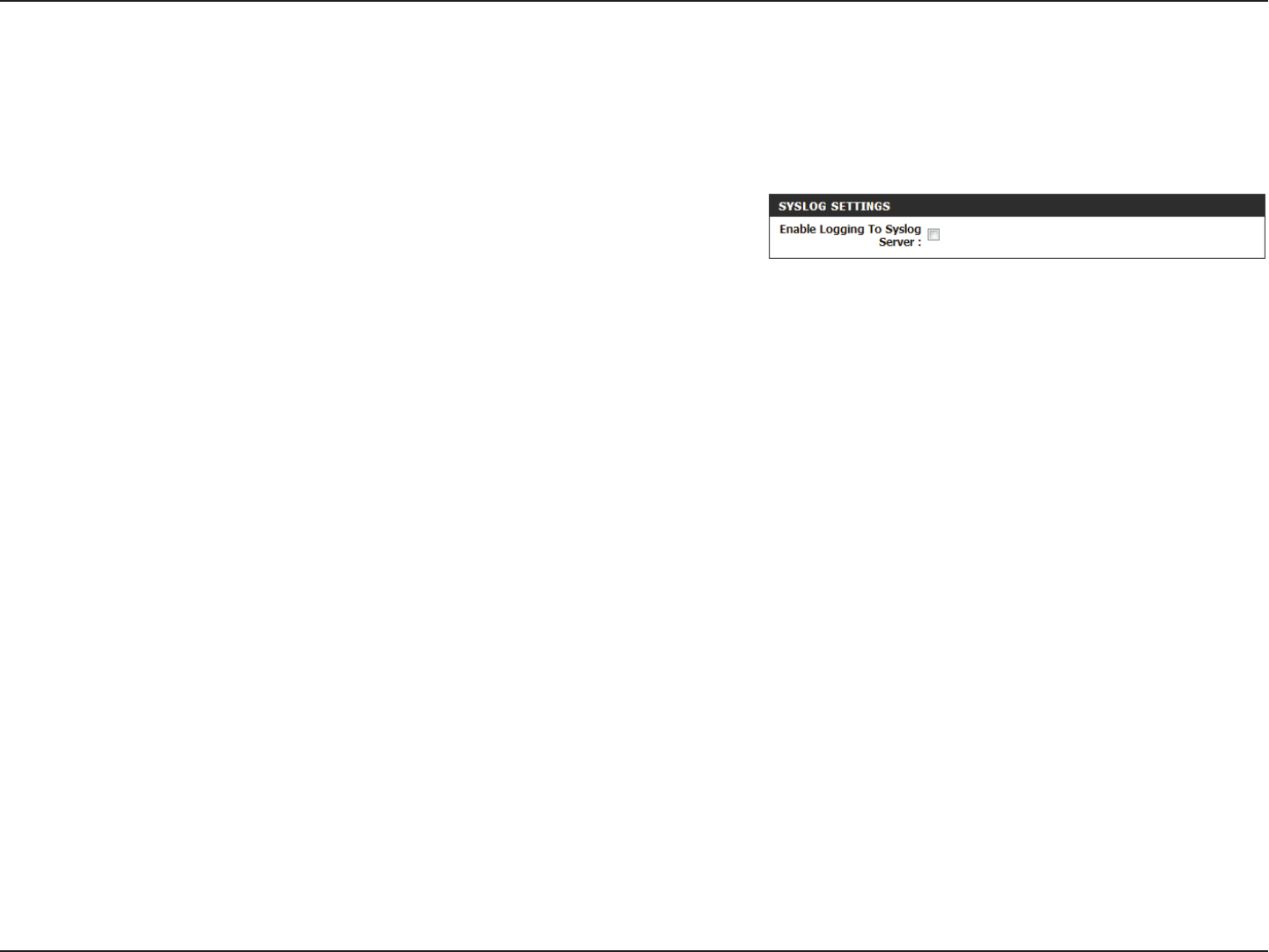
77D-Link DIR-655 User Manual
Section 3 - Conguration
SysLog
The DIR-655 keeps a running log of events and activities occurring. You may send these logs to a SysLog server on your network.
Enable Logging to
SysLog Server:
SysLog Server IP
Address:
Check this box to send the router logs to a SysLog server.
The address of the SysLog server that will be used to send the logs. You may
also select your computer from the drop-down menu (only if receiving an
IP address from the router via DHCP).
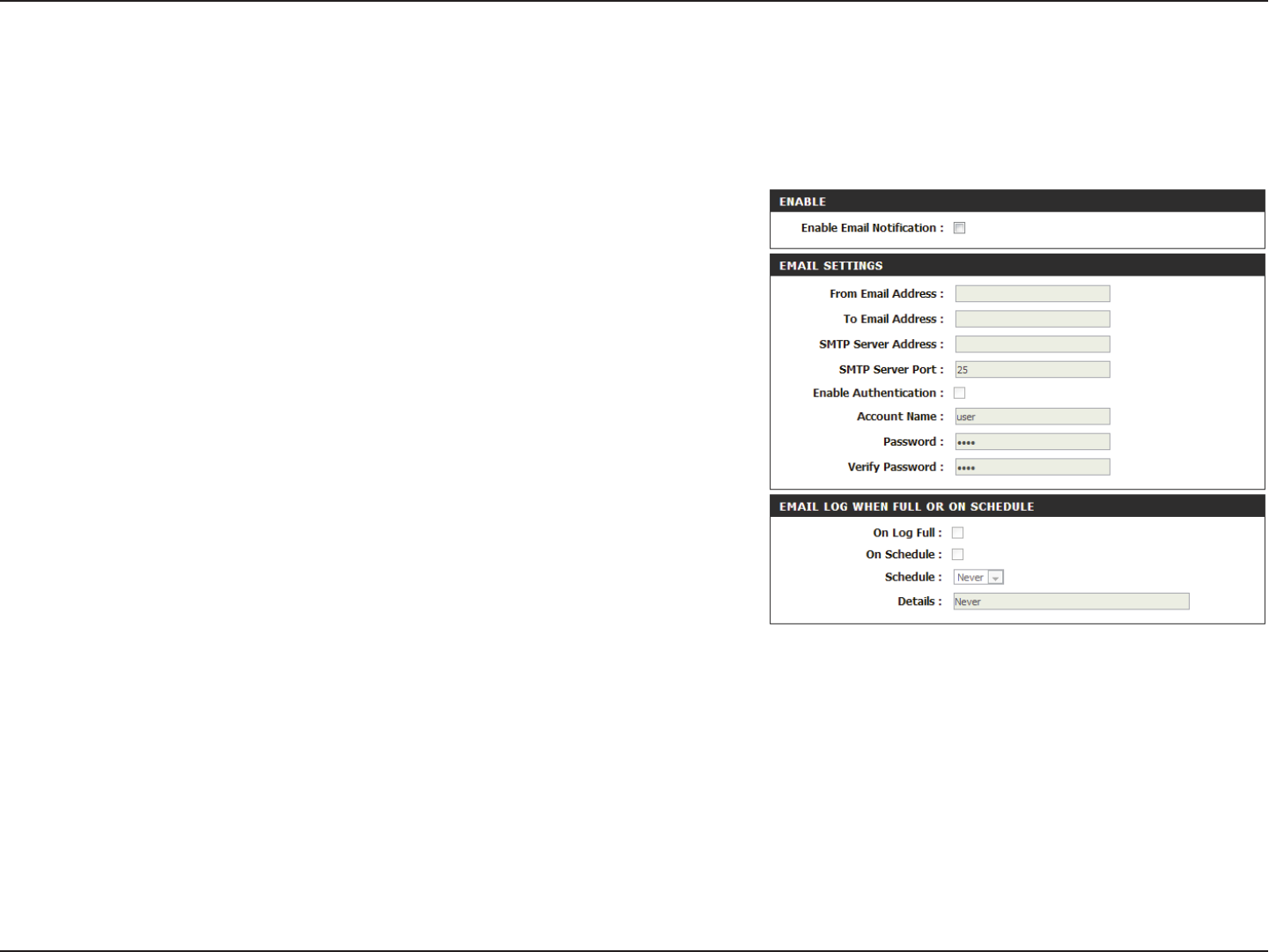
78D-Link DIR-655 User Manual
Section 3 - Conguration
E-mail Settings
The E-mail Settings feature can be used to send the system log les, router alert messages, and rmware update notication to your e-mail address.
Enable E-mail
Notication:
From E-mail Address:
To E-mail Address:
SMTP Server Address:
SMTP Server Port:
Enable Authentication:
Account Name:
Password:
On Log Full:
On Schedule:
Schedule:
When this option is enabled, router activity logs are e-mailed to a
designated e-mail address.
This e-mail address will appear as the sender when you receive a log le or
rmware upgrade notication via e-mail.
Enter the e-mail address where you want the e-mail sent.
Enter the SMTP server address for sending e-mail.
Enter the SMTP port used on the server.
Check this box if your SMTP server requires authentication.
Enter your account for sending e-mail.
Enter the password associated with the account. Re-type the password
associated with the account.
When this option is selected, logs will be sent via e-mail to your account
when the log is full.
Selecting this option will send the logs via e-mail according to schedule.
This option is enabled when On Schedule is selected. You can select a
schedule from the list of dened schedules. To create a schedule, go to
Tools > Schedules.
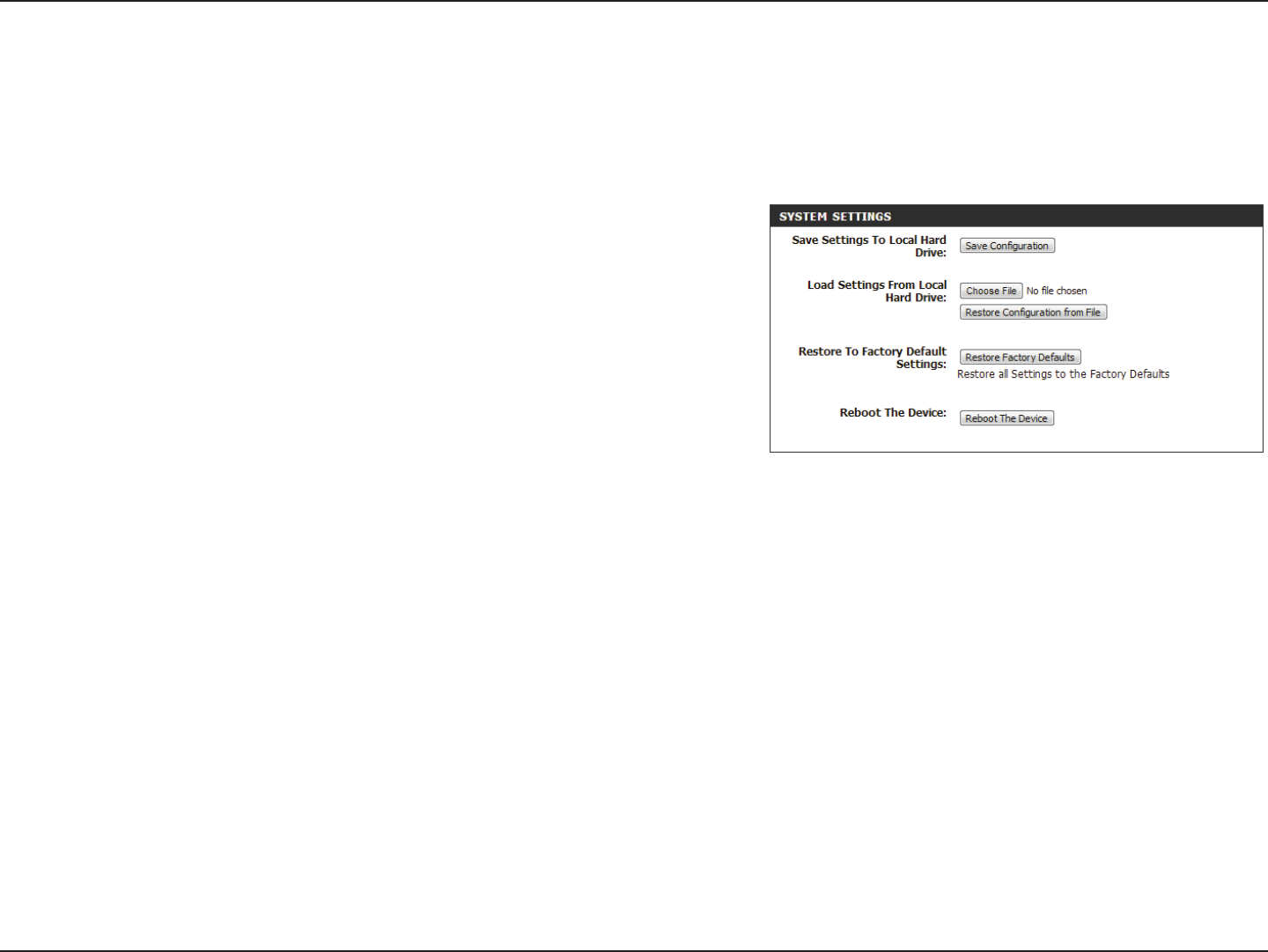
79D-Link DIR-655 User Manual
Section 3 - Conguration
Use this option to save the current router conguration settings to a le on the
hard disk of the computer you are using. First, click the Save button. A le dialog
will appear, allowing you to select a location and le name for the settings.
Use this option to load previously saved router conguration settings. First,
use the Browse option to nd a previously saved le of conguration settings.
Then, click the Load button to transfer those settings to the router.
This option will restore all conguration settings back to the settings that were
in eect at the time the router was shipped from the factory. Any settings that
have not been saved will be lost, including any rules that you have created.
If you want to save the current router conguration settings, use the Save
button above.
Click to reboot the router.
Save Settings to
Local Hard Drive:
Load Settings from
Local Hard Drive:
Restore to Factory
Default Settings:
Reboot Device:
System
The System Settings section allows you to manage the router’s conguration settings, reboot the router, and restore the router to the factory default
settings. Restoring the unit to the factory default settings will erase all settings, including any rules that you’ve created.
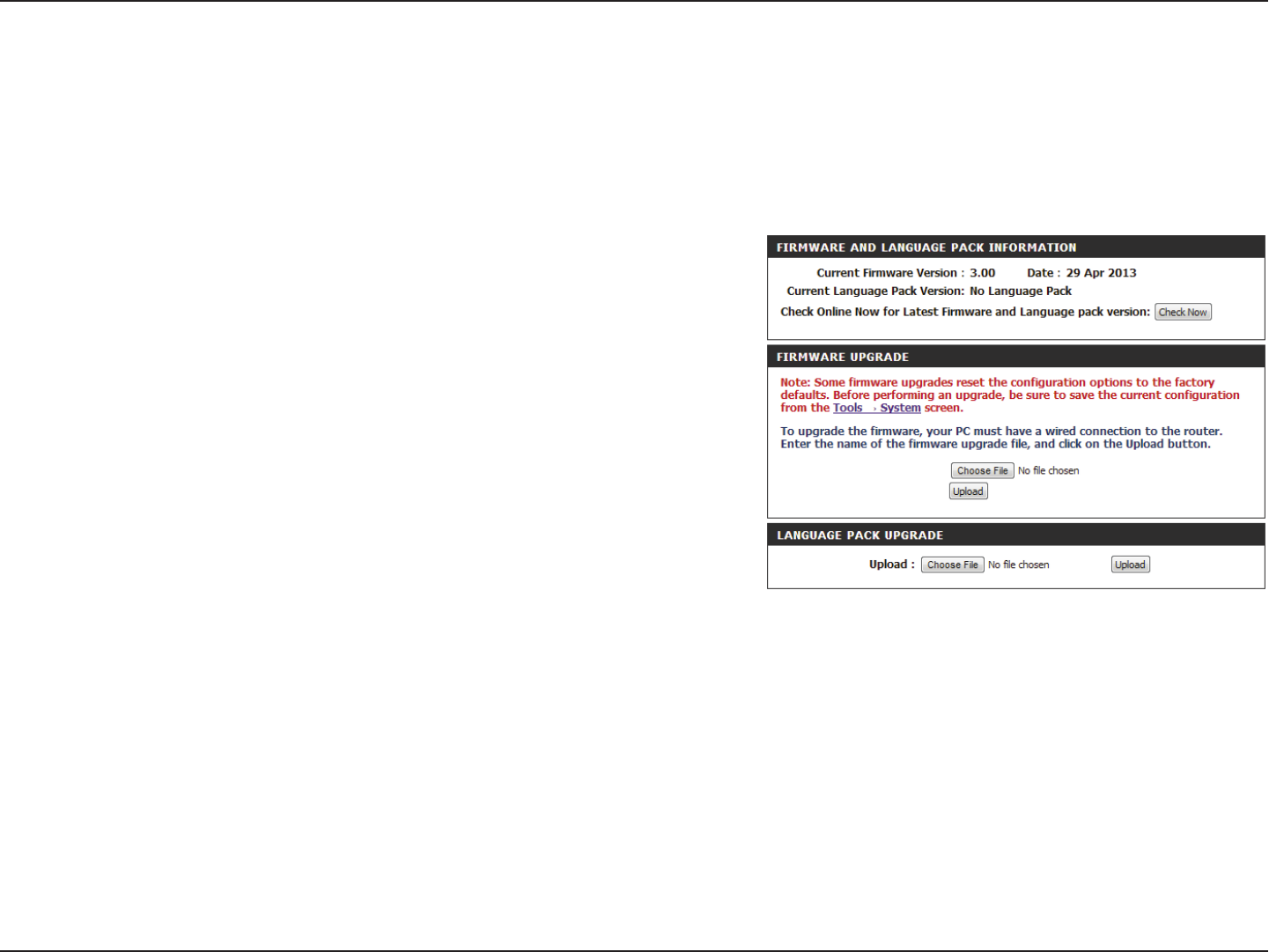
80D-Link DIR-655 User Manual
Section 3 - Conguration
Firmware
Browse:
Upload:
After you have downloaded the new rmware, click Browse to locate the
rmware update on your hard drive. Click Upload to complete the rmware
upgrade.
Once you have a rmware update on your computer, use this option to browse
for the le and then upload the information into the router.
The Firmware Update section allows you to upgrade the rmware of the DIR-655. Make sure the rmware you want to use is on the local hard drive of
the computer. Click on Browse to locate the rmware le to be used for the update. Please check the D-Link support website for rmware updates
at http://support.dlink.com. You can download rmware upgrades to your hard drive from this site.
After you have downloaded the new language pack, click Choose File to
locate the language pack le on your hard drive. Click Upload to complete
the language pack upgrade.
You can change the language of the web UI by uploading available language
packs.
Choose File:
Language Pack
Upgrade:
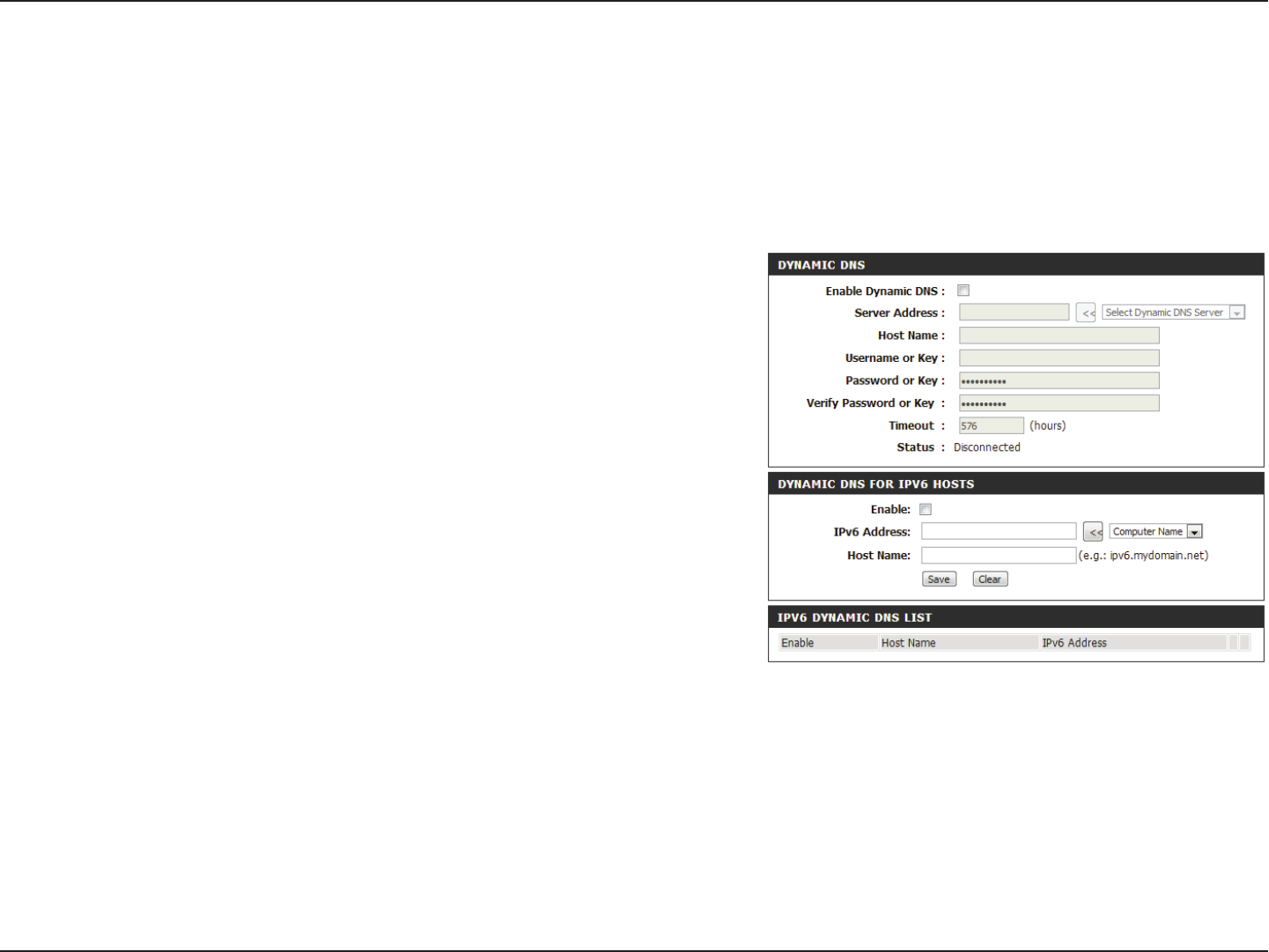
81D-Link DIR-655 User Manual
Section 3 - Conguration
Dynamic Domain Name System is a method of keeping a domain name
linked to a changing IP address. Check the box to enable DDNS.
Select your DDNS provider from the drop-down menu or enter the DDNS
server address.
Enter the host name that you registered with your DDNS service provider.
Enter the username or key for your DDNS account.
Enter the password or key for your DDNS account.
Enter a timeout time (in hours).
Displays the current connection status.
Enable Dynamic
DNS:
Server Address:
Host Name:
Username or Key:
Password or Key:
Timeout:
Status:
Dynamic DNS
The Dynamic DNS feature allows you to host a server (web, FTP, game server, etc.) using a domain name that you have purchased (i.e. www.
whateveryournameis.com) with your dynamically assigned IP address. Most broadband Internet service providers assign dynamic (changing) IP
addresses. Using a DDNS service provider, your friends can enter in your domain name to connect to your server no matter what your IP address is.
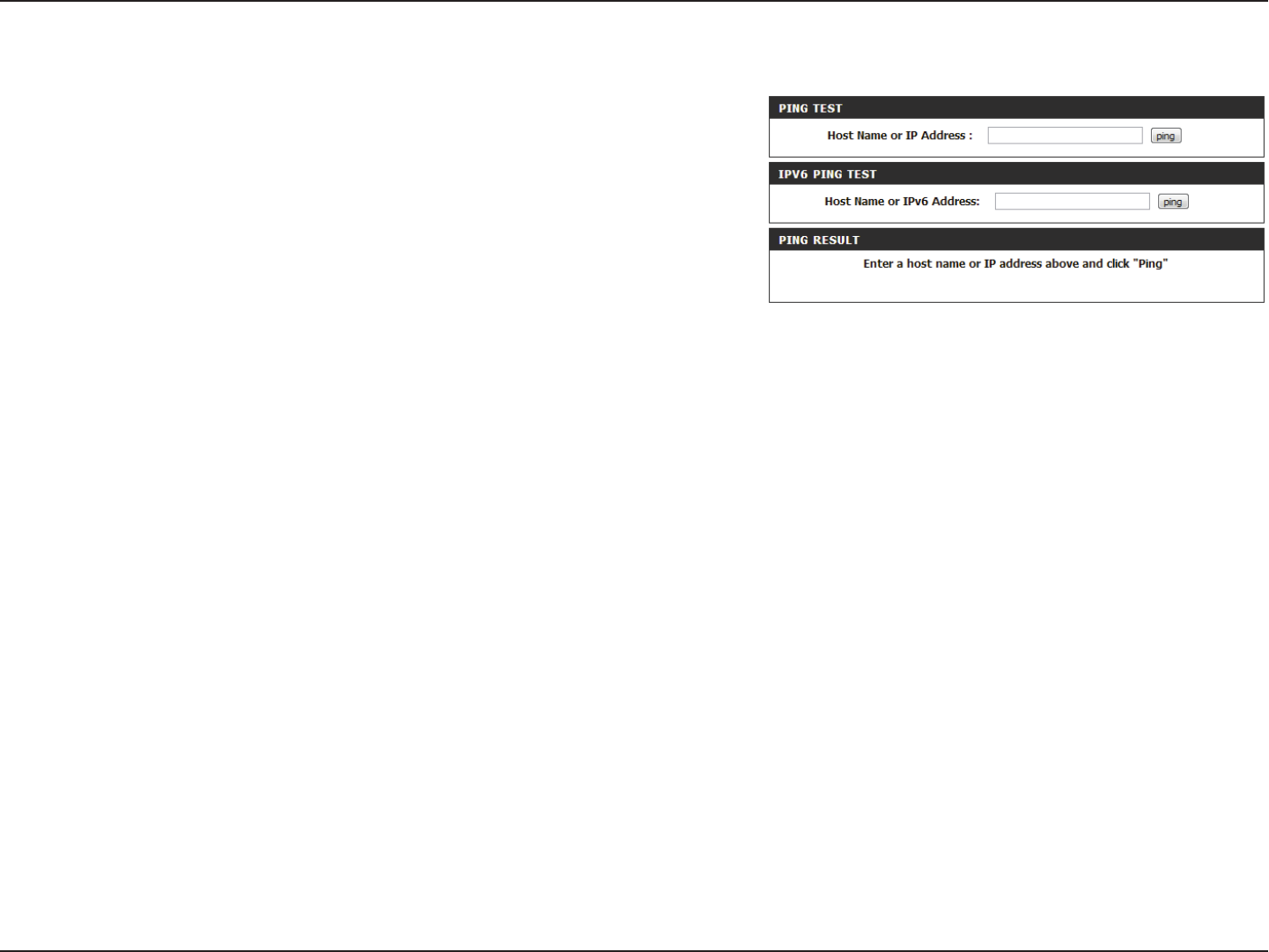
82D-Link DIR-655 User Manual
Section 3 - Conguration
The Ping Test is used to send ping packets to test if a computer is on the
Internet. Enter the IP address that you wish to test and click Ping.
Enter the IPv6 address that you wish to ping and click Ping.
The results of your ping attempts will be displayed here.
System Check
Ping Test:
IPv6 Ping Test:
Ping Results:
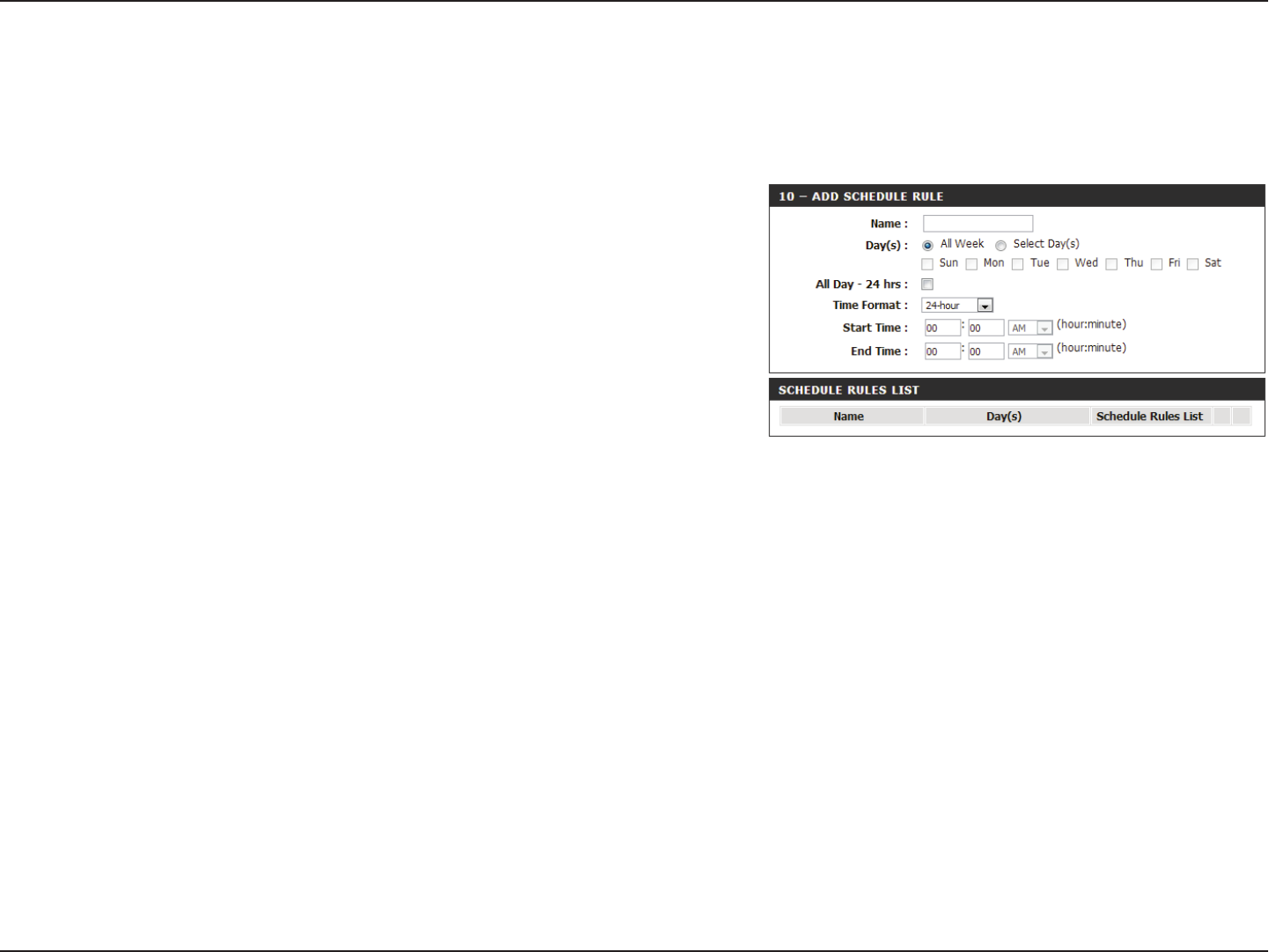
83D-Link DIR-655 User Manual
Section 3 - Conguration
Enter a name for your new schedule.
Select a day, a range of days, or All Week to include every day.
Check All Day - 24hrs or enter a start and end time for your schedule.
You must click Save Settings at the top for your schedules to go into eect.
The list of schedules will be listed here. Click the Edit icon to make changes
or click the Delete icon to remove the schedule.
Name:
Days:
Time:
Save:
Schedule Rules List:
Schedules
Schedules can be created for use with enforcing rules. For example, if you want to restrict web access to Mon-Fri from 3 p.m. to 8 p.m., you could
create a schedule selecting Mon, Tue, Wed, Thu, and Fri and enter a Start Time of 3 p.m. and End Time of 8 p.m.
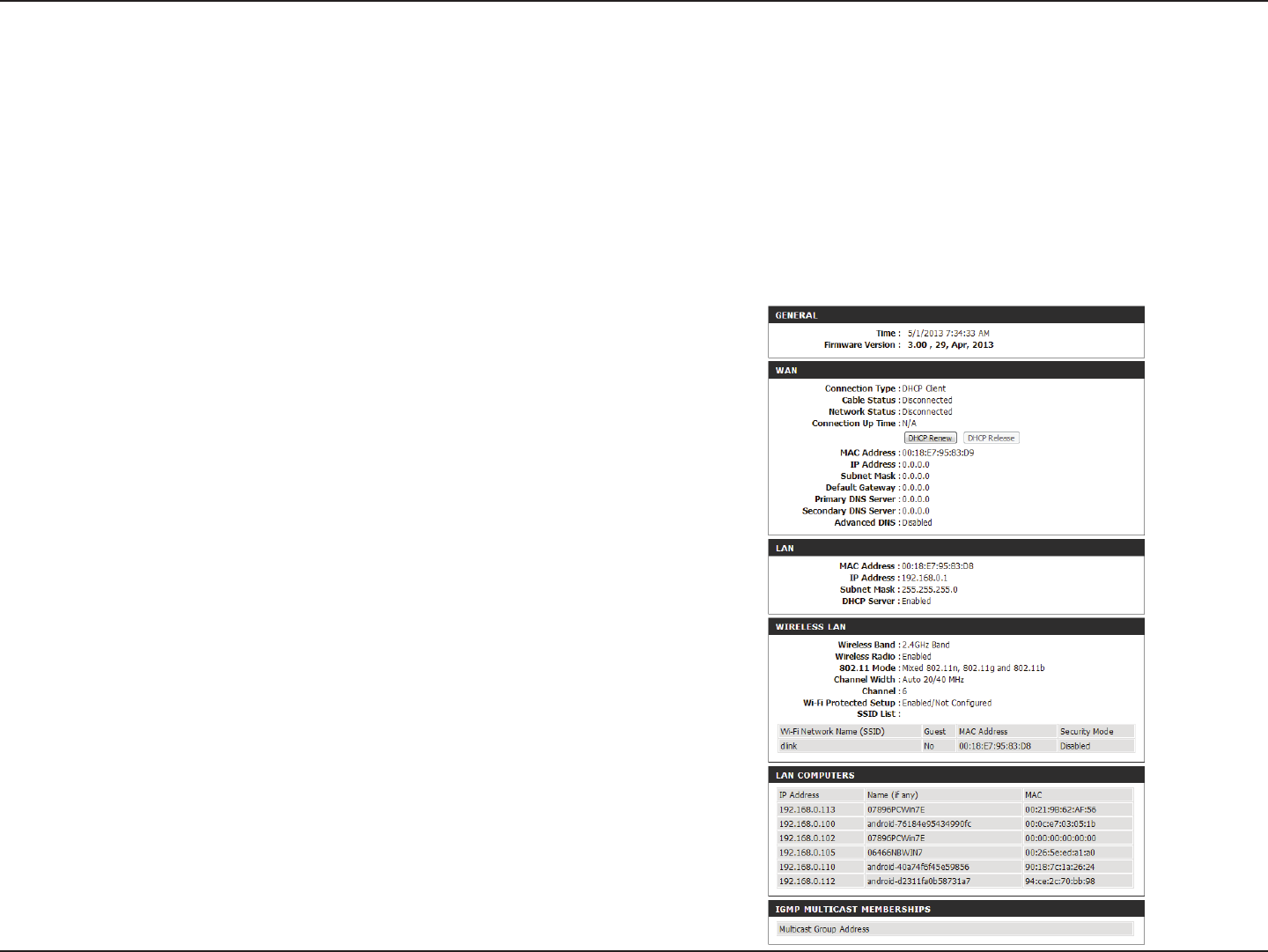
84D-Link DIR-655 User Manual
Section 3 - Conguration
The Device Info page displays the current information for the DIR-655. It will display the LAN, WAN (Internet), and Wireless information. If your Internet
connection is set up for a Dynamic IP address then a Release button and a Renew button will be displayed. Use Release to disconnect from your
ISP and use Renew to connect to your ISP.
If your Internet connection is set up for PPPoE, a Connect button and a Disconnect button will be displayed. Use Disconnect to drop the PPPoE
connection and use Connect to establish the PPPoE connection.
Displays the router’s time and rmware version.
Displays the MAC address and the public IP settings
Displays the MAC address and the private (local) IP settings for the router.
Displays the 2.4GHz wireless MAC address and your wireless settings such
as SSID and Channel.
Displays computers and devices that are connected to the router via
Ethernet and that are receiving an IP address assigned by the router (DHCP).
General:
WAN:
LAN:
Wireless LAN1:
LAN Computers:
Device Info
Status
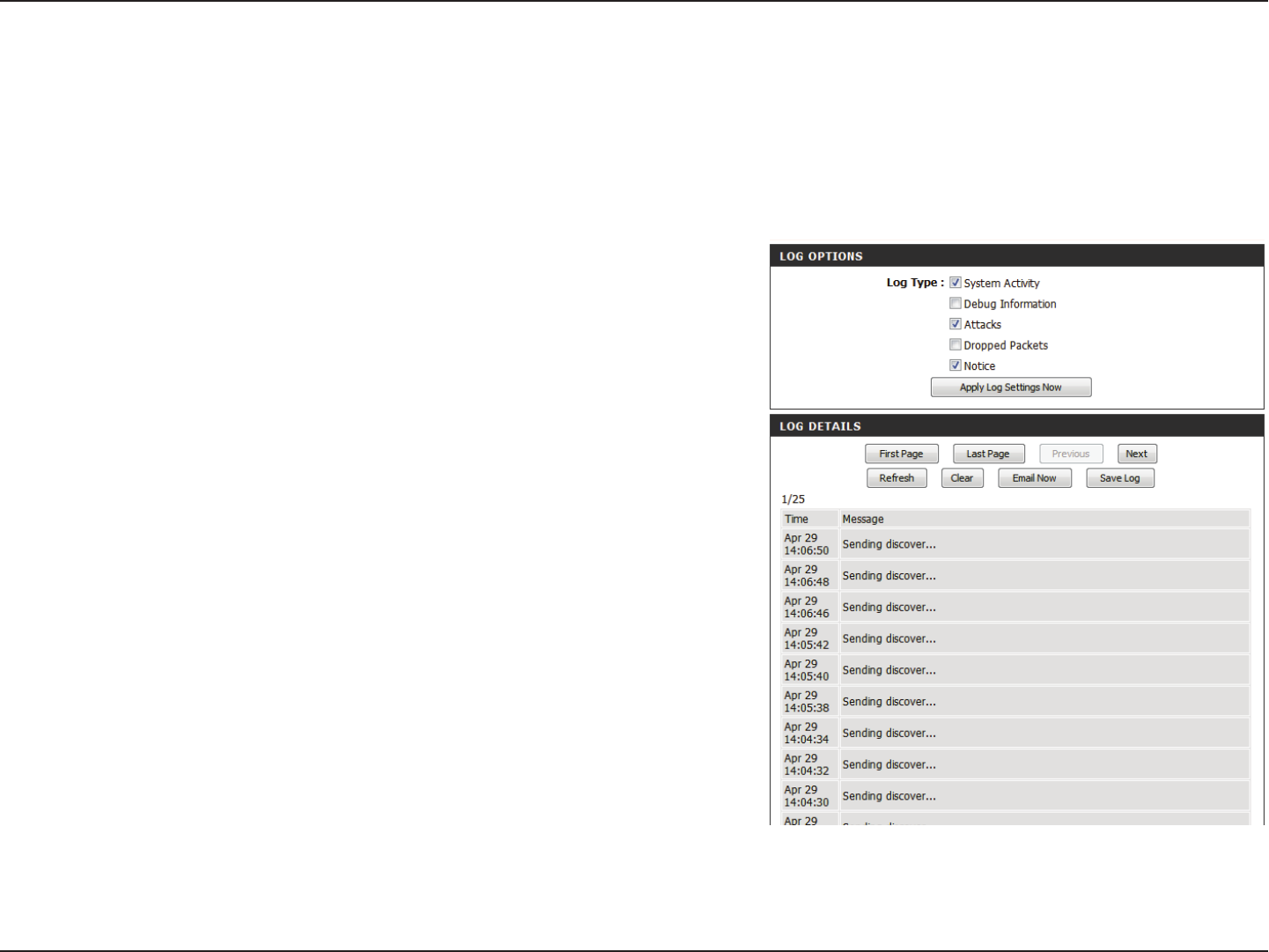
85D-Link DIR-655 User Manual
Section 3 - Conguration
Logs
Log Options:
Refresh:
First Page:
Last Page:
Previous:
Next:
Clear:
E-mail Now:
Save Log:
You can select the types of messages that you want to display from the
log. System Activity, Debug Information, Attacks, Dropped Packets,
and Notice messages can be selected. Click Apply Log Settings Now to
activate your settings.
Updates the log details on the screen so it displays any recent activity.
Click to go to the rst page.
Click to go to the last page.
Click to go back one page.
Click to go to the next page.
Clears all of the log contents.
This option will send a copy of the router log to your e-mail address
congured in the Tools > E-mail Settings screen.
This option will save the router log to a le on your computer.
The router automatically logs (records) events of possible interest in its internal memory. The Logs option allows you to view the router logs. If there
isn’t enough internal memory for all events, logs of older events are deleted, but logs of the latest events are retained. You can dene what types
of events you want to view and the level of the events to view. This router also has external Syslog Server support so you can send the log les to
a computer on your network that is running a Syslog utility.
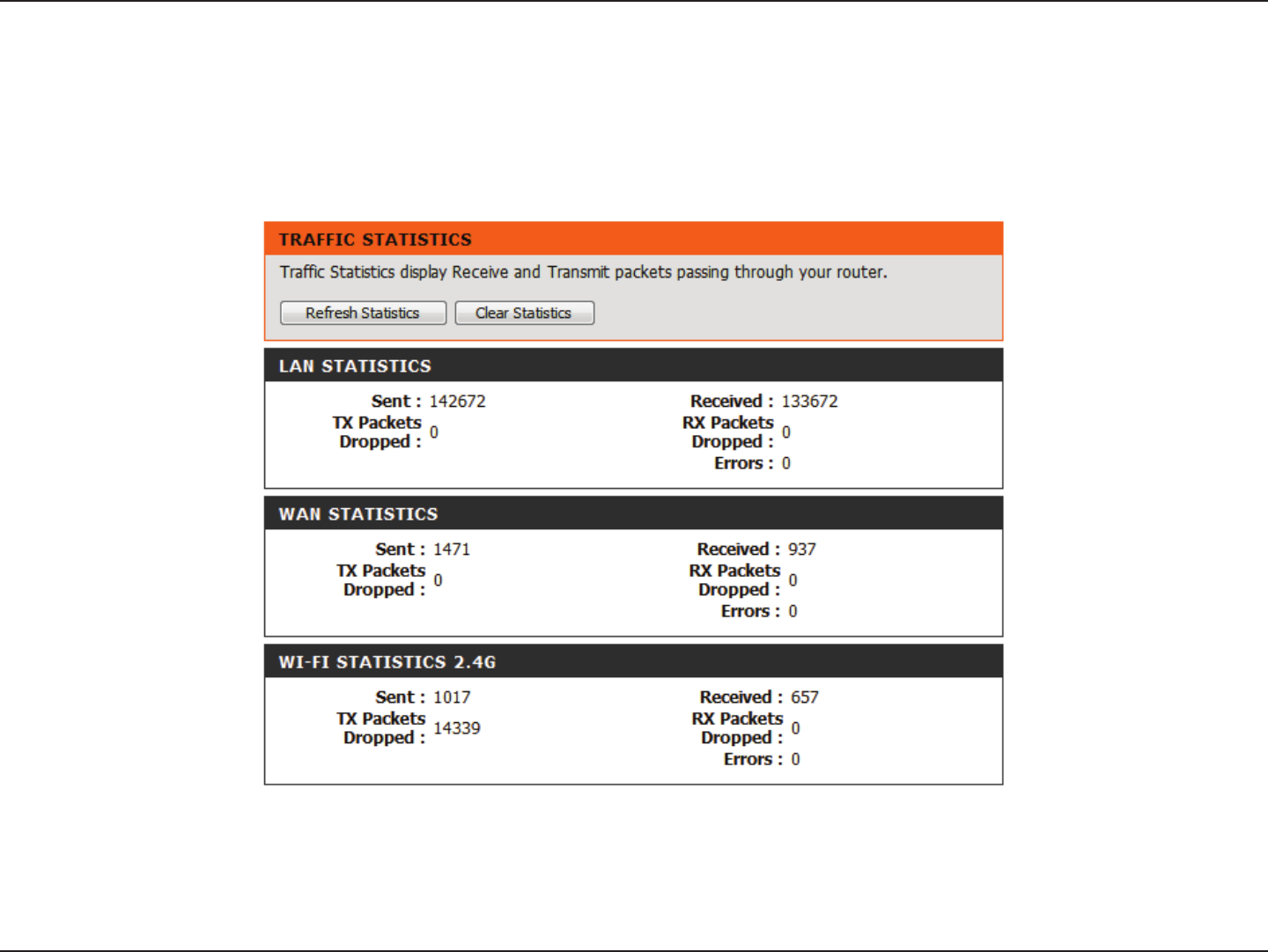
86D-Link DIR-655 User Manual
Section 3 - Conguration
Statistics
The screen below displays the Trac Statistics. Here you can view the amount of packets that pass through the DIR-655 on both the WAN, LAN ports and
the wireless segments. The trac counter will reset if the device is rebooted.
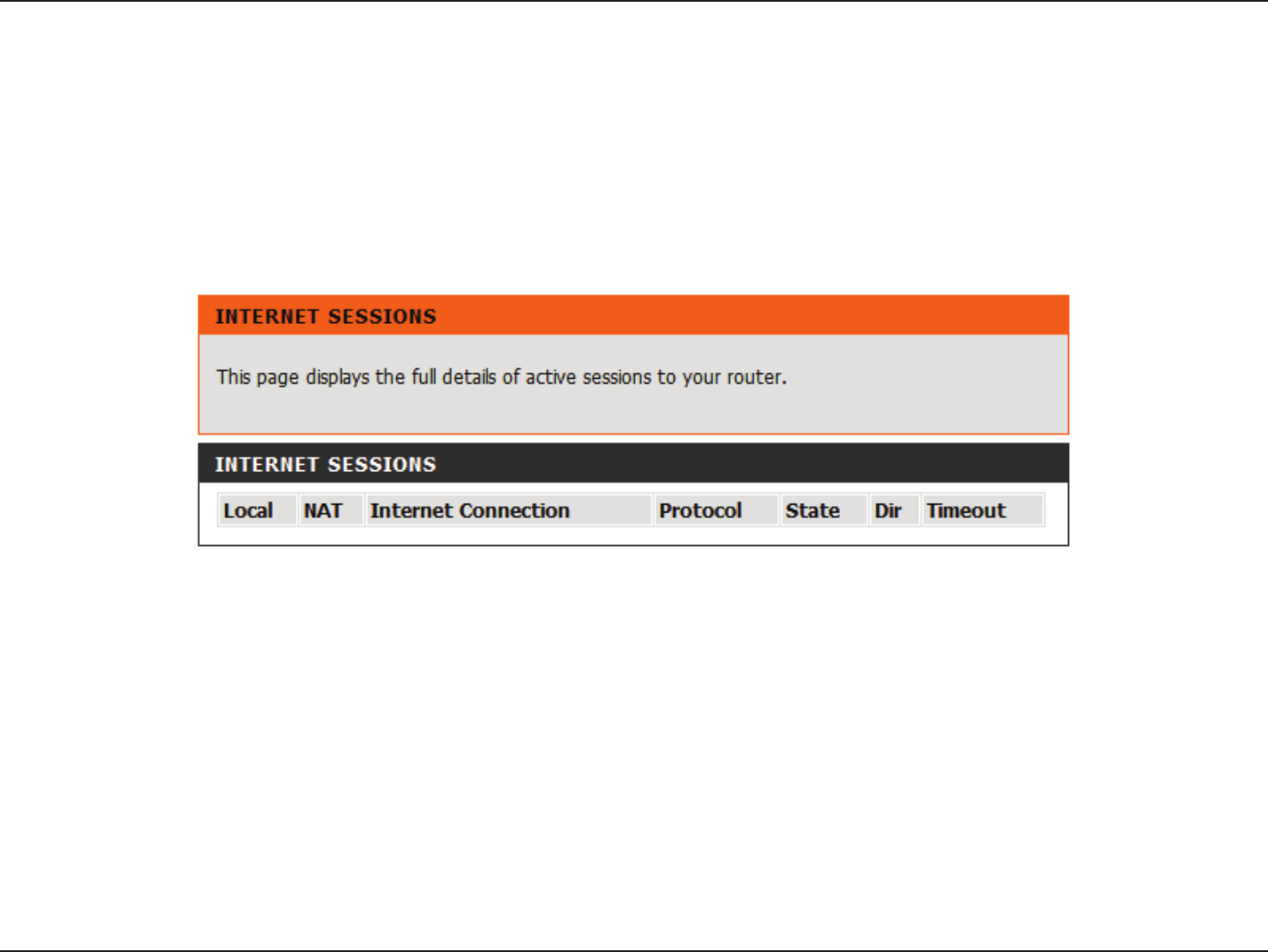
87D-Link DIR-655 User Manual
Section 3 - Conguration
Internet Sessions
The Internet Sessions page displays full details of active Internet sessions through your router. An Internet session is a conversation between a
program or application on a LAN-side computer and a program or application on a WAN-side computer.
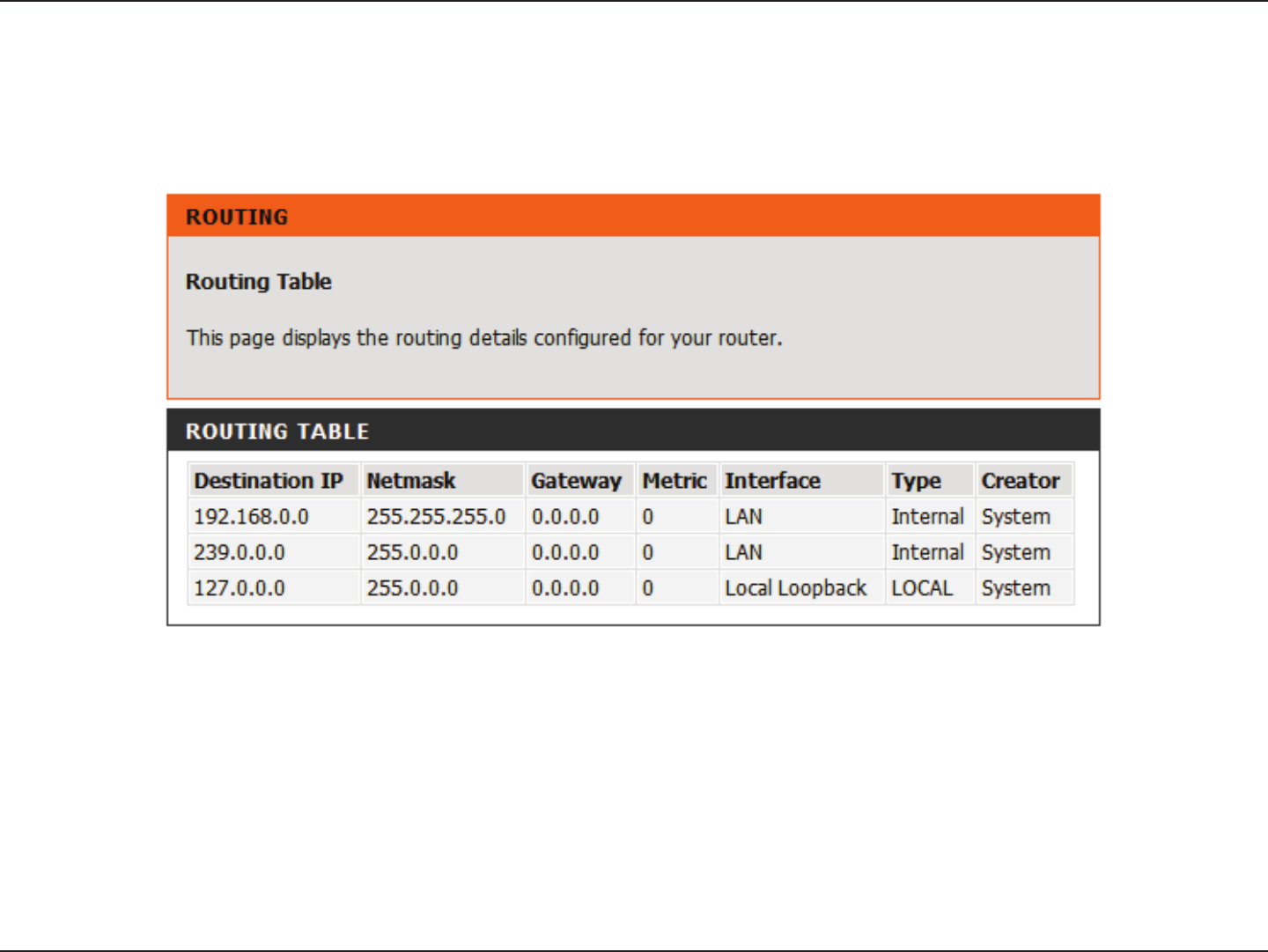
88D-Link DIR-655 User Manual
Section 3 - Conguration
Routing
This page will display your current routing table.
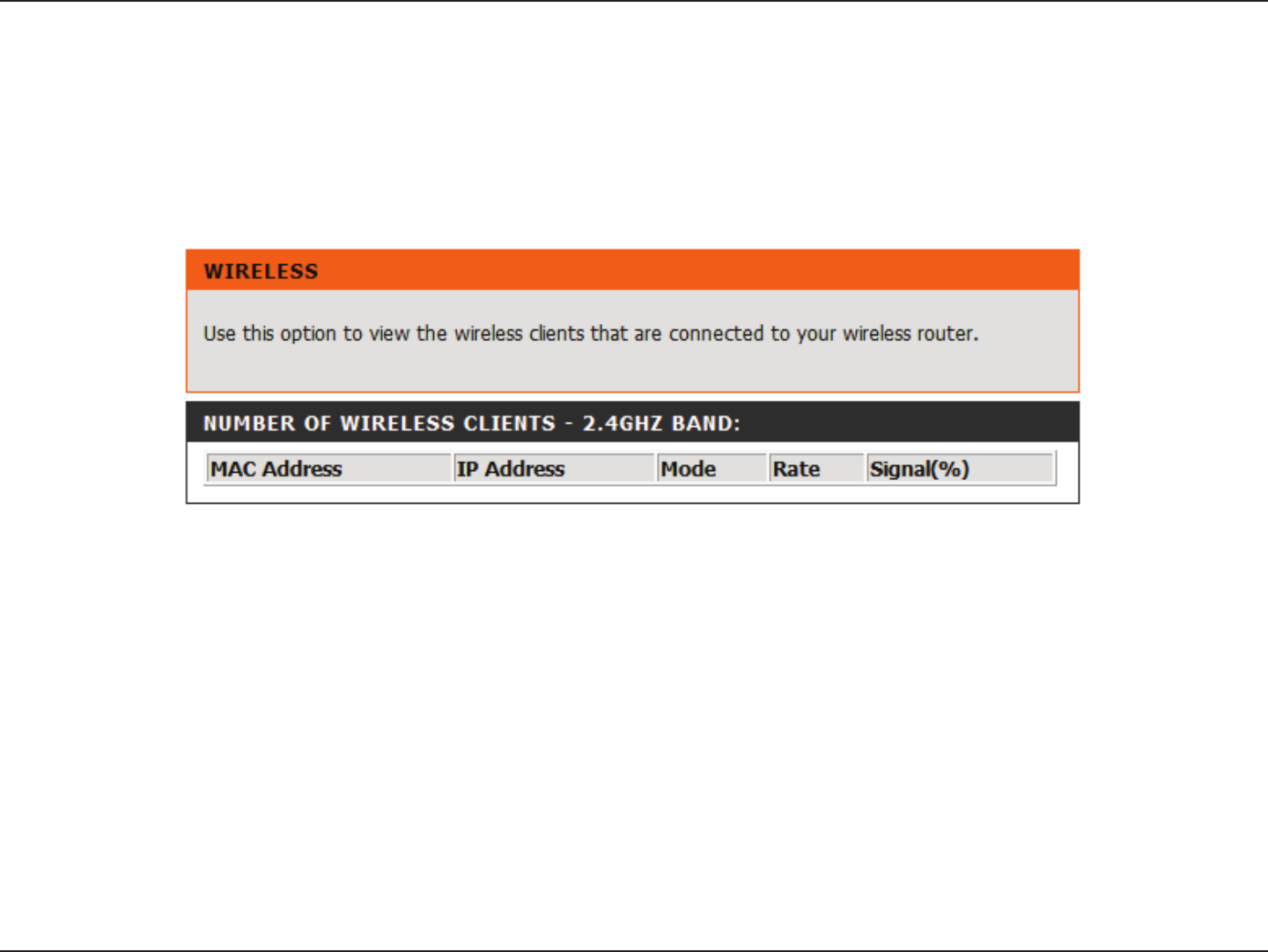
89D-Link DIR-655 User Manual
Section 3 - Conguration
The Wireless Client table displays a list of current connected wireless clients. This table also displays the connection time and MAC address of the
connected wireless clients.
Wireless
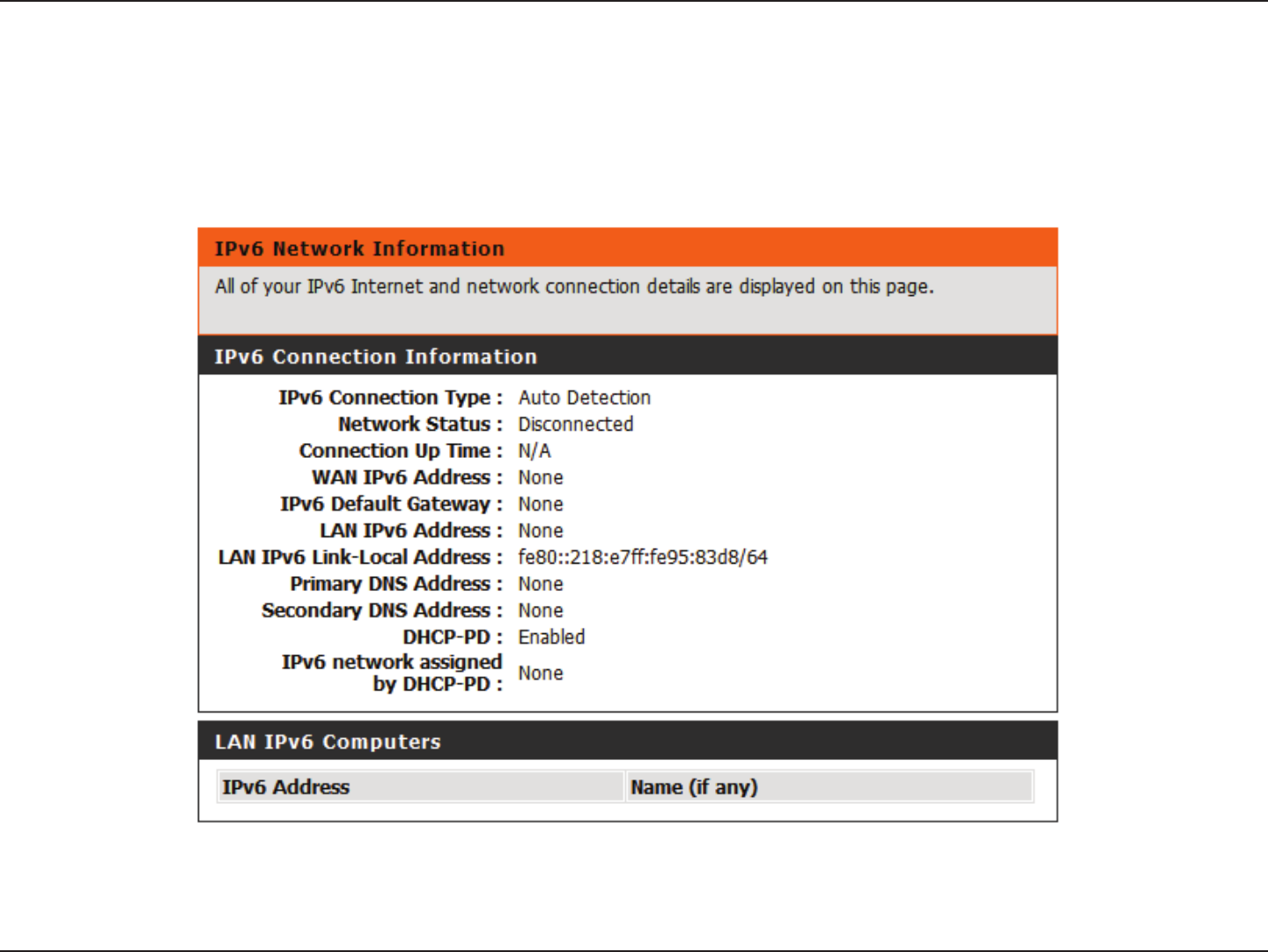
90D-Link DIR-655 User Manual
Section 3 - Conguration
IPv6
The IPv6 page displays a summary of the router’s IPv6 settings and lists the IPv6 address and host name of any IPv6 clients.
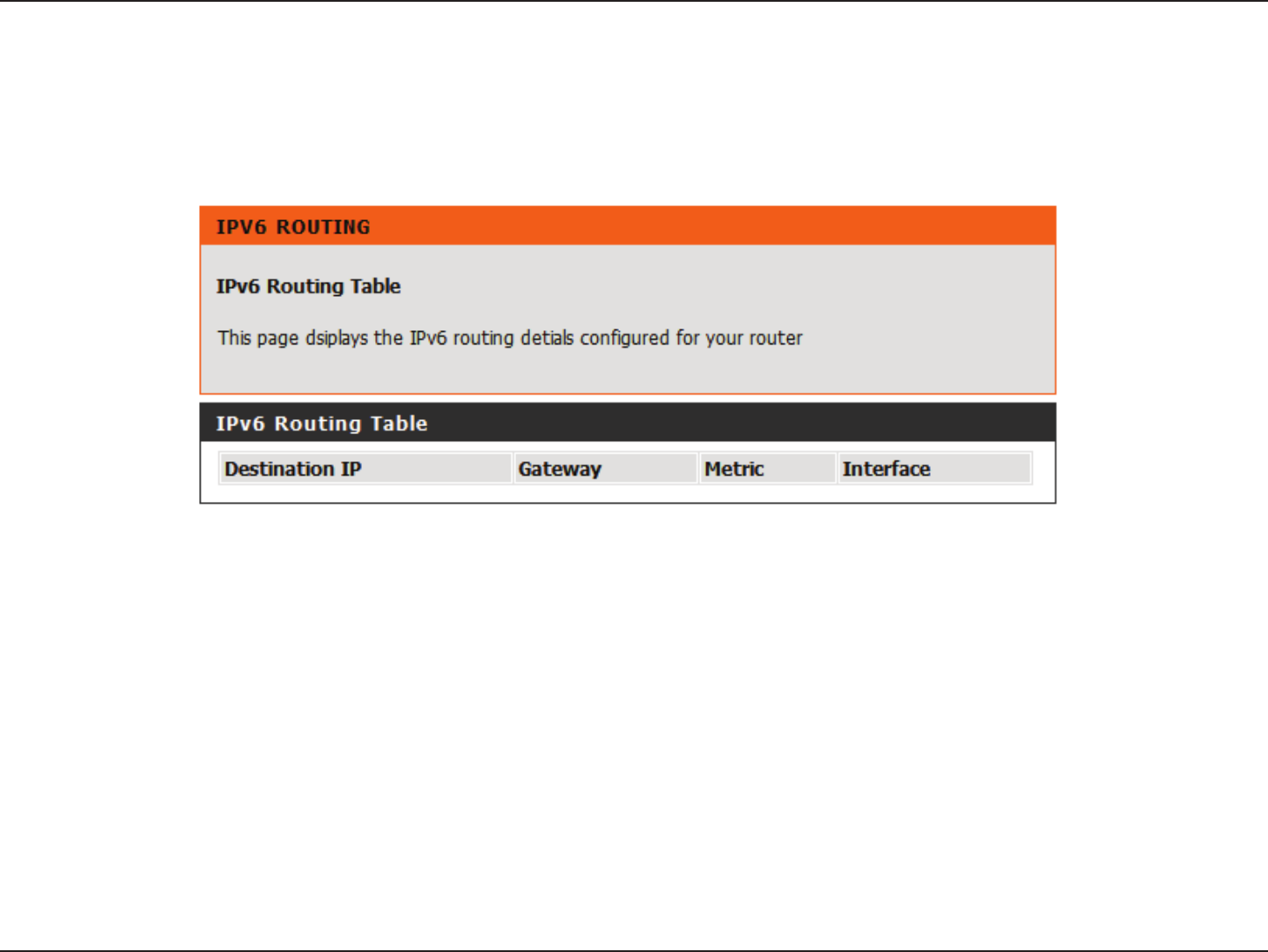
91D-Link DIR-655 User Manual
Section 3 - Conguration
IPv6 Routing
This page displays the IPv6 Routing details congured for your router.
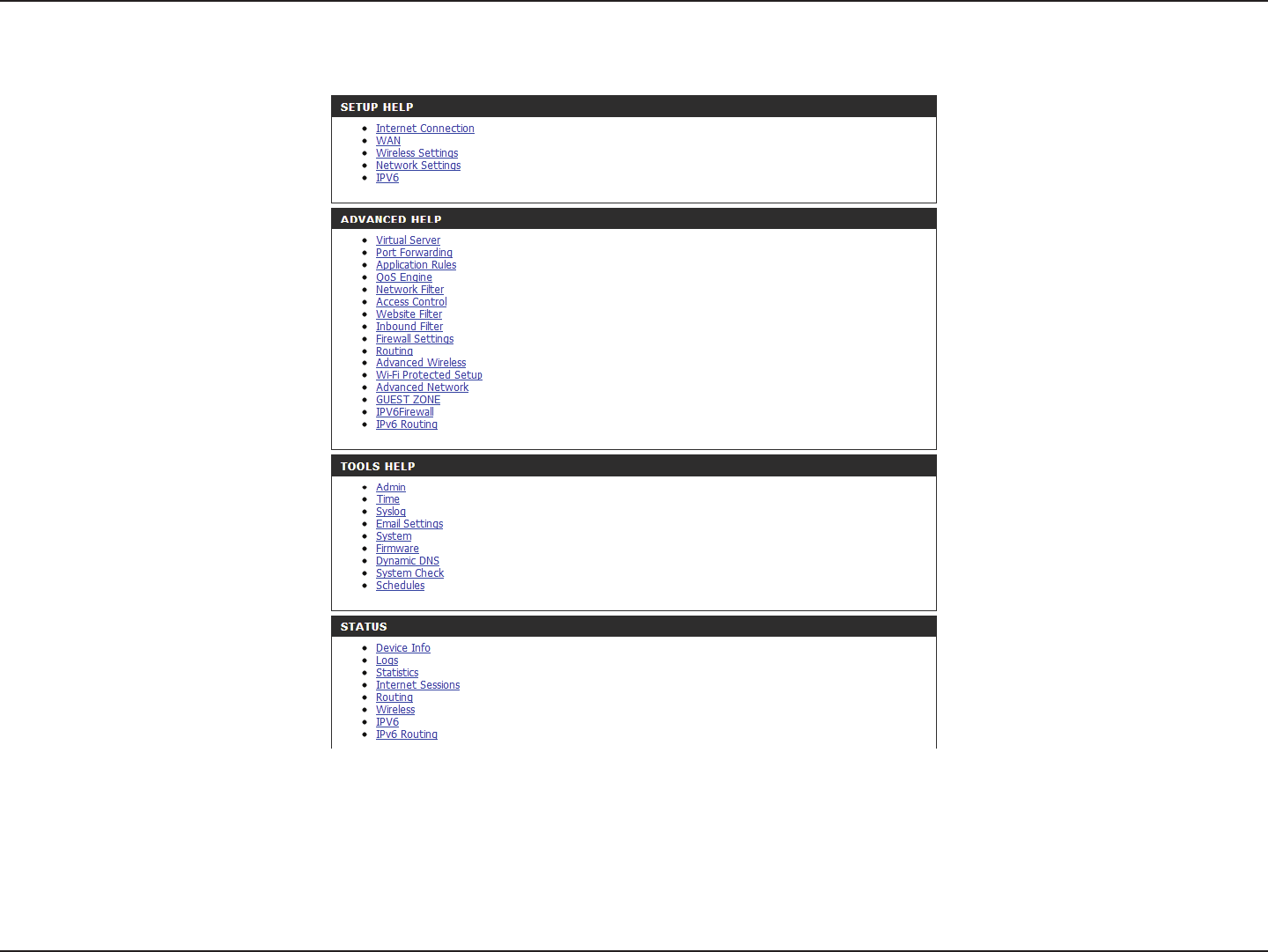
92D-Link DIR-655 User Manual
Section 3 - Conguration
Support
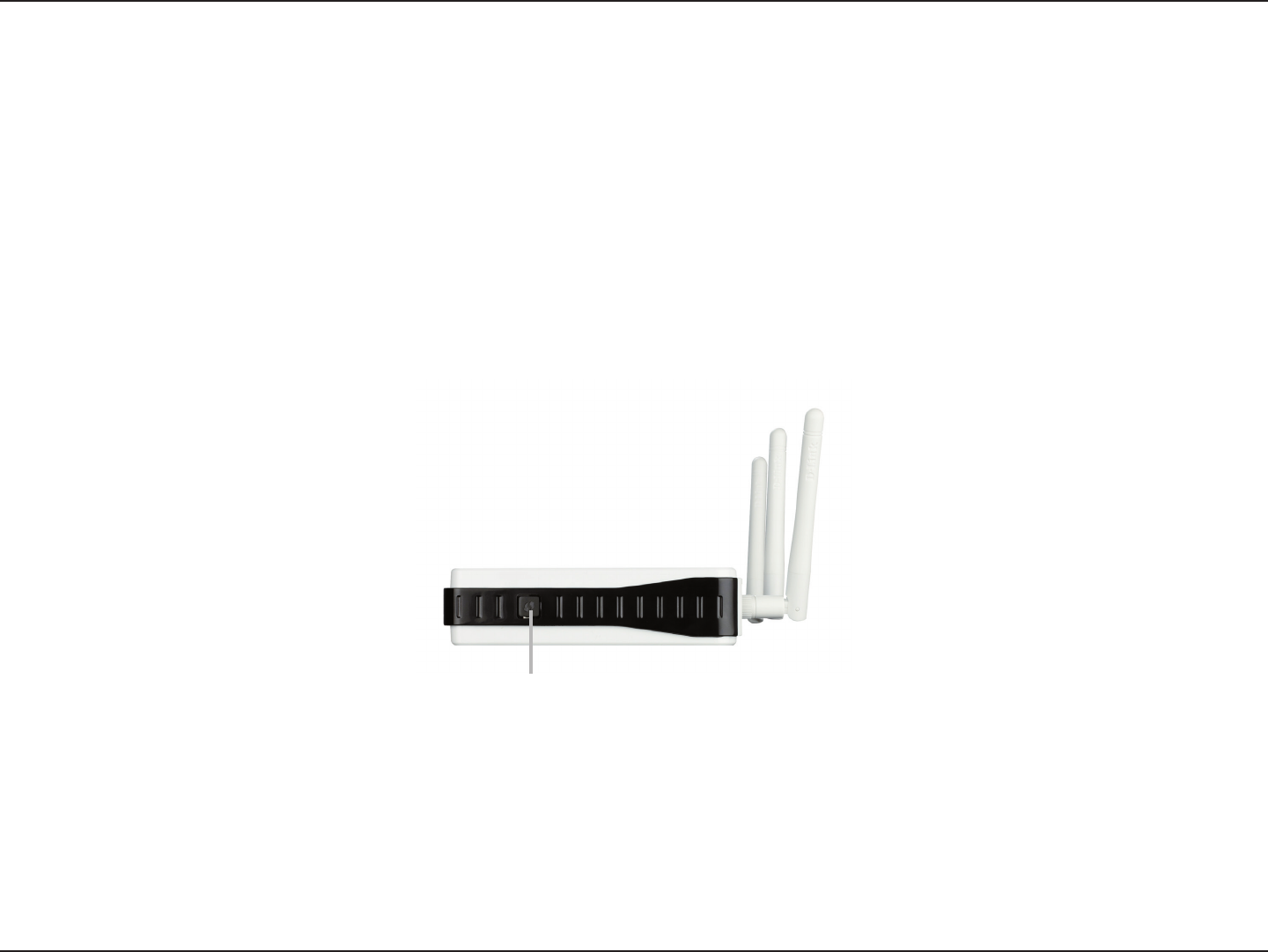
93D-Link DIR-655 User Manual
Section 4 - Connect a Wireless Client to your Router
Connect a Wireless Client to your Router
WPS Button
Step 2 - Within 2 minutes, press the WPS button on your wireless client (or launch the software utility and start the WPS process).
The easiest and most secure way to connect your wireless devices to the router is WPS (Wi-Fi Protected Setup). Most wireless devices such as wireless
adapters, media players, Blu-ray DVD players, wireless printers and cameras will have a WPS button (or a software utility with WPS) that you can
press to connect to the DIR-655 router. Please refer to your user manual for the wireless device you want to connect to make sure you understand
how to enable WPS. Once you know, follow the steps below:
Step 1 - Press the WPS button on the DIR-655 for about 1 second. The Internet LED on the front will start to blink.
Step 3 - Allow up to 1 minute to congure. Once the Internet light stops blinking, you will be connected and your wireless connection will be
secure with WPA2.
WPS Button
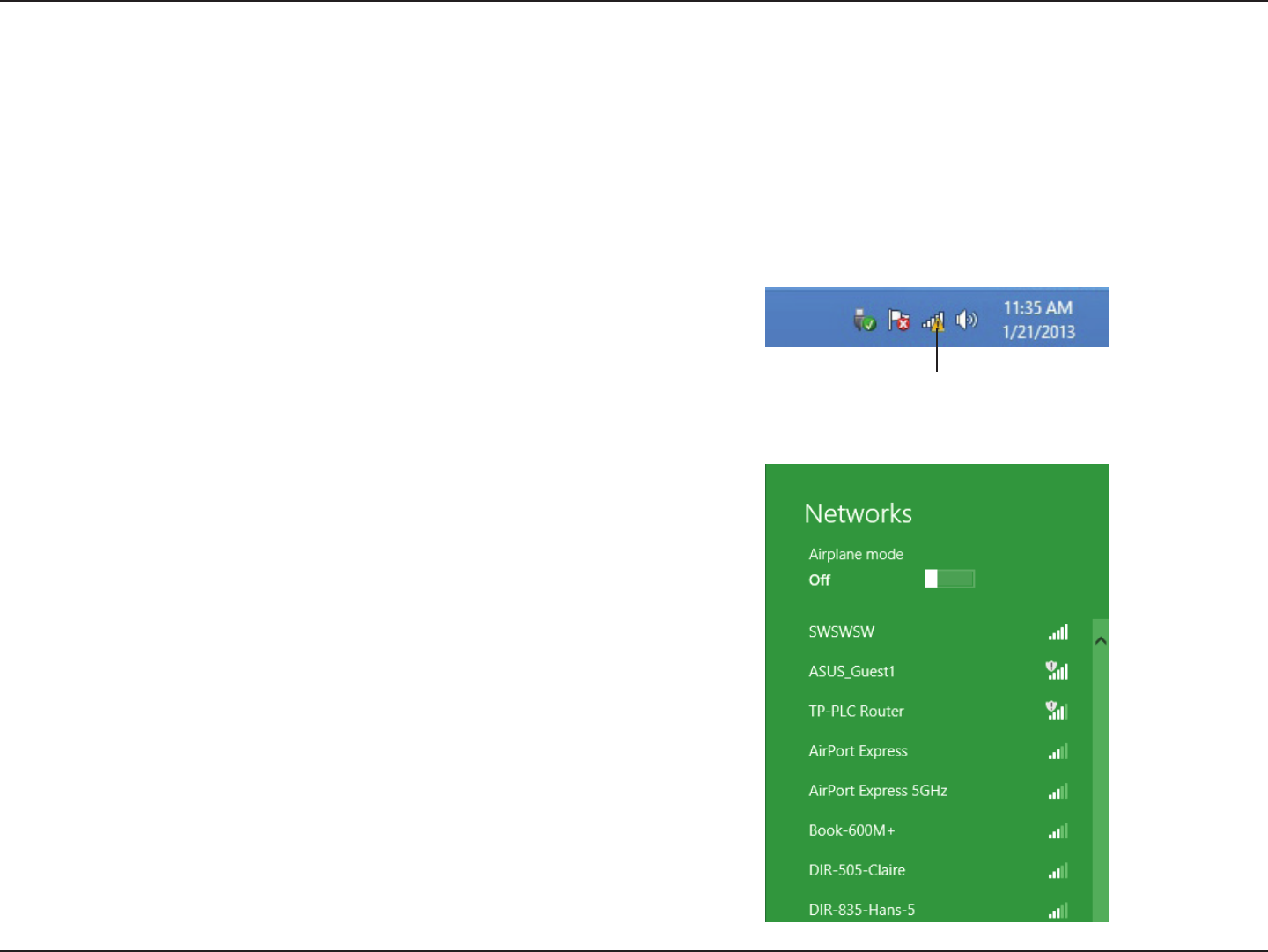
94D-Link DIR-655 User Manual
Section 4 - Connect a Wireless Client to your Router
Windows® 8
WPA/WPA2
It is recommended to enable wireless security (WPA/WPA2) on your wireless router or access point before conguring your wireless adapter. If you
are joining an existing network, you will need to know the security key (Wi-Fi password) being used.
To join an existing network, locate the wireless network icon in the taskbar,
next to the time display.
Wireless Icon
Clicking on this icon will display a list of wireless networks which are within
connecting proximity of your computer. Select the desired network by clicking
on the network name.
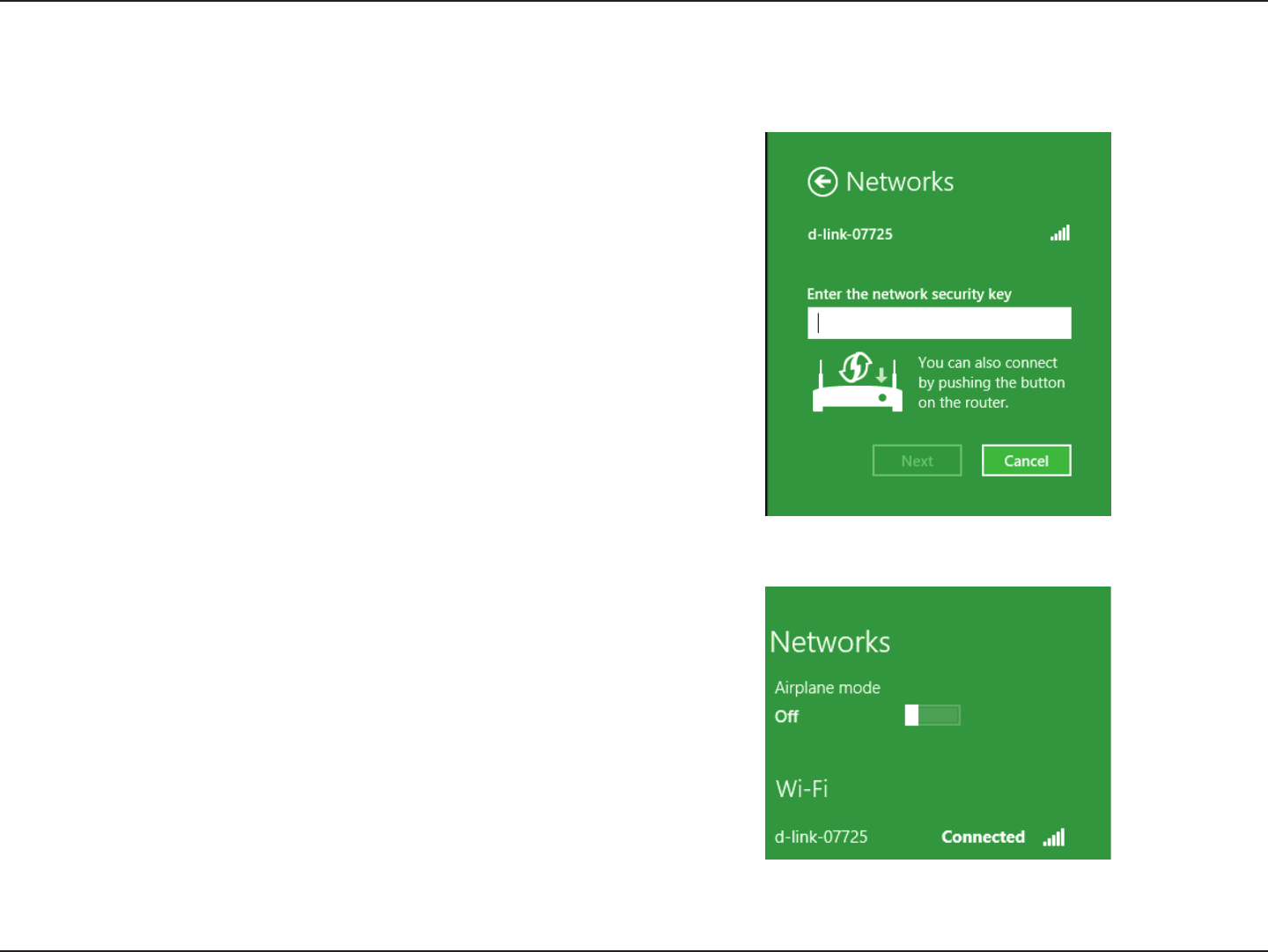
95D-Link DIR-655 User Manual
Section 4 - Connect a Wireless Client to your Router
You will then be prompted to enter the network security key (Wi-Fi password)
for the wireless network. Enter the password into the box and click Next.
If you wish to use Wi-Fi Protected Setup (WPS) to connect to the router, you
can also press the WPS button on your router at the point to enable the WPS
function.
When you have established a successful connection a wireless network, the
word Connected will appear next to the name of the network to which you
are connected.
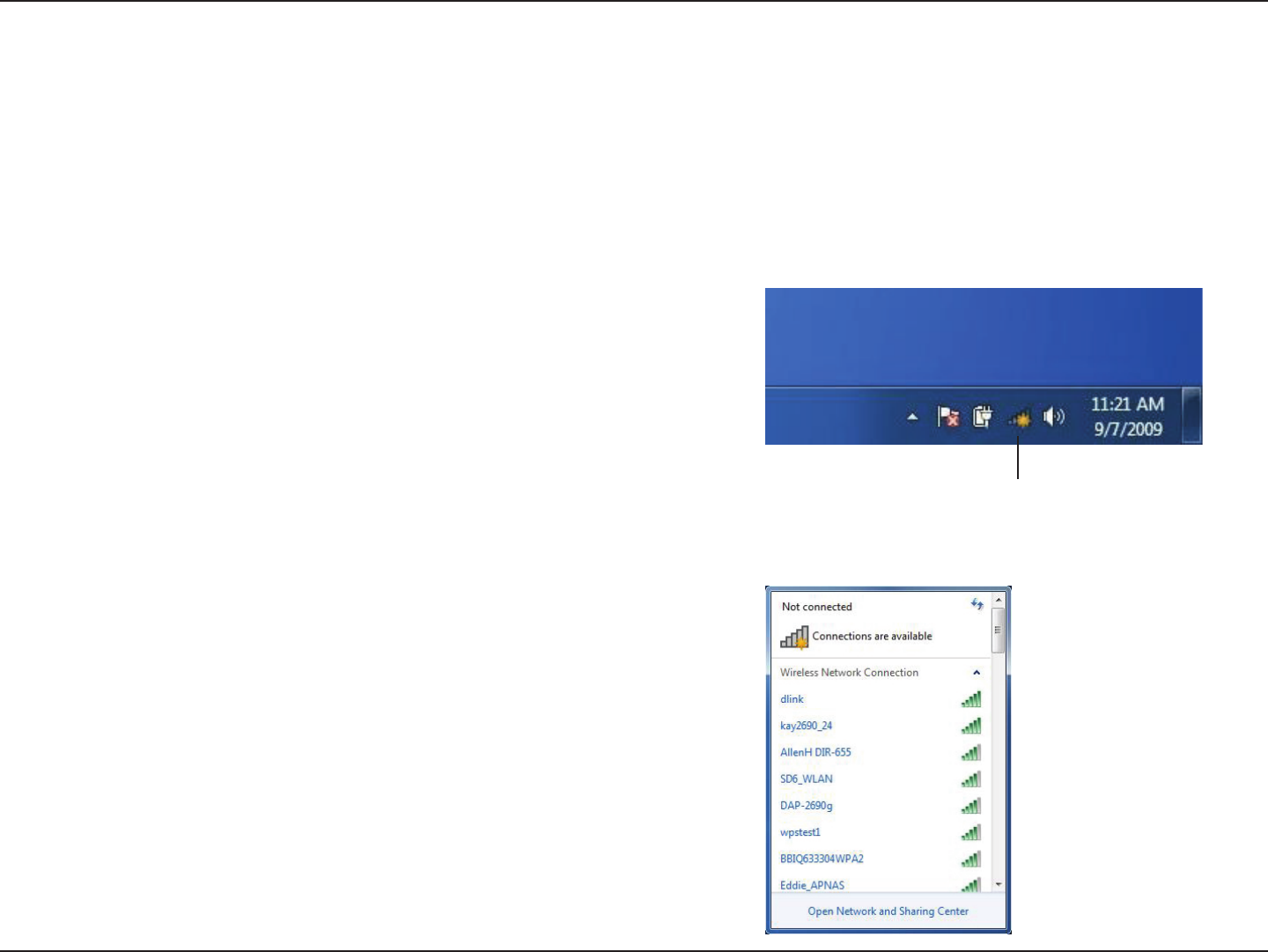
96D-Link DIR-655 User Manual
Section 4 - Connect a Wireless Client to your Router
Windows® 7
It is recommended to enable wireless security (WPA/WPA2) on your wireless router or access point before conguring your wireless adapter. If you
are joining an existing network, you will need to know the security key or passphrase being used.
1. Click on the wireless icon in your system tray (lower-right corner).
2. The utility will display any available wireless networks in your area.
Wireless Icon
WPA/WPA2
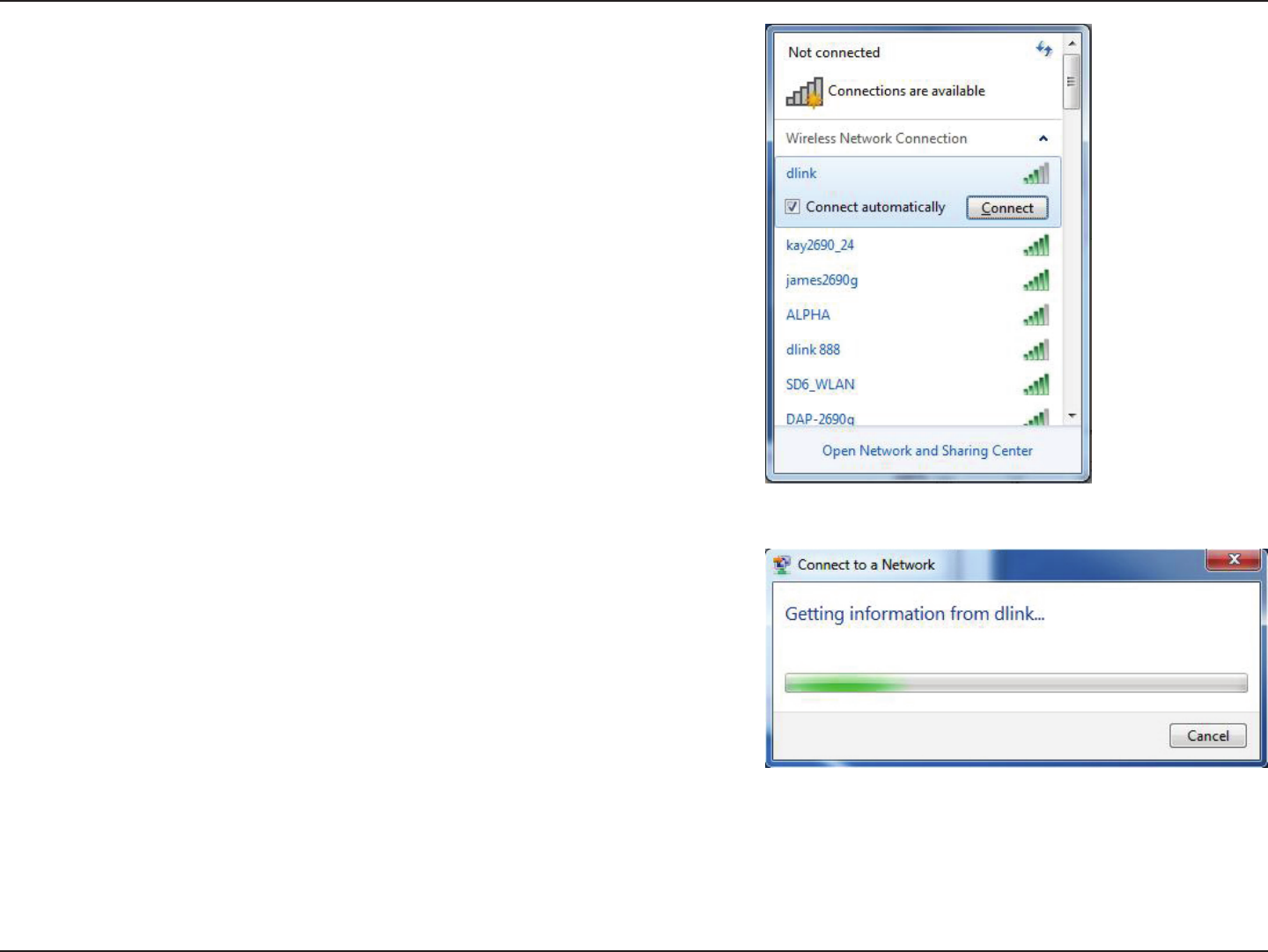
97D-Link DIR-655 User Manual
Section 4 - Connect a Wireless Client to your Router
3. Highlight the wireless connection with Wi-Fi name (SSID) you would like to
connect to and click the Connect button.
If you get a good signal but cannot access the Internet, check your TCP/IP
settings for your wireless adapter. Refer to the Networking Basics section
in this manual for more information.
4. The following window appears while your computer tries to connect to the
router.
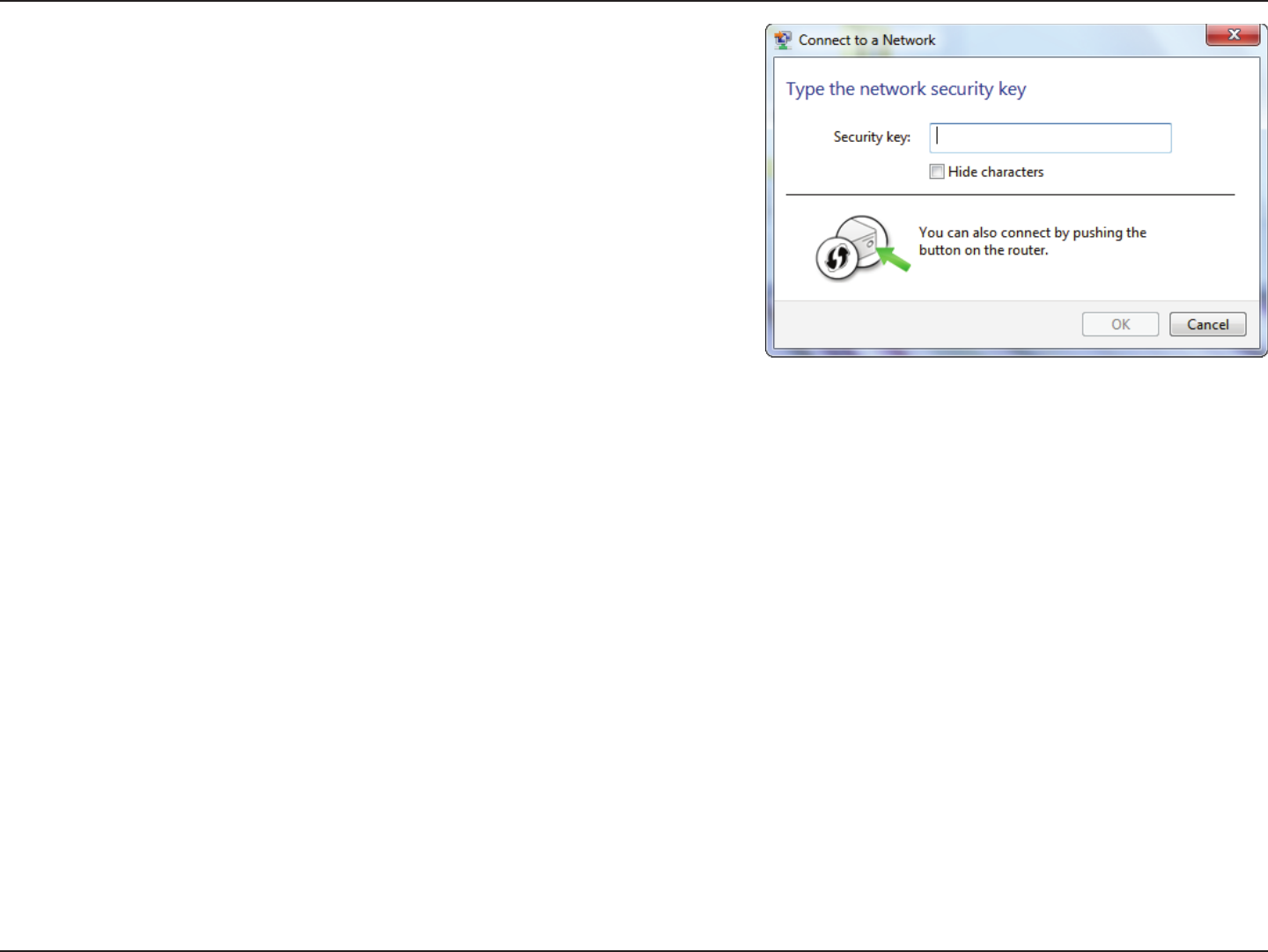
98D-Link DIR-655 User Manual
Section 4 - Connect a Wireless Client to your Router
5. Enter the same security key or passphrase (Wi-Fi password) that is on your
router and click Connect. You can also connect by pushing the WPS button
on the router.
It may take 20-30 seconds to connect to the wireless network. If the connection
fails, please verify that the security settings are correct. The key or passphrase
must be exactly the same as on the wireless router.
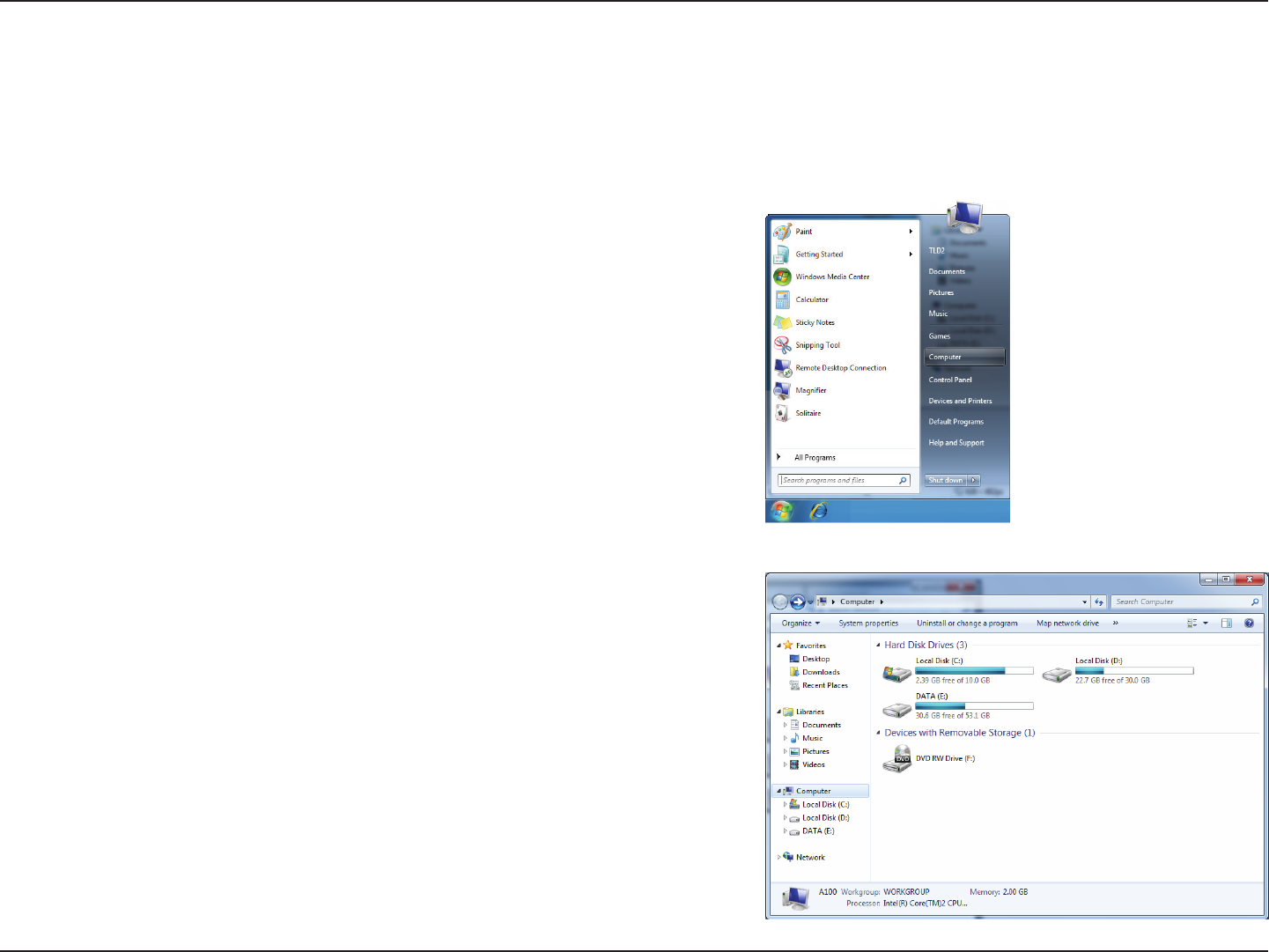
99D-Link DIR-655 User Manual
Section 4 - Connect a Wireless Client to your Router
WPS
The WPS feature of the DIR-655 can be congured using Windows® 7. Carry out the following steps to use Windows® 7 to congure the WPS feature:
1. Click the Start button and select Computer from the Start menu.
2. Click Network on the left side.
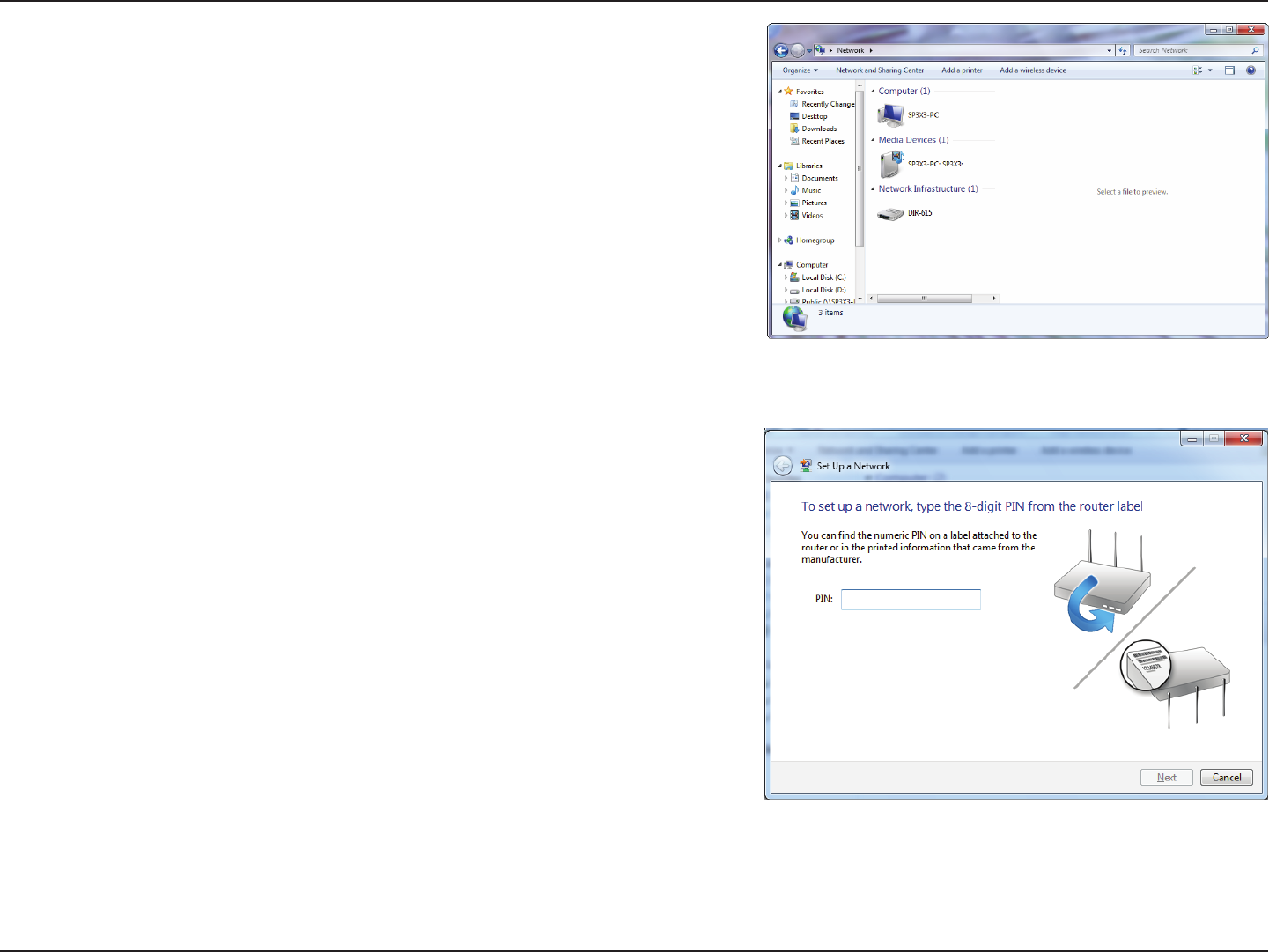
100D-Link DIR-655 User Manual
Section 4 - Connect a Wireless Client to your Router
3. Double-click the DIR-655.
4. Input the WPS PIN number (on the Router label) or in the Setup > Wireless
Setup menu in the Router’s Web UI and click Next.
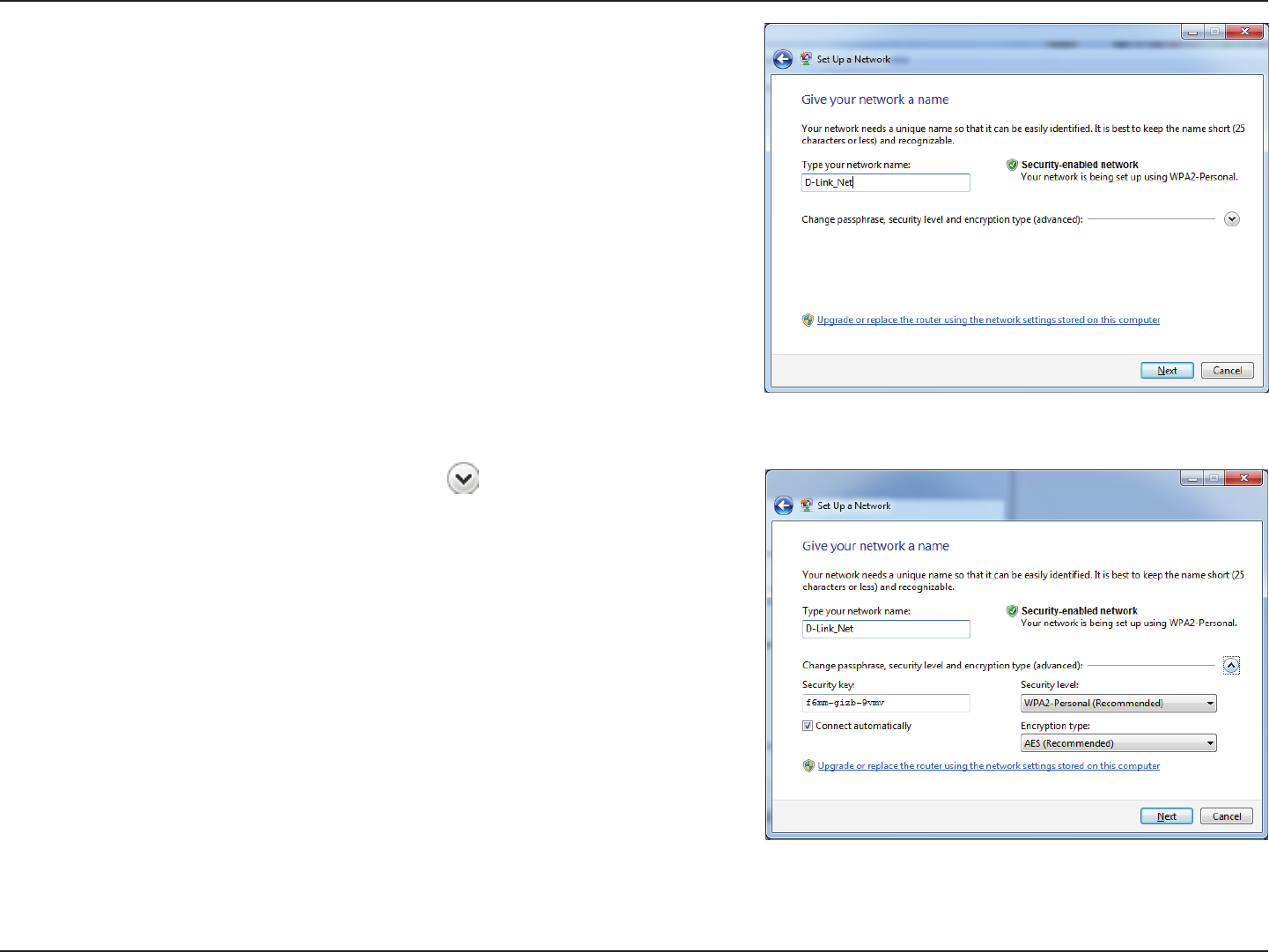
101D-Link DIR-655 User Manual
Section 4 - Connect a Wireless Client to your Router
5. Type a name to identify the network.
6. To congure advanced settings, click the icon.
Click Next to continue.
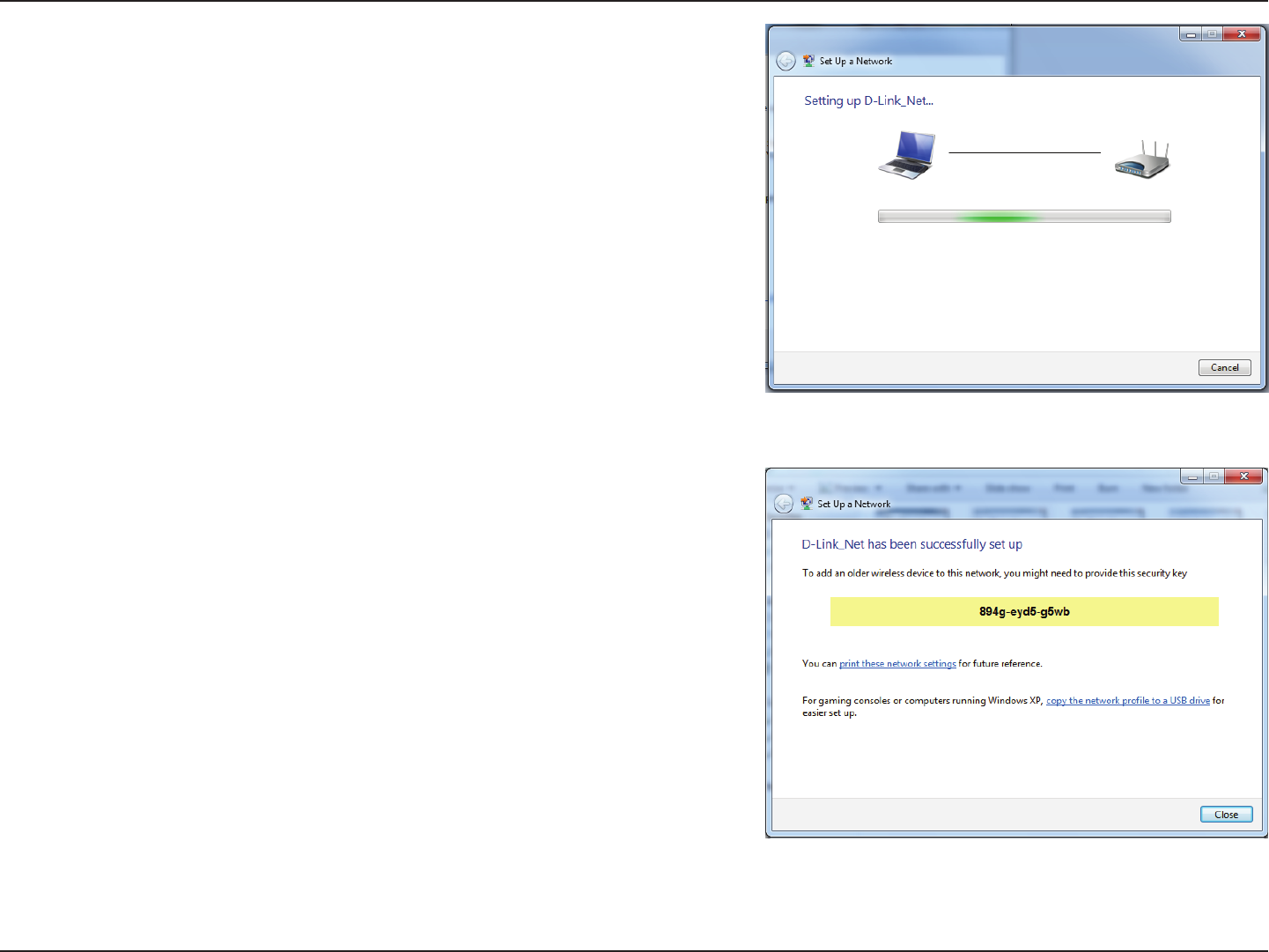
102D-Link DIR-655 User Manual
Section 4 - Connect a Wireless Client to your Router
7. The following window appears while the router is being congured.
Wait for the conguration to complete.
8. The following window informs you that WPS on the router has been setup
successfully.
Make a note of the security key as you may need to provide this security
key if adding an older wireless device to the network in the future.
9. Click Close to complete WPS setup.
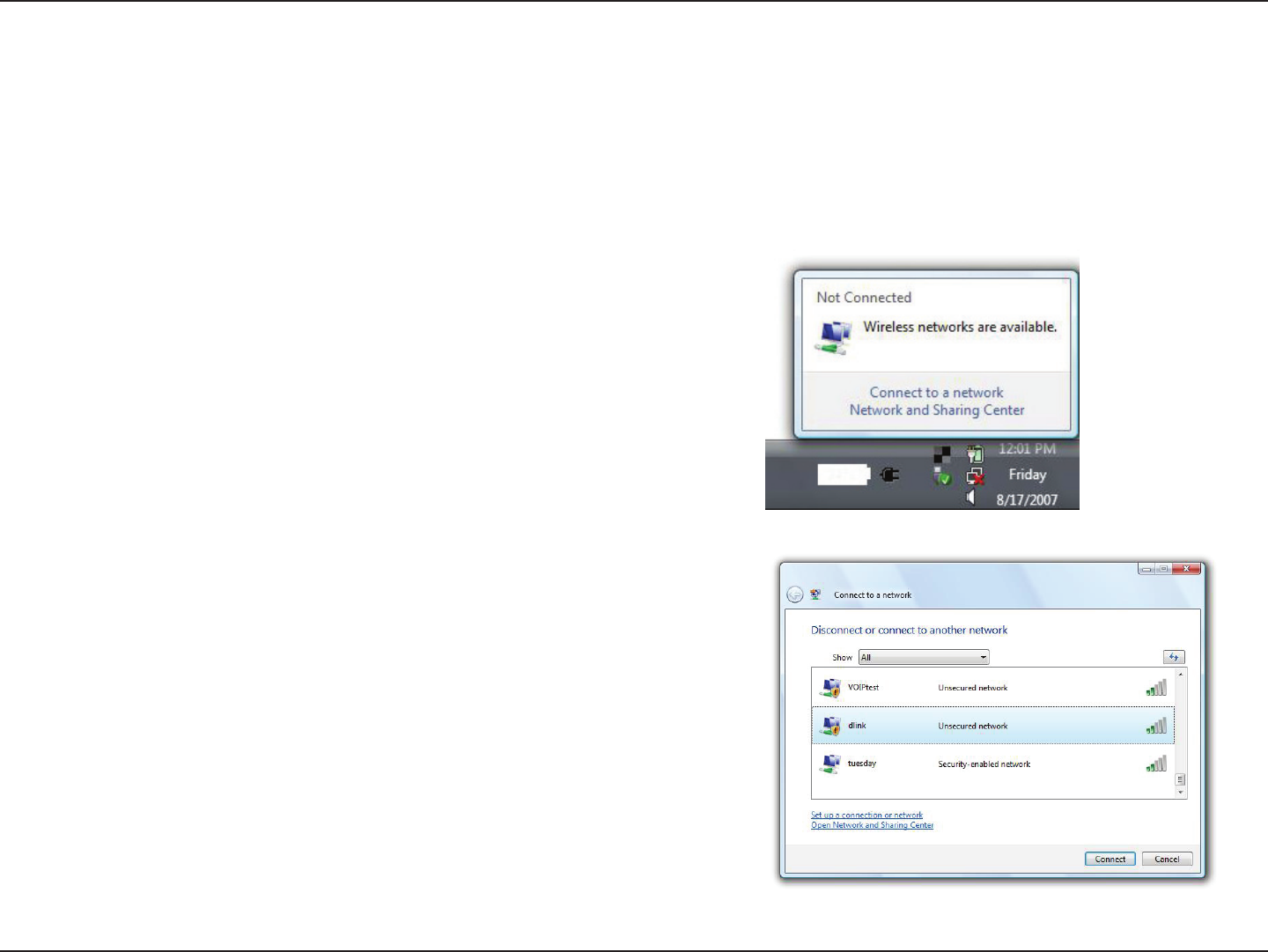
103D-Link DIR-655 User Manual
Section 4 - Connect a Wireless Client to your Router
Windows Vista®
Windows Vista users may use the built-in wireless utility. If you are using another company’s utility, please refer to the user manual of your wireless
adapter for help with connecting to a wireless network. Most utilities will have a “site survey” option similar to the Windows Vista® utility as seen
below.
Right-click on the wireless computer icon in your system tray (lower-right corner
next to the time). Select Connect to a network.
If you receive the Wireless Networks Detected bubble, click on the center of
the bubble to access the utility.
or
The utility will display any available wireless networks in your area. Click on a
network (displayed using the SSID) and click the Connect button.
If you get a good signal but cannot access the Internet, check you TCP/IP
settings for your wireless adapter. Refer to the Networking Basics section in
this manual for more information.

104D-Link DIR-655 User Manual
Section 4 - Connect a Wireless Client to your Router
WPA/WPA2
It is recommended to enable wireless security (WPA/WPA2) on your wireless router or access point before conguring your wireless adapter. If you
are joining an existing network, you will need to know the security key or passphrase being used.
2. Highlight the Wi-Fi name (SSID) you would like to connect to and click
Connect.
1. Open the Windows Vista Wireless Utility by right-clicking on the wireless
computer icon in your system tray (lower right corner of screen). Select
Connect to a network.
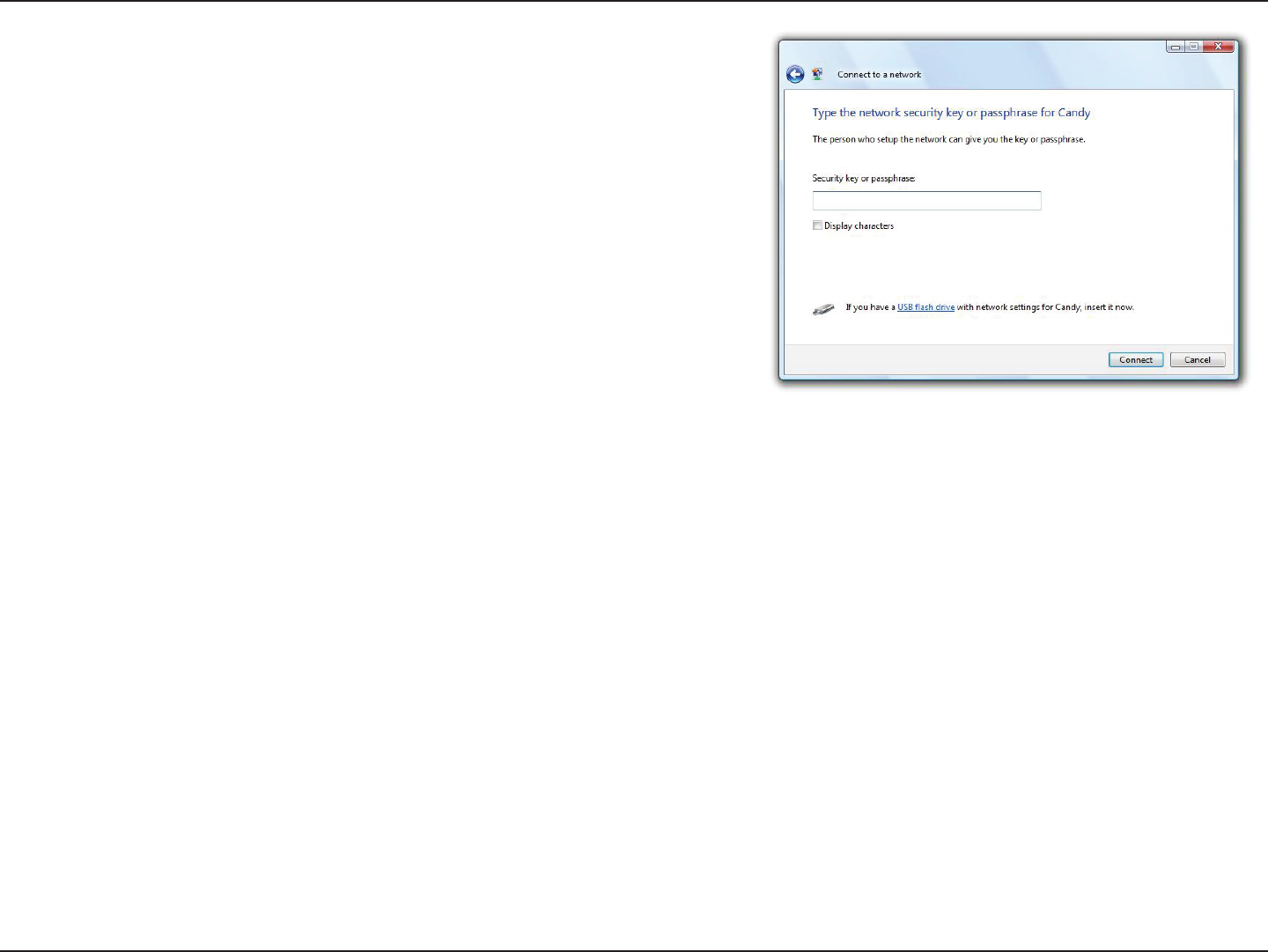
105D-Link DIR-655 User Manual
Section 4 - Connect a Wireless Client to your Router
3. Enter the same security key or passphrase (Wi-Fi password) that is on your
router and click Connect.
It may take 20-30 seconds to connect to the wireless network. If the connection
fails, please verify that the security settings are correct. The key or passphrase
must be exactly the same as on the wireless router.
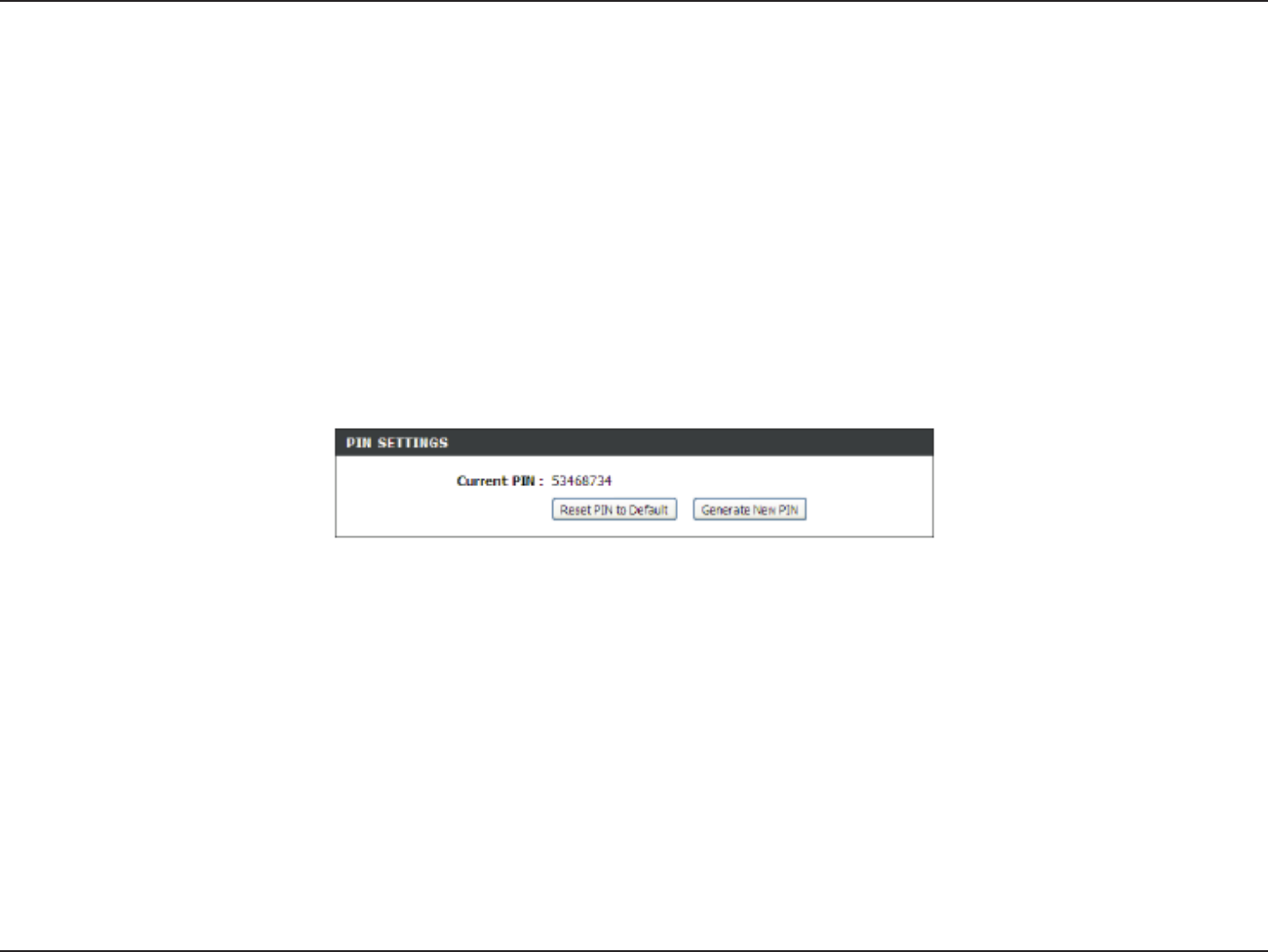
106D-Link DIR-655 User Manual
Section 4 - Connect a Wireless Client to your Router
WPS/WCN 2.0
The router supports Wi-Fi protection, referred to as WCN 2.0 in Windows Vista. The following instructions for setting this up depends on whether
you are using Windows Vista to congure the router or third party software.
When you rst set up the router, Wi-Fi protection is disabled and uncongured. To enjoy the benets of Wi-Fi protection, the router must be both
enabled and congured. There are three basic methods to accomplish this: use Windows Vista’s built-in support for WCN 2.0, use software provided
by a third party, or manually congure.
If you are running Windows Vista, log into the router and click the Enable checkbox in the Basic > Wireless section. Use the Current PIN that is
displayed on the Advanced > Wi-Fi Protected Setup section or choose to click the Generate New PIN button or Reset PIN to Default button.
If you are using third party software to set up Wi-Fi Protection, carefully follow the directions. When you are nished, proceed to the next section
to set up the newly-congured router.
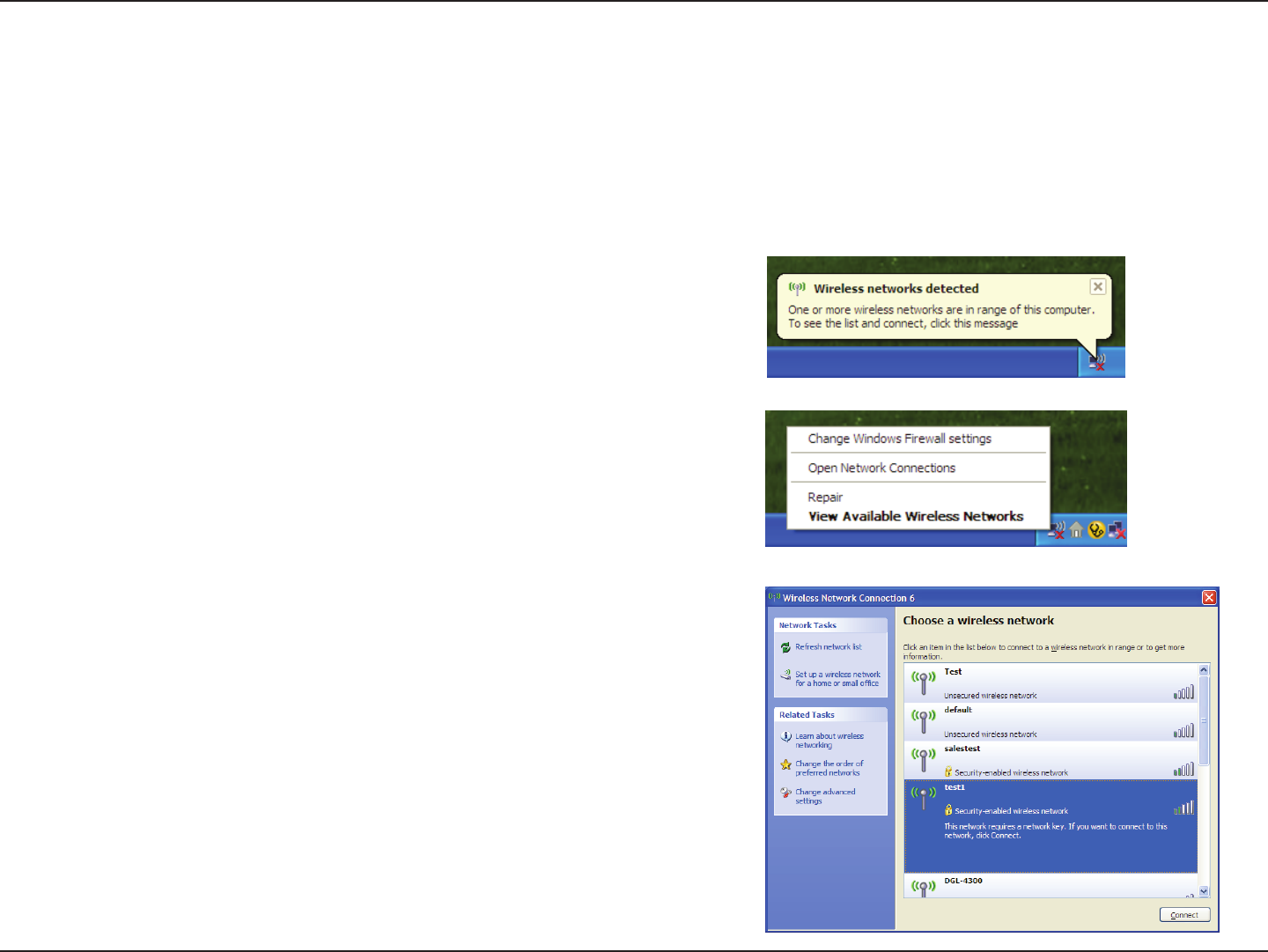
107D-Link DIR-655 User Manual
Section 4 - Connect a Wireless Client to your Router
Windows® XP
Windows XP users may use the built-in wireless utility (Zero Conguration Utility). The following instructions are for Service Pack 2 users. If you
are using another company’s utility, please refer to the user manual of your wireless adapter for help with connecting to a wireless network. Most
utilities will have a “site survey” option similar to the Windows® XP utility as seen below.
Right-click on the wireless computer icon in your system tray (lower-right corner
next to the time). Select View Available Wireless Networks.
If you receive the Wireless Networks Detected bubble, click on the center of
the bubble to access the utility.
or
The utility will display any available wireless networks in your area. Click on a
Wi-Fi network (displayed using the SSID) and click the Connect button.
If you get a good signal but cannot access the Internet, check you TCP/IP
settings for your wireless adapter. Refer to the Networking Basics section in
this manual for more information.
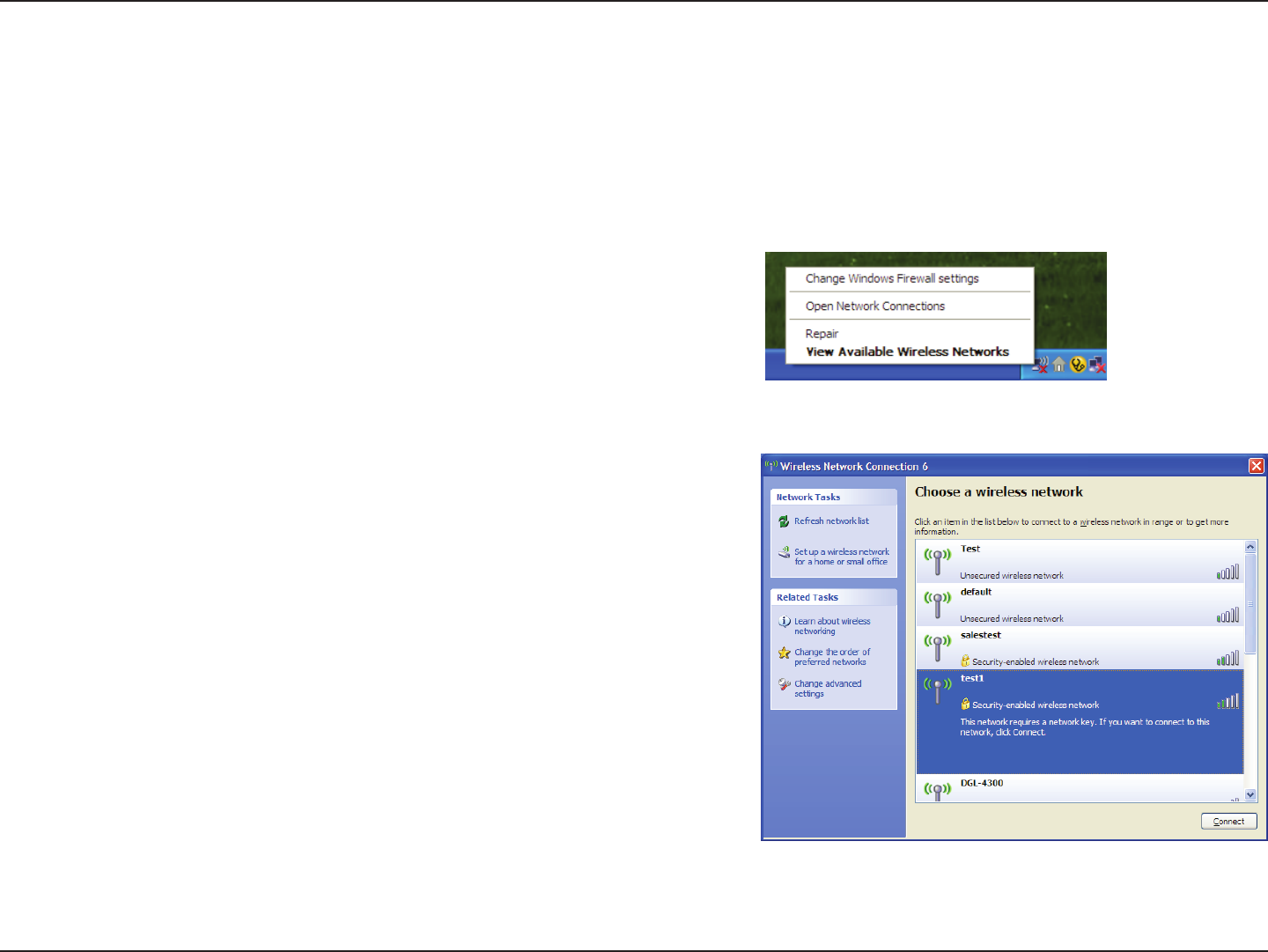
108D-Link DIR-655 User Manual
Section 4 - Connect a Wireless Client to your Router
It is recommended to enable WPA on your wireless router or access point before conguring your wireless adapter. If you are joining an existing
network, you will need to know the WPA key being used.
2. Highlight the Wi-Fi network (SSID) you would like to connect to and click
Connect.
1. Open the Windows XP Wireless Utility by right-clicking on the wireless
computer icon in your system tray (lower-right corner of screen). Select View
Available Wireless Networks.
WPA/WPA2
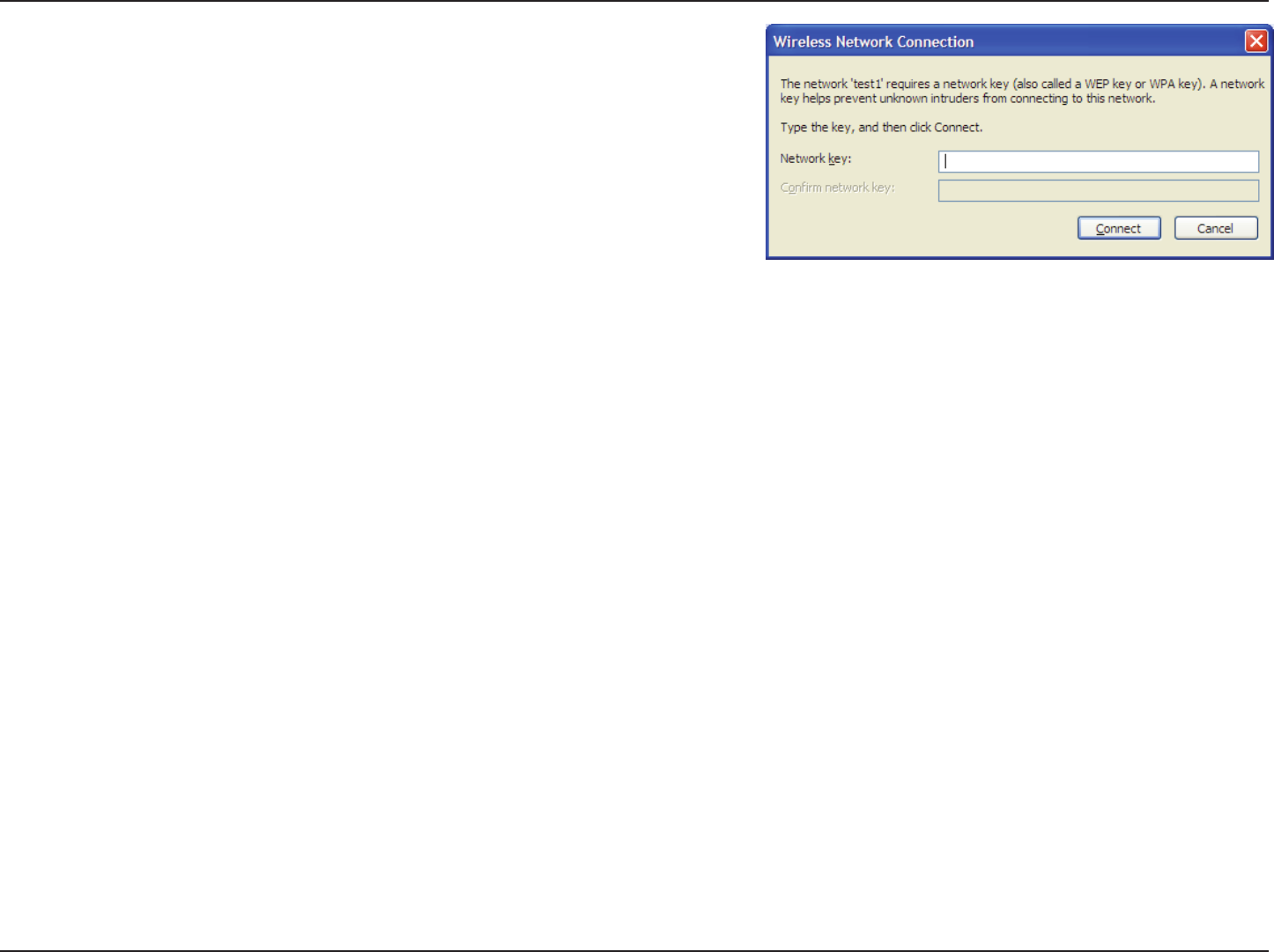
109D-Link DIR-655 User Manual
Section 4 - Connect a Wireless Client to your Router
3. The Wireless Network Connection box will appear. Enter the WPA-PSK
Wi-Fi password and click Connect.
It may take 20-30 seconds to connect to the wireless network. If the connection
fails, please verify that the WPA-PSK settings are correct. The Wi-Fi password
must be exactly the same as on the wireless router.

110D-Link DIR-655 User Manual
Section 5 - Troubleshooting
Troubleshooting
This chapter provides solutions to problems that can occur during the installation and operation of the DIR-655. Read the following descriptions
if you are having problems. (The examples below are illustrated in Windows® XP. If you have a dierent operating system, the screenshots on your
computer will look similar to the following examples.)
1. Why can’t I access the web-based conguration utility?
When entering the IP address of the D-Link router (192.168.0.1 for example), you are not connecting to a website on the Internet or have to be
connected to the Internet. The device has the utility built-in to a ROM chip in the device itself. Your computer must be on the same IP subnet to
connect to the web-based utility.
• Make sure you have an updated Java-enabled web browser. We recommend the following:
• Internet Explorer 6.0 or higher
• Netscape 8 or higher
• Mozilla 1.7.12 (5.0) or higher
• Opera 8.5 or higher
• Safari 1.2 or higher (with Java 1.3.1 or higher)
• Camino 0.8.4 or higher
• Firefox 1.5 or higher
• Verify physical connectivity by checking for solid link lights on the device. If you do not get a solid link light, try using a dierent cable or connect
to a dierent port on the device if possible. If the computer is turned o, the link light may not be on.
• Disable any internet security software running on the computer. Software rewalls such as ZoneAlarm, BlackICE, Sygate, Norton Personal Firewall,
and Windows XP rewall may block access to the conguration pages. Check the help les included with your rewall software for more information
on disabling or conguring it.

111D-Link DIR-655 User Manual
Section 5 - Troubleshooting
• Congure your Internet settings:
• Go to Start > Settings > Control Panel. Double-click the Internet Options Icon. From the Security tab, click the button to restore
the settings to their defaults.
• Click the Connection tab and set the dial-up option to Never Dial a Connection. Click the LAN Settings button. Make sure nothing
is checked. Click OK.
• Go to the Advanced tab and click the button to restore these settings to their defaults. Click OK three times.
• Close your web browser (if open) and open it.
• Access the web management. Open your web browser and enter the IP address of your D-Link router in the address bar. This should open the
login page for your the web management.
• If you still cannot access the conguration, unplug the power to the router for 10 seconds and plug back in. Wait about 30 seconds and try accessing
the conguration. If you have multiple computers, try connecting using a dierent computer.
2. What can I do if I forgot my password?
If you forgot your password, you must reset your router. Unfortunately this process will change all your settings back to the factory defaults.
To reset the router, locate the reset button (hole) on the rear panel of the unit. With the router powered on, use a paperclip to hold the button
down for 10 seconds. Release the button and the router will go through its reboot process. Wait about 30 seconds to access the router. The default
IP address is 192.168.0.1. When logging in, the username is admin and leave the password box empty.
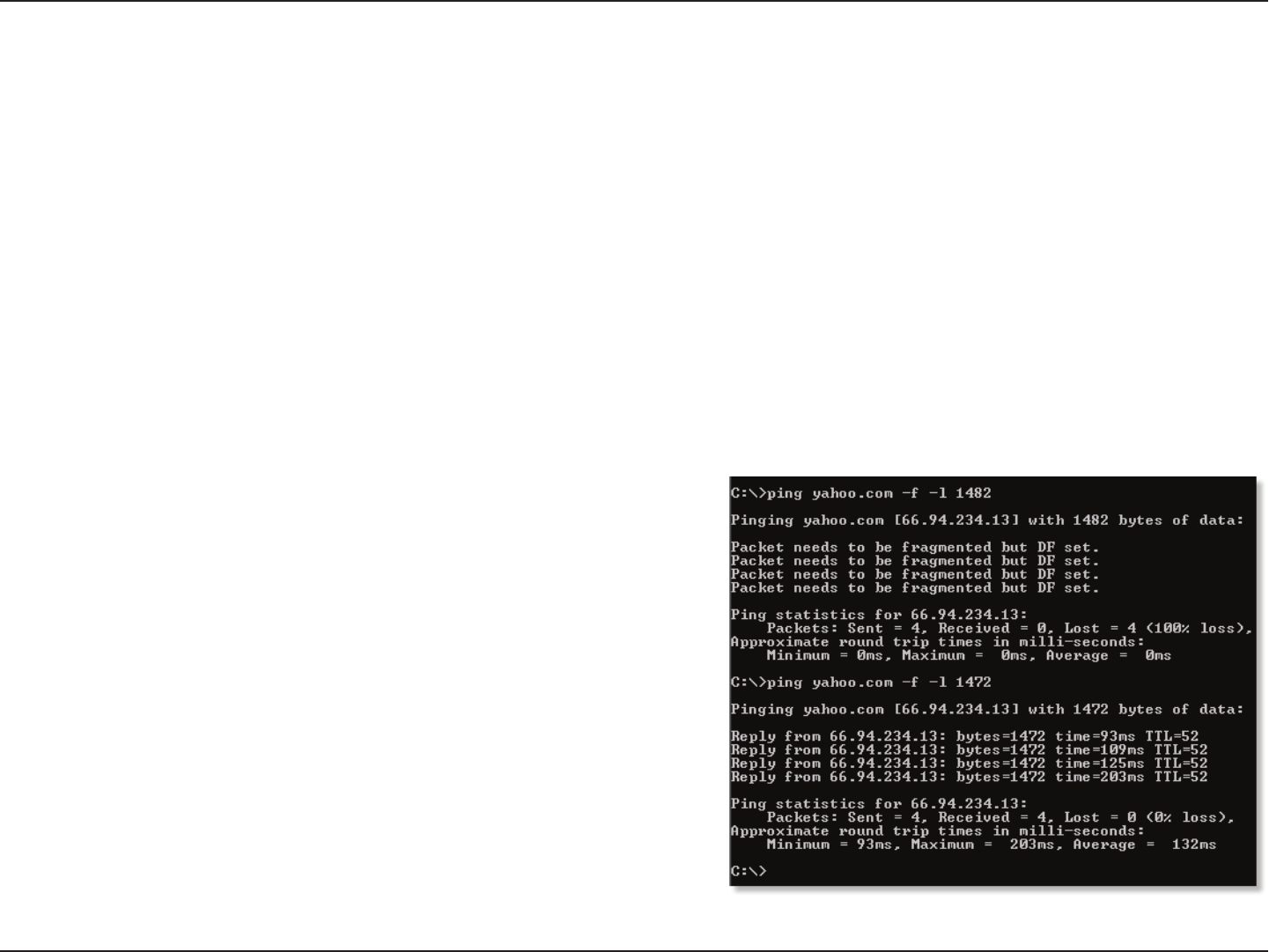
112D-Link DIR-655 User Manual
Section 5 - Troubleshooting
3. Why can’t I connect to certain sites or send and receive emails when connecting through my router?
If you are having a problem sending or receiving email, or connecting to secure sites such as eBay, banking sites, and Hotmail, we suggest lowering
the MTU in increments of ten (Ex. 1492, 1482, 1472, etc).
Note: AOL DSL+ users must use MTU of 1400.
To nd the proper MTU Size, you’ll have to do a special ping of the destination you’re trying to go to. A destination could be another computer, or
a URL.
• Click on Start and then click Run.
• Windows® 95, 98, and Me users type in command (Windows NT, 2000, XP, Vista® and 7 users type in cmd) and press Enter (or click OK).
• Once the window opens, you’ll need to do a special ping. Use the following syntax:
ping [url] [-f] [-l] [MTU value]
Example: ping yahoo.com -f -l 1472

113D-Link DIR-655 User Manual
Section 5 - Troubleshooting
You should start at 1472 and work your way down by 10 each time. Once you get a reply, go up by 2 until you get a fragmented packet. Take that
value and add 28 to the value to account for the various TCP/IP headers. For example, lets say that 1452 was the proper value, the actual MTU size
would be 1480, which is the optimum for the network we’re working with (1452+28=1480).
Once you nd your MTU, you can now congure your router with the proper MTU size.
To change the MTU rate on your router follow the steps below:
• Open your browser, enter the IP address of your router (192.168.0.1) and click OK.
• Enter your username (admin) and password (blank by default). Click OK to enter the web conguration page for the device.
• Click on Setup and then click Manual Congure.
• To change the MTU enter the number in the MTU eld and click Save Settings to save your settings.
• Test your email. If changing the MTU does not resolve the problem, continue changing the MTU in increments of ten.

114D-Link DIR-655 User Manual
Appendix A - Wireless Basics
D-Link wireless products are based on industry standards to provide easy-to-use and compatible high-speed wireless connectivity within your
home, business or public access wireless networks. Strictly adhering to the IEEE standard, the D-Link wireless family of products will allow you to
securely access the data you want, when and where you want it. You will be able to enjoy the freedom that wireless networking delivers.
A wireless local area network (WLAN) is a cellular computer network that transmits and receives data with radio signals instead of wires. Wireless
LANs are used increasingly in both home and oce environments, and public areas such as airports, coee shops and universities. Innovative ways
to utilize WLAN technology are helping people to work and communicate more eciently. Increased mobility and the absence of cabling and other
xed infrastructure have proven to be benecial for many users.
Wireless users can use the same applications they use on a wired network. Wireless adapter cards used on laptop and desktop systems support the
same protocols as Ethernet adapter cards.
Under many circumstances, it may be desirable for mobile network devices to link to a conventional Ethernet LAN in order to use servers, printers
or an Internet connection supplied through the wired LAN. A wireless router is a device used to provide this link.
Wireless Basics
What is Wireless?
Wireless or Wi-Fi technology is another way of connecting your computer to the network without using wires. Wi-Fi uses radio frequency to connect
wirelessly, so you have the freedom to connect computers anywhere in your home or oce network.
Why D-Link Wireless?
D-Link is the worldwide leader and award winning designer, developer, and manufacturer of networking products. D-Link delivers the performance
you need at a price you can aord. D-Link has all the products you need to build your network.

115D-Link DIR-655 User Manual
Appendix A - Wireless Basics
How does wireless work?
Wireless works similar to how cordless phone work, through radio signals to transmit data from one point A to point B. But wireless technology has
restrictions as to how you can access the network. You must be within the wireless network range area to be able to connect your computer. There
are two dierent types of wireless networks Wireless Local Area Network (WLAN), and Wireless Personal Area Network (WPAN).
Wireless Local Area Network (WLAN)
In a wireless local area network, a device called an Access Point (AP) connects computers to the network. The access point has a small antenna
attached to it, which allows it to transmit data back and forth over radio signals. With an indoor access point as seen in the picture, the signal can
travel up to 300 feet. With an outdoor access point the signal can reach out up to 30 miles to serve places like manufacturing plants, industrial
locations, college and high school campuses, airports, golf courses, and many other outdoor venues.
Wireless Personal Area Network (WPAN)
Bluetooth is the industry standard wireless technology used for WPAN. Bluetooth devices in WPAN operate in a range up to 30 feet away.
Compared to WLAN the speed and wireless operation range are both less than WLAN, but in return it doesn’t use nearly as much power which
makes it ideal for personal devices, such as mobile phones, PDAs, headphones, laptops, speakers, and other devices that operate on batteries.
Who uses wireless?
Wireless technology as become so popular in recent years that almost everyone is using it, whether it’s for home, oce, business, D-Link has a
wireless solution for it.
Home
• Gives everyone at home broadband access
• Surf the web, check email, instant message, and etc
• Gets rid of the cables around the house
• Simple and easy to use
Small Oce and Home Oce
• Stay on top of everything at home as you would at oce
• Remotely access your oce network from home
• Share Internet connection and printer with multiple computers
• No need to dedicate oce space

116D-Link DIR-655 User Manual
Appendix A - Wireless Basics
Where is wireless used?
Wireless technology is expanding everywhere not just at home or oce. People like the freedom of mobility and it’s becoming so popular that
more and more public facilities now provide wireless access to attract people. The wireless connection in public places is usually called “hotspots”.
Using a D-Link CardBus adapter with your laptop, you can access the hotspot to connect to Internet from remote locations like: airports, hotels,
coee shops, libraries, restaurants, and convention centers.
Wireless network is easy to setup, but if you’re installing it for the rst time it could be quite a task not knowing where to start. That’s why we’ve put
together a few setup steps and tips to help you through the process of setting up a wireless network.
Tips
Here are a few things to keep in mind, when you install a wireless network.
Centralize your router or Access Point
Make sure you place the router/access point in a centralized location within your network for the best performance. Try to place the router/access
point as high as possible in the room, so the signal gets dispersed throughout your home. If you have a two-story home, you may need a repeater
to boost the signal to extend the range.
Eliminate Interference
Place home appliances such as cordless telephones, microwaves, and televisions as far away as possible from the router/access point. This would
signicantly reduce any interference that the appliances might cause since they operate on same frequency.
Security
Don’t let you next-door neighbors or intruders connect to your wireless network. Secure your wireless network by turning on the WPA security
feature on the router. Refer to product manual for detail information on how to set it up.

117D-Link DIR-655 User Manual
Appendix A - Wireless Basics
There are basically two modes of networking:
• Infrastructure – All wireless clients will connect to an access point or wireless router.
• Ad-Hoc – Directly connecting to another computer, for peer-to-peer communication, using wireless network adapters on each
computer, such as two or more DIR-655 wireless network CardBus adapters.
An Infrastructure network contains an Access Point or wireless router. All the wireless devices, or clients, will connect to the wireless router or access
point.
An Ad-Hoc network contains only clients, such as laptops with wireless cardbus adapters. All the adapters must be in Ad-Hoc mode to communicate.
Wireless Modes
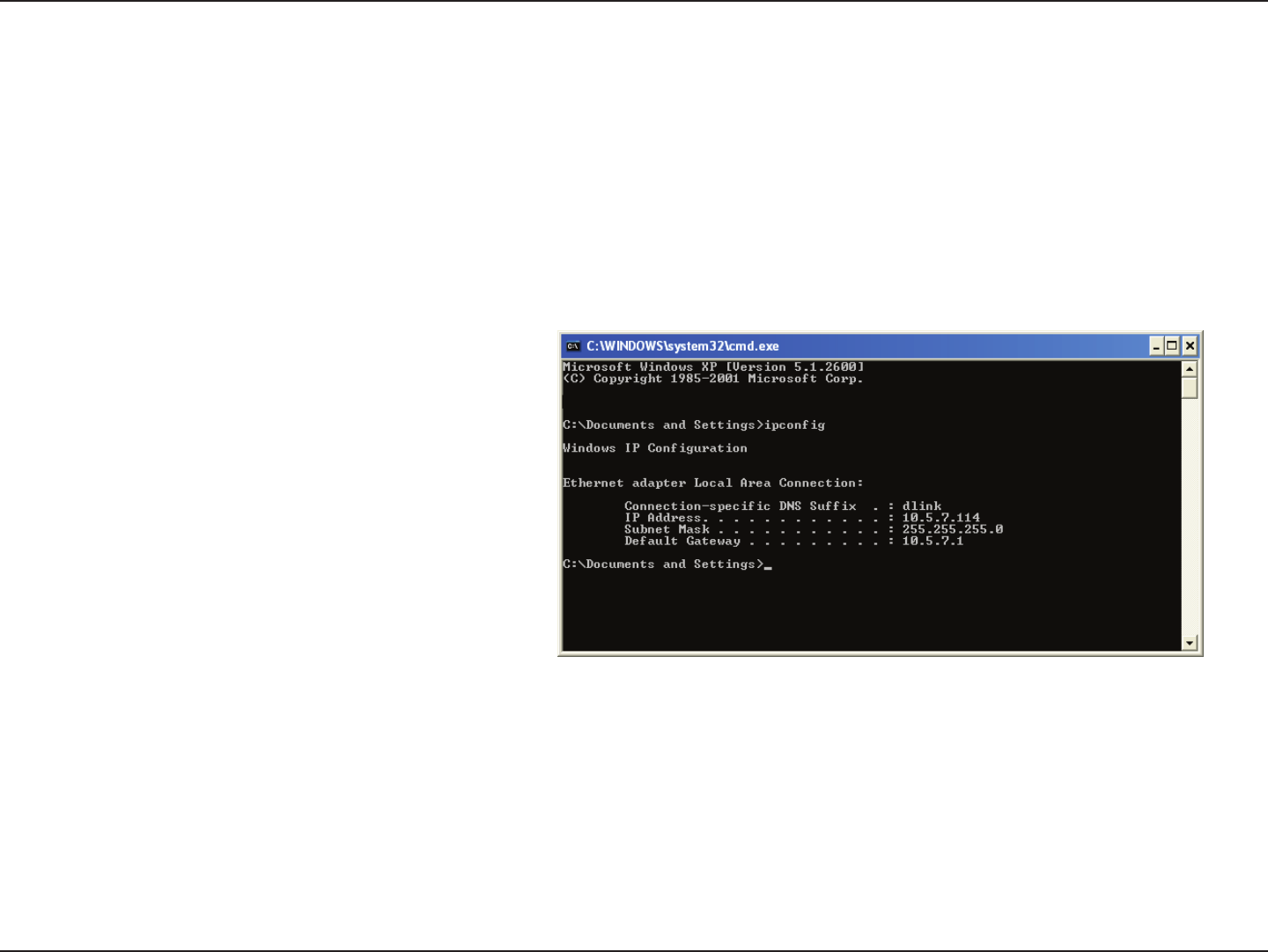
118D-Link DIR-655 User Manual
Appendix B - Networking Basics
Networking Basics
Check your IP address
After you install your new D-Link adapter, by default, the TCP/IP settings should be set to obtain an IP address from a DHCP server (i.e. wireless
router) automatically. To verify your IP address, please follow the steps below.
Click on Start > Run. In the run box type cmd and click OK. (Windows Vista® users type cmd in the Start Search box.)
At the prompt, type ipcong and press Enter.
This will display the IP address, subnet mask, and the default
gateway of your adapter.
If the address is 0.0.0.0, check your adapter installation, security
settings, and the settings on your router. Some rewall software
programs may block a DHCP request on newly installed
adapters.
If you are connecting to a wireless network at a hotspot (e.g.
hotel, coee shop, airport), please contact an employee or
administrator to verify their wireless network settings.
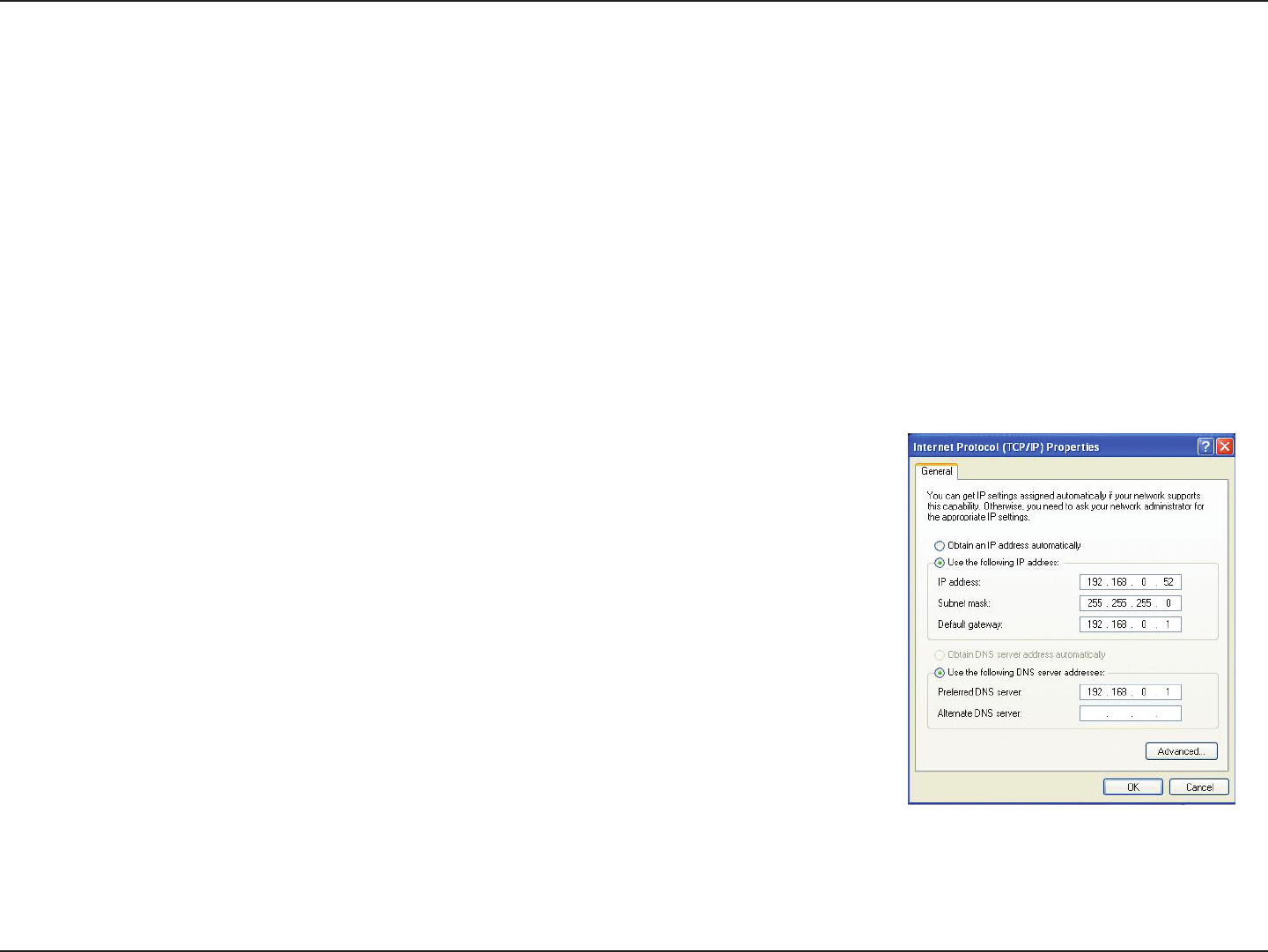
119D-Link DIR-655 User Manual
Appendix B - Networking Basics
Statically Assign an IP address
If you are not using a DHCP capable gateway/router, or you need to assign a static IP address, please follow the steps below:
Step 1
Windows® 7 - Click on Start > Control Panel > Network and Internet > Network and Sharing Center.
Windows Vista® - Click on Start > Control Panel > Network and Internet > Network and Sharing Center > Manage Network Connections.
Windows XP - Click on Start > Control Panel > Network Connections.
Windows 2000 - From the desktop, right-click My Network Places > Properties.
Step 2
Right-click on the Local Area Connection which represents your D-Link network adapter and select Properties.
Step 3
Highlight Internet Protocol (TCP/IP) and click Properties.
Step 4
Click Use the following IP address and enter an IP address that is on the same subnet as your network
or the LAN IP address on your router.
Example: If the router´s LAN IP address is 192.168.0.1, make your IP address 192.168.0.X where X is a
number between 2 and 99. Make sure that the number you choose is not in use on the network. Set
Default Gateway the same as the LAN IP address of your router (192.168.0.1).
Set Primary DNS the same as the LAN IP address of your router (192.168.0.1). The Secondary DNS is not
needed or you may enter a DNS server from your ISP.
Step 5
Click OK twice to save your settings.

120D-Link DIR-655 User Manual
Appendix C - Technical Specications
Technical Specications
Standards
• IEEE 802.11n
• IEEE 802.11g
• IEEE 802.3
• IEEE 802.3u
Security
• WPA-Personal
• WPA2-Personal
• WPA-Enterprise
• WPA2-Enterprise
Wireless Signal Rates1
• 6.5 Mbps ~ 300 Mbps
Frequency Range
• 2.4 GHz to 2.483 GHz2
External Antenna Type
• Three (3) detachable reverse SMA Antennas
Operating Temperature
• 32°F to 131°F ( 0°C to 55°C)
Humidity
• 95% maximum (non-condensing)
Safety & Emissions
• FCC
• CE
• IC
Dimensions
• L = 7.6 inches
• W = 4.6 inches
• H = 1.2 inches
Warranty
• 2 years
1 Maximum wireless signal rate derived from IEEE Standard 802.11g and 802.11n specications. Actual data throughput will vary. Network conditions and environmental factors,
including volume of network trac, building materials and construction, and network overhead, lower actual data throughput rate. Environmental factors will adversely aect
wireless signal range.
2 Wireless frequency range may vary depending on region

121D-Link DIR-655 User Manual
Appendix D - Safety Statements
CE Mark Warning:
This is a Class B product. In a domestic environment, this product may cause radio interference, in which case the user may be required to take
adequate measures.
FCC Statement:
This equipment has been tested and found to comply with the limits for a Class B digital device, pursuant to part 15 of the FCC Rules. These limits are
designed to provide reasonable protection against harmful interference in a residential installation. This equipment generates, uses, and can radiate
radio frequency energy and, if not installed and used in accordance with the instructions, may cause harmful interference to radio communication.
However, there is no guarantee that interference will not occur in a particular installation. If this equipment does cause harmful interference to radio
or television reception, which can be determined by turning the equipment o and on, the user is encouraged to try to correct the interference
by one or more of the
following measures:
• Reorient or relocate the receiving antenna.
• Increase the separation between the equipment and receiver.
• Connect the equipment into an outlet on a circuit dierent from that to which the receiver is connected.
• Consult the dealer or an experienced radio/TV technician for help.
FCC Caution:
Any changes or modications not expressly approved by the party responsible for compliance could void the user’s authority to operate this
equipment.
This device complies with Part 15 of the FCC Rules. Operation is subject to the following two conditions:
(1) This device may not cause harmful interference, and (2) this device must accept any interference received, including interference that may cause
undesired operation.
IMPORTANT NOTICE:
FCC Radiation Exposure Statement:
This equipment complies with FCC radiation exposure limits set forth for an uncontrolled environment. This equipment should be installed and
operated with minimum distance 20cm between the radiator & your body. This transmitter must not be co-located or operating in conjunction
with any other antenna or transmitter.
The availability of some specic channels and/or operational frequency bands are country dependent and are rmware programmed at the factory
to match the intended destination. The rmware setting is not accessible by the end user.

122D-Link DIR-655 User Manual
Appendix D - Safety Statements
For detailed warranty information applicable to products purchased outside the United States, please contact the corresponding local D-Link
oce.
Industry Canada Notice:
This device complies with RSS-210 of the Industry Canada Rules. Operation is subject to the following two conditions:
(1) This device may not cause harmful interference, and (2) this device must accept any interference received, including interference that may cause
undesired operation.
Ce dispositif est conforme à la norme CNR-210 d’Industrie Canada applicable aux appareils radio exempts de licence. Son fonctionnement est sujet
aux deux conditions suivantes: (1) le dispositif ne doit pas produire de brouillage préjudiciable, et (2) ce dispositif doit accepter tout brouillage reçu,
y compris un brouillage susceptible de provoquer un fonctionnement indésirable.
IMPORTANT NOTE:
Radiation Exposure Statement:
This equipment complies with IC radiation exposure limits set forth for an uncontrolled environment. This equipment should be installed and
operated with minimum distance 20cm between the radiator & your body.
This device has been designed to operate with an antenna having a maximum gain of 2dB. Antenna having a higher gain is strictly prohibited per
regulations of Industry Canada. The required antenna impedance is 50 ohms.
Déclaration d’exposition aux radiations:
Cet équipement est conforme aux limites d’exposition aux rayonnements IC établies pour un environnement non contrôlé. Cet équipement doit
être installé et utilisé avec un minimum de 20 cm de distance entre la source de rayonnement et votre corps.
This radio transmitter(IC: 4216A-IR655C1) has been approved by Industry Canada to operate with the antenna types listed below with the maximum
permissible gain and required antenna impedance for each antenna type indicated. Antenna types not included in this list, having a gain greater
than the maximum gain indicated for that type, are strictly prohibited for use with this device.
Cet émetteur radio (IC: 4216A-IR655C1) a été approuvé par Industrie Canada pour fonctionner avec les types d’antennes énumérés ci-dessous avec
le gain maximal admissible et nécessaire impédance d’antenne pour chaque type d’antenne indiqué. Types d’antennes ne gurent pas dans cette
liste, ayant un gain supérieur au gain maximum indiqué pour ce type, sont strictement interdites pour une utilisation avec cet appareil.
“To reduce potential radio interference to other users, the antenna type and its gain should be so chosen that the equivalent isotropically radiated
power (EIRP) is not more than that required for successful communication”

123D-Link DIR-655 User Manual
Appendix D - Safety Statements
“This device has been designed to operate with an antenna having a maximum gain of [2] dBi. Antenna having a higher gain is strictly prohibited
per regulations of Industry Canada. The required antenna impedance is 50 ohms.”
«Pour réduire le risque d’interférence avec d’autres utilisateurs, le type d’antenne et son gain doivent être choisis an que la puissance isotrope
rayonnée équivalente (PIRE) ne dépasse pas ce qui est nécessaire pour une communication réussie”
«Ce dispositif a été conçu pour fonctionner avec une antenne ayant un gain maximal de [2] dBi. Antenne ayant un gain supérieur sont strictement
interdites par la réglementation d’Industrie Canada. L’impédance d’antenne requise est de 50 ohms.”